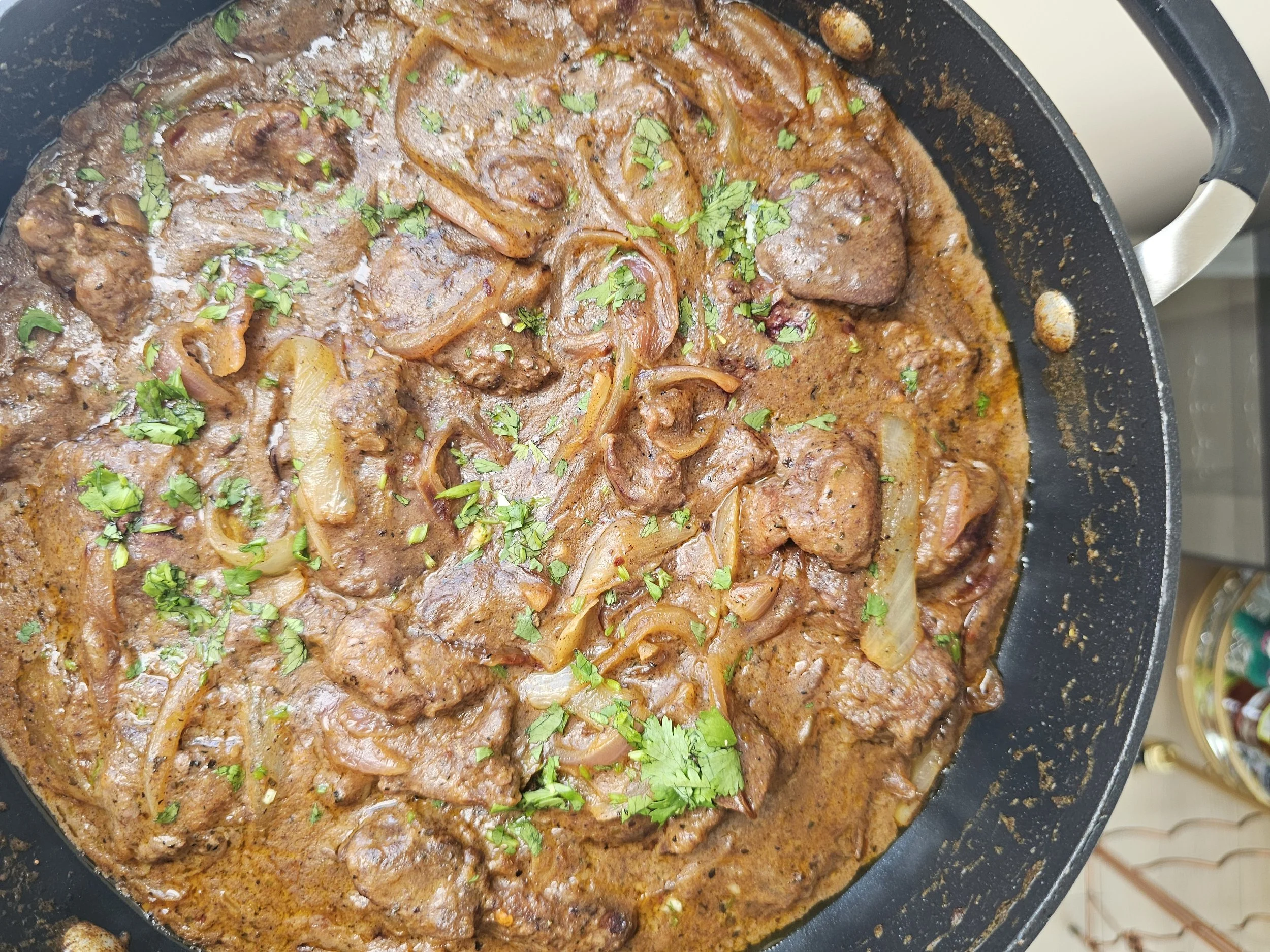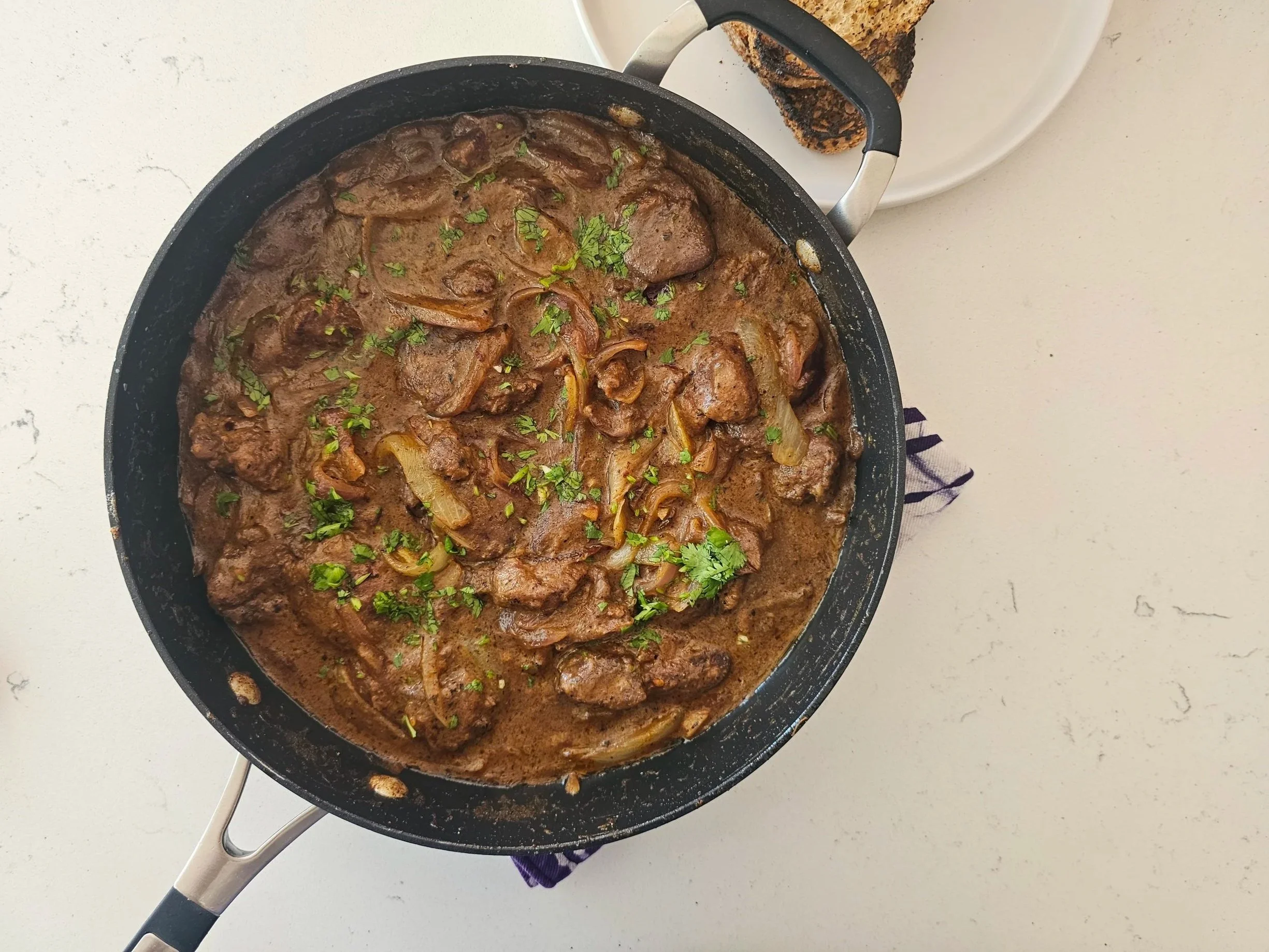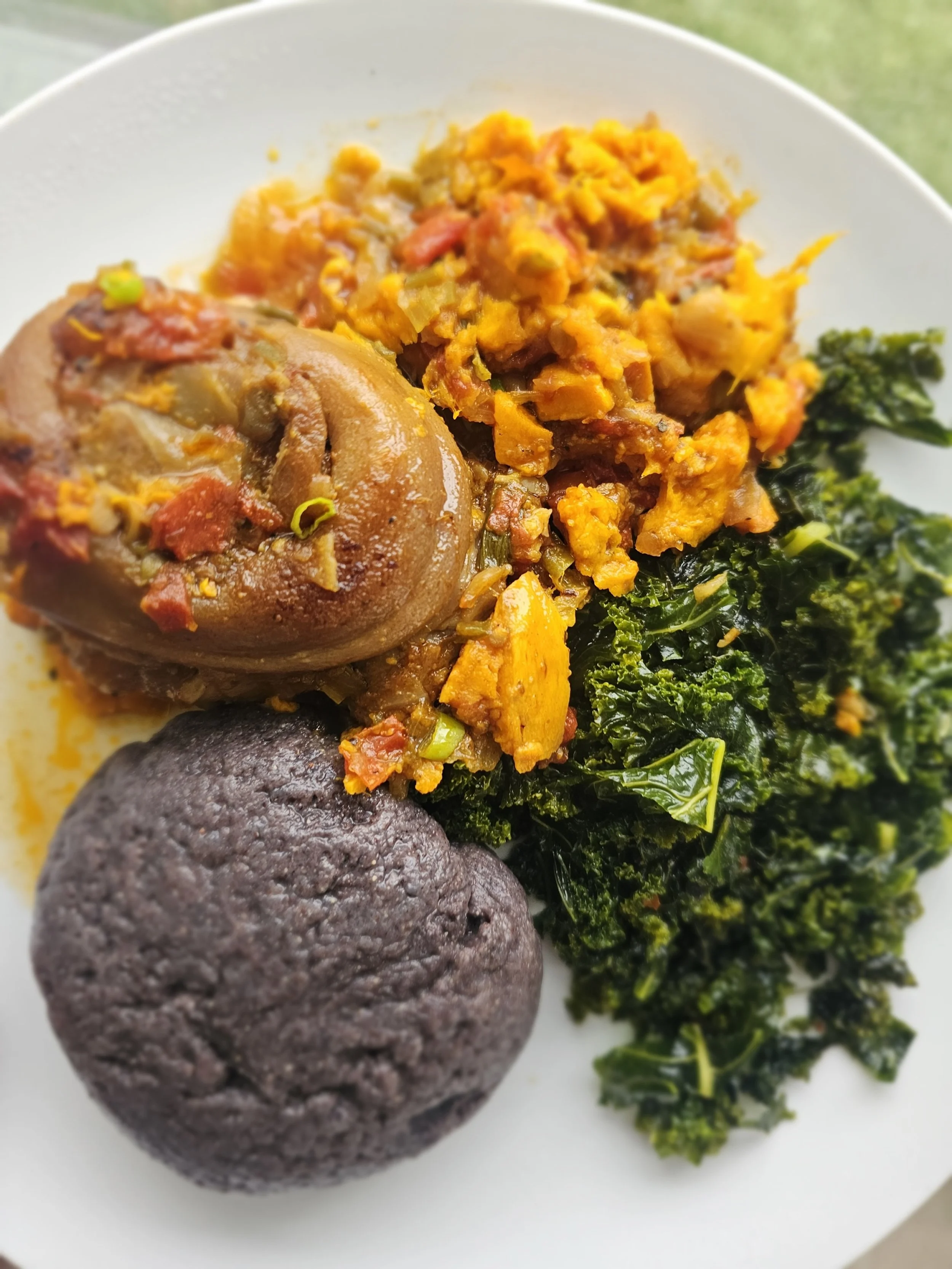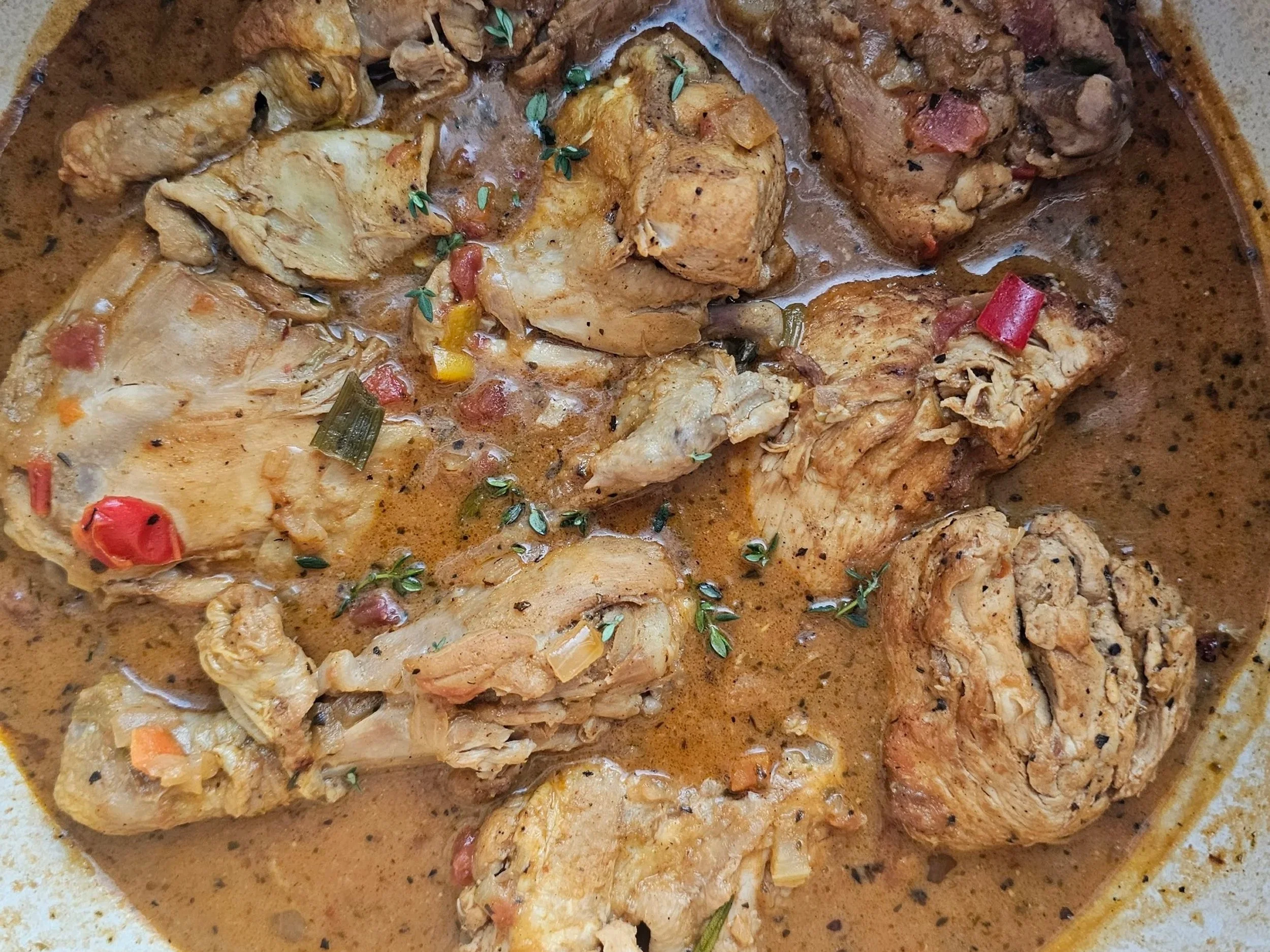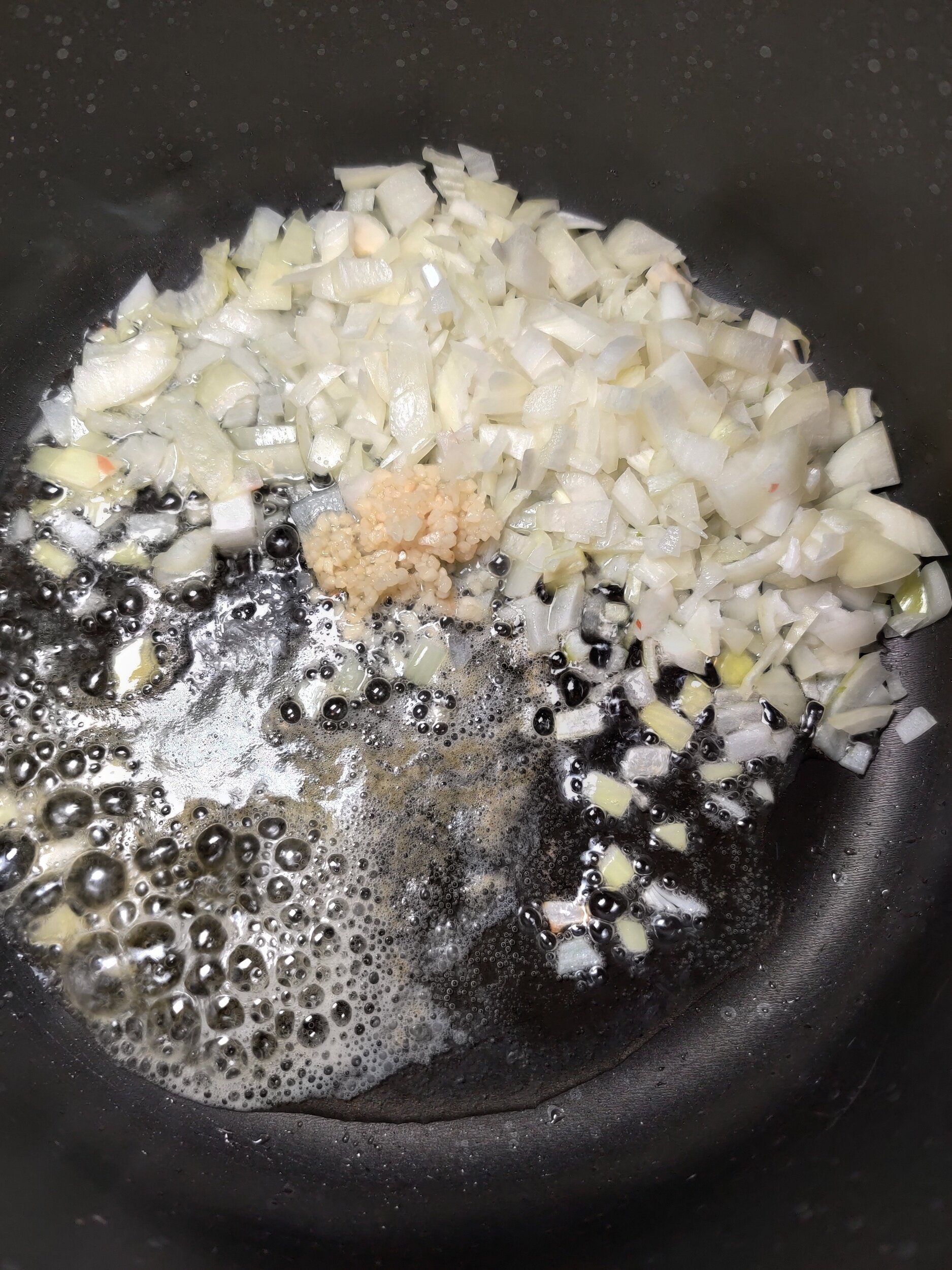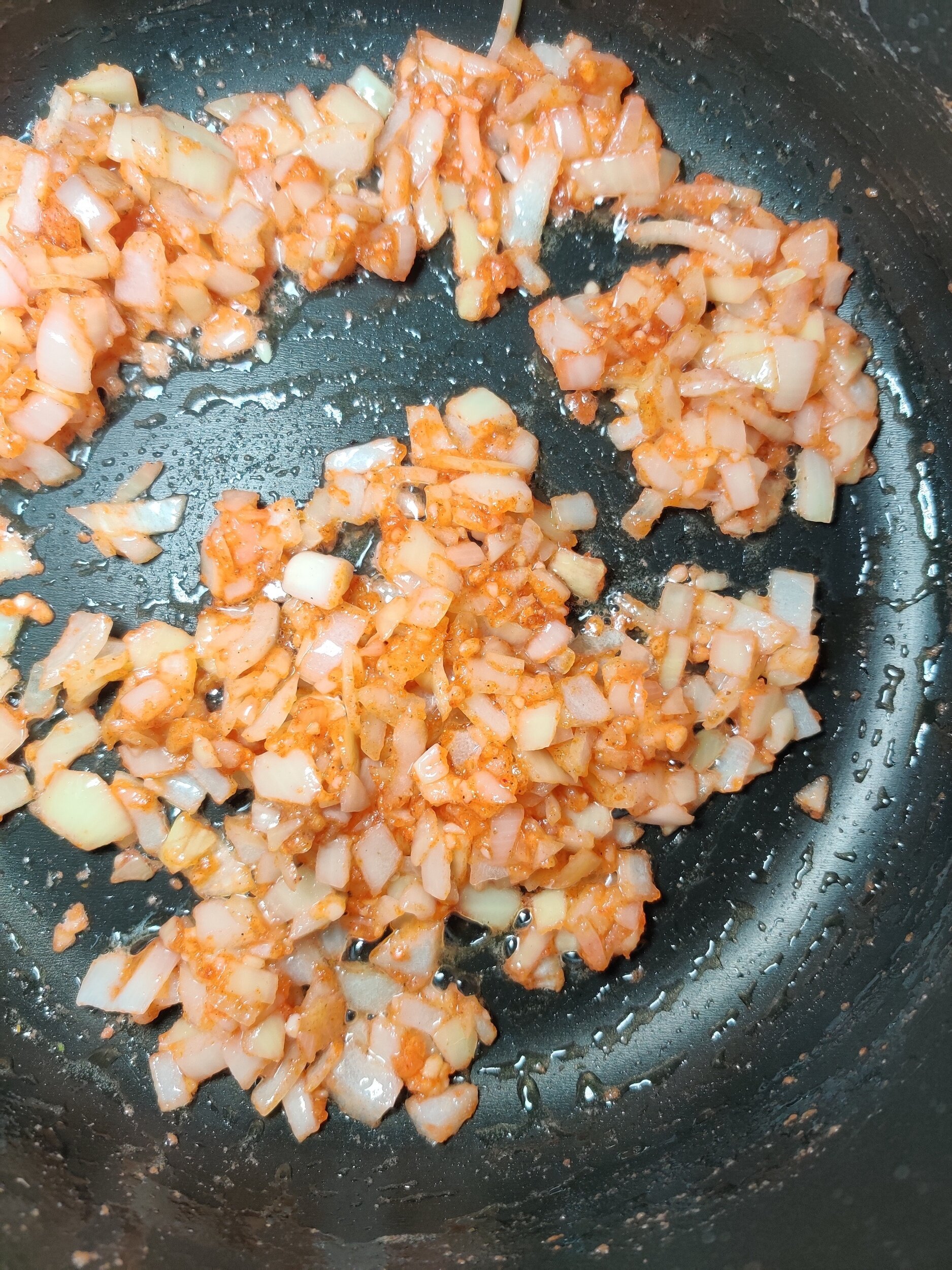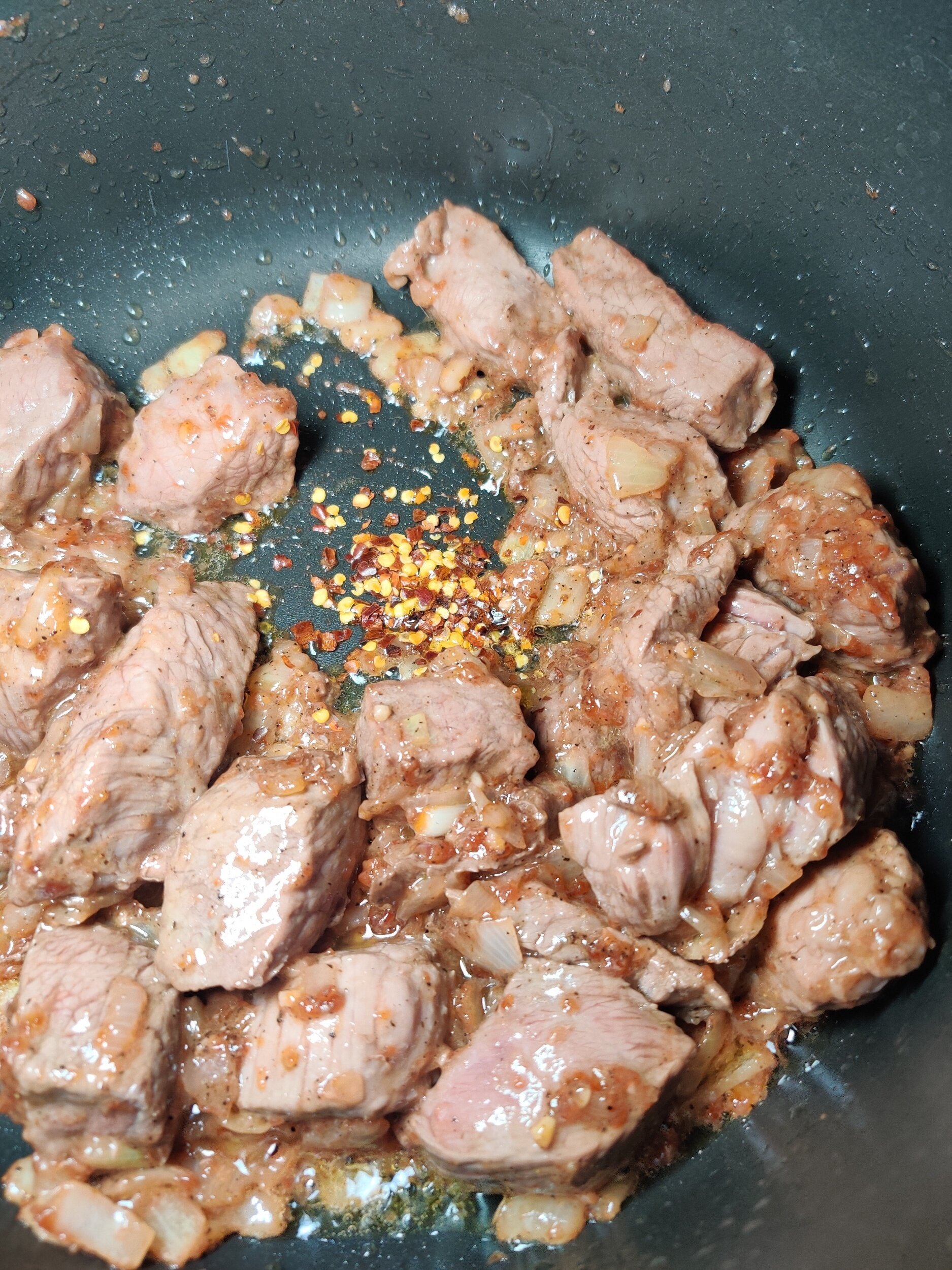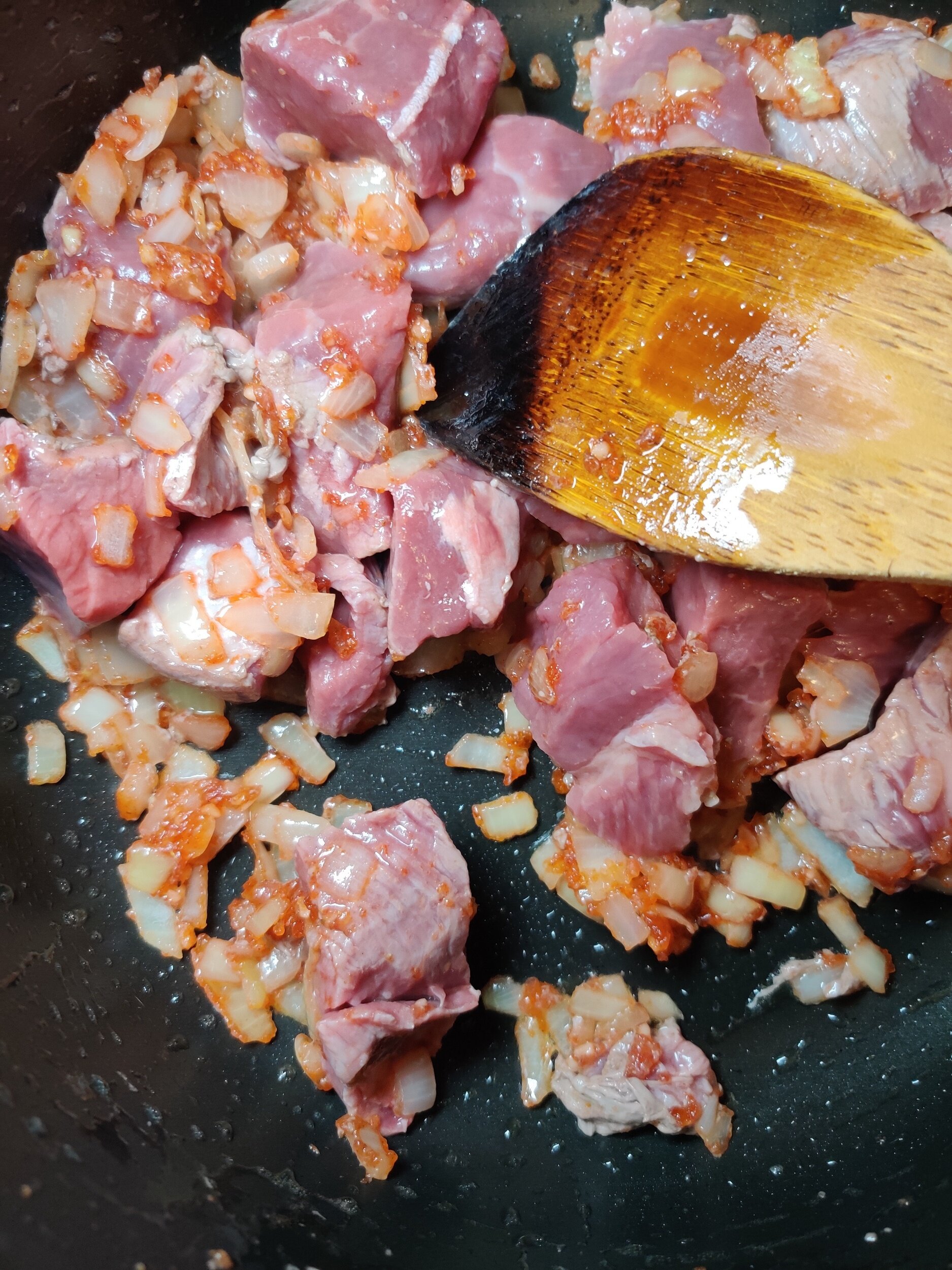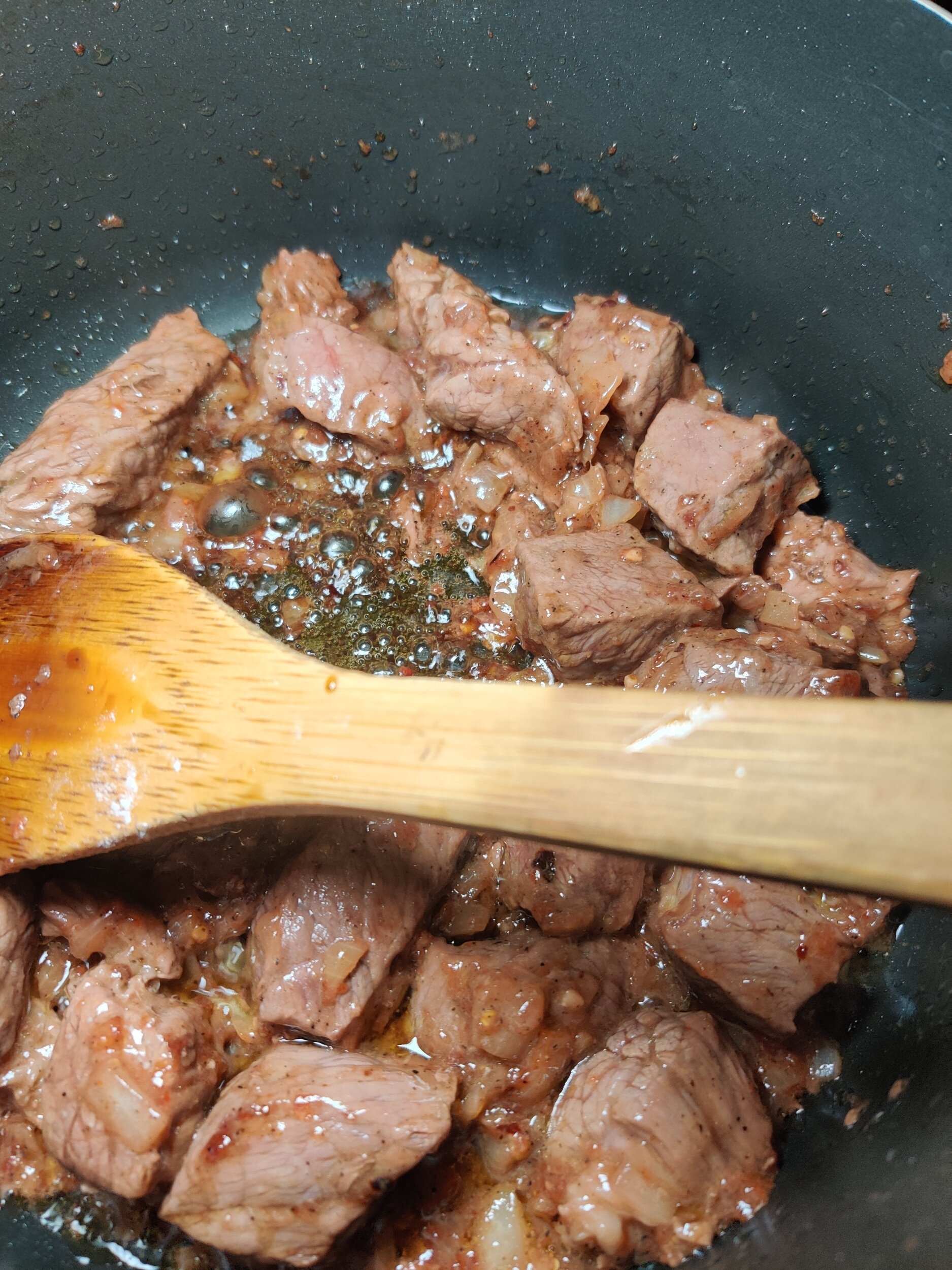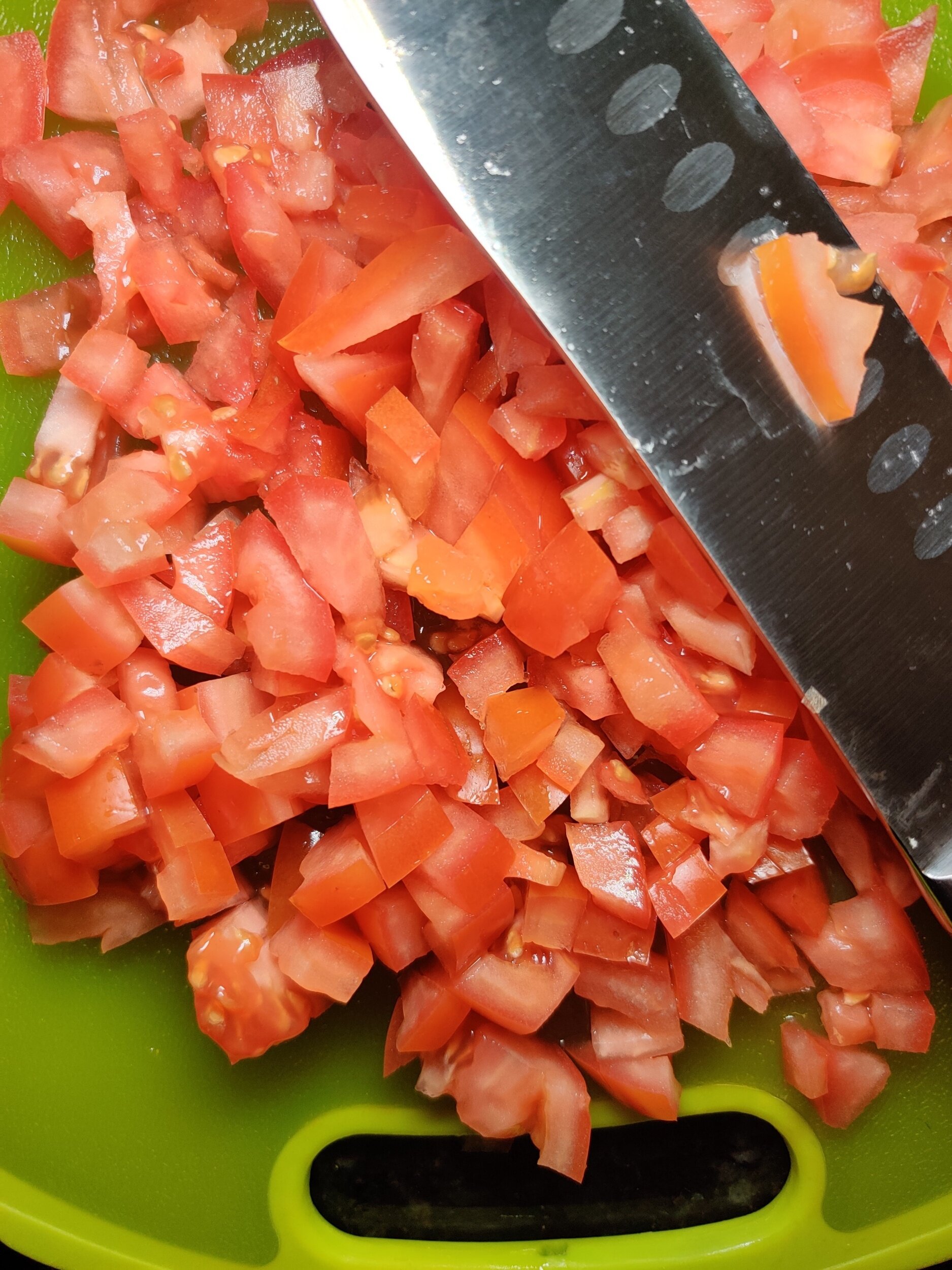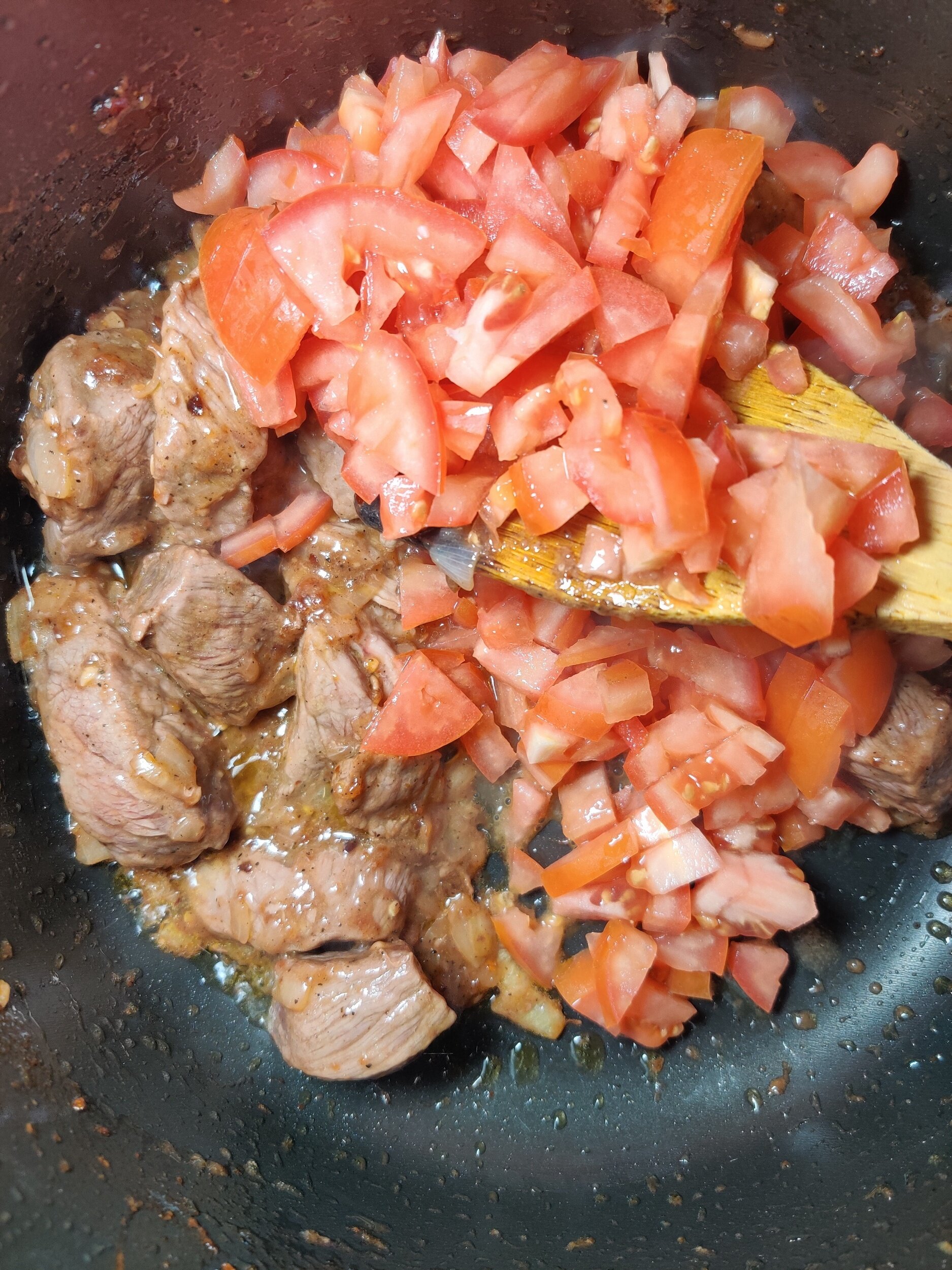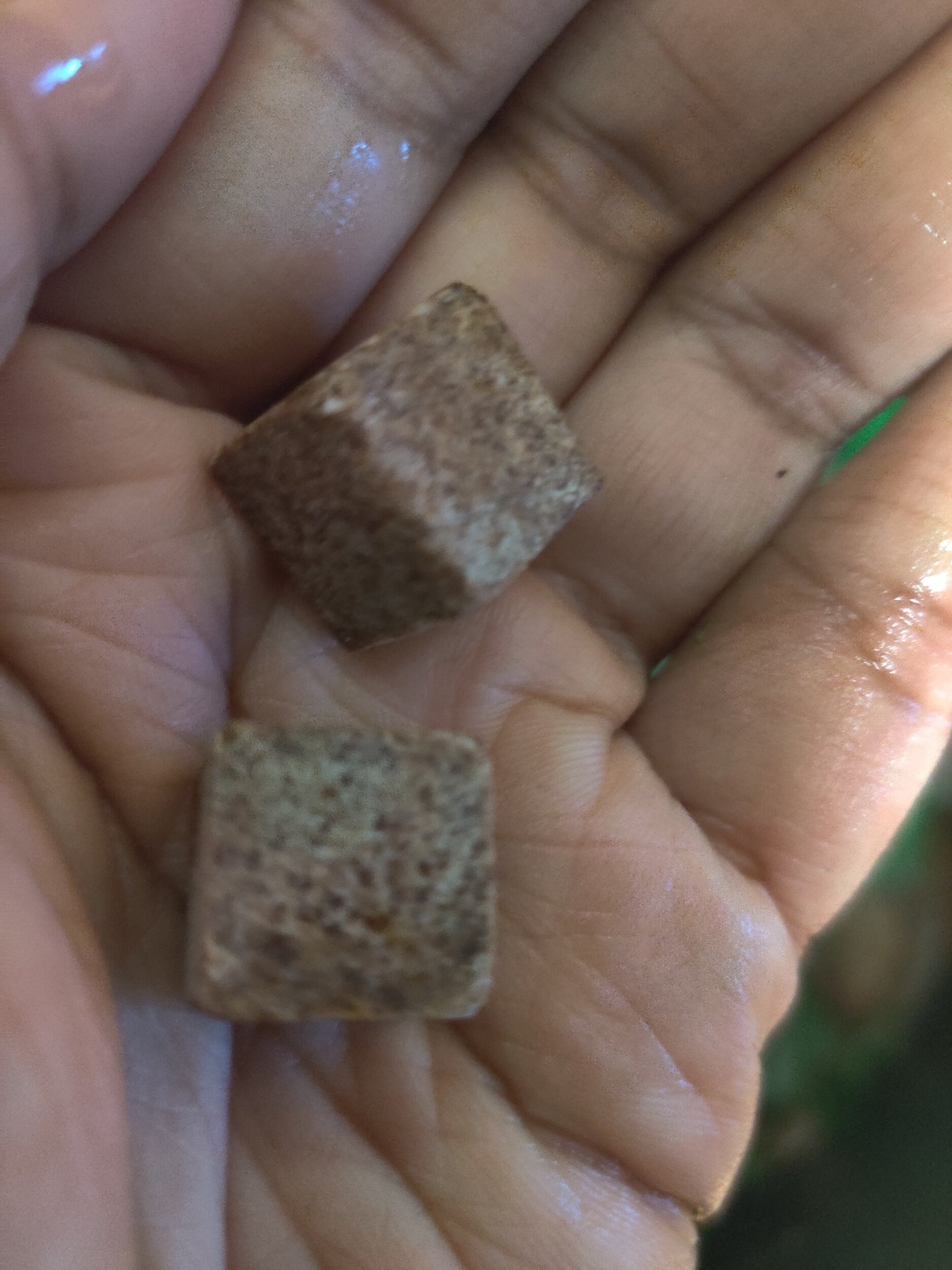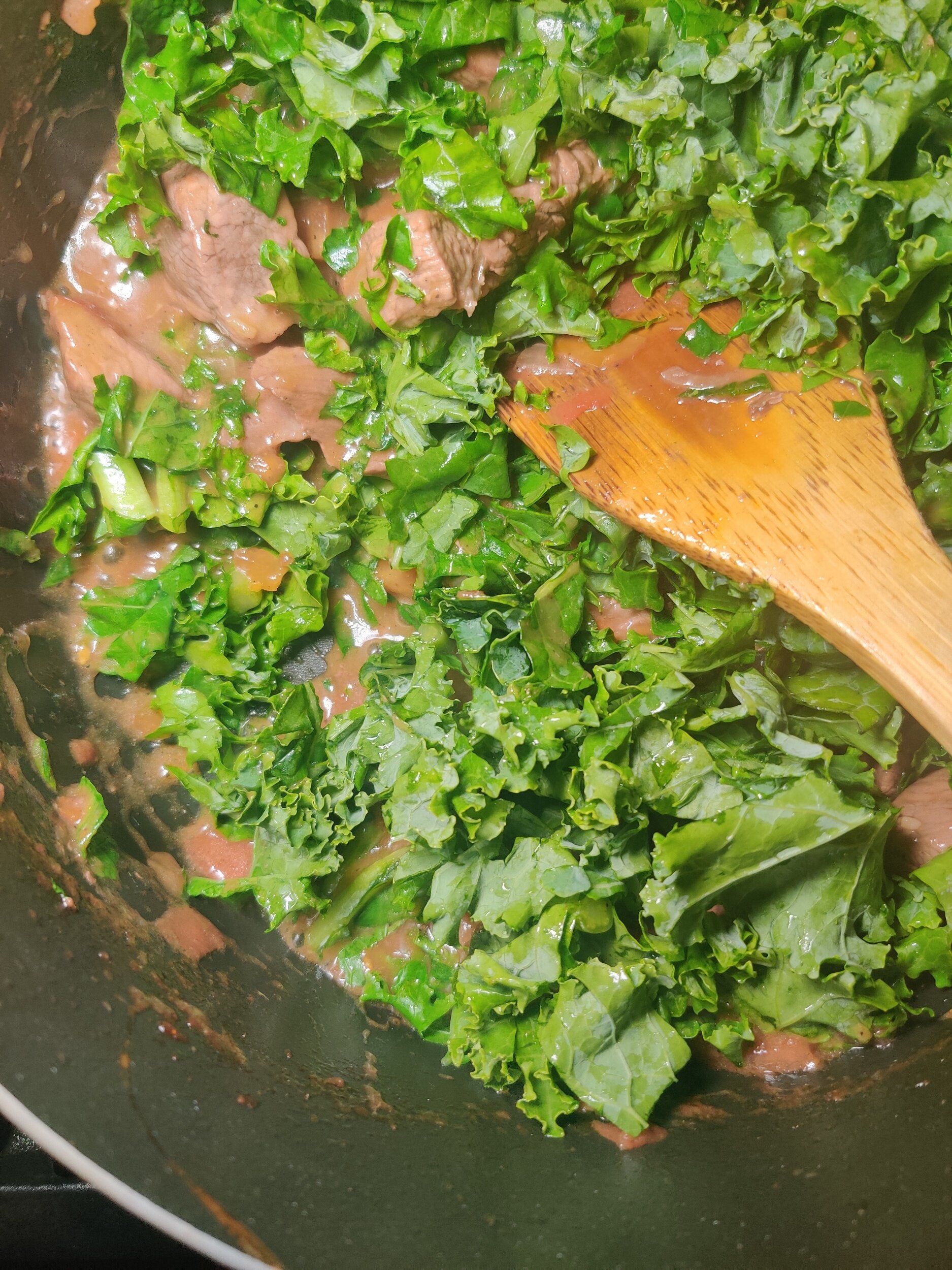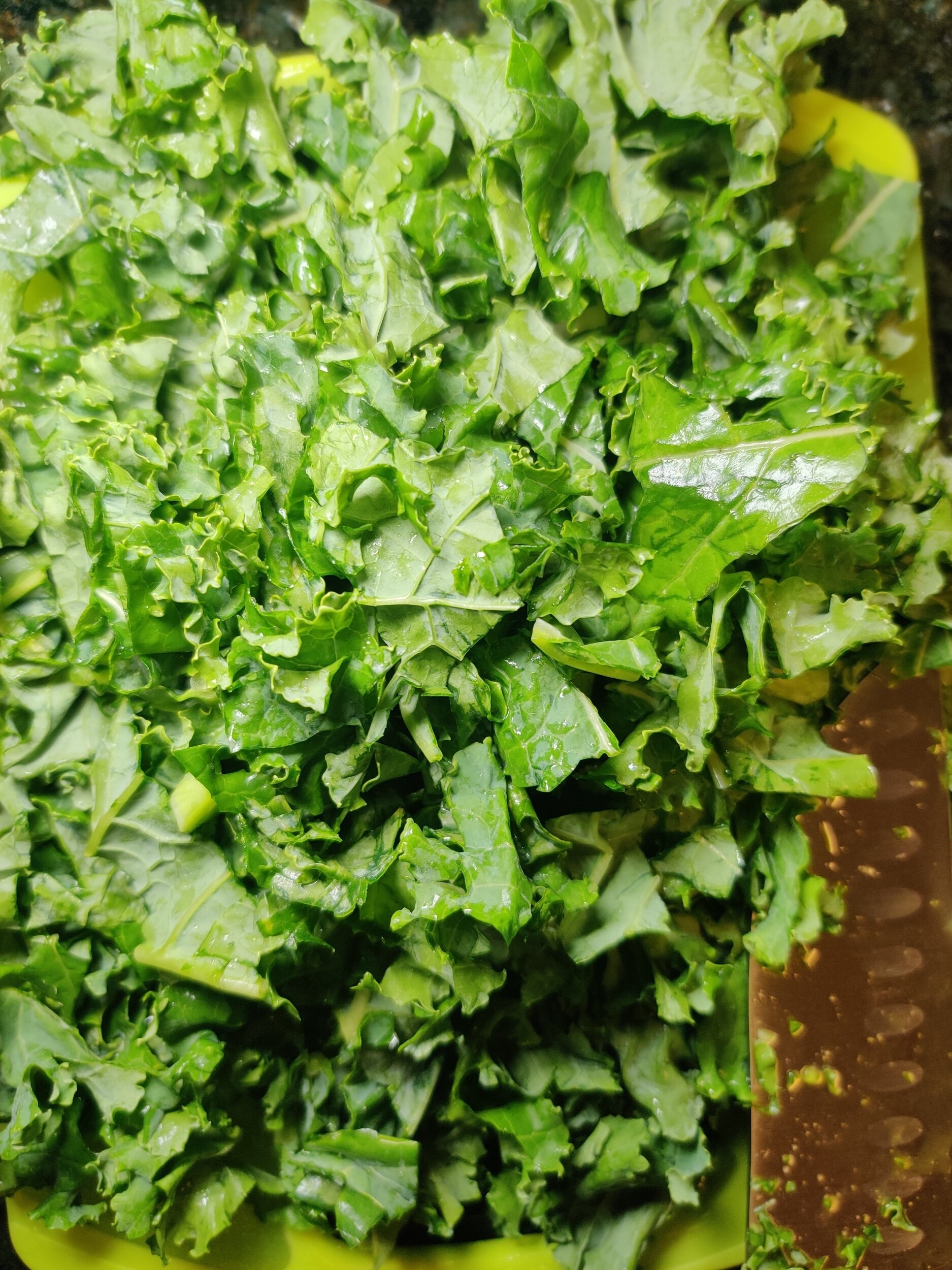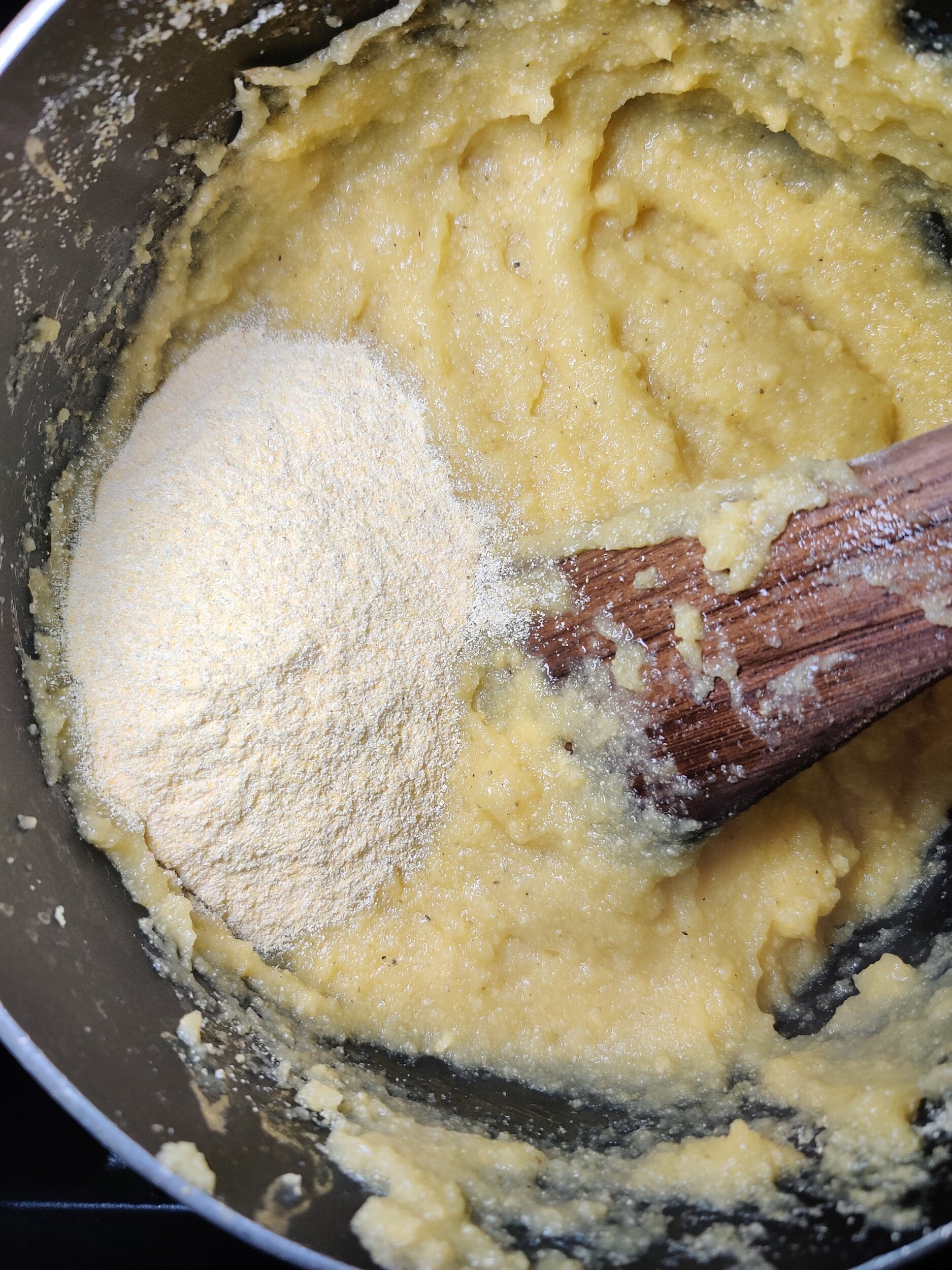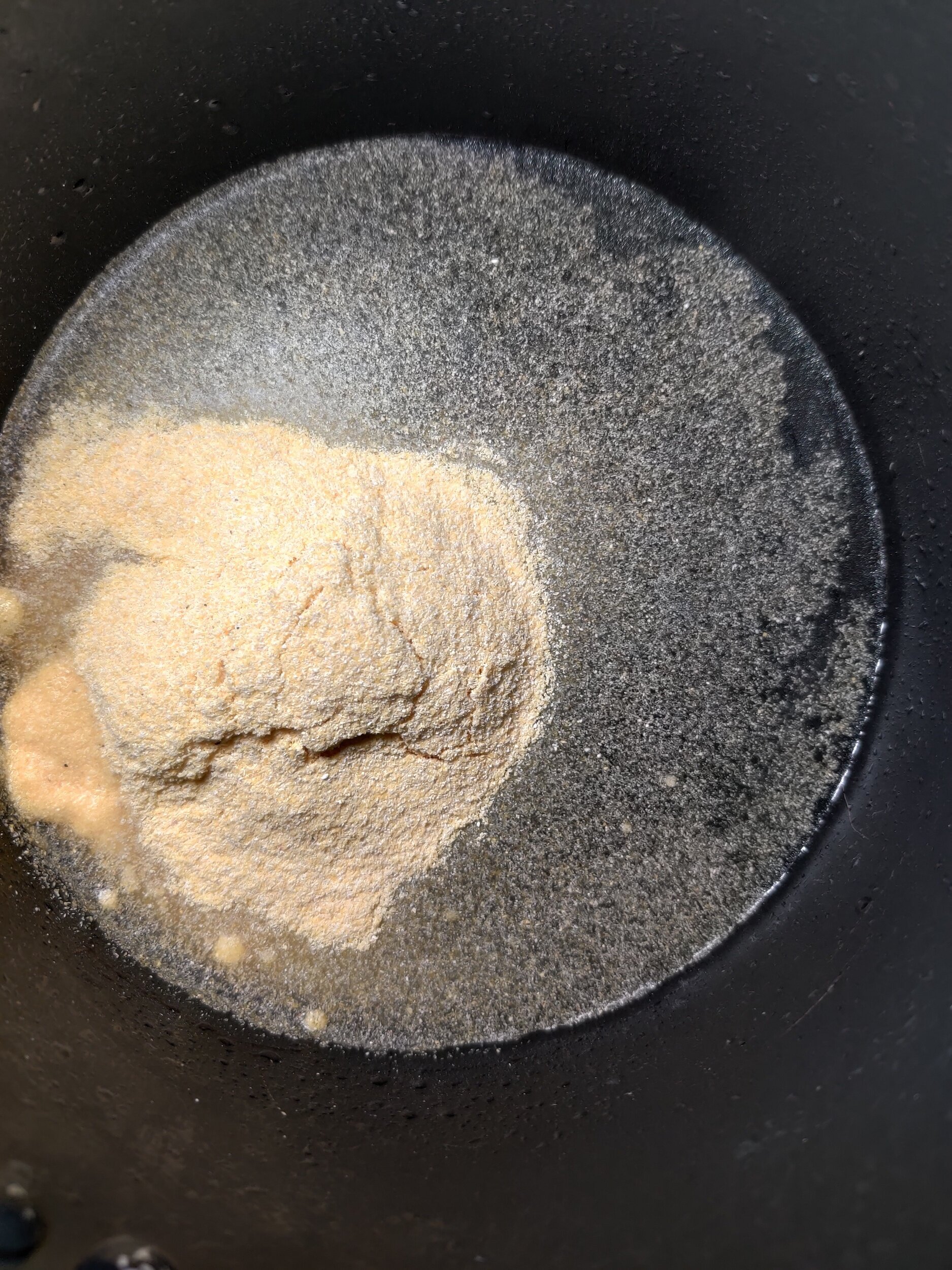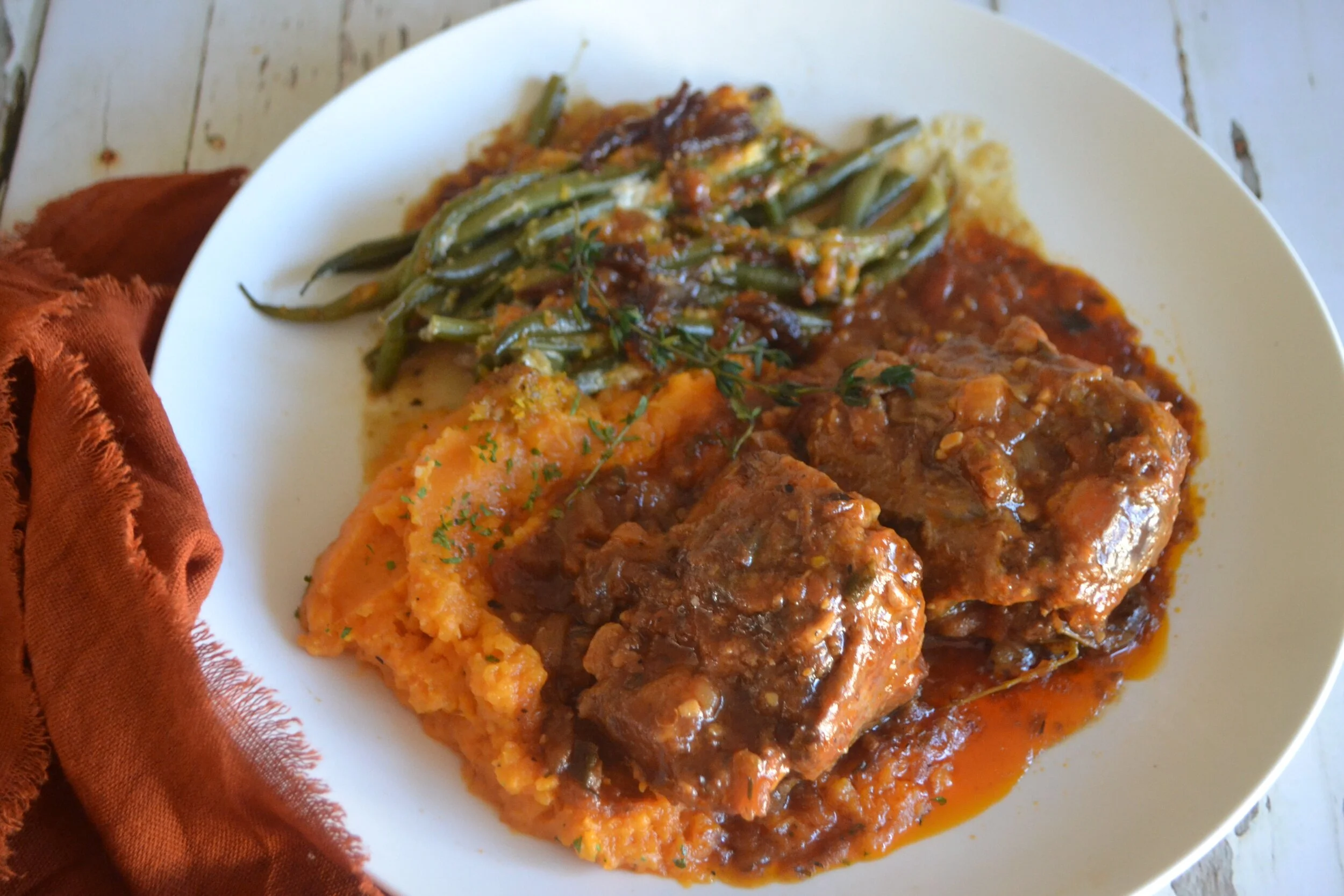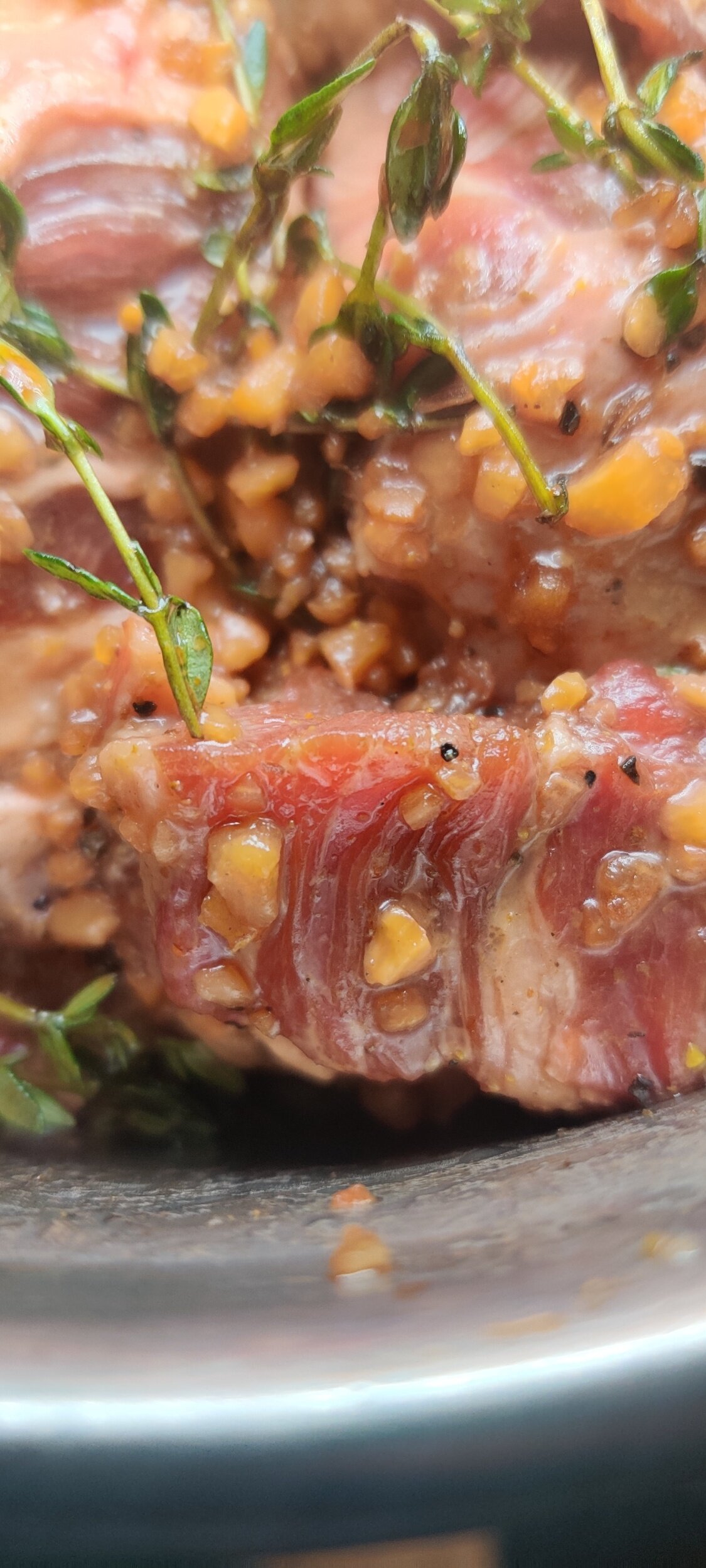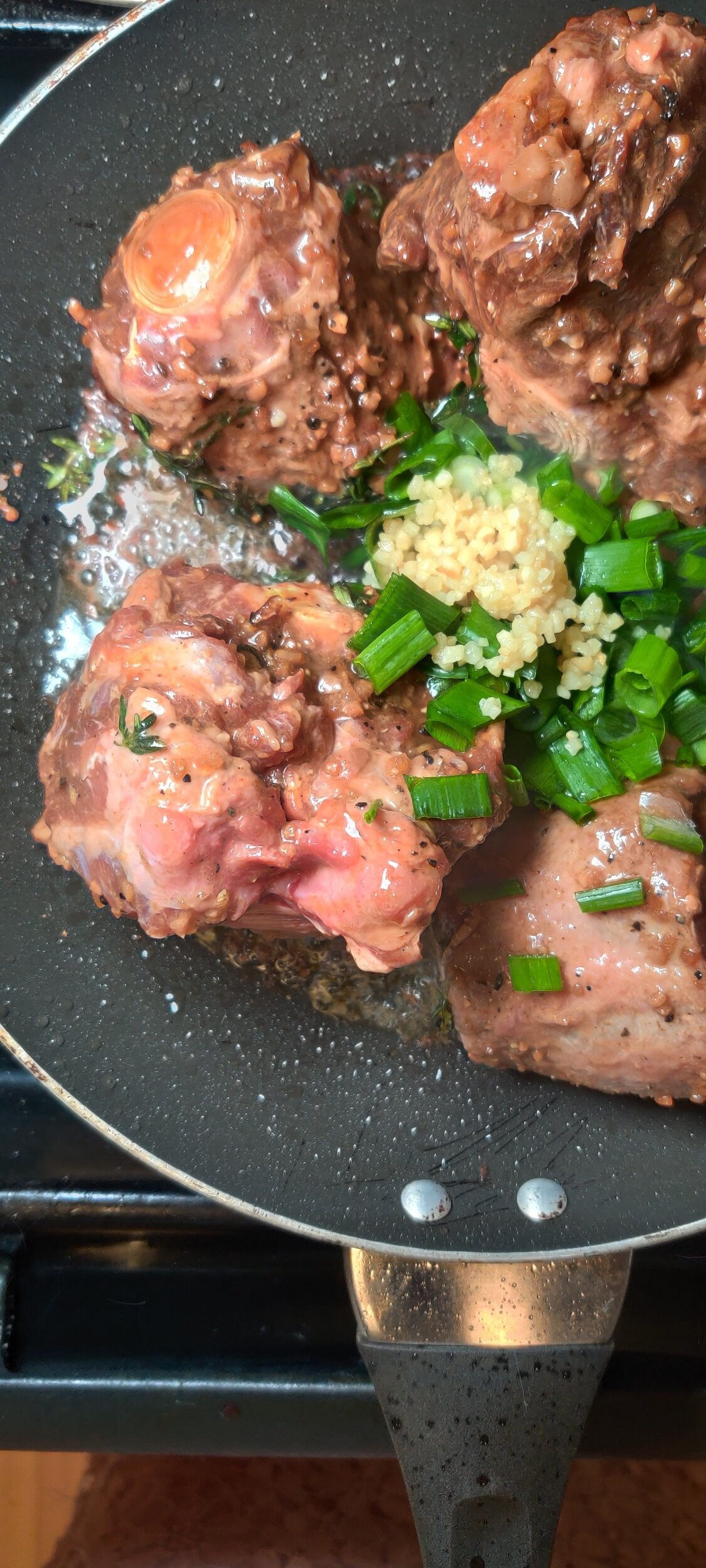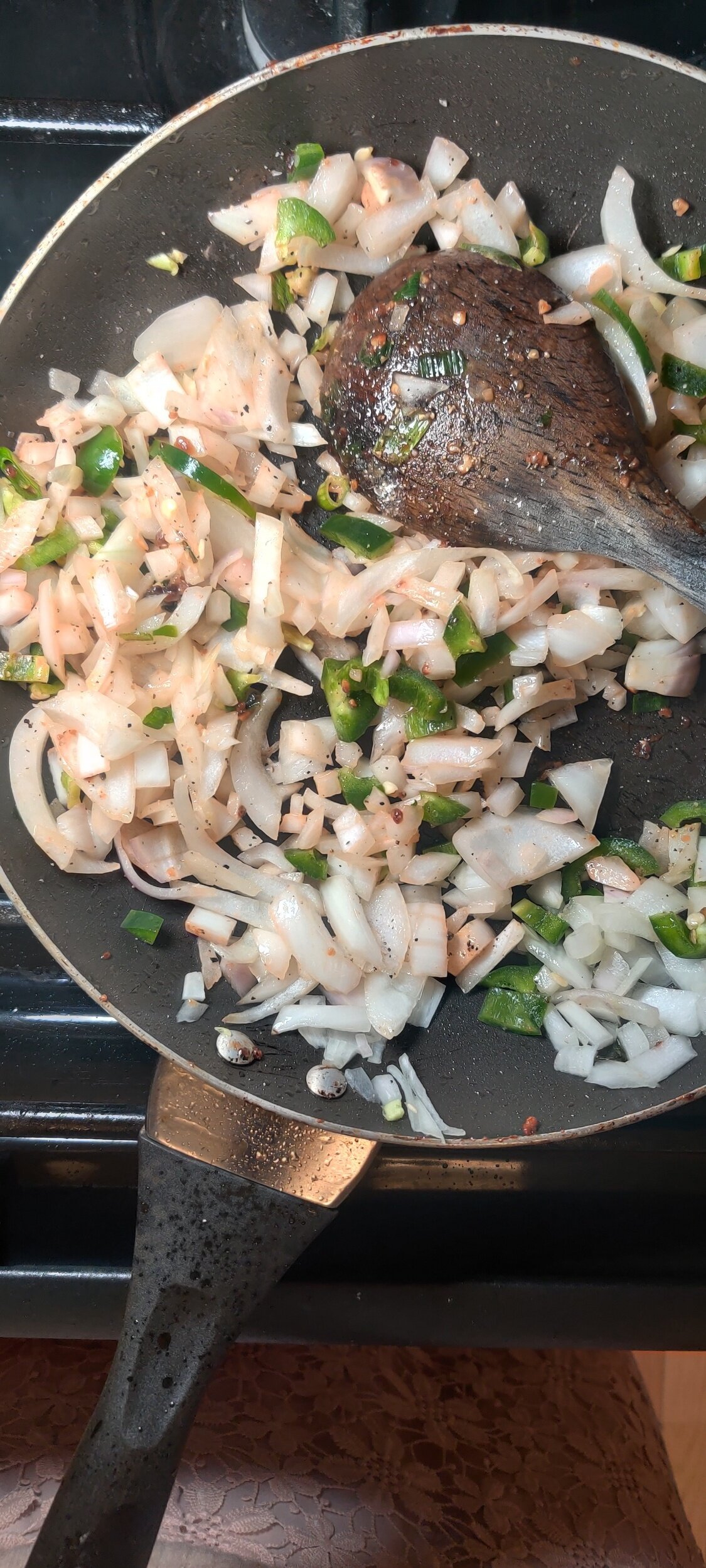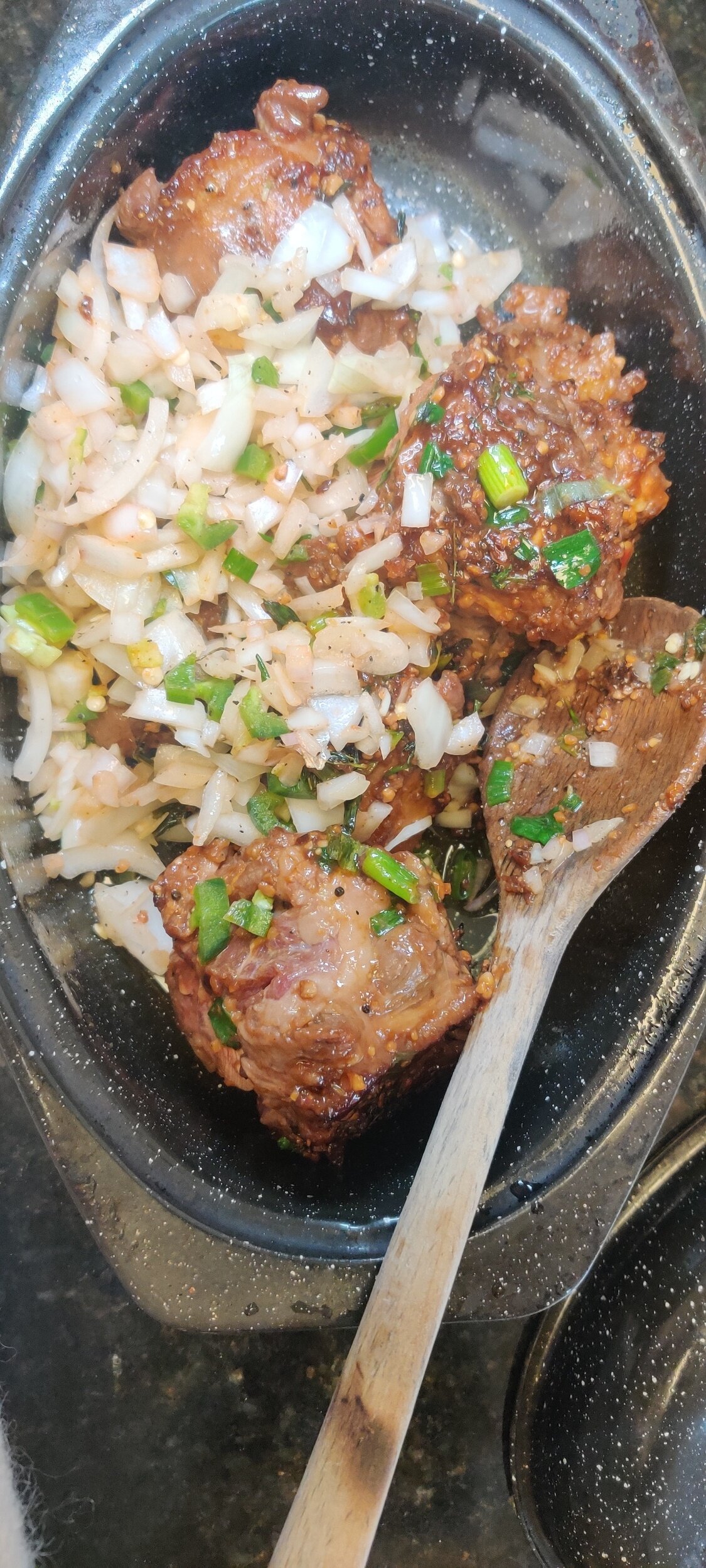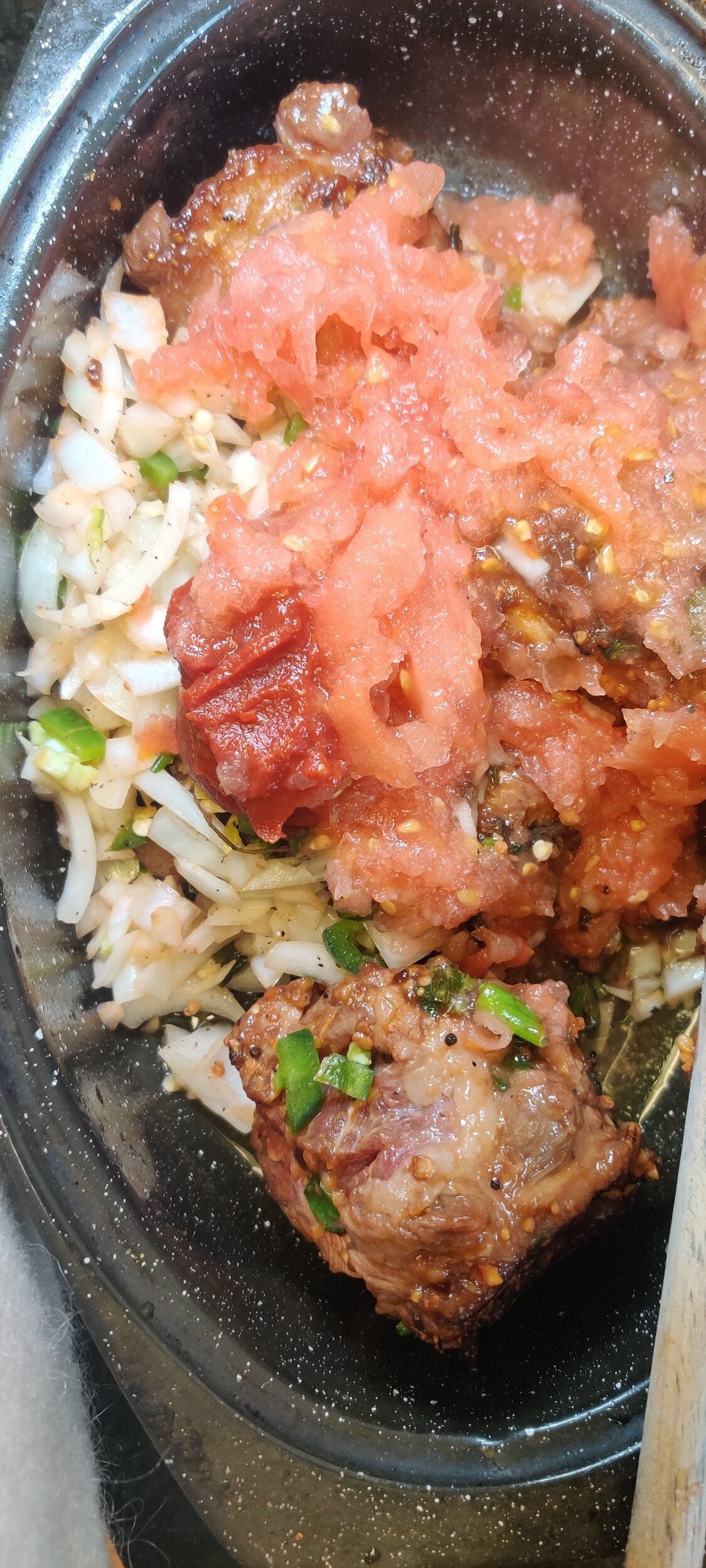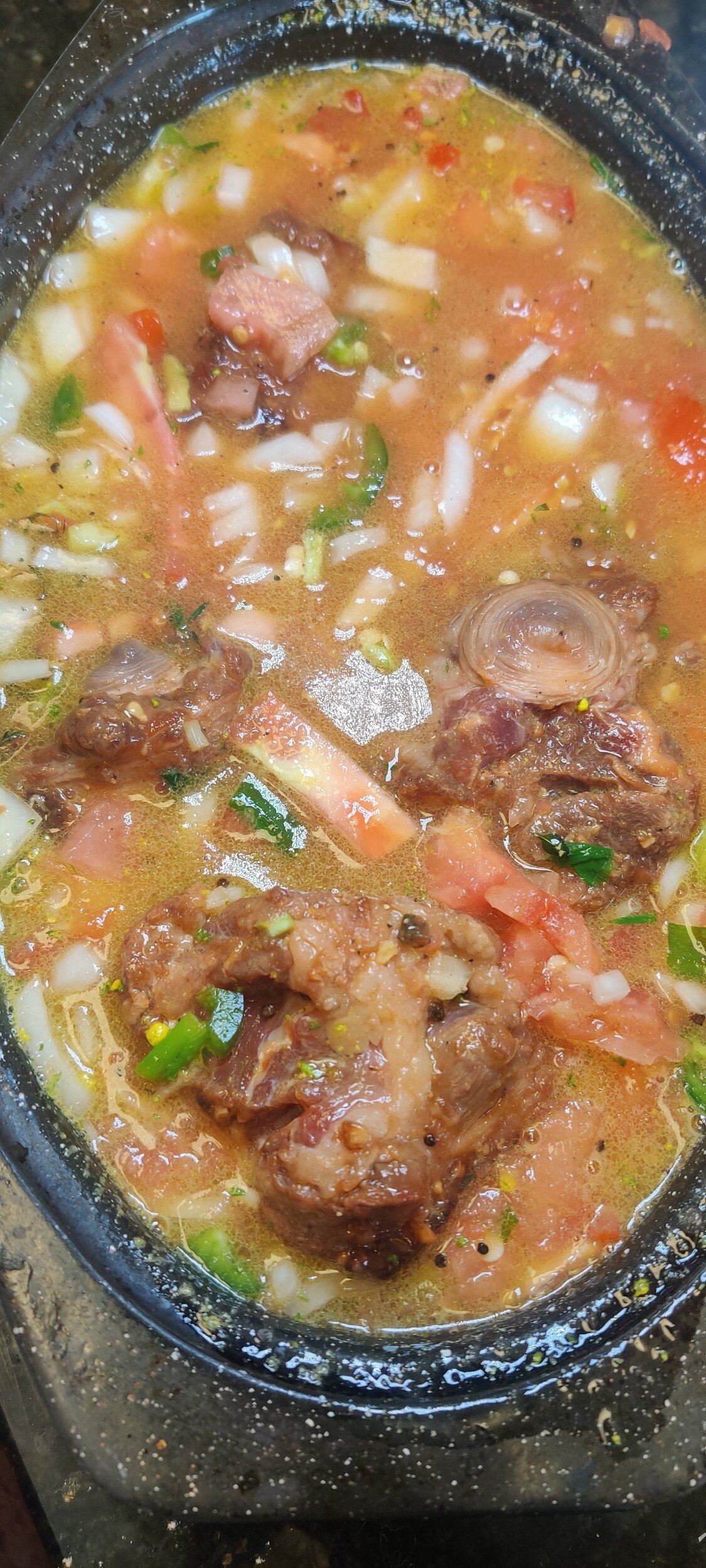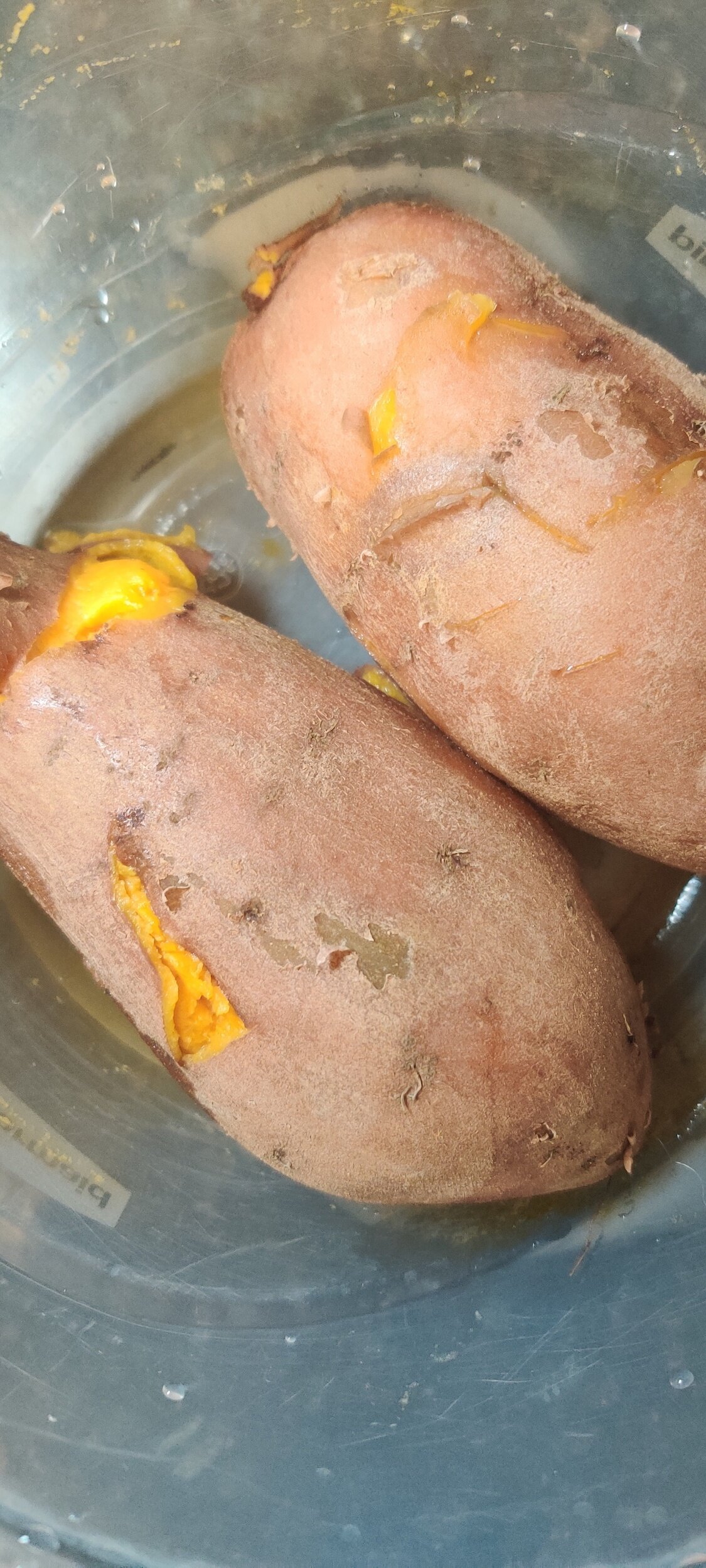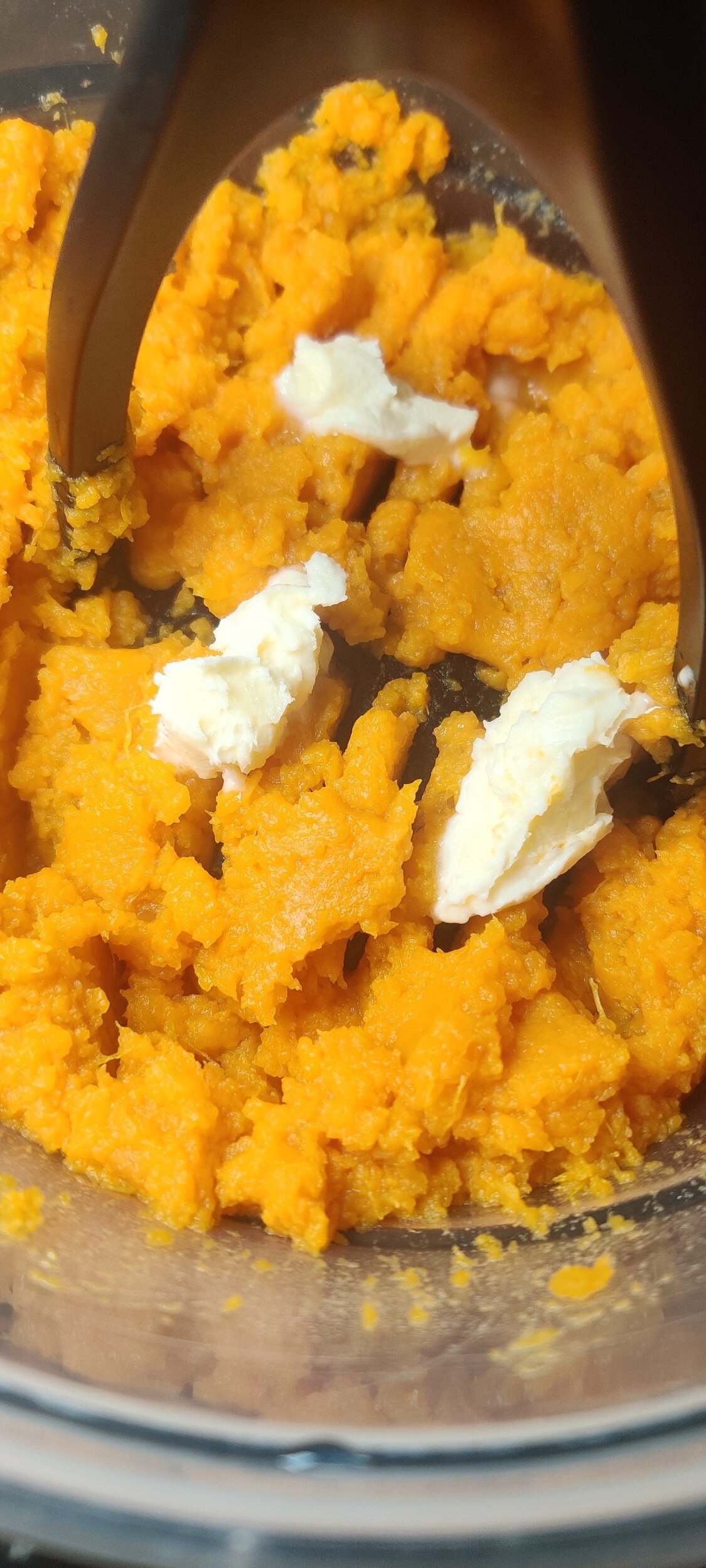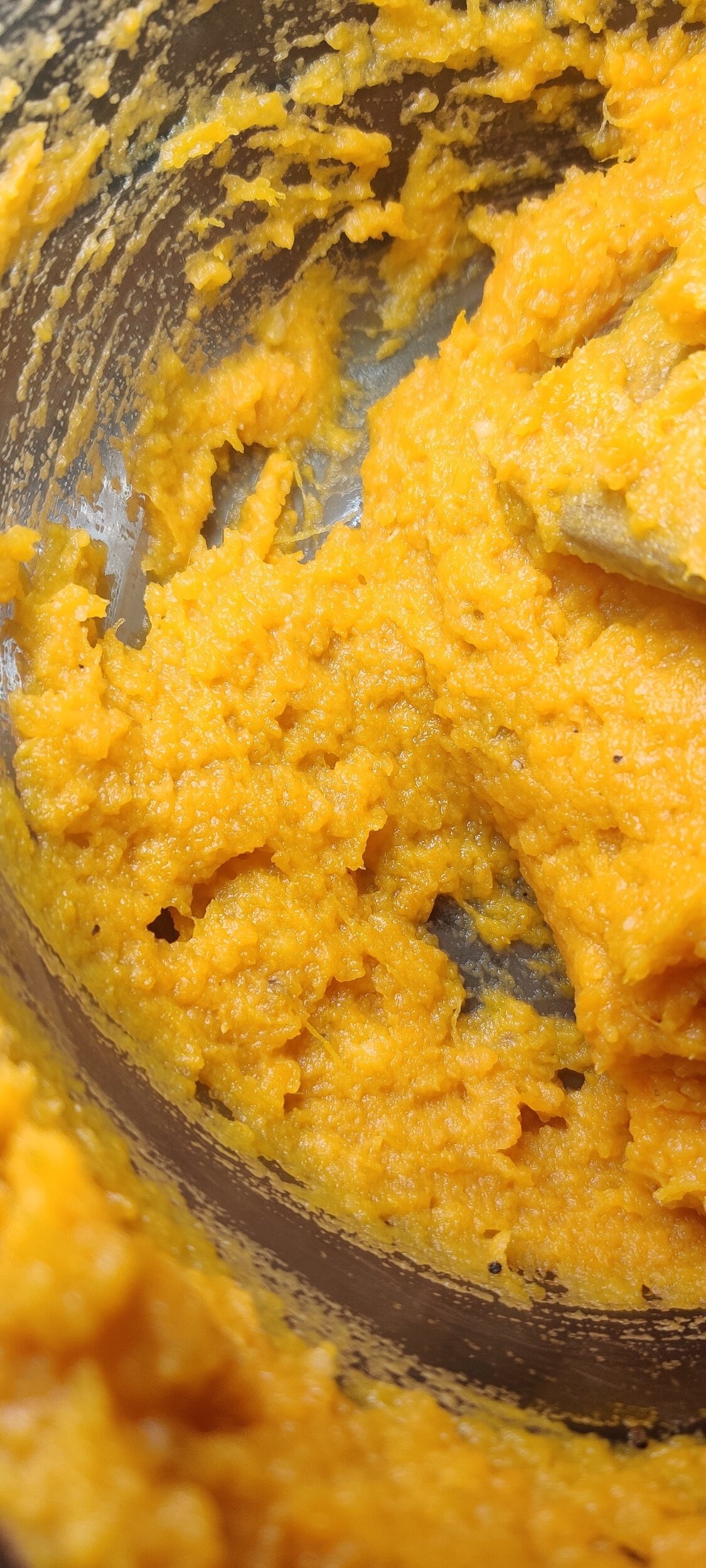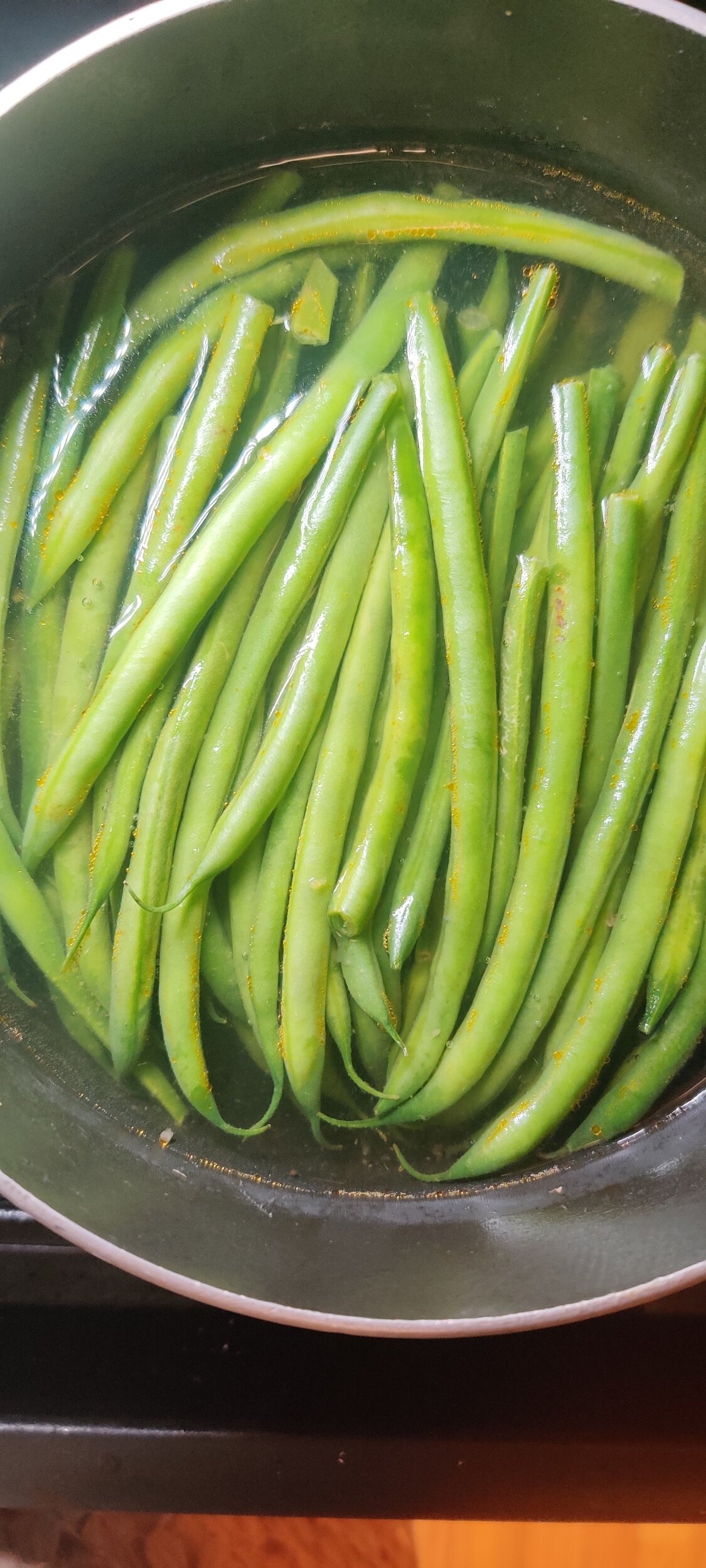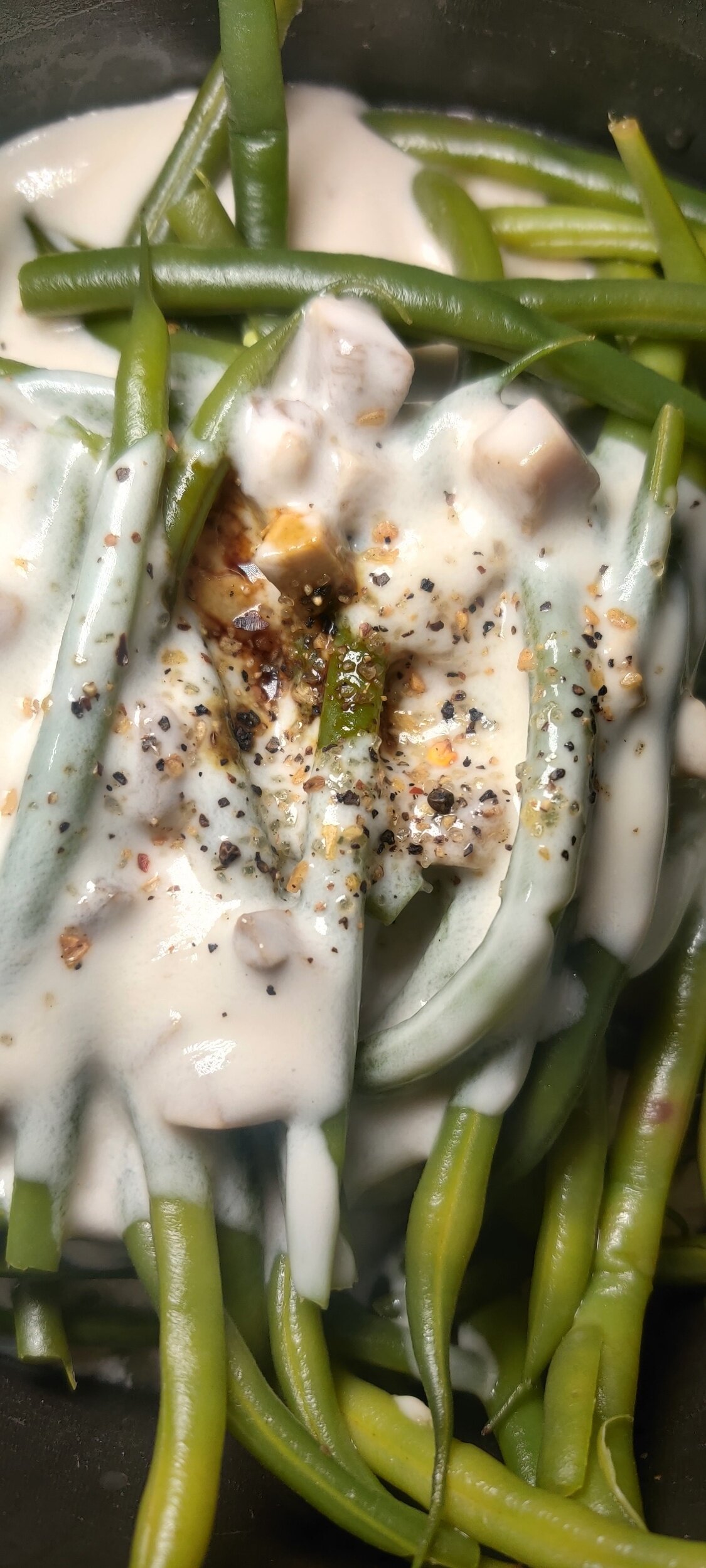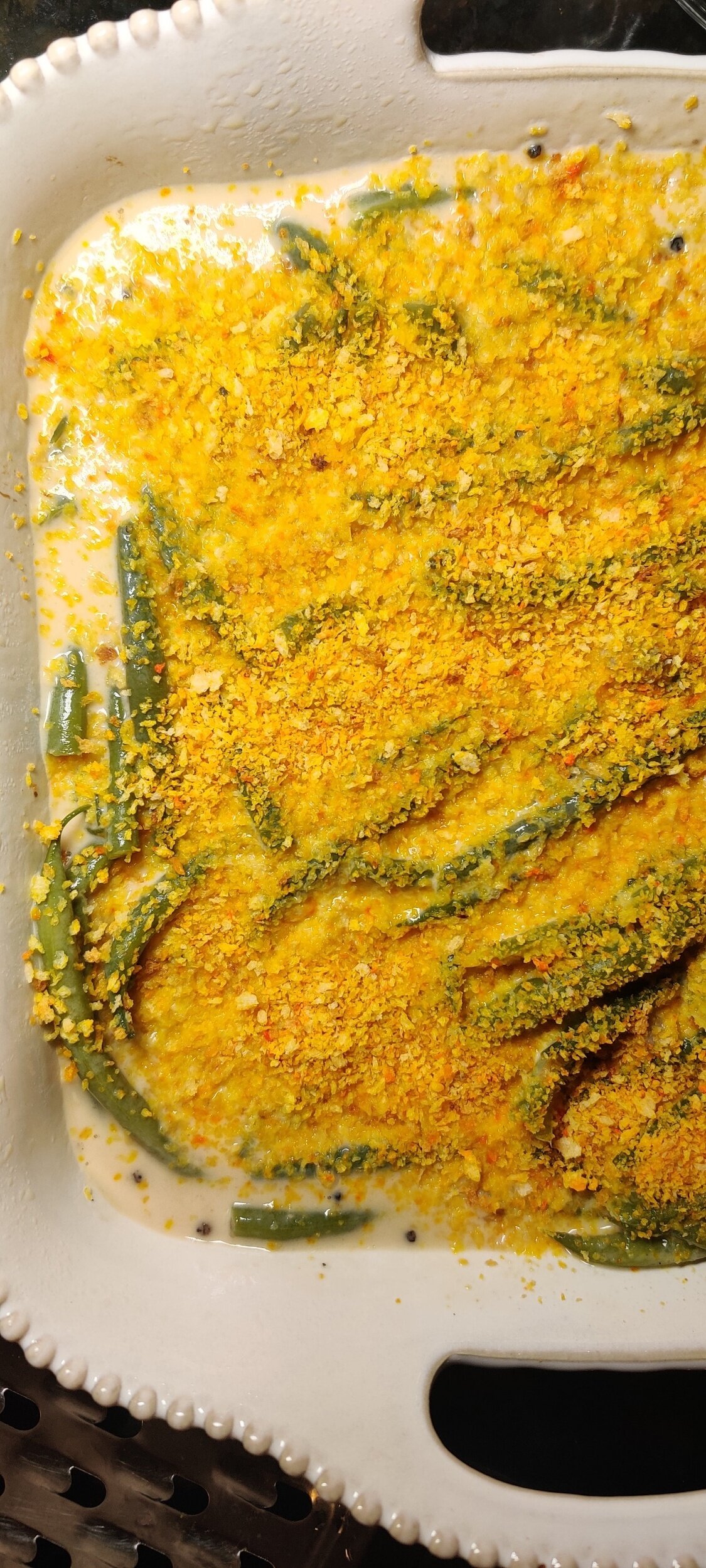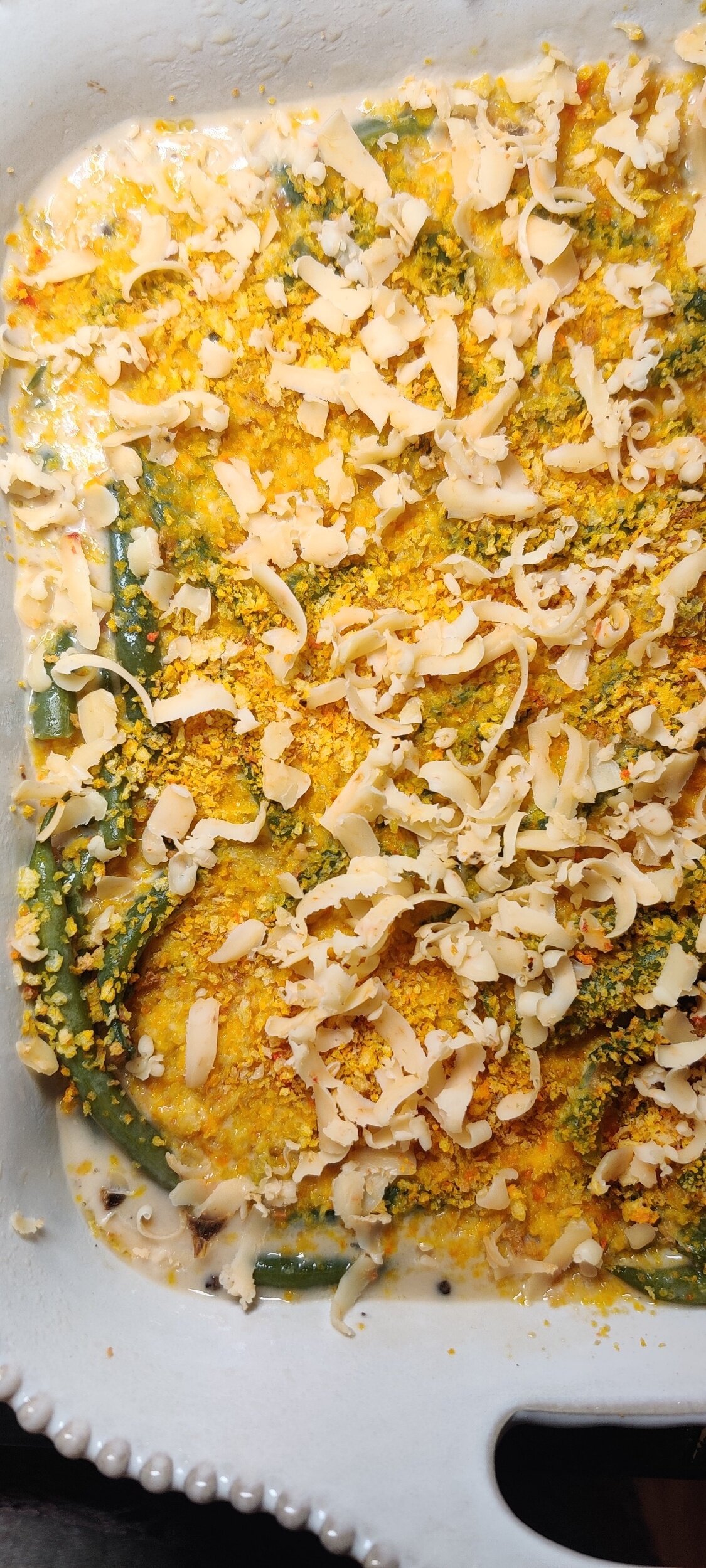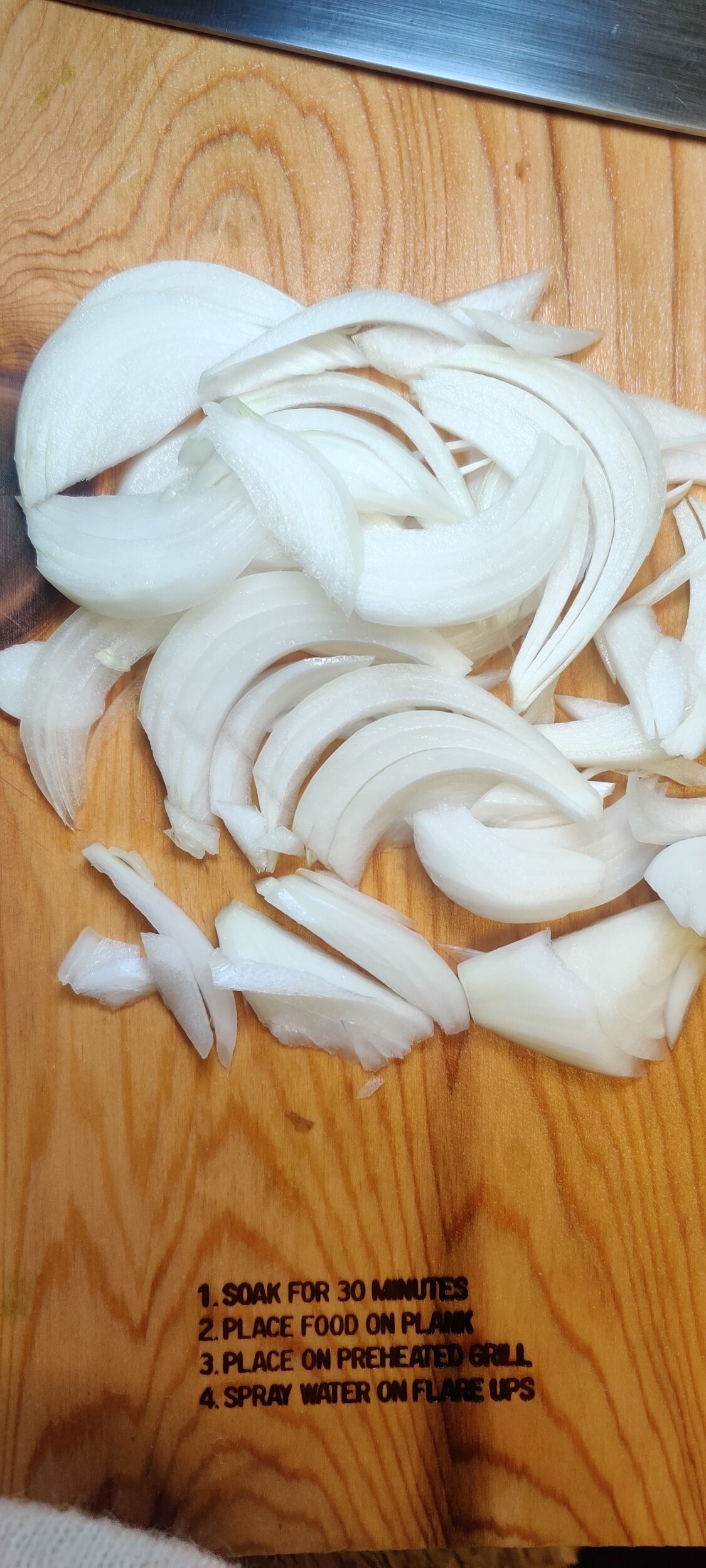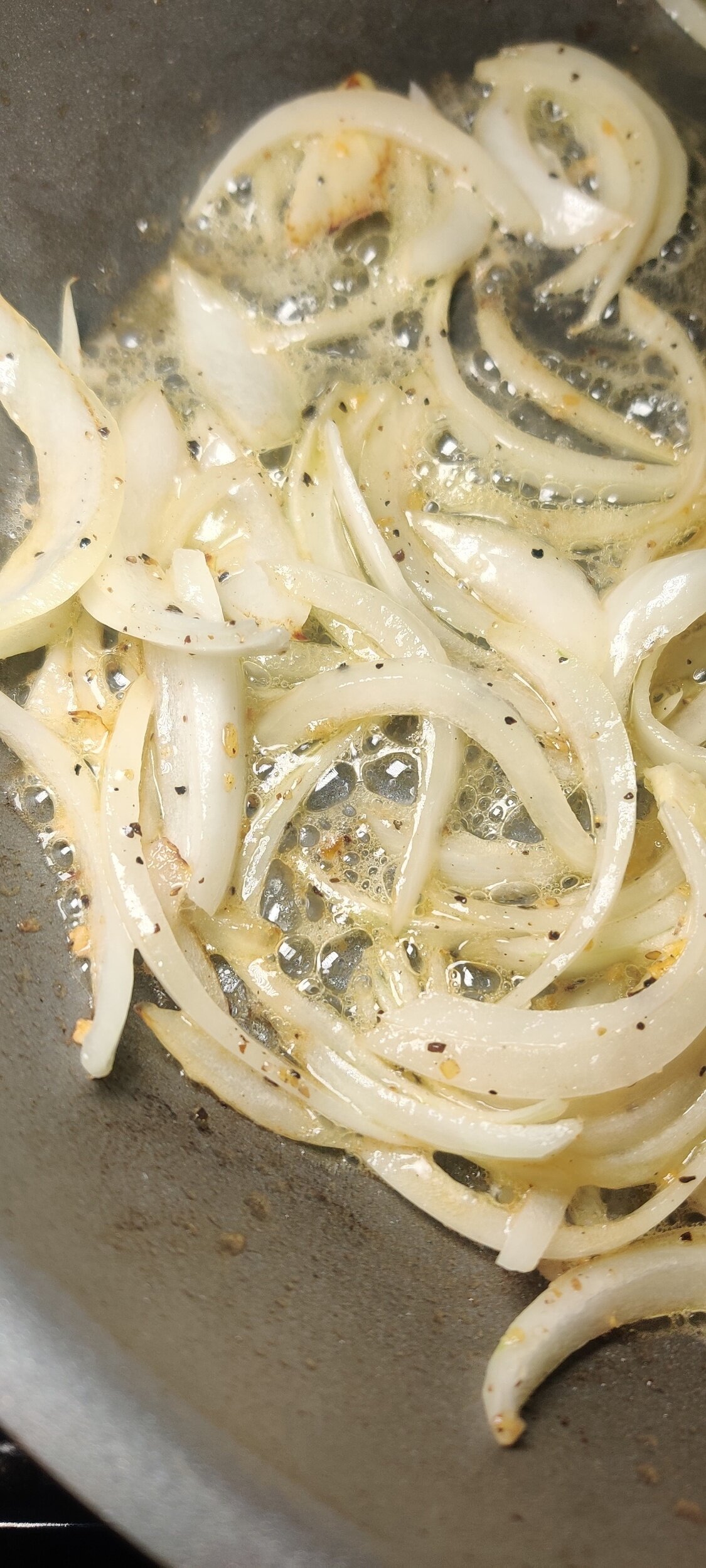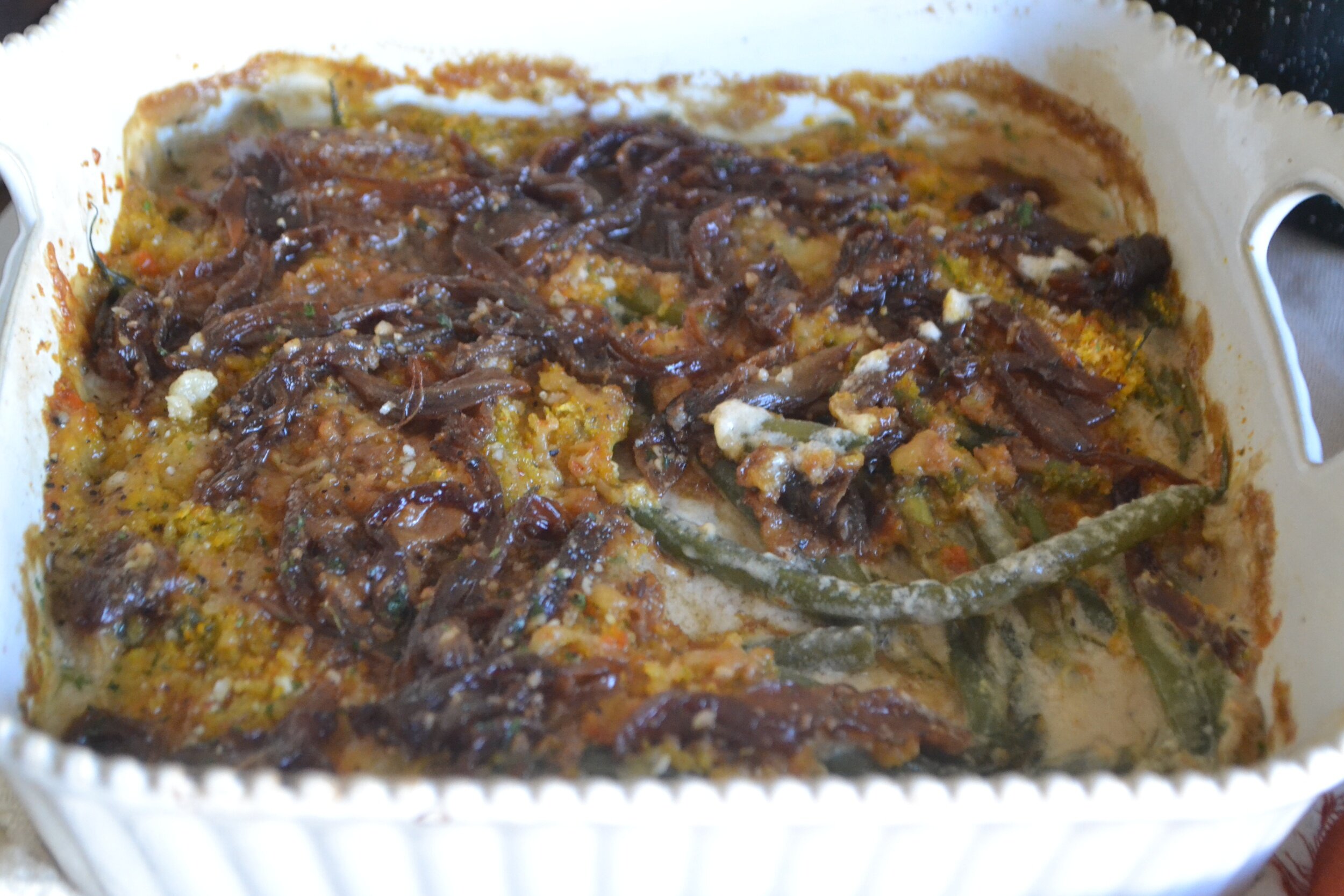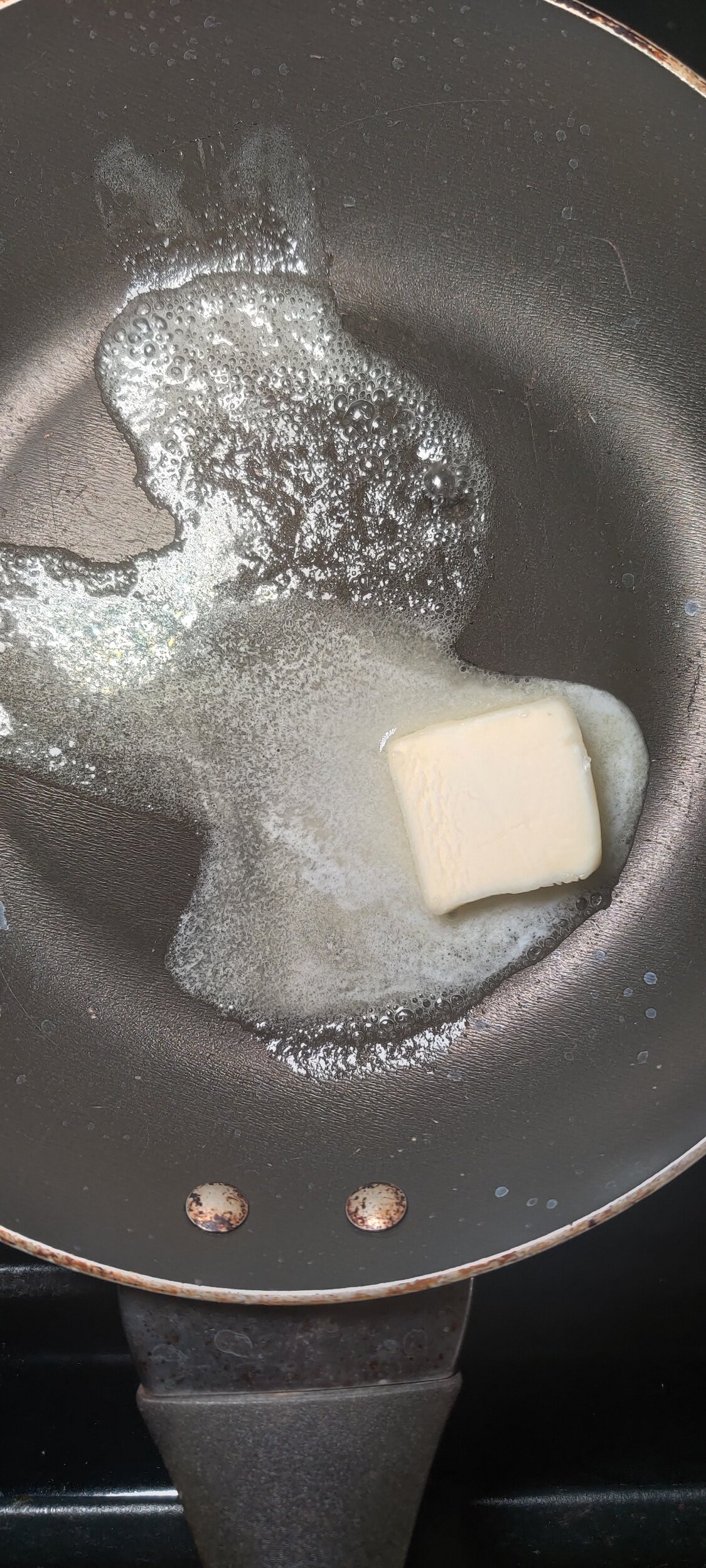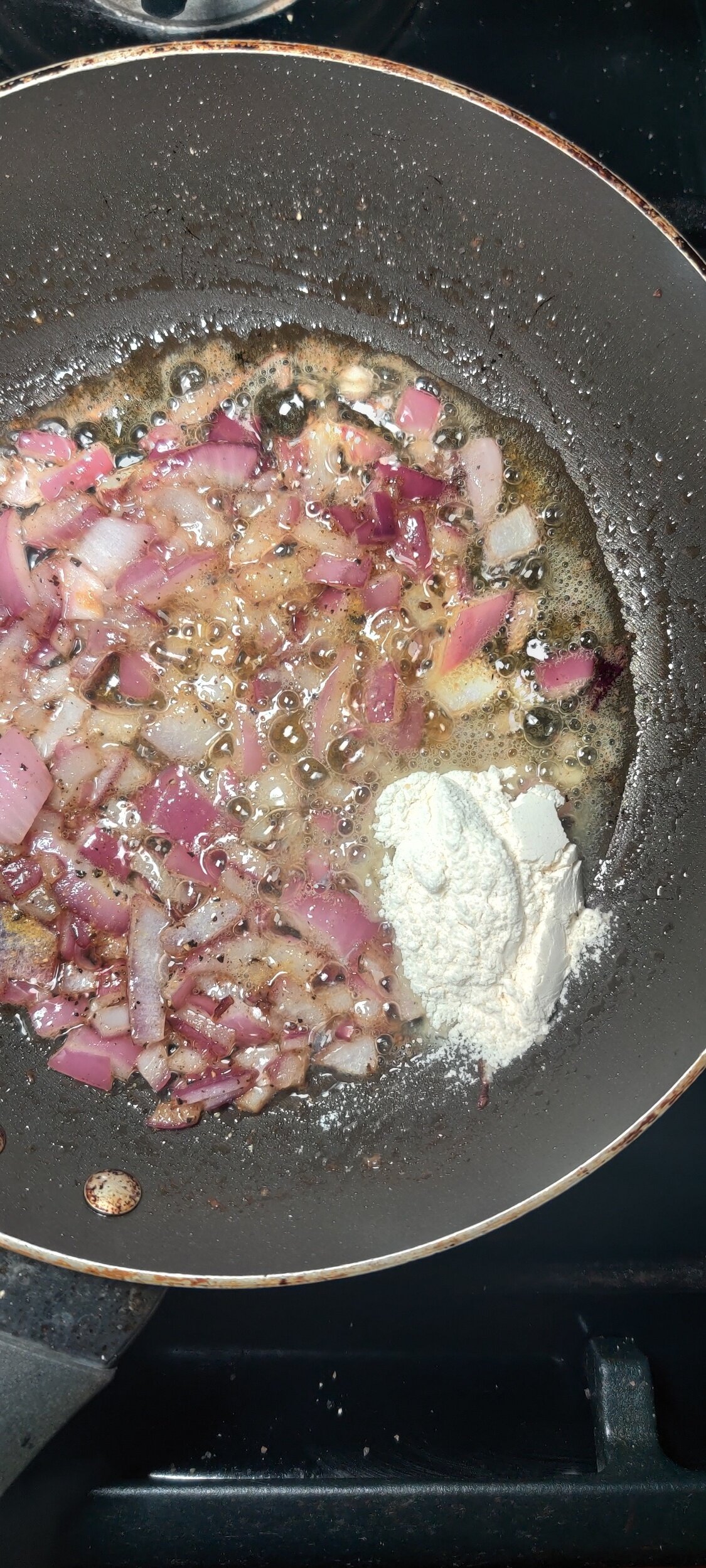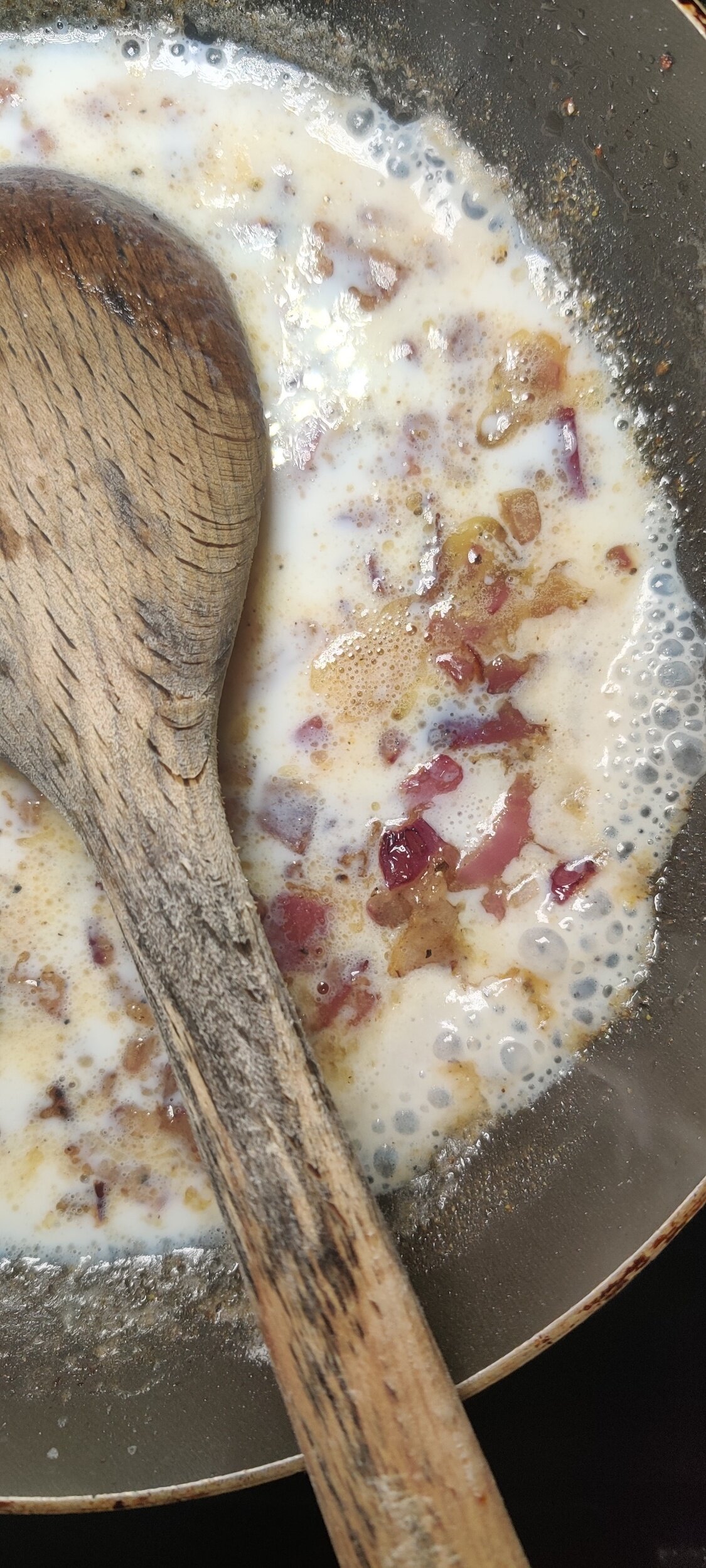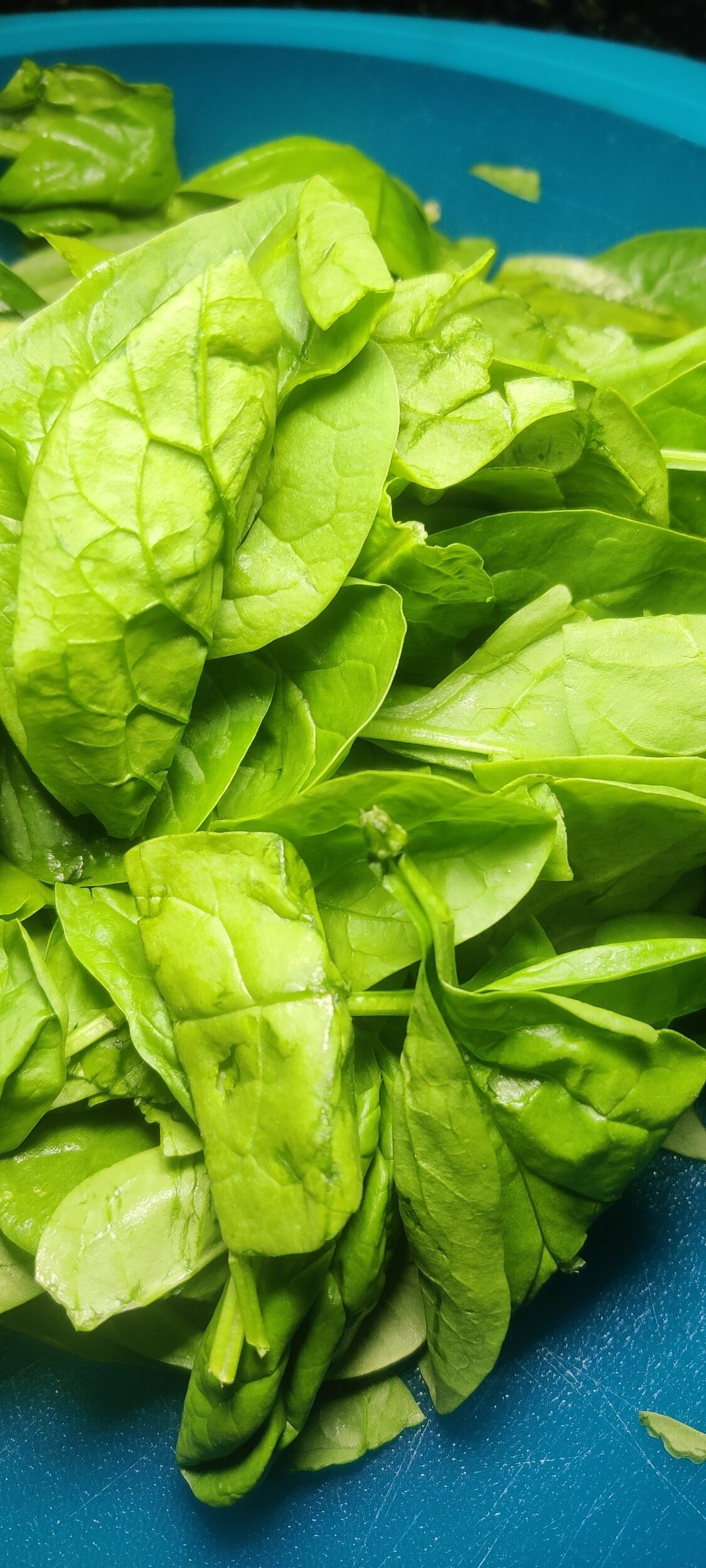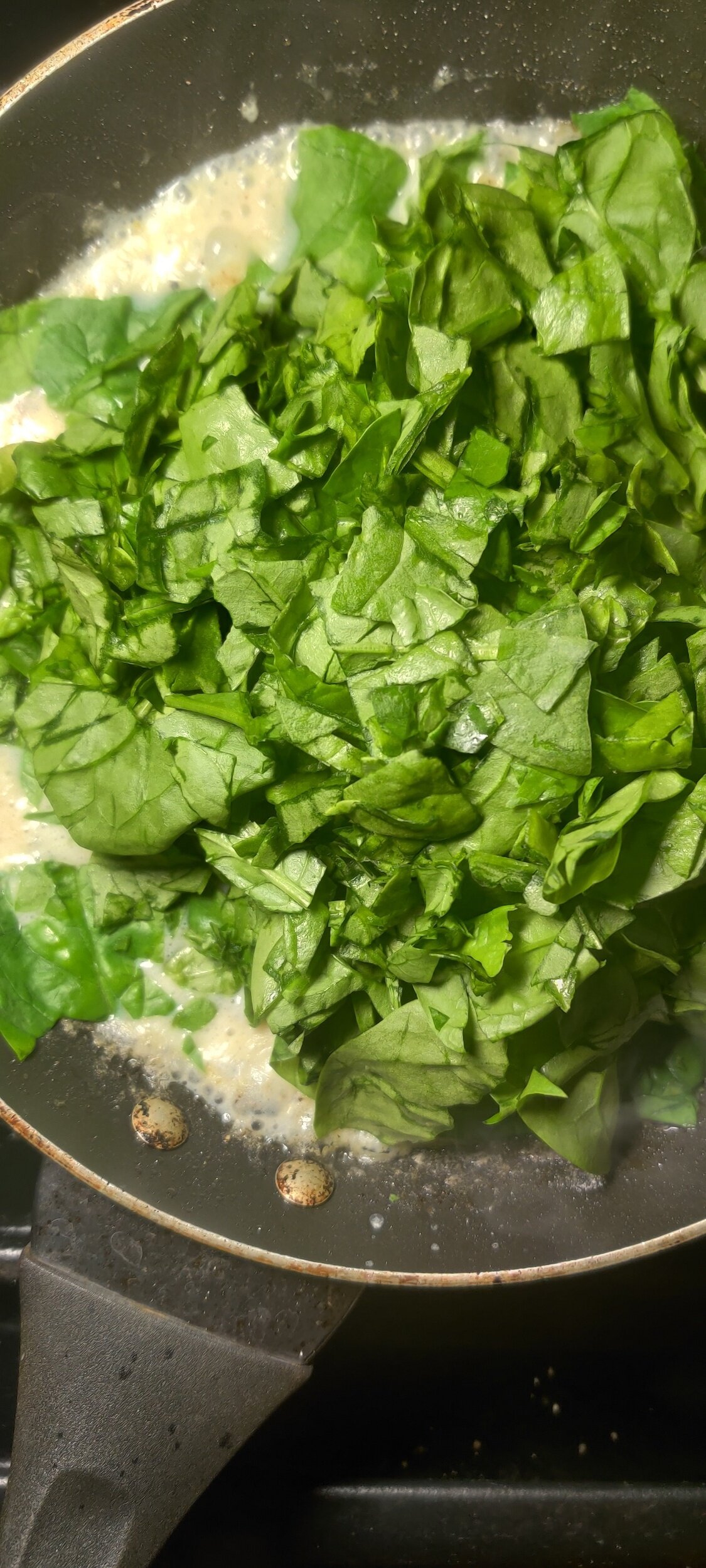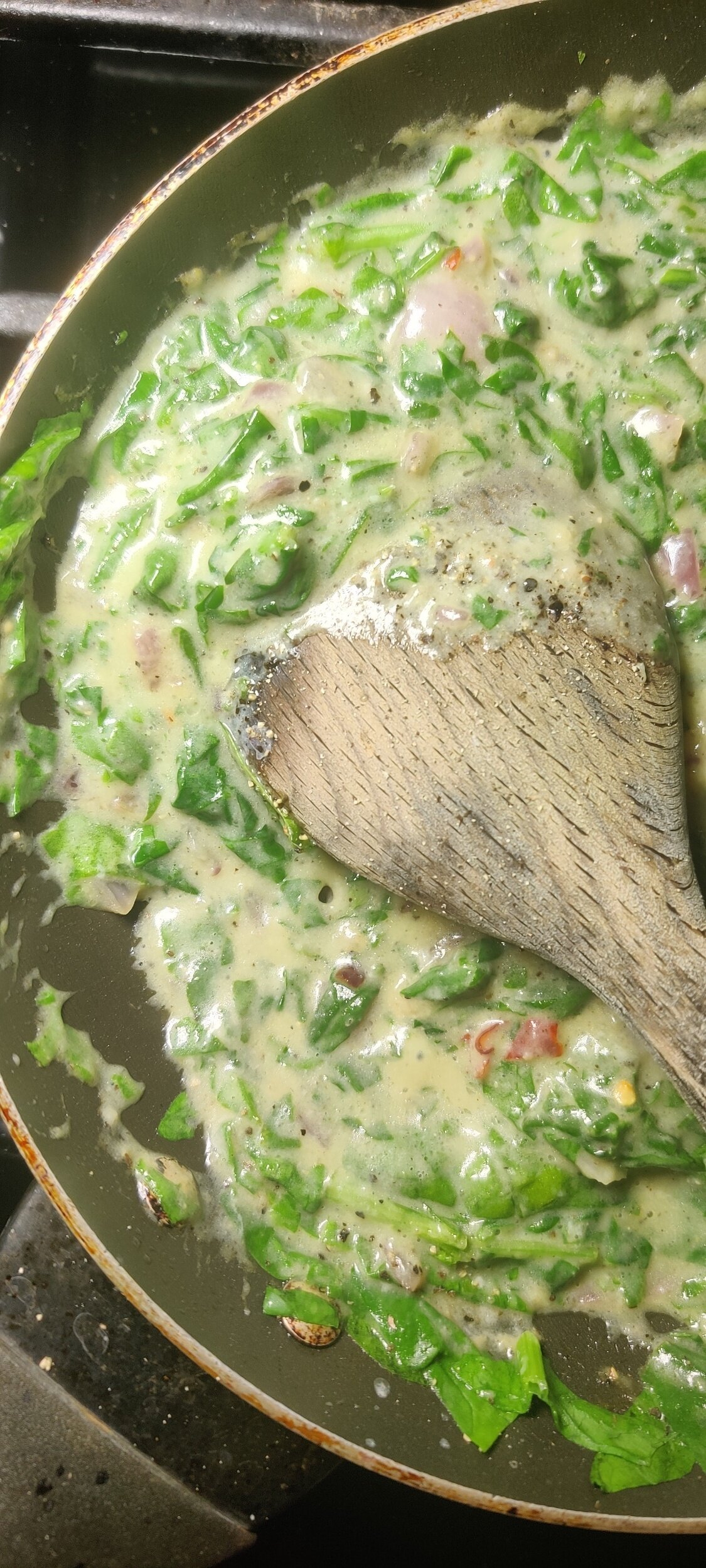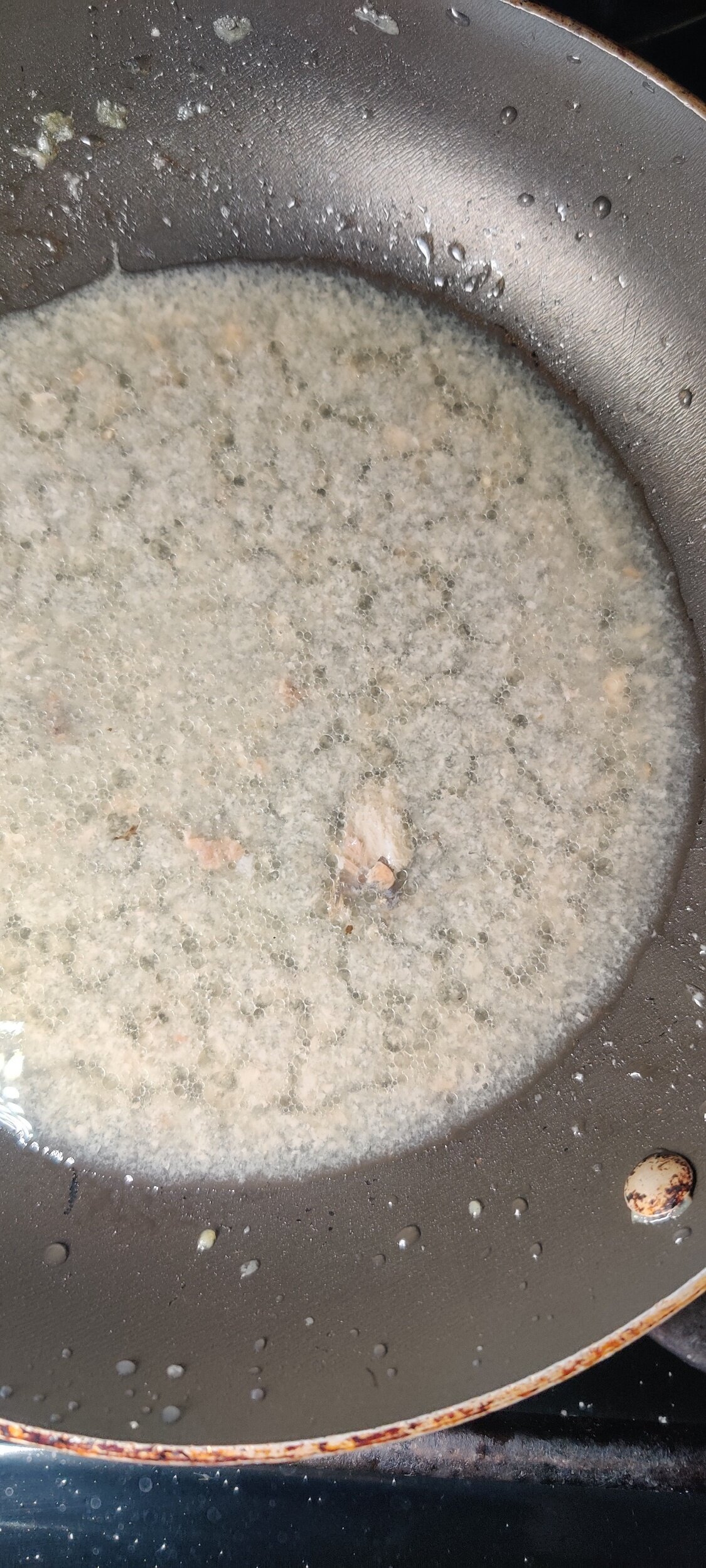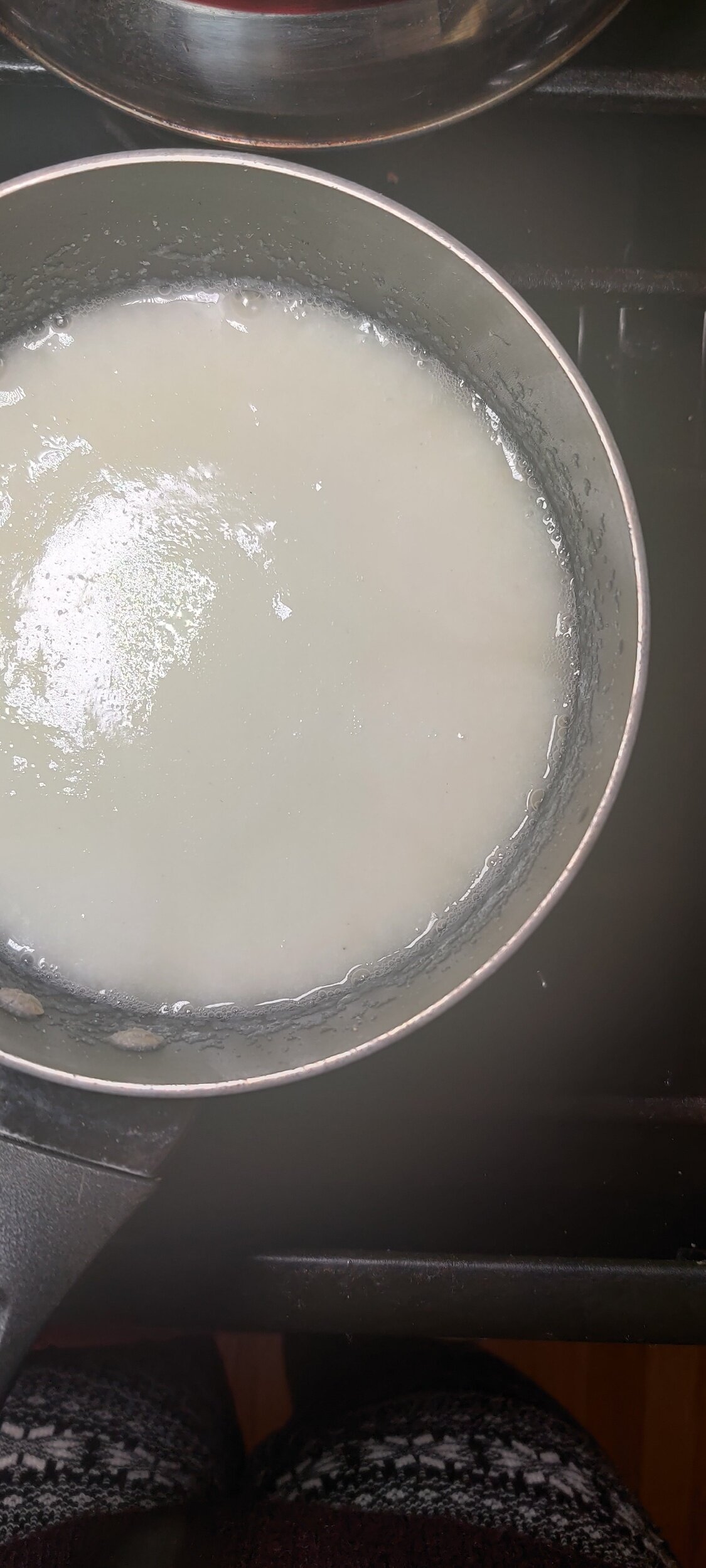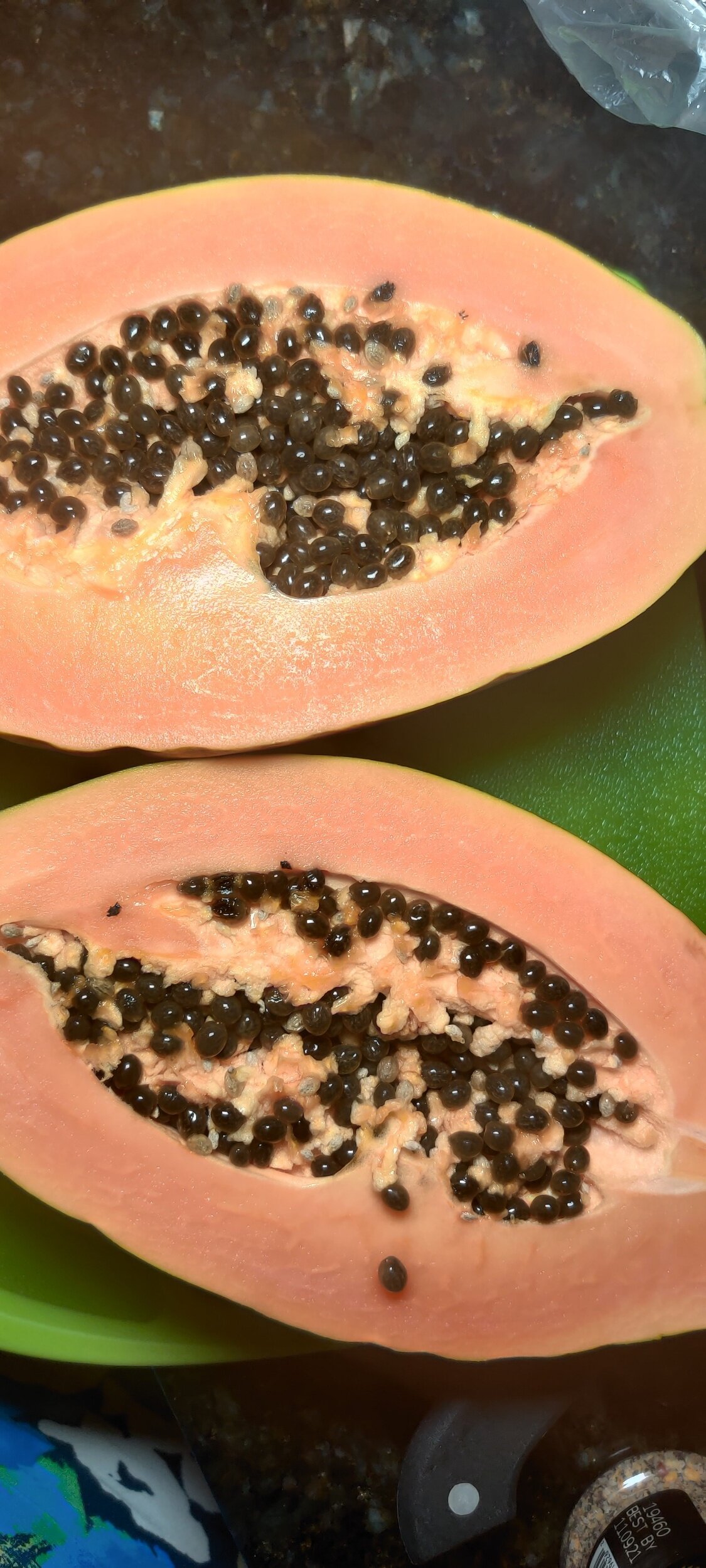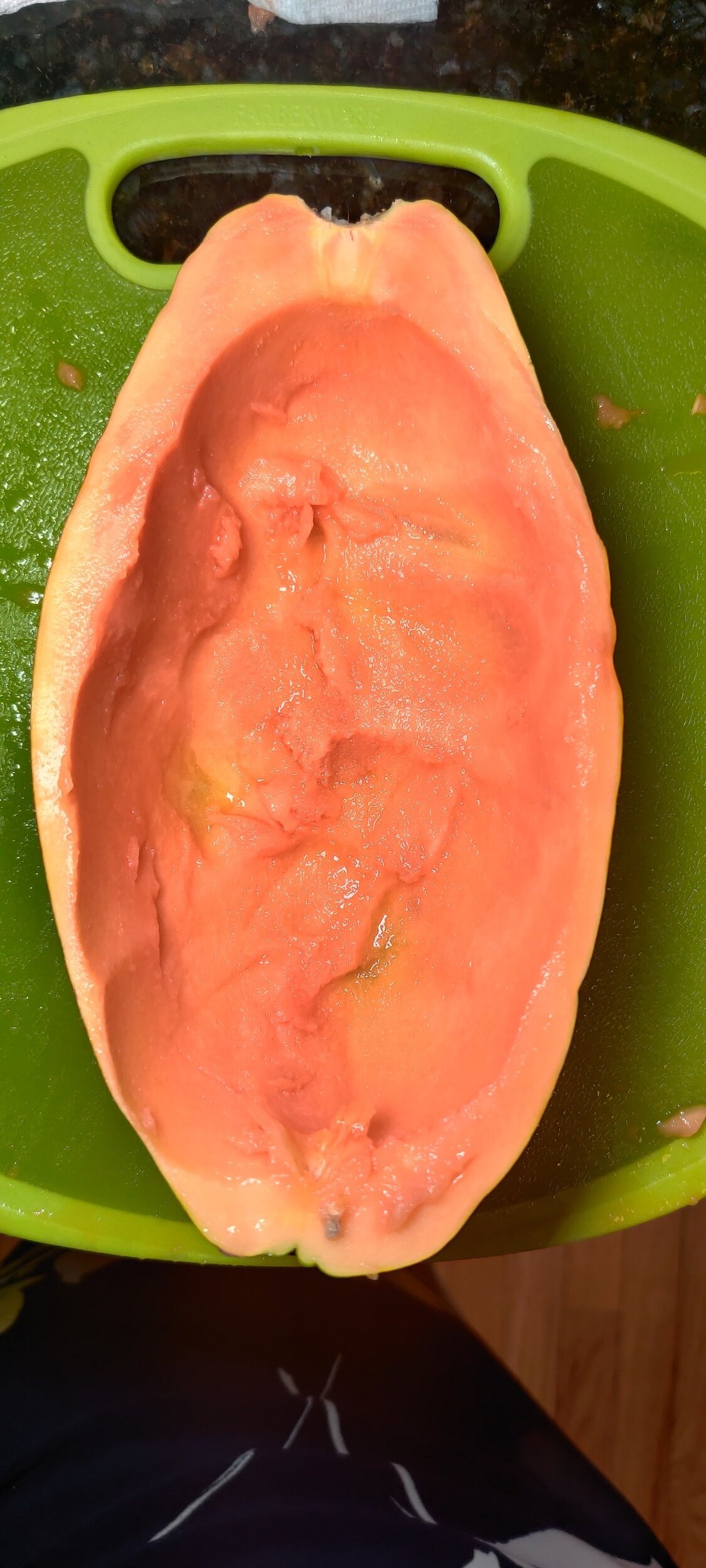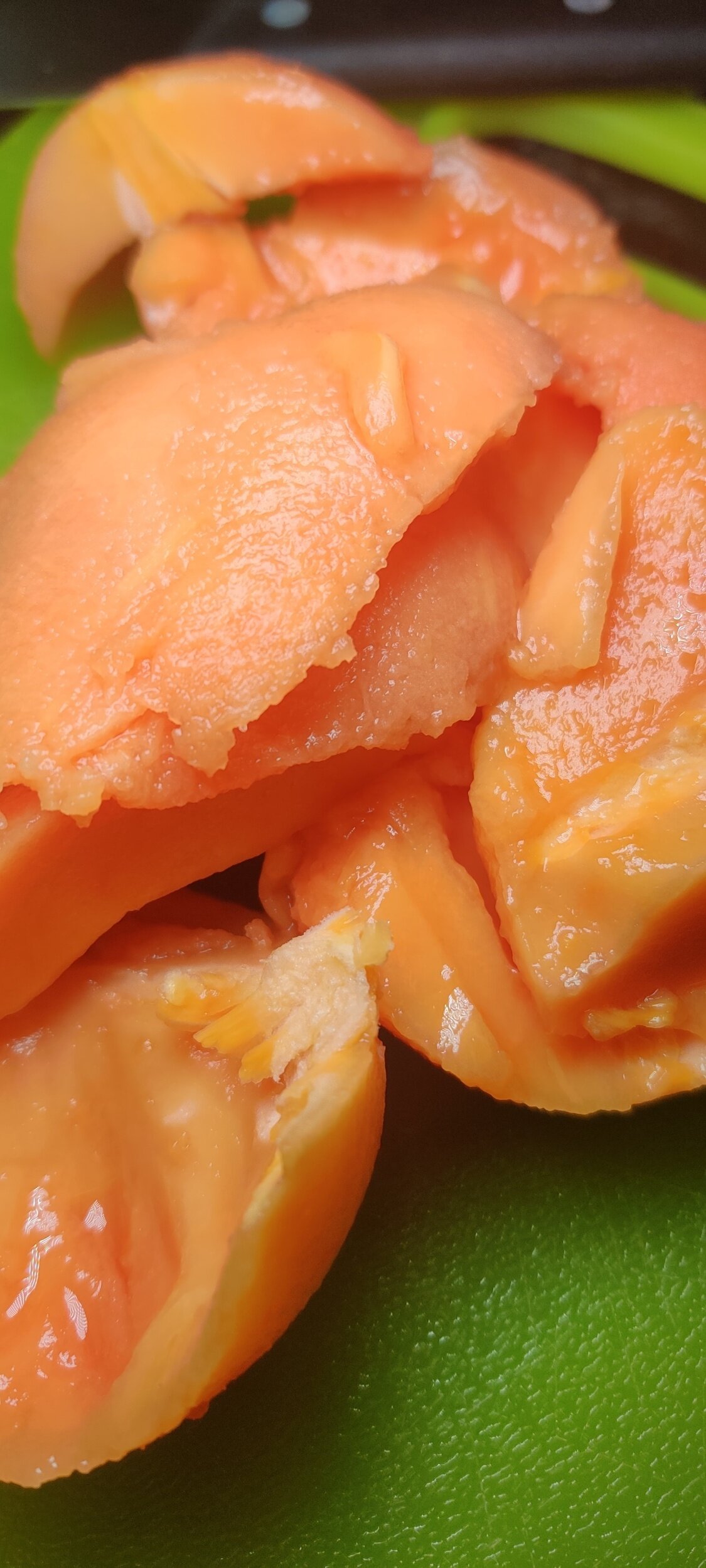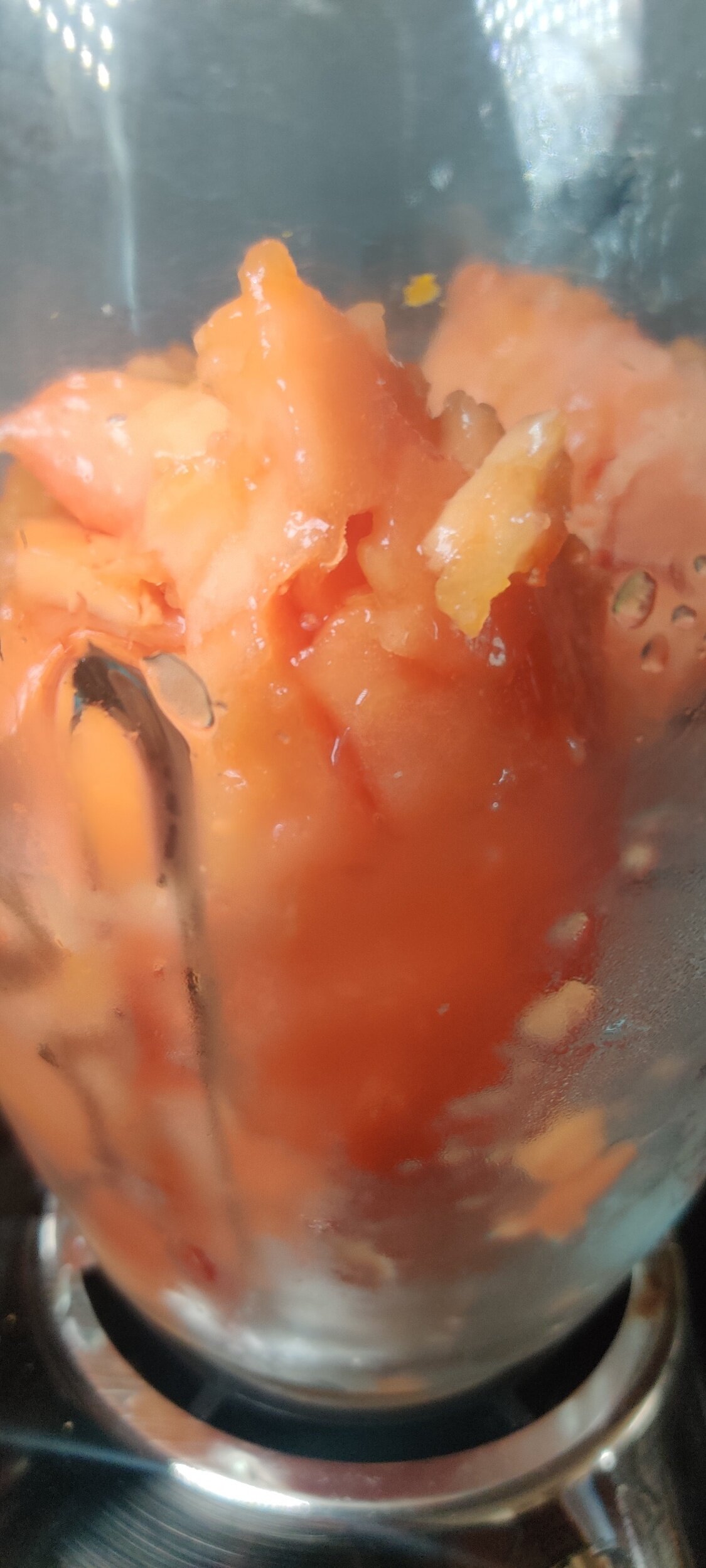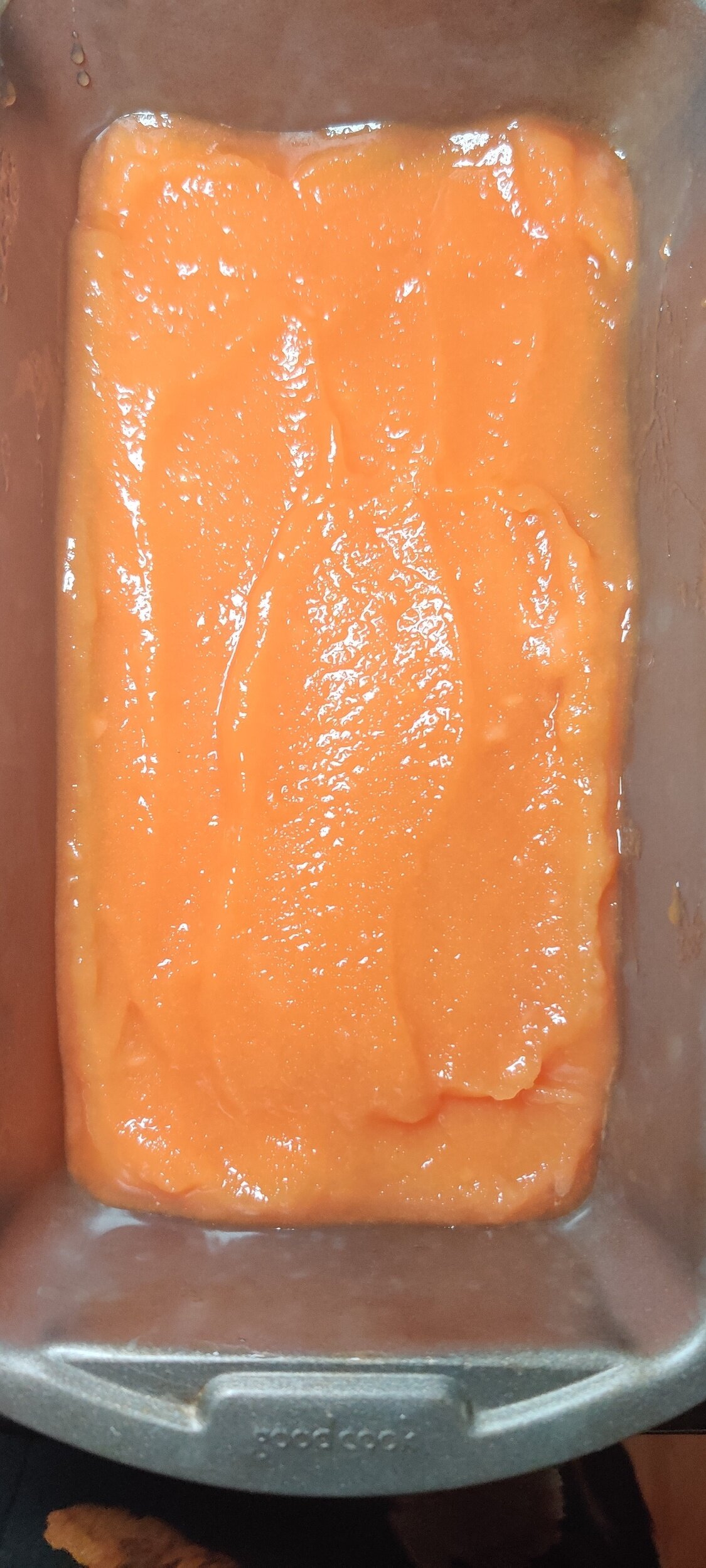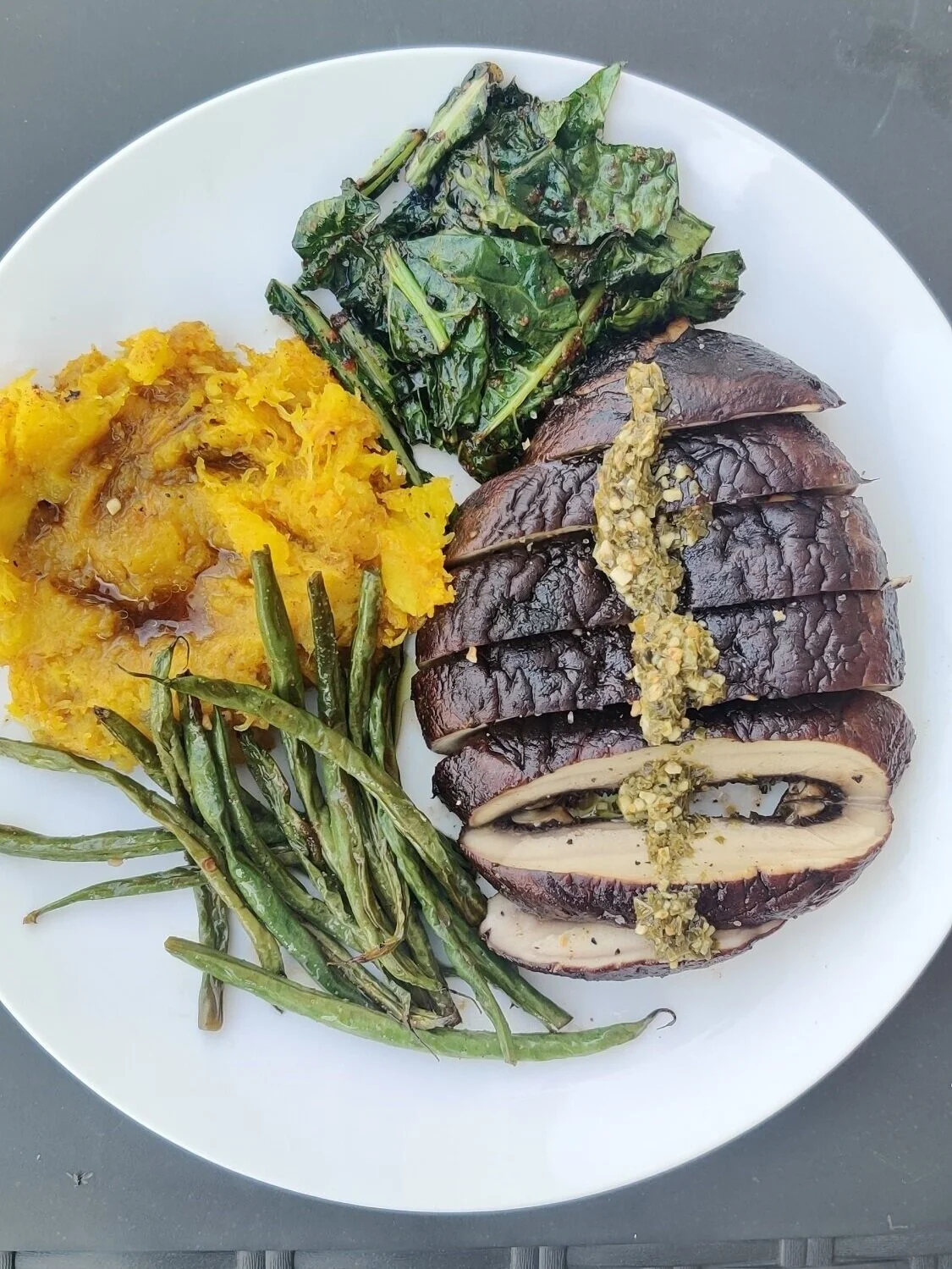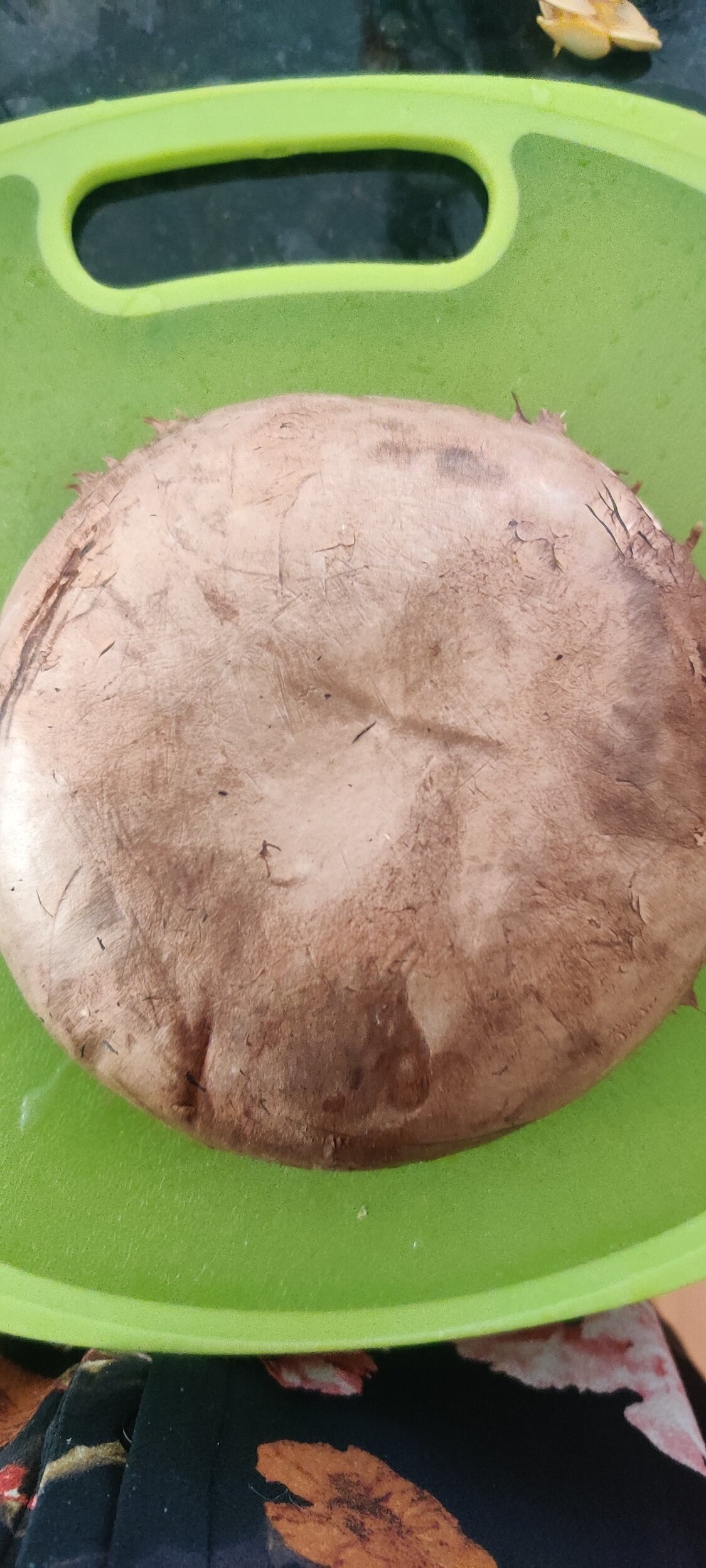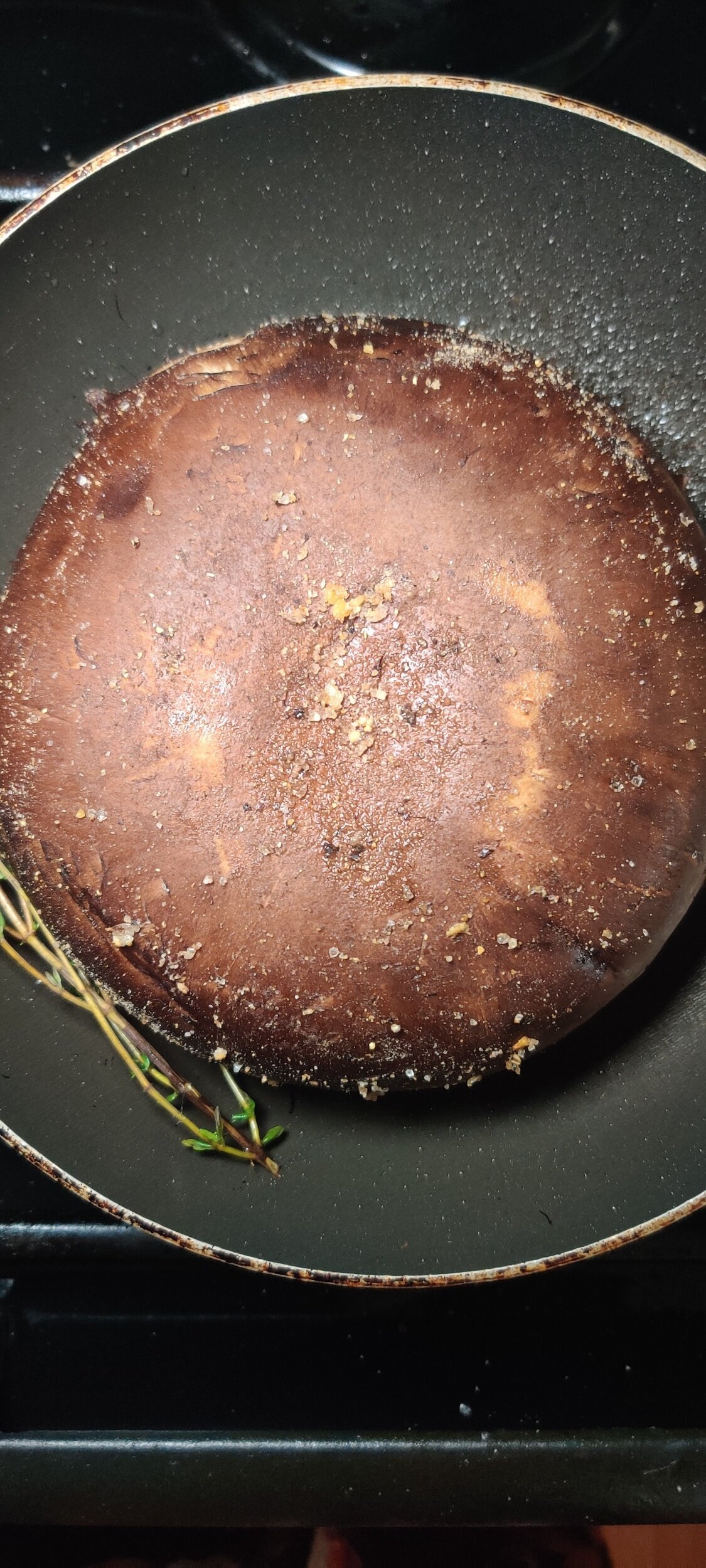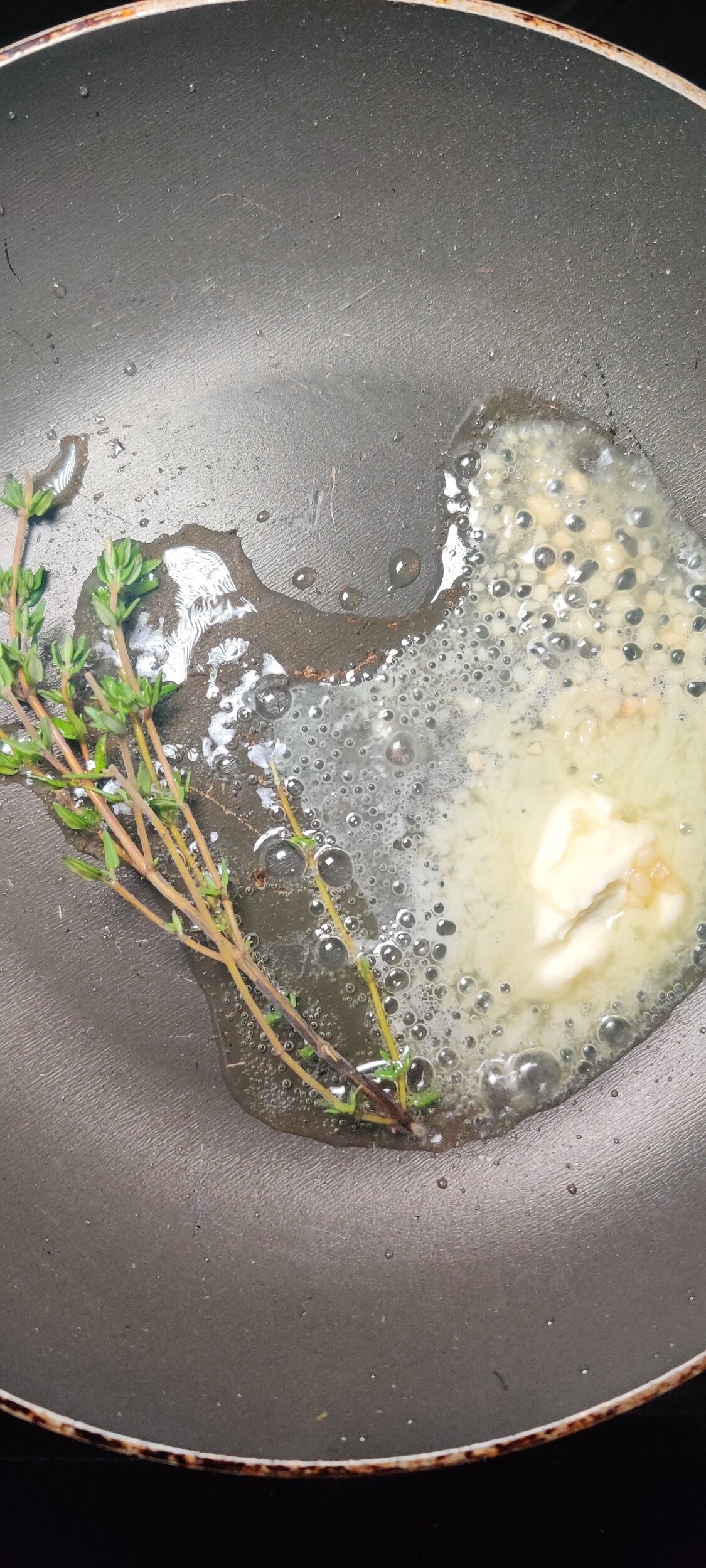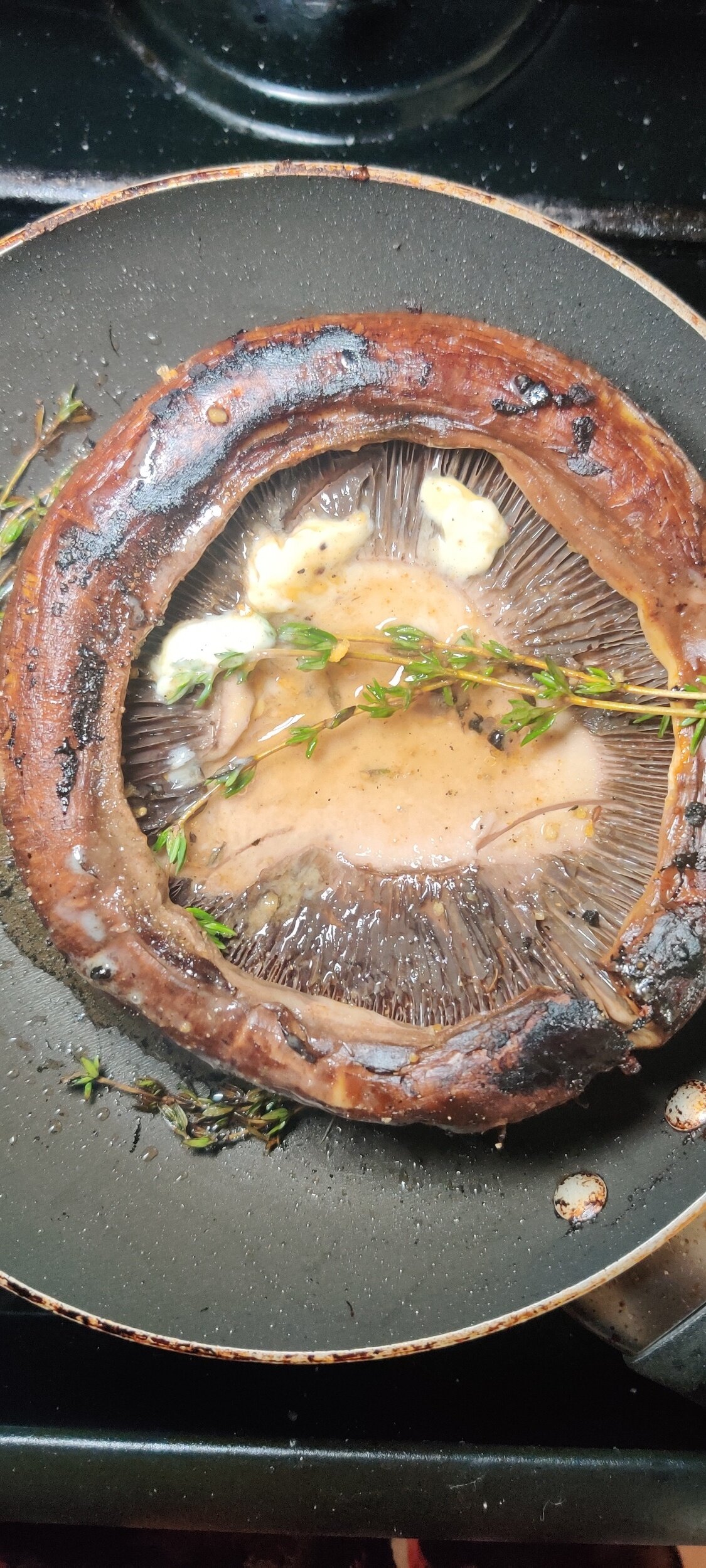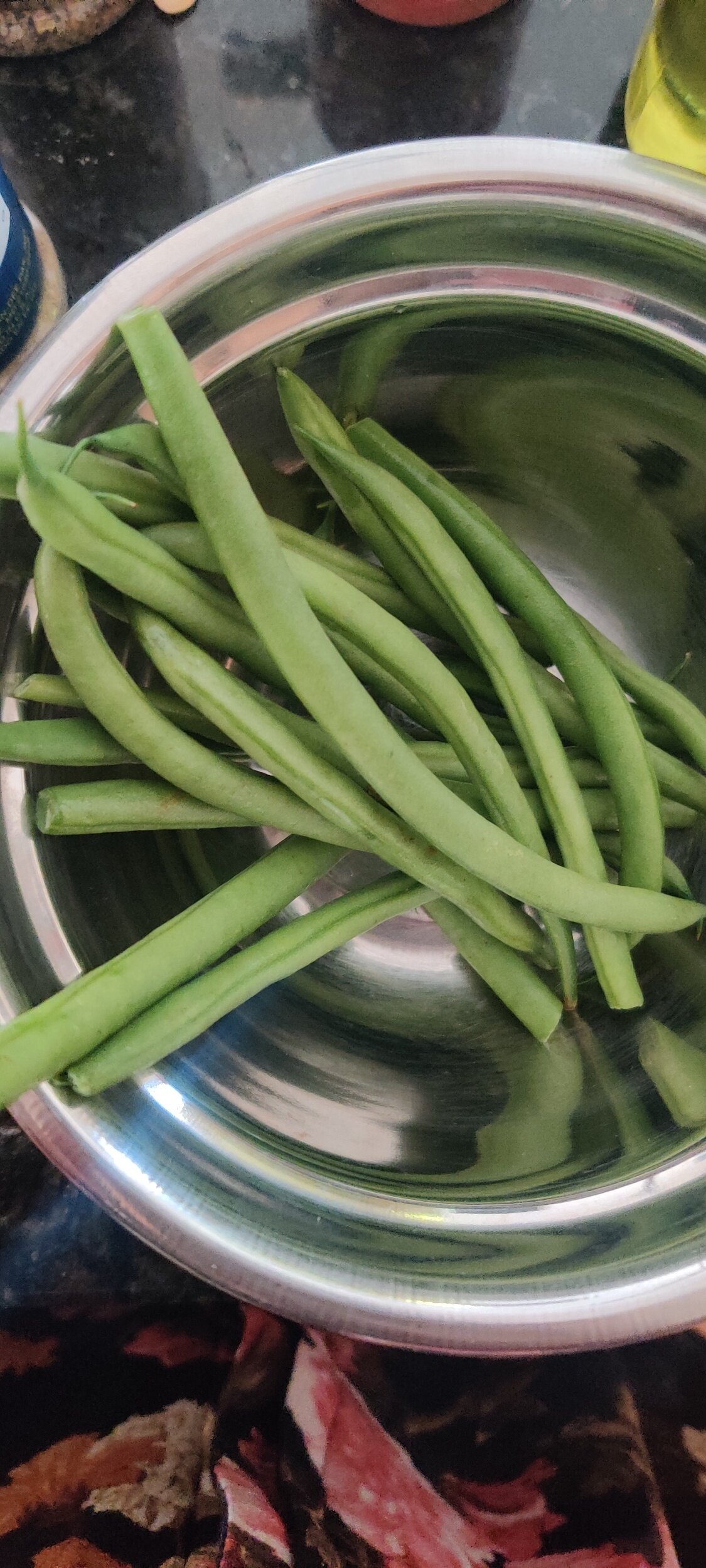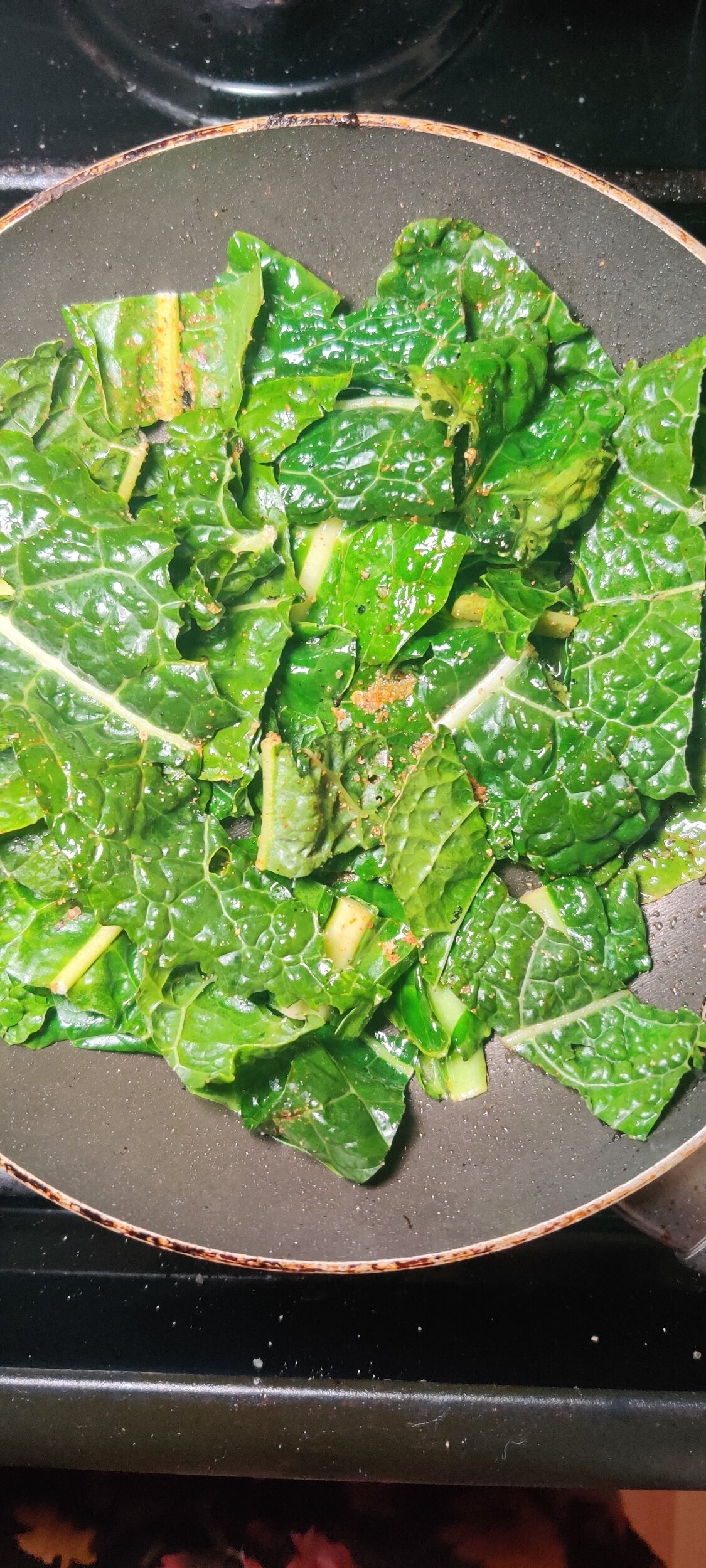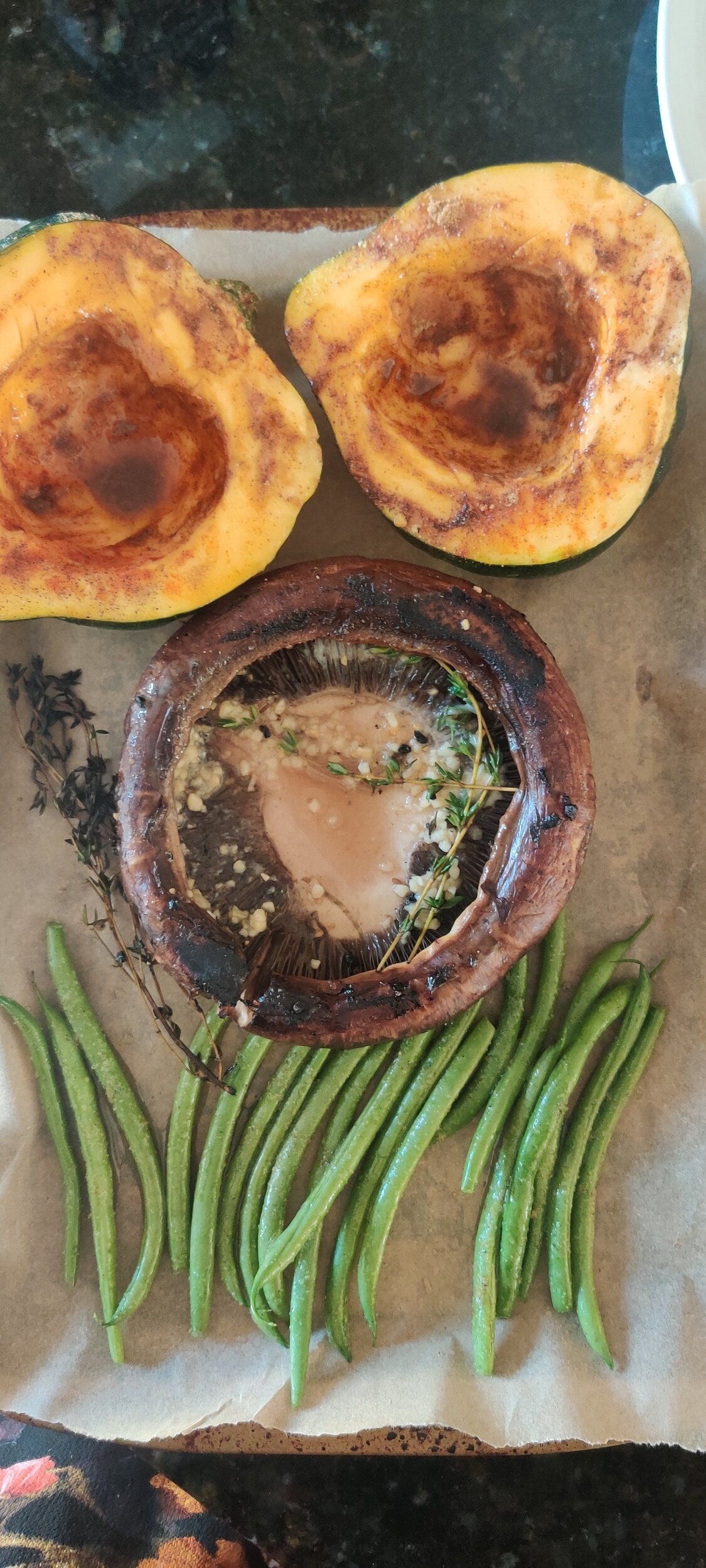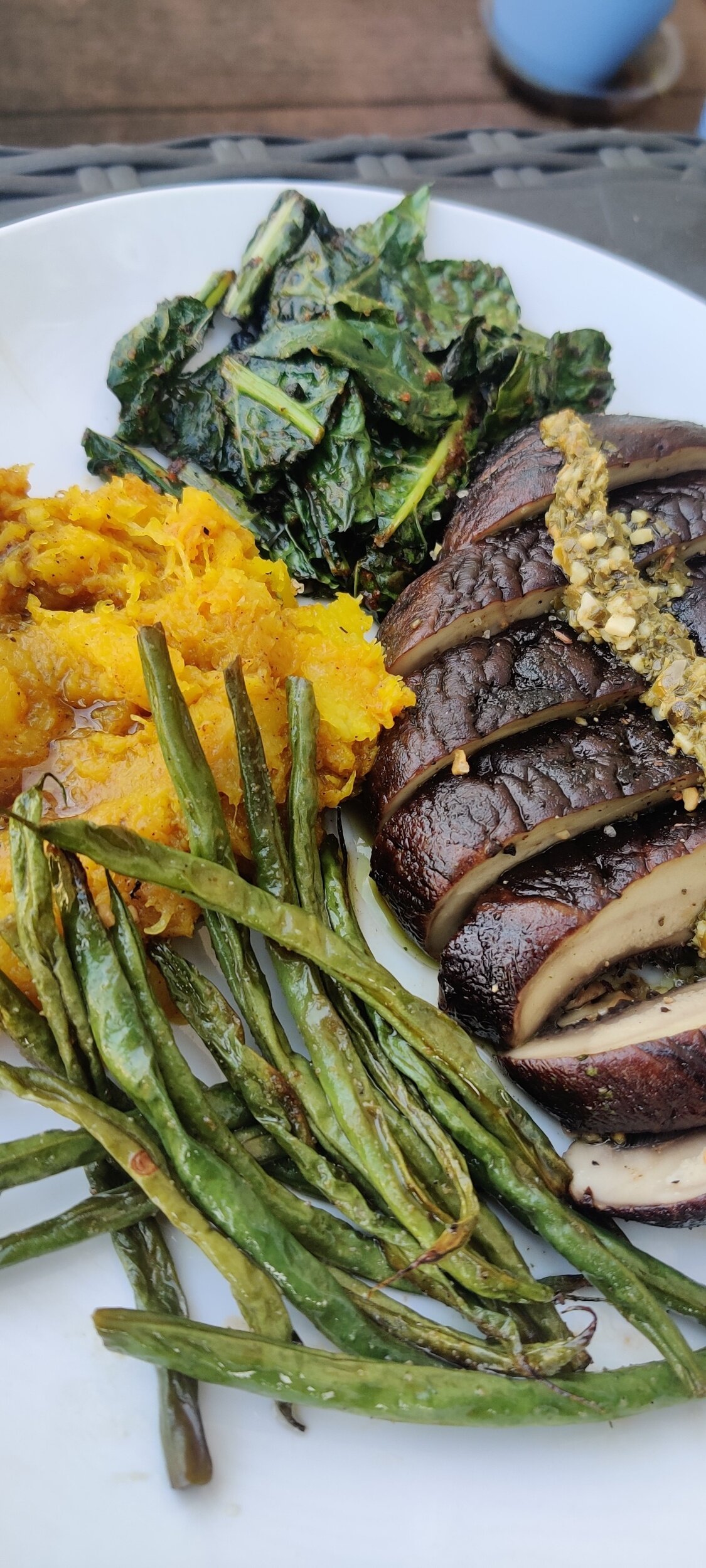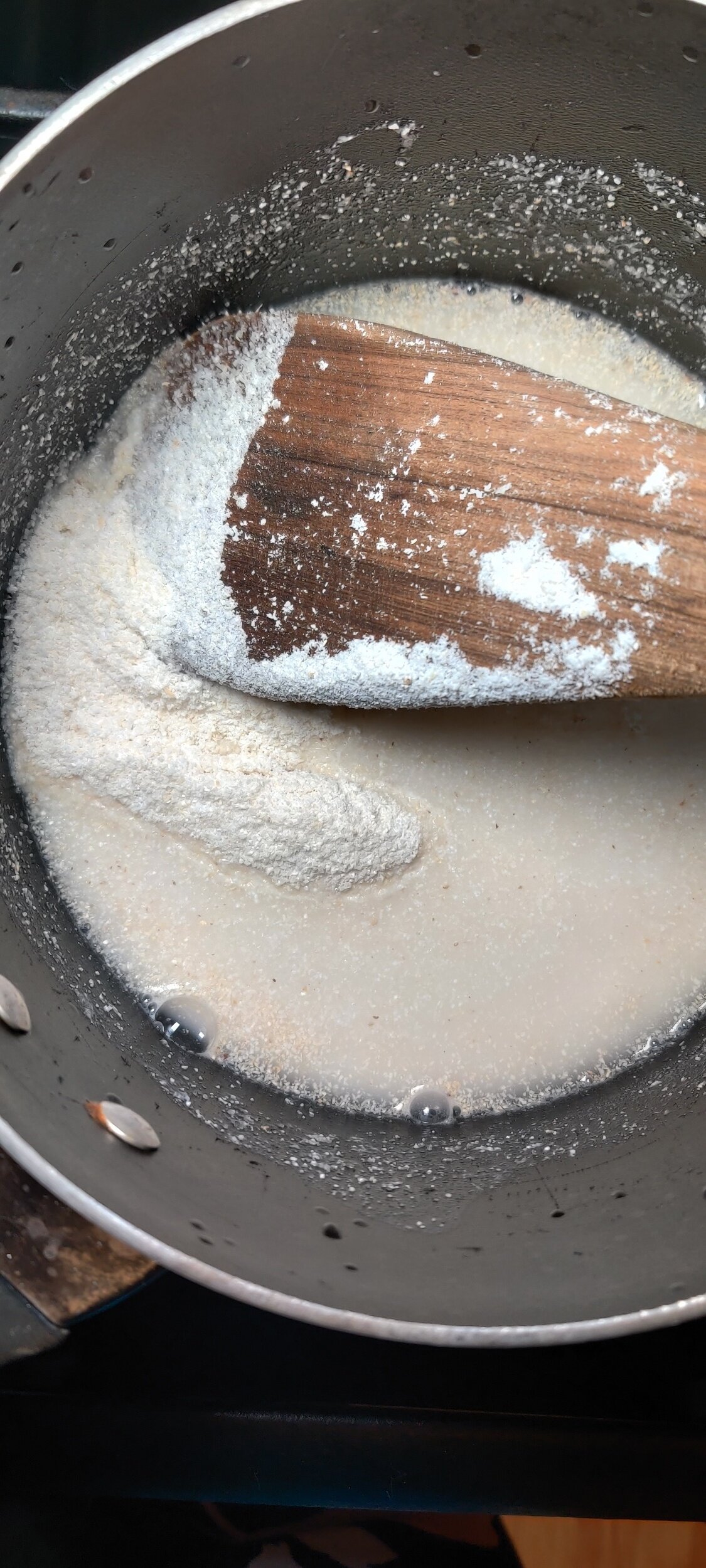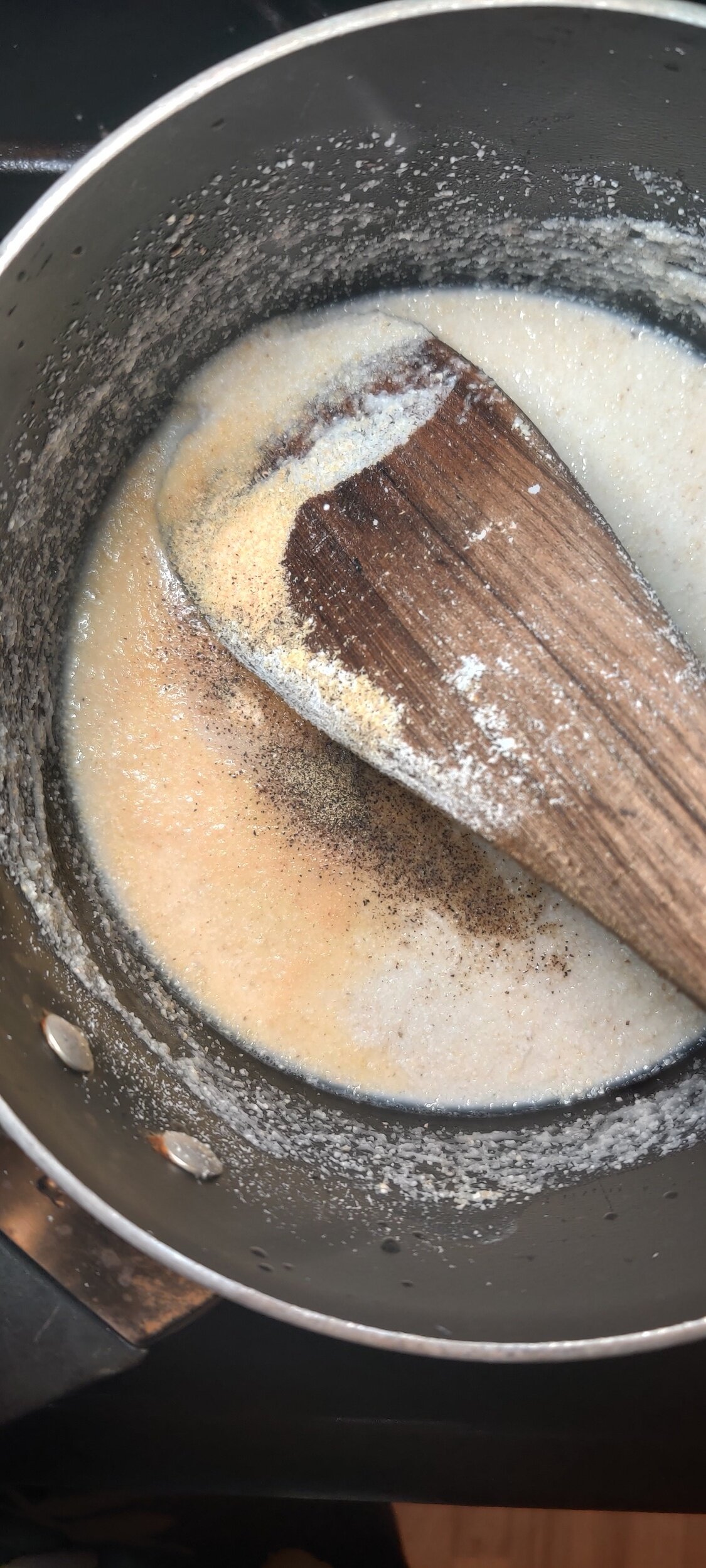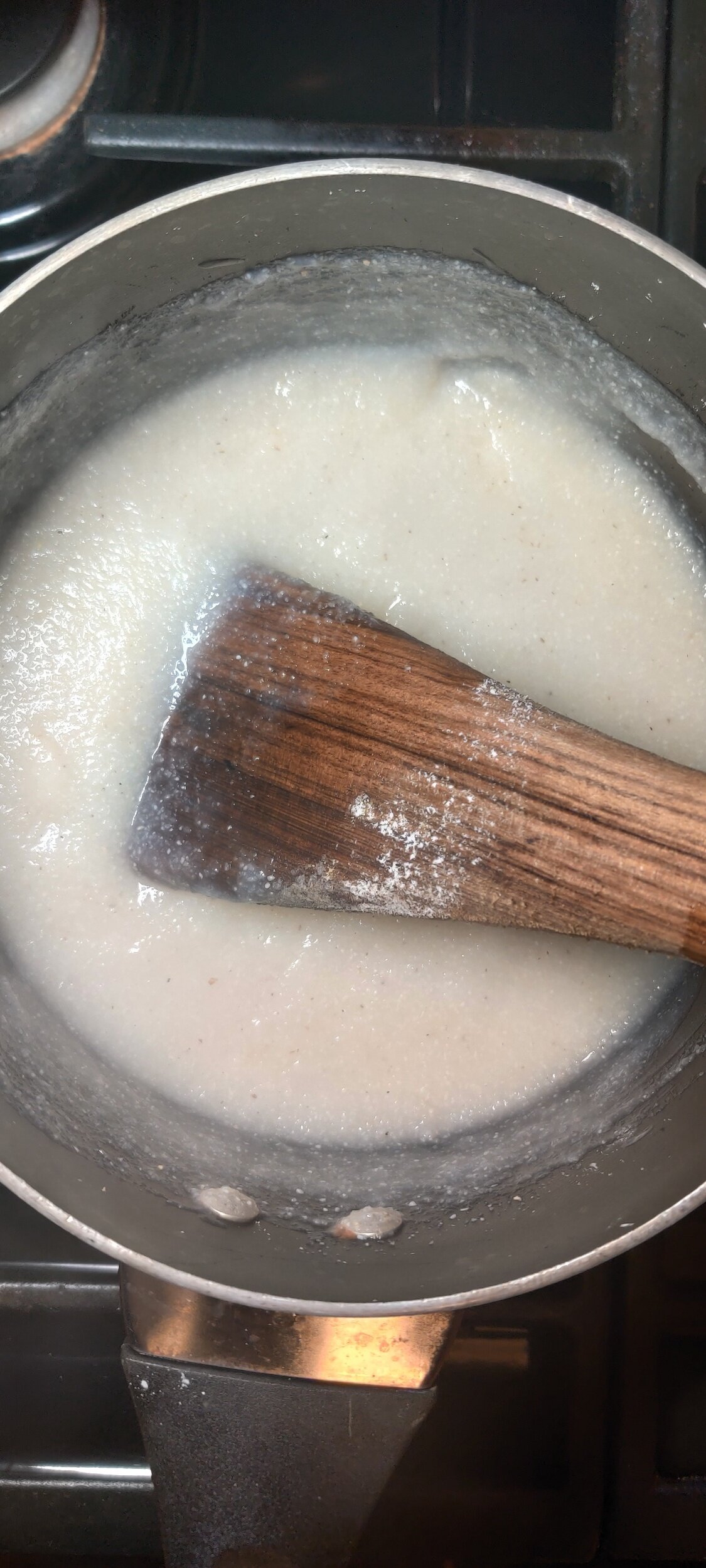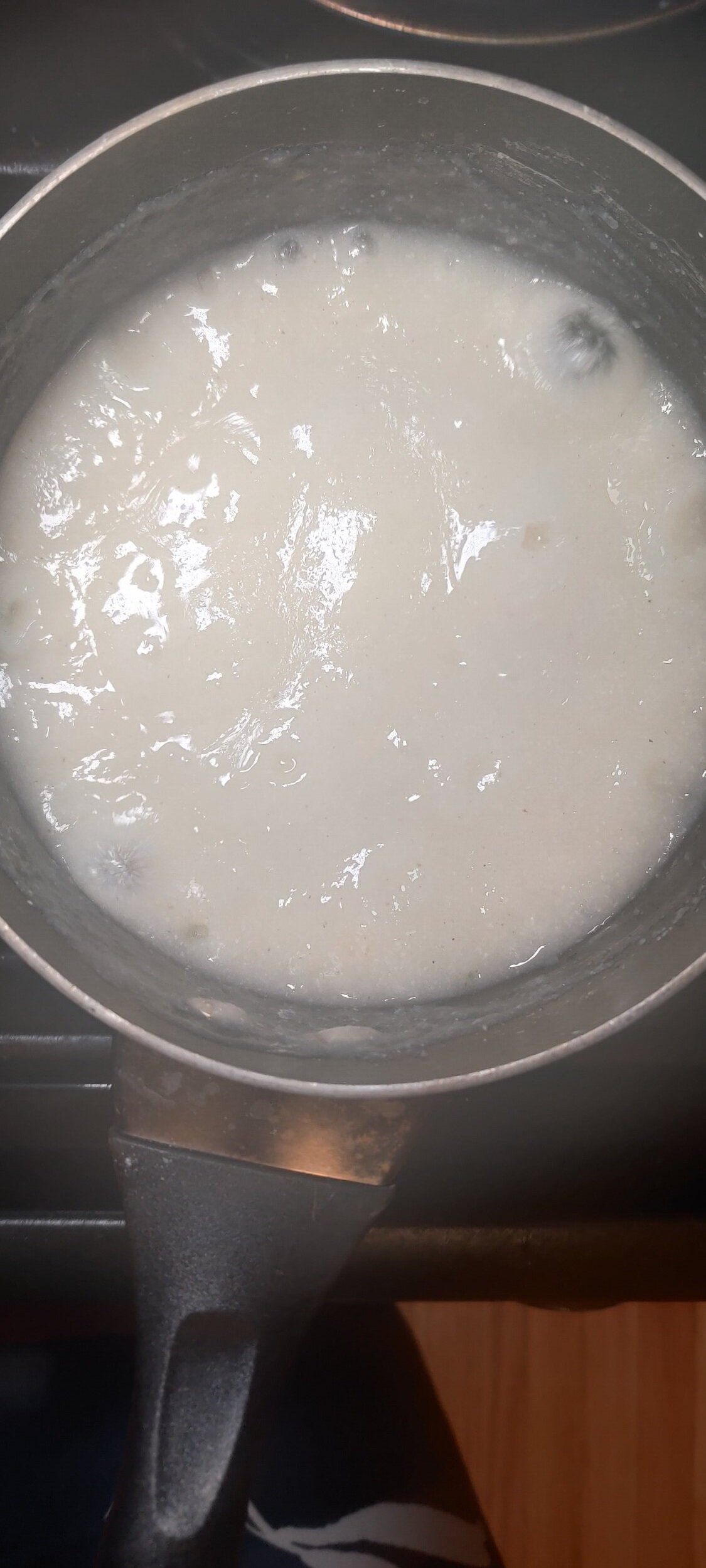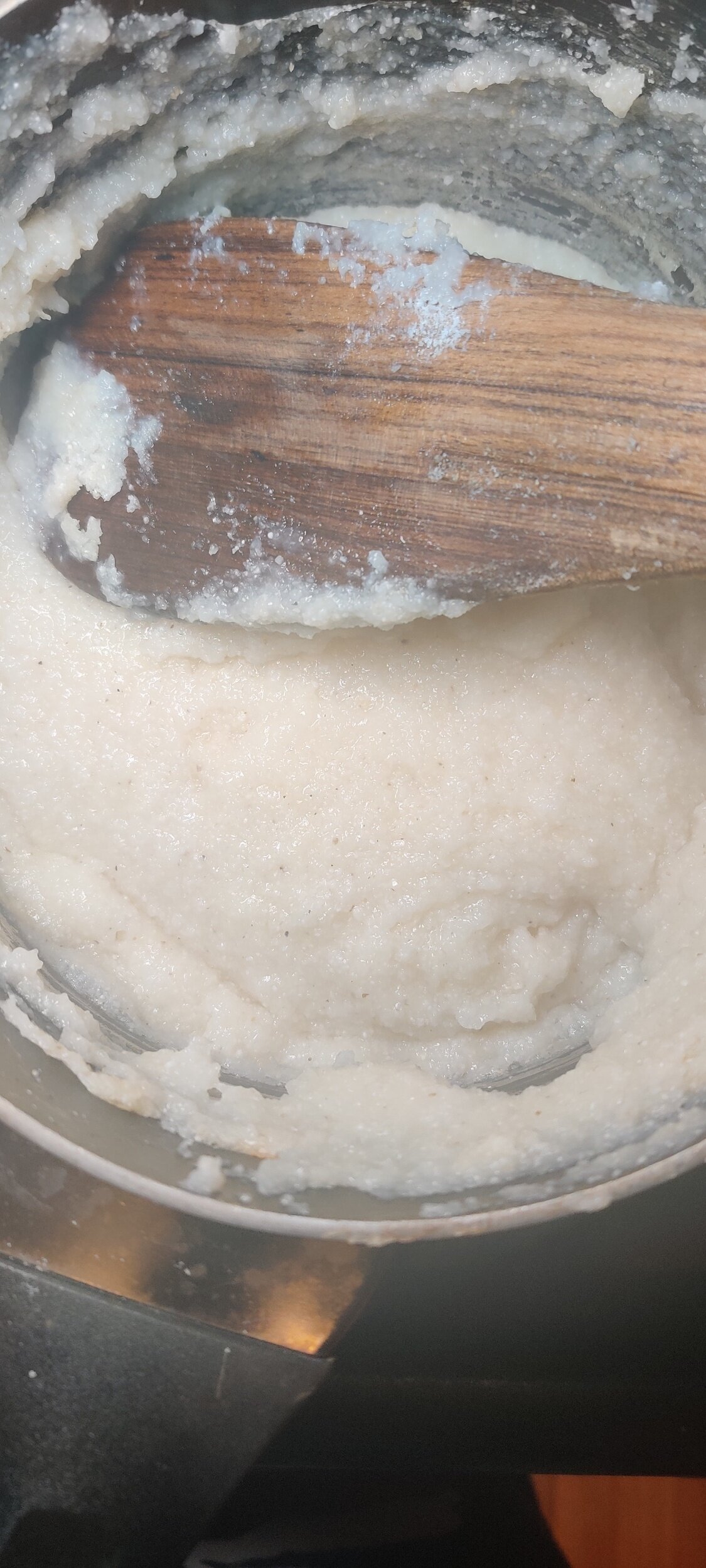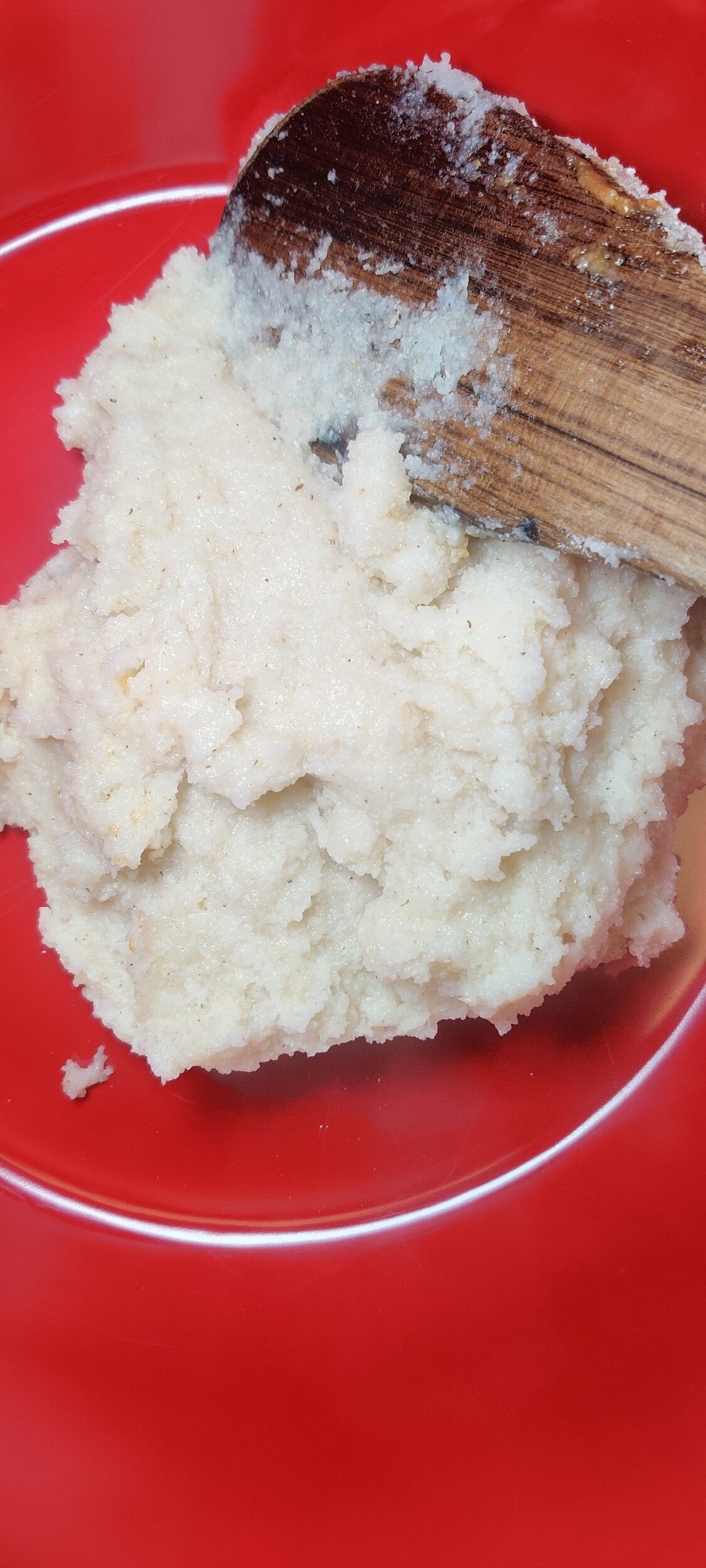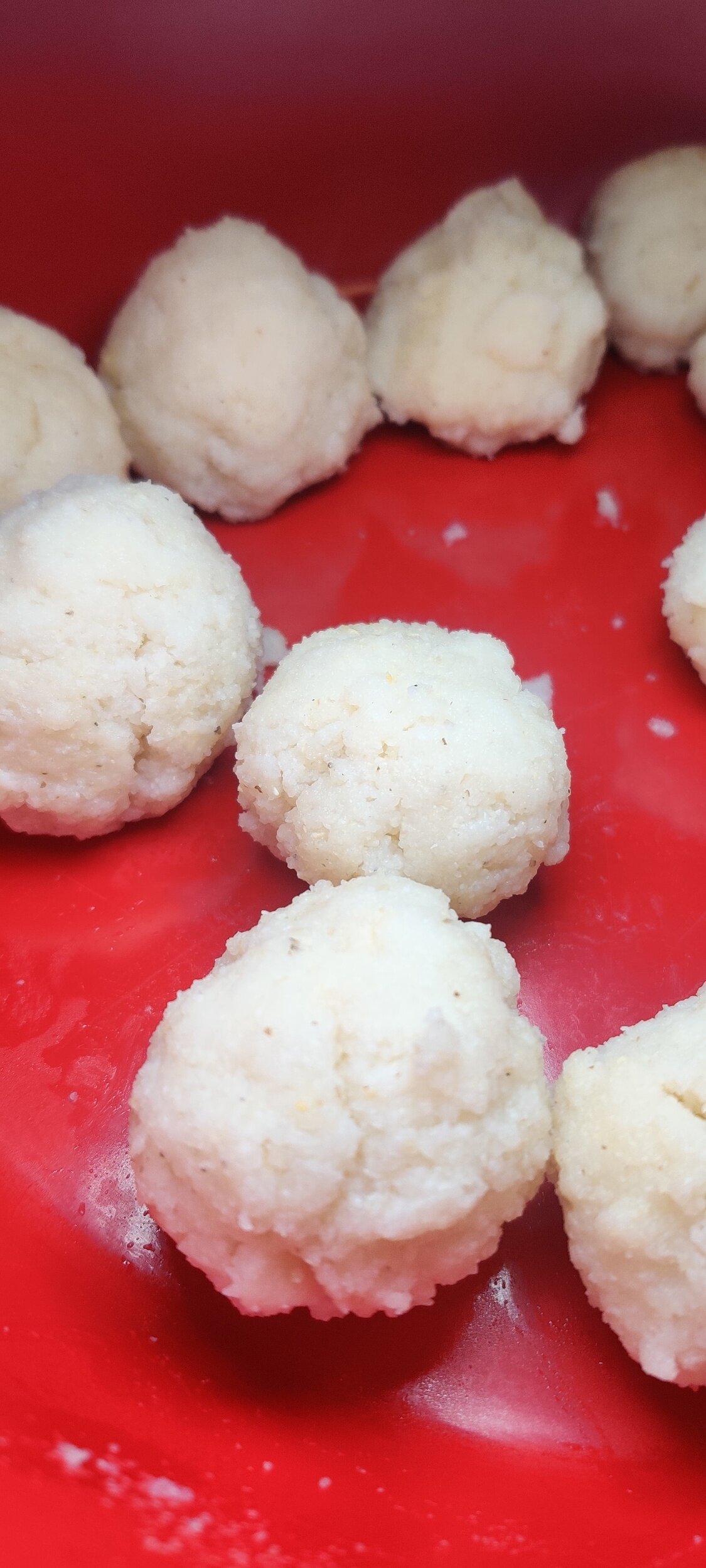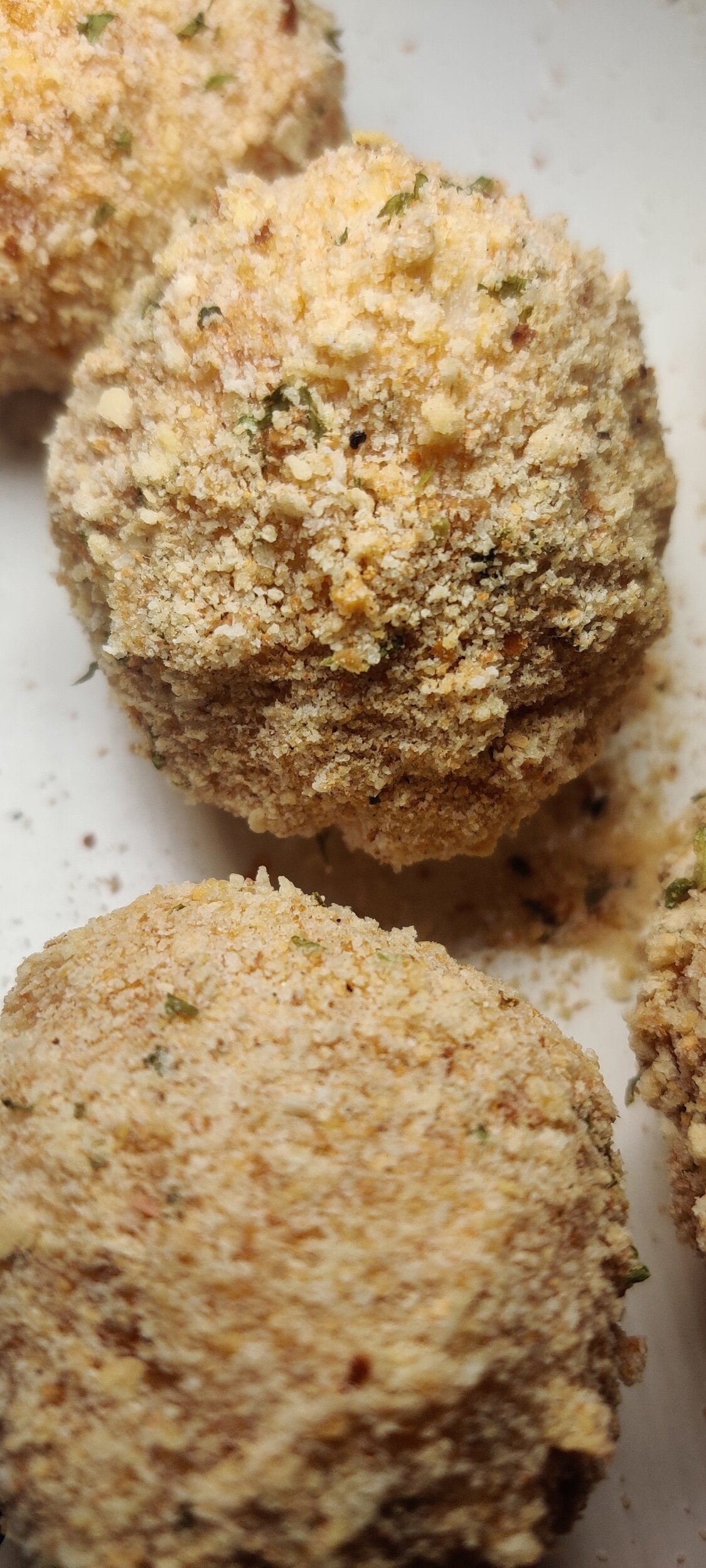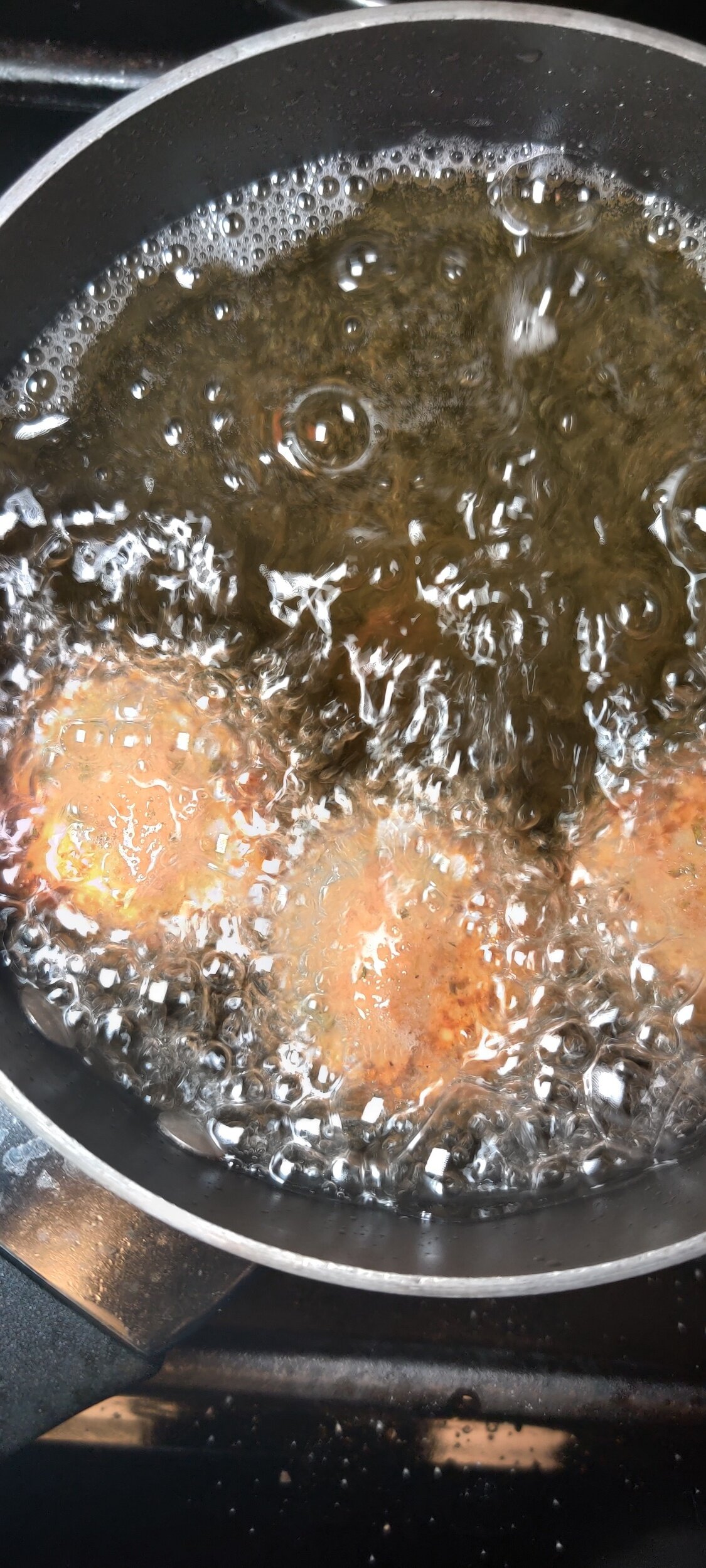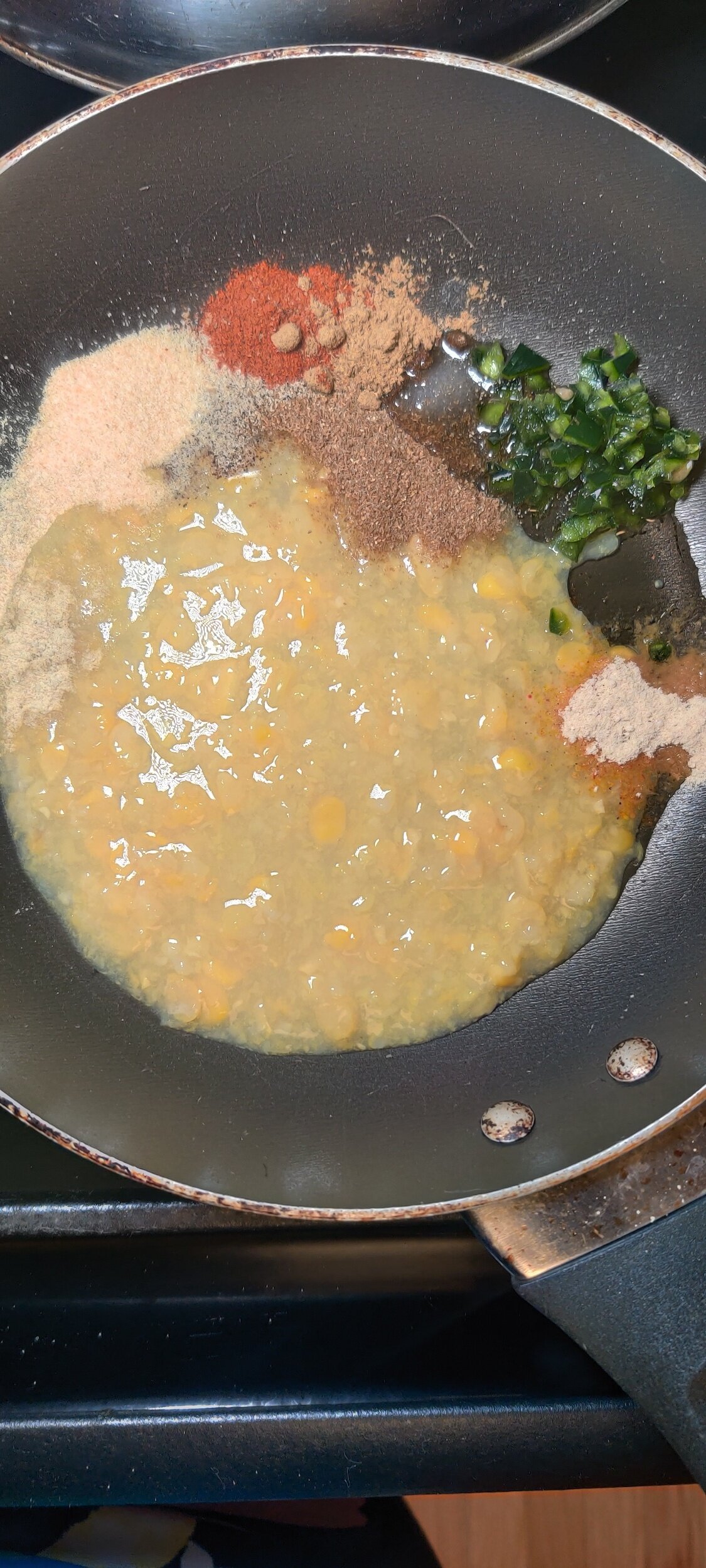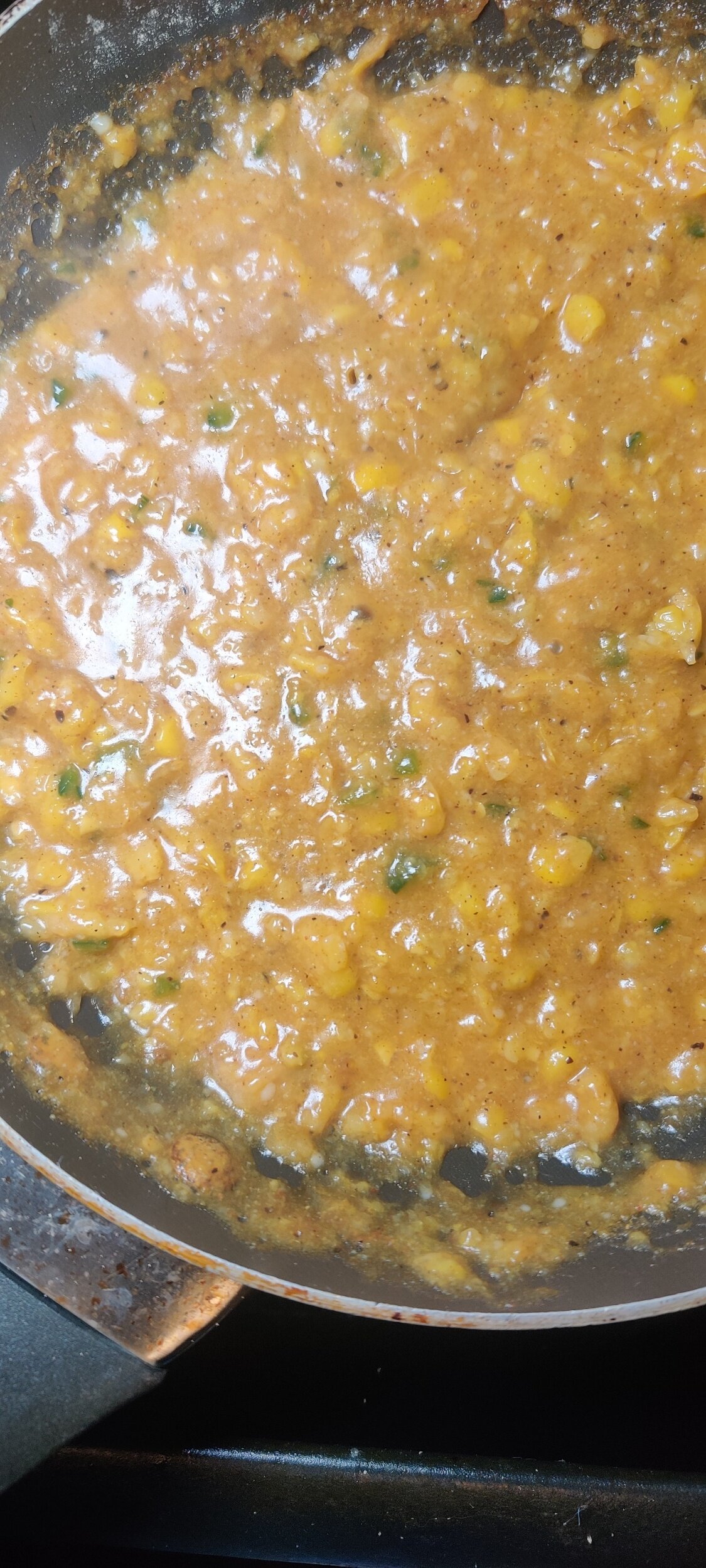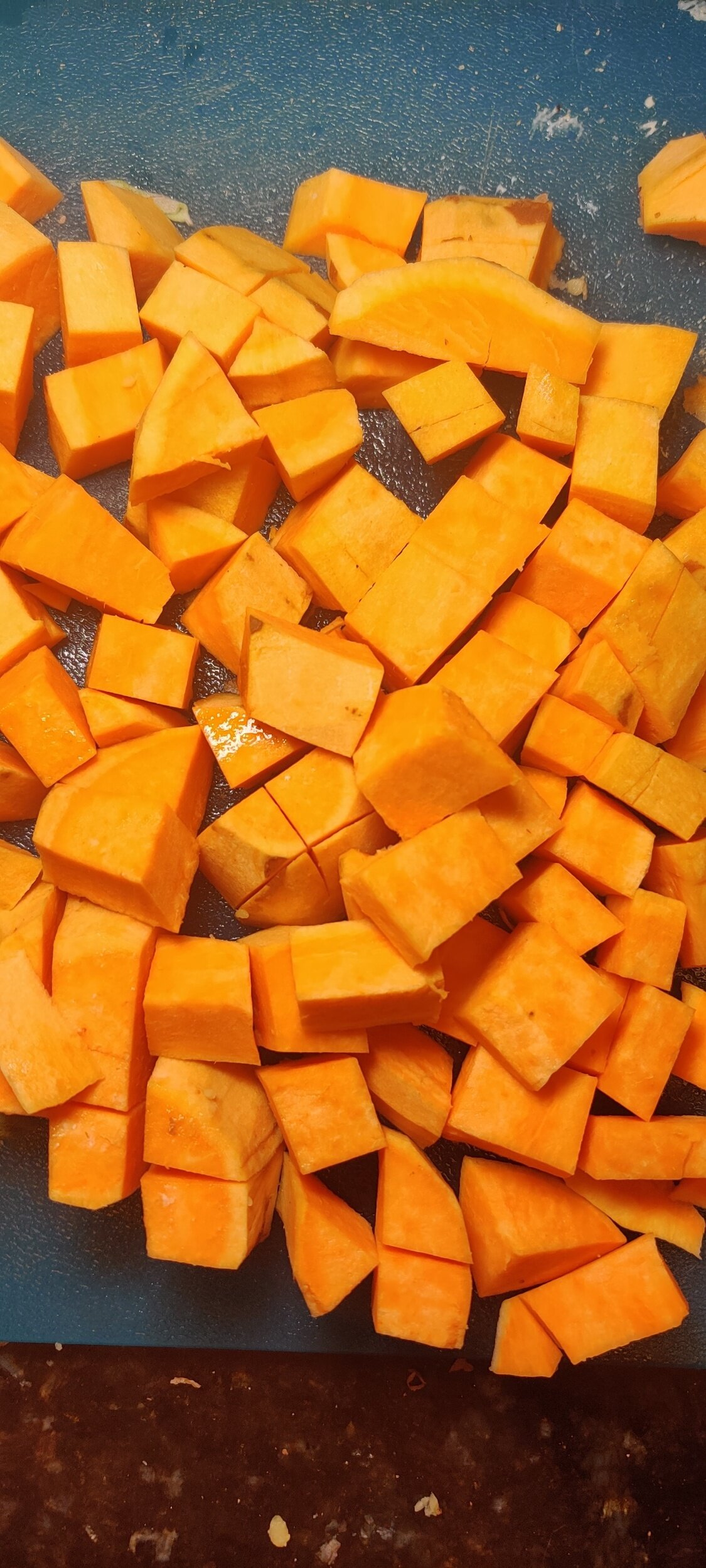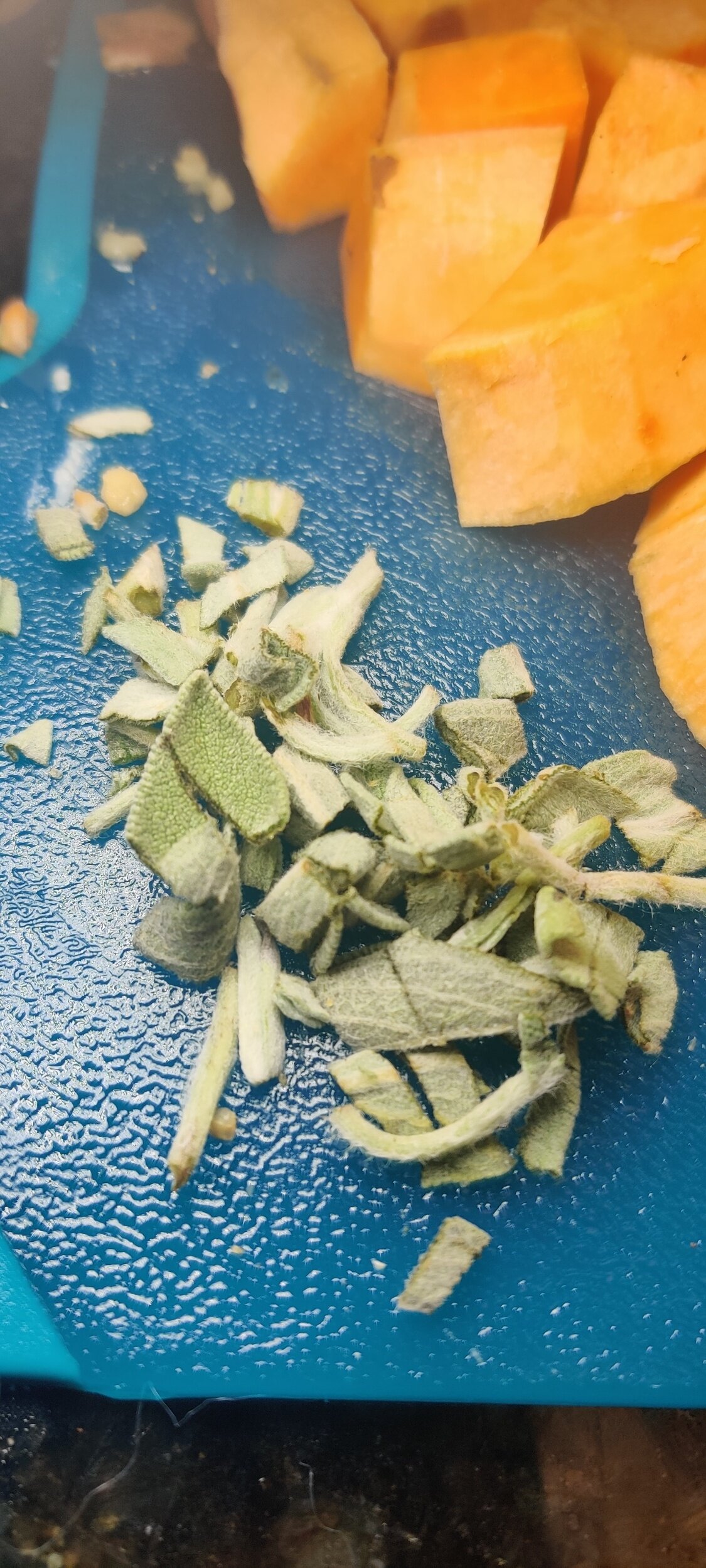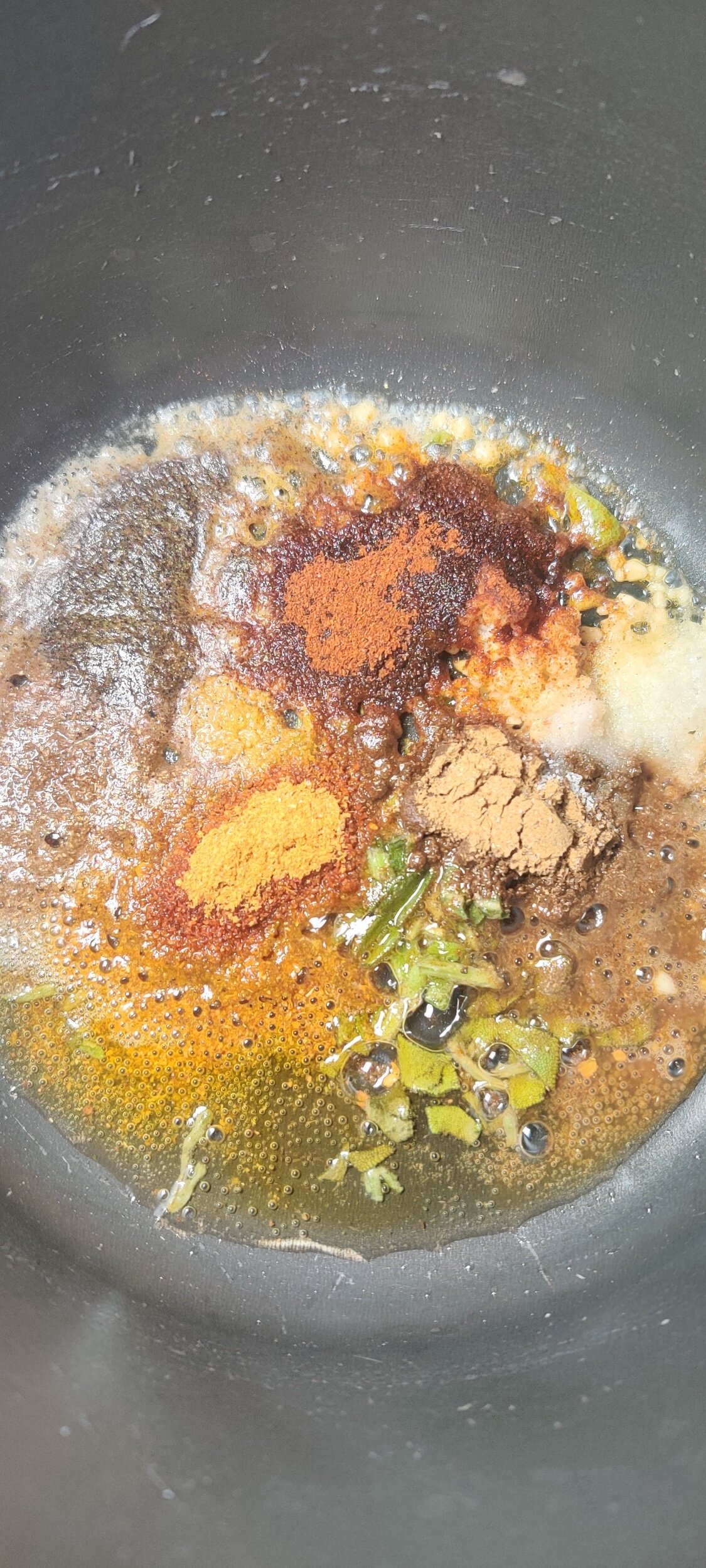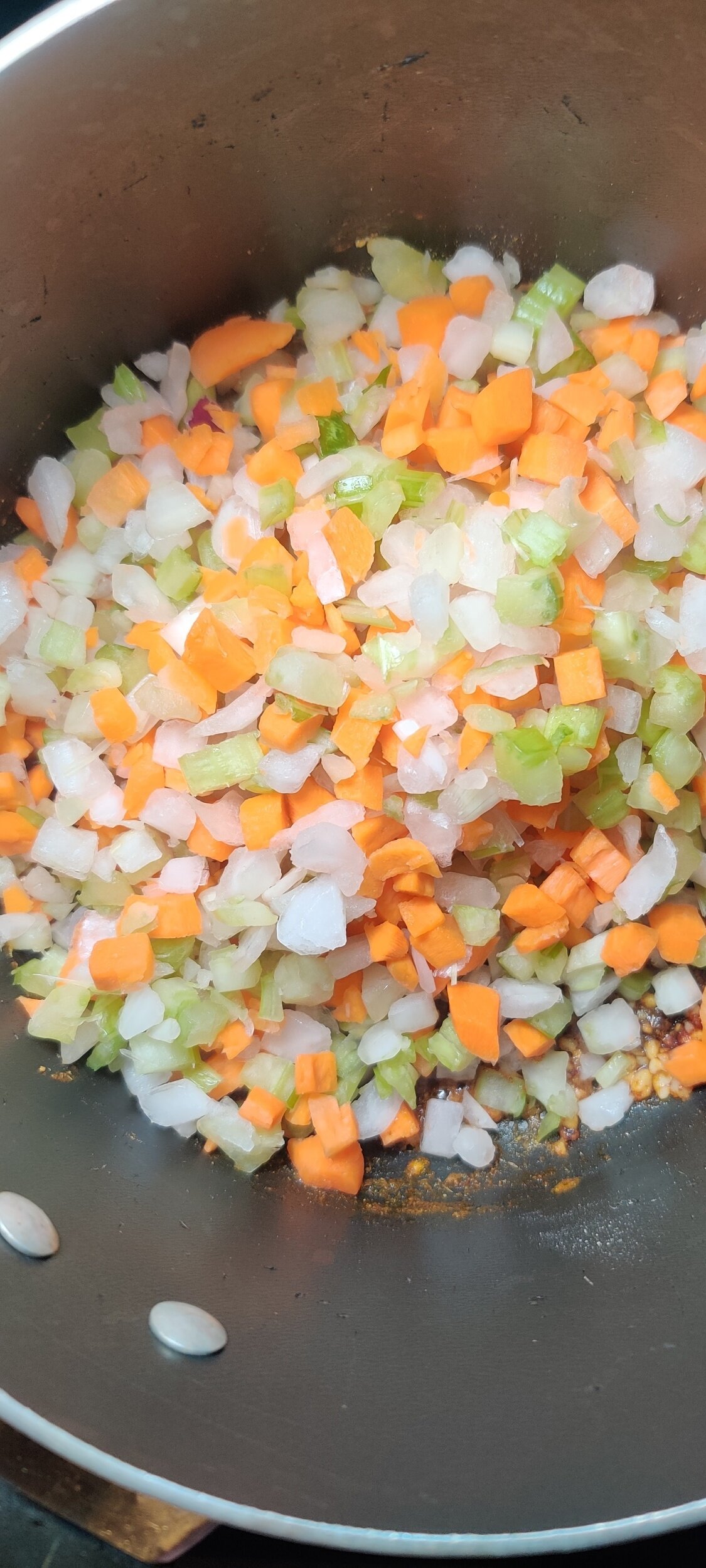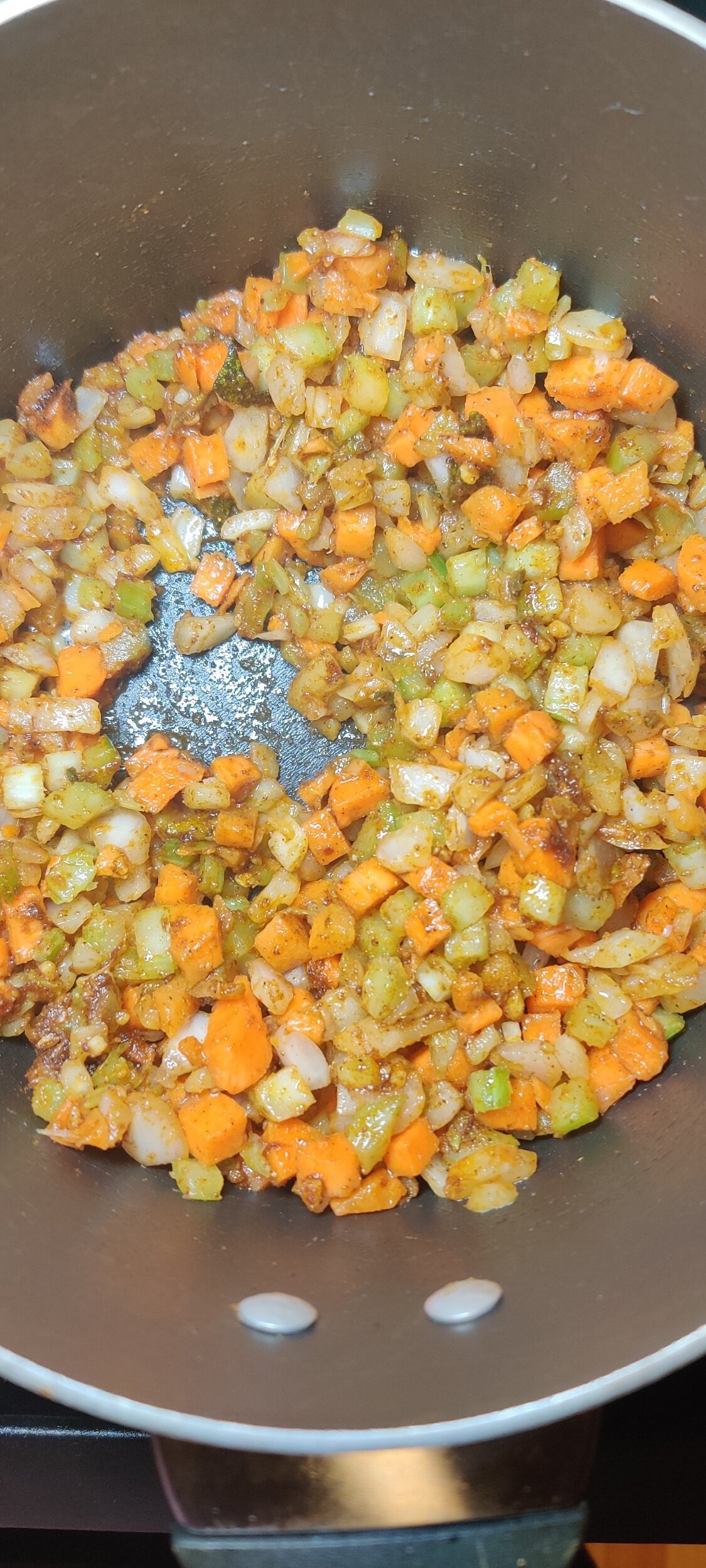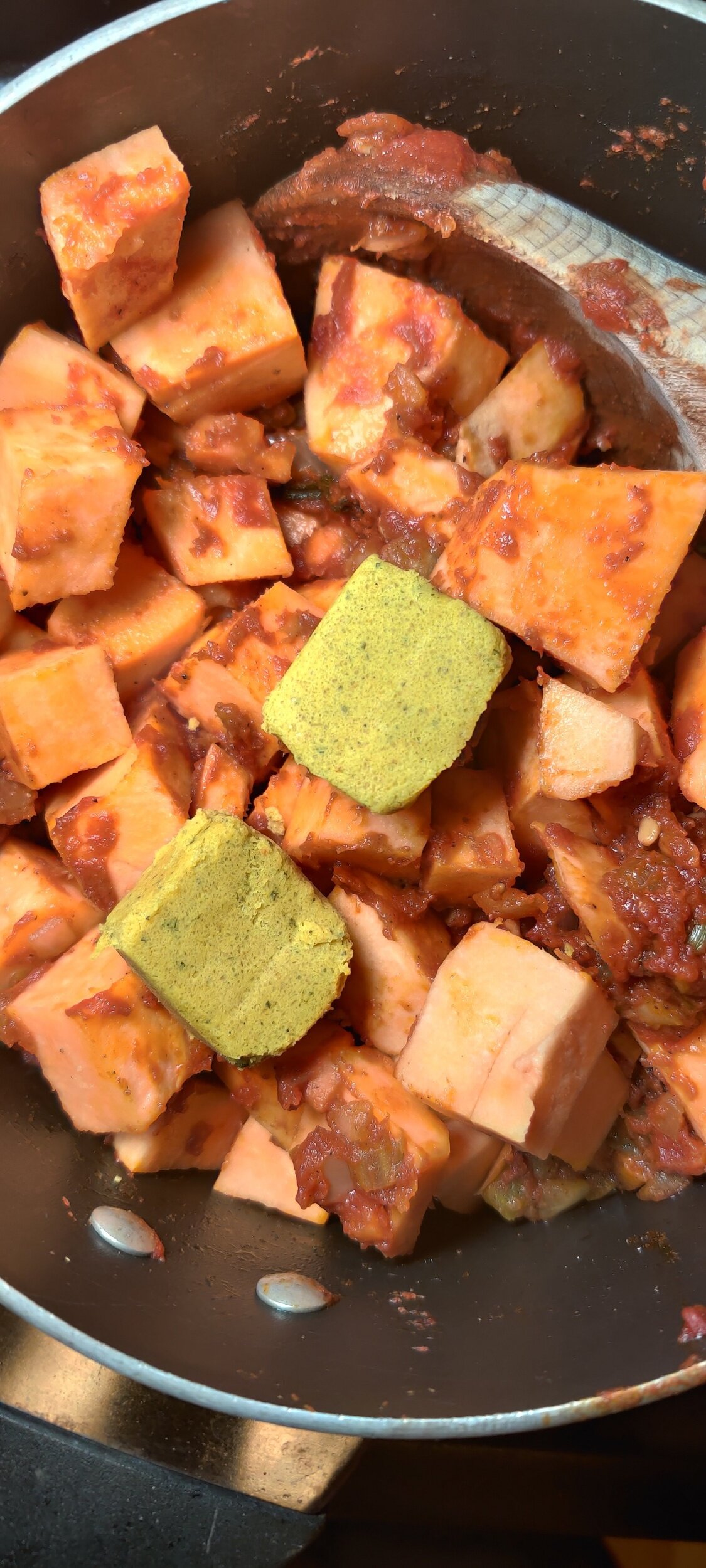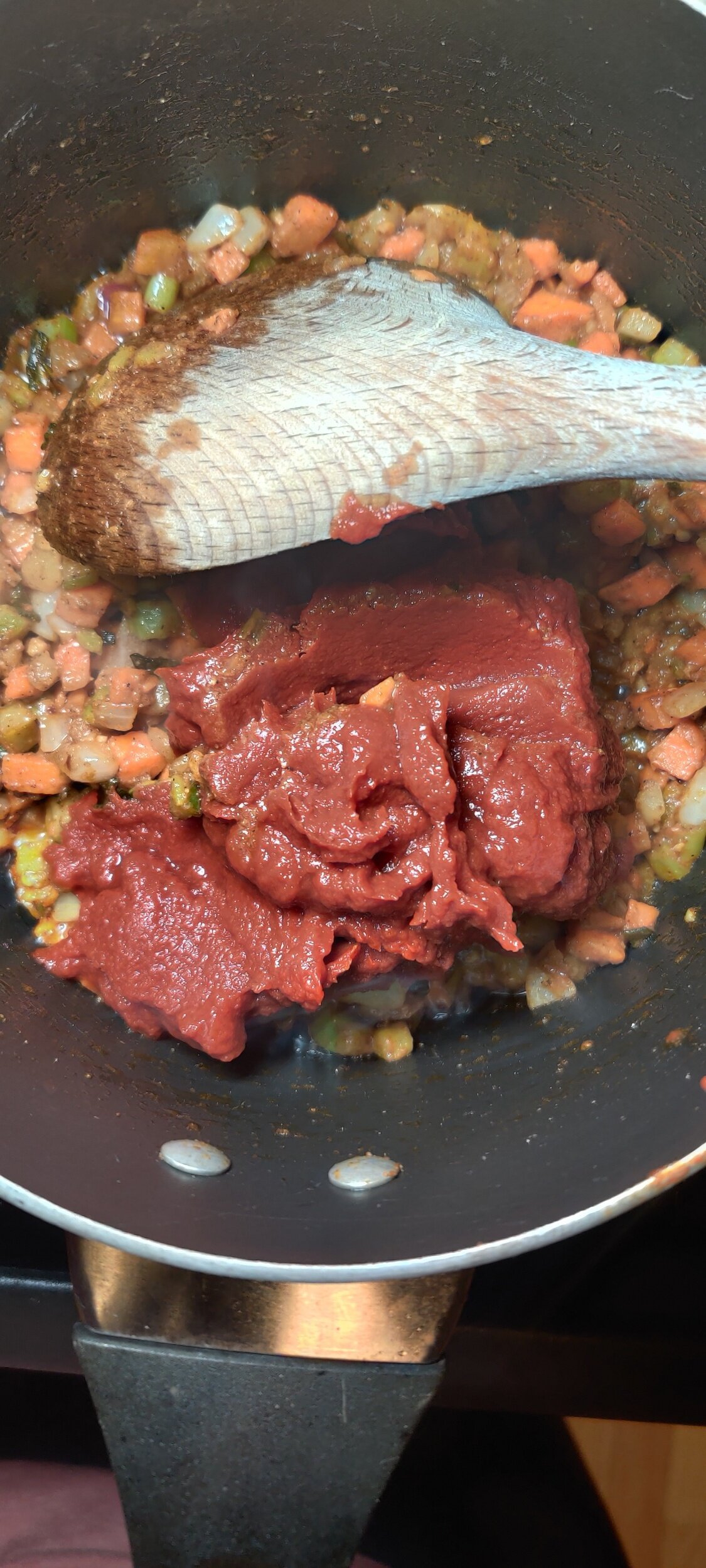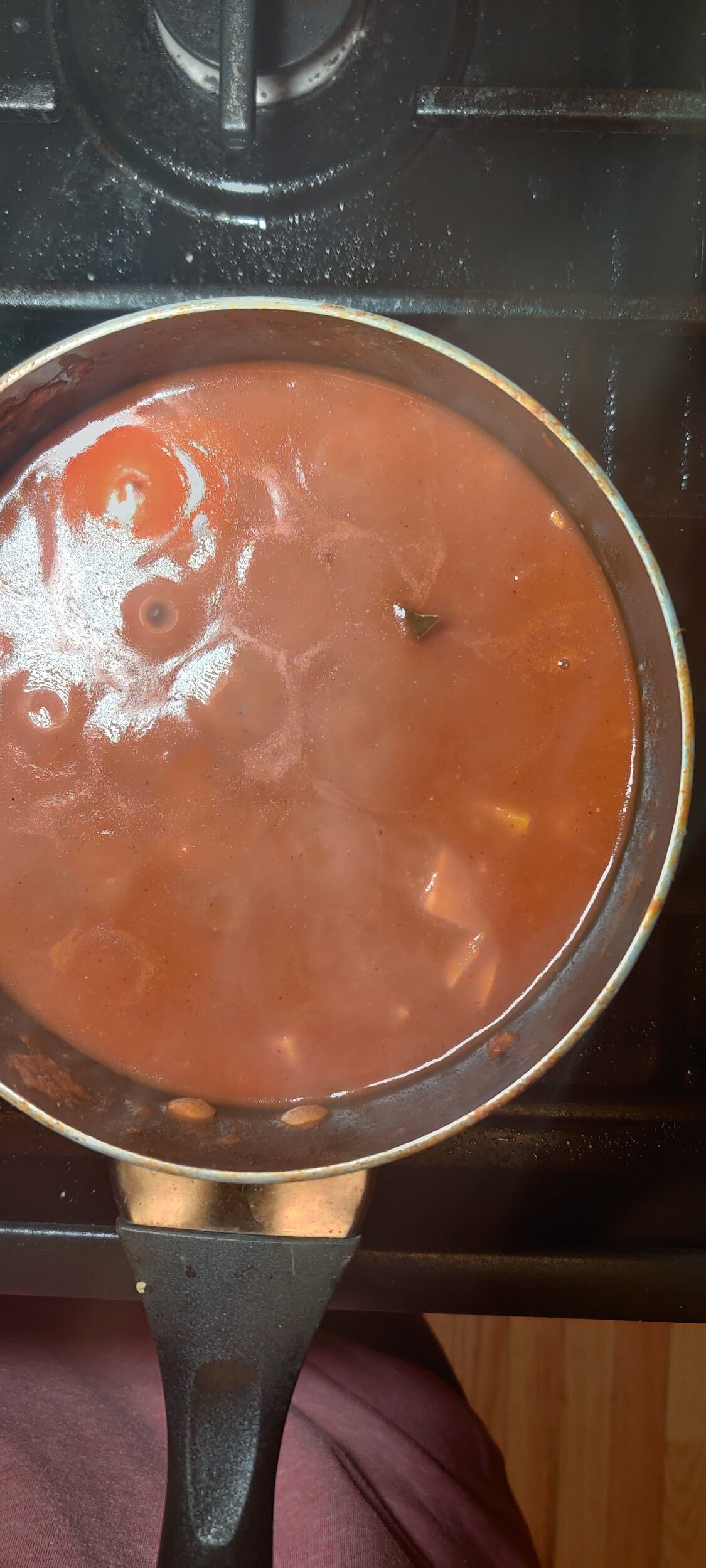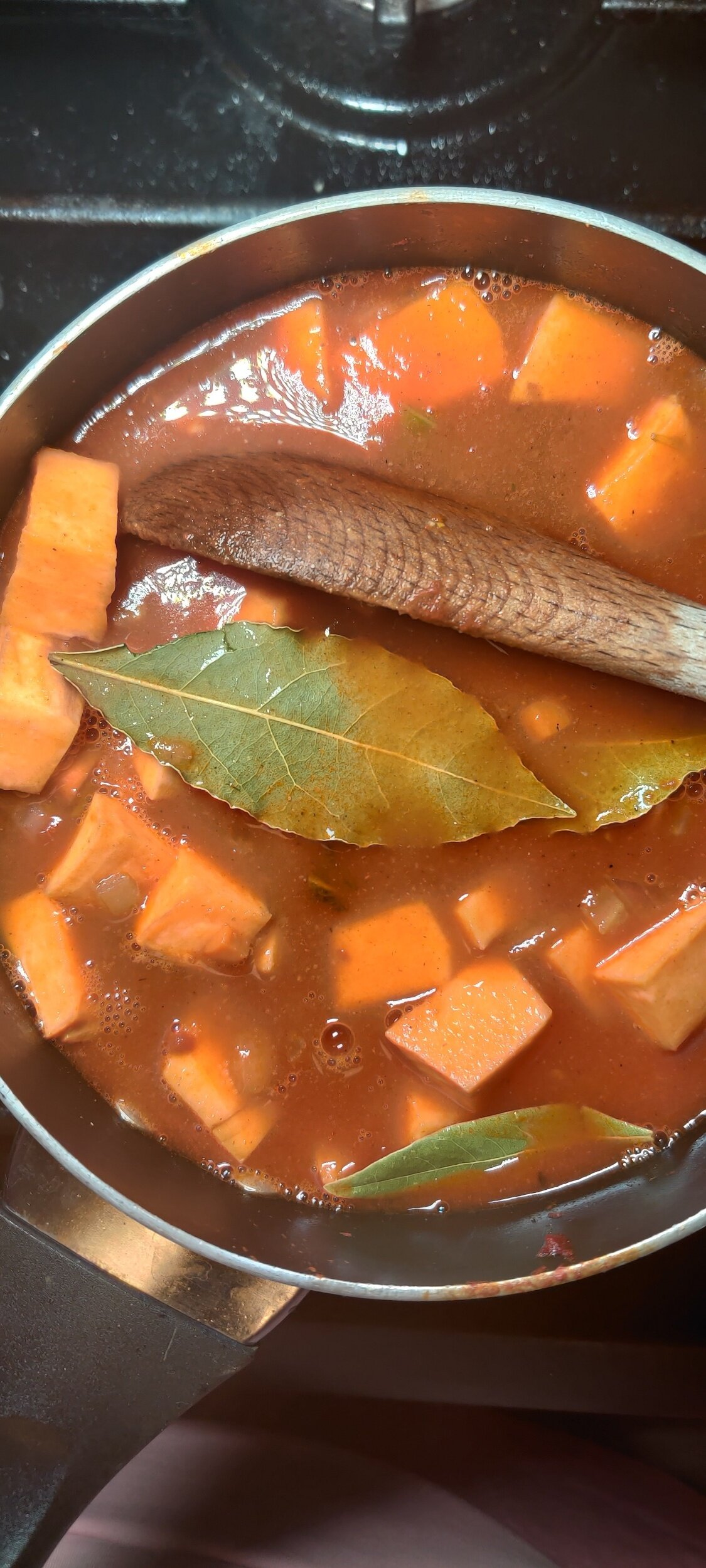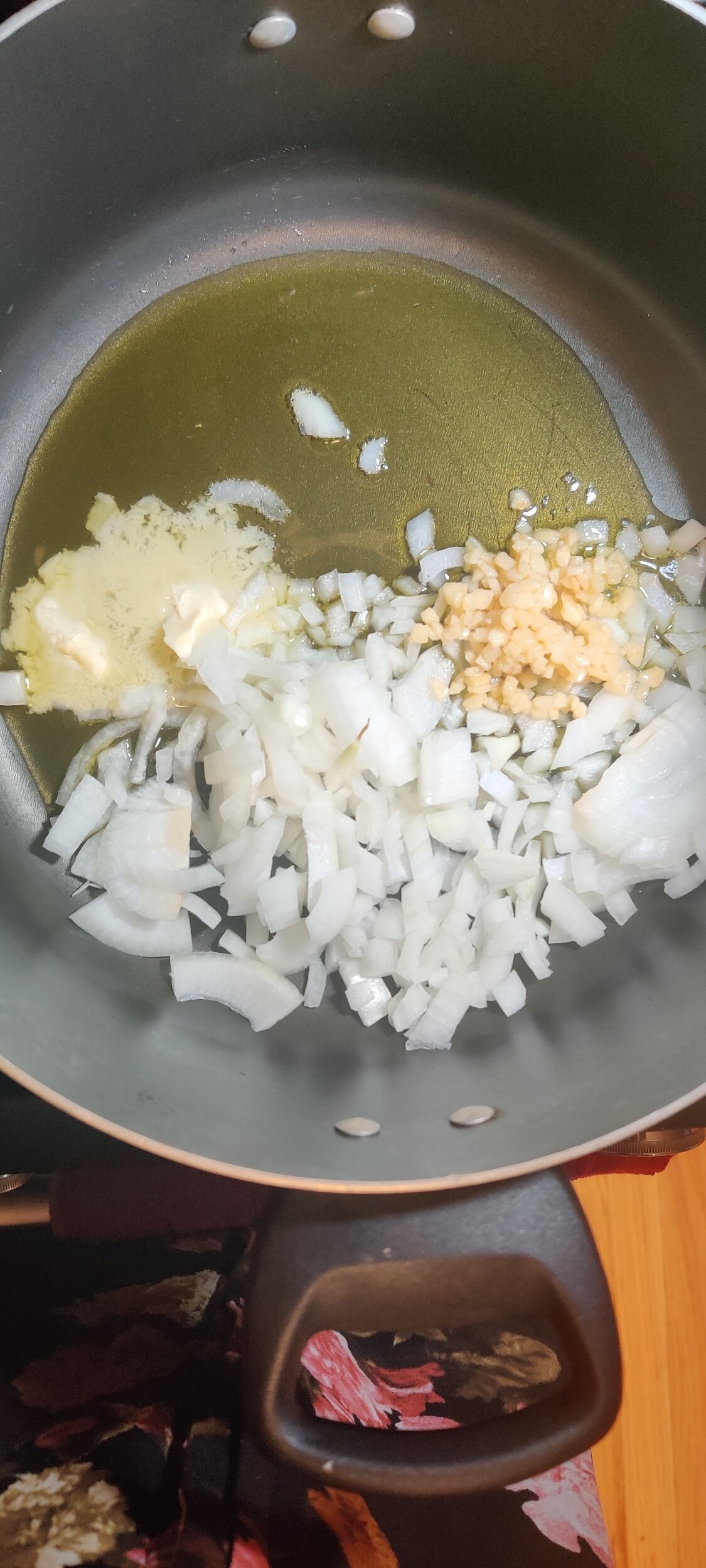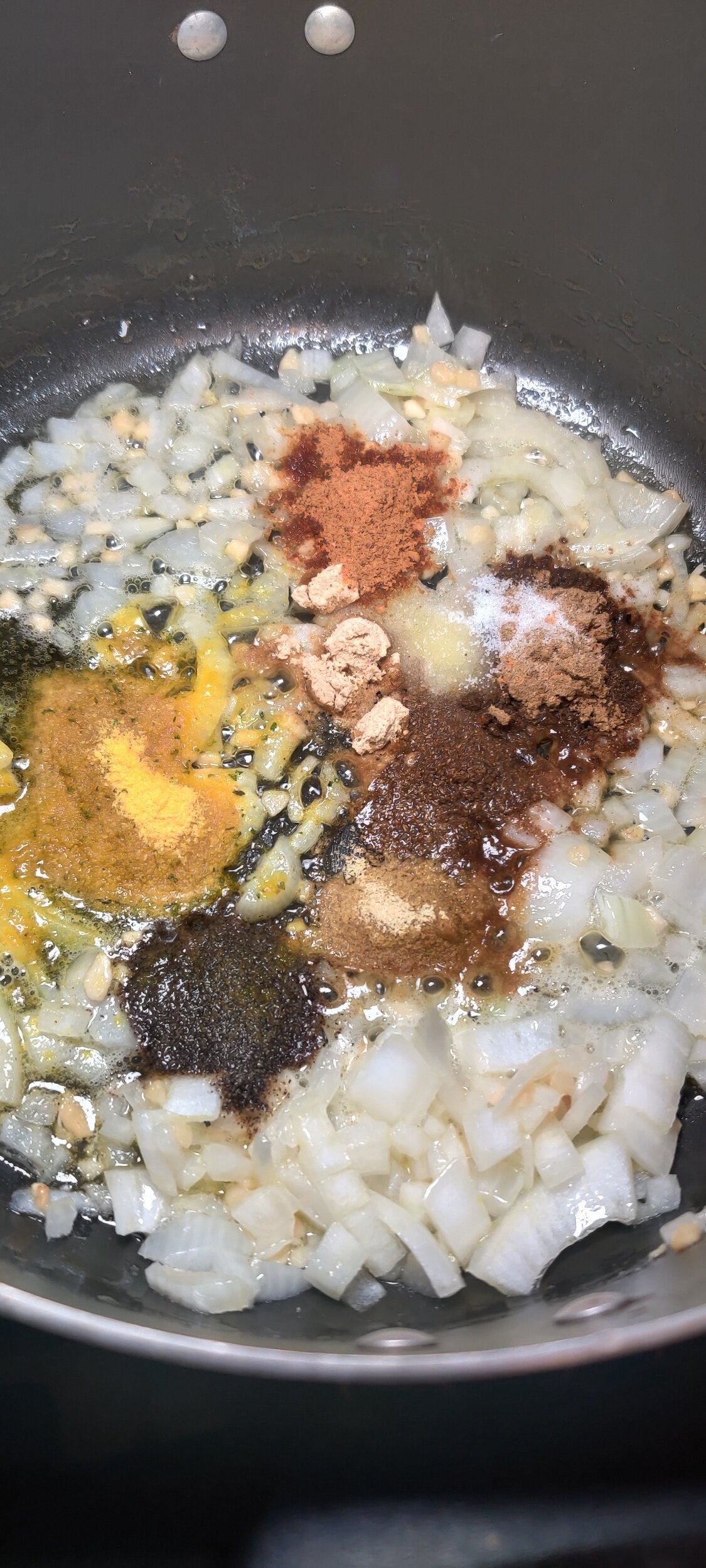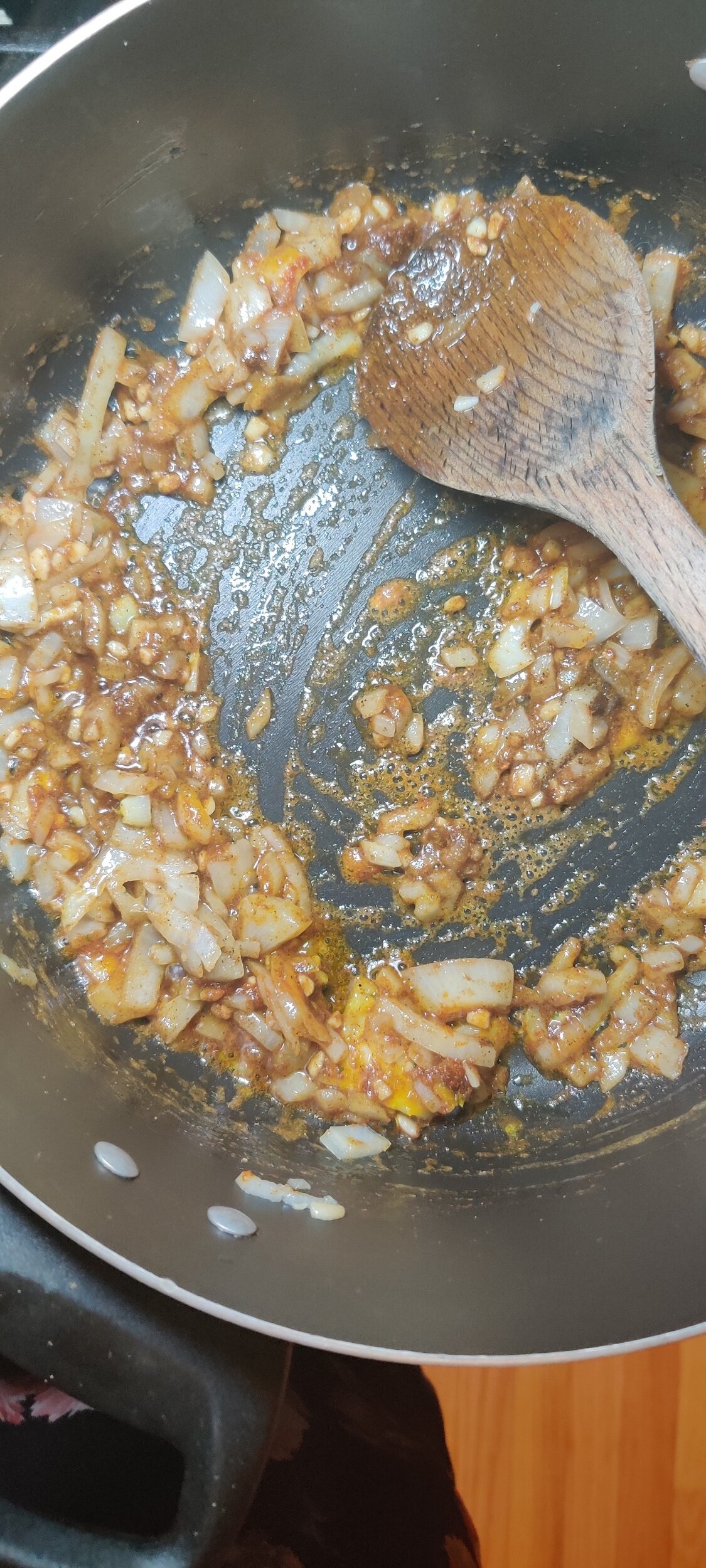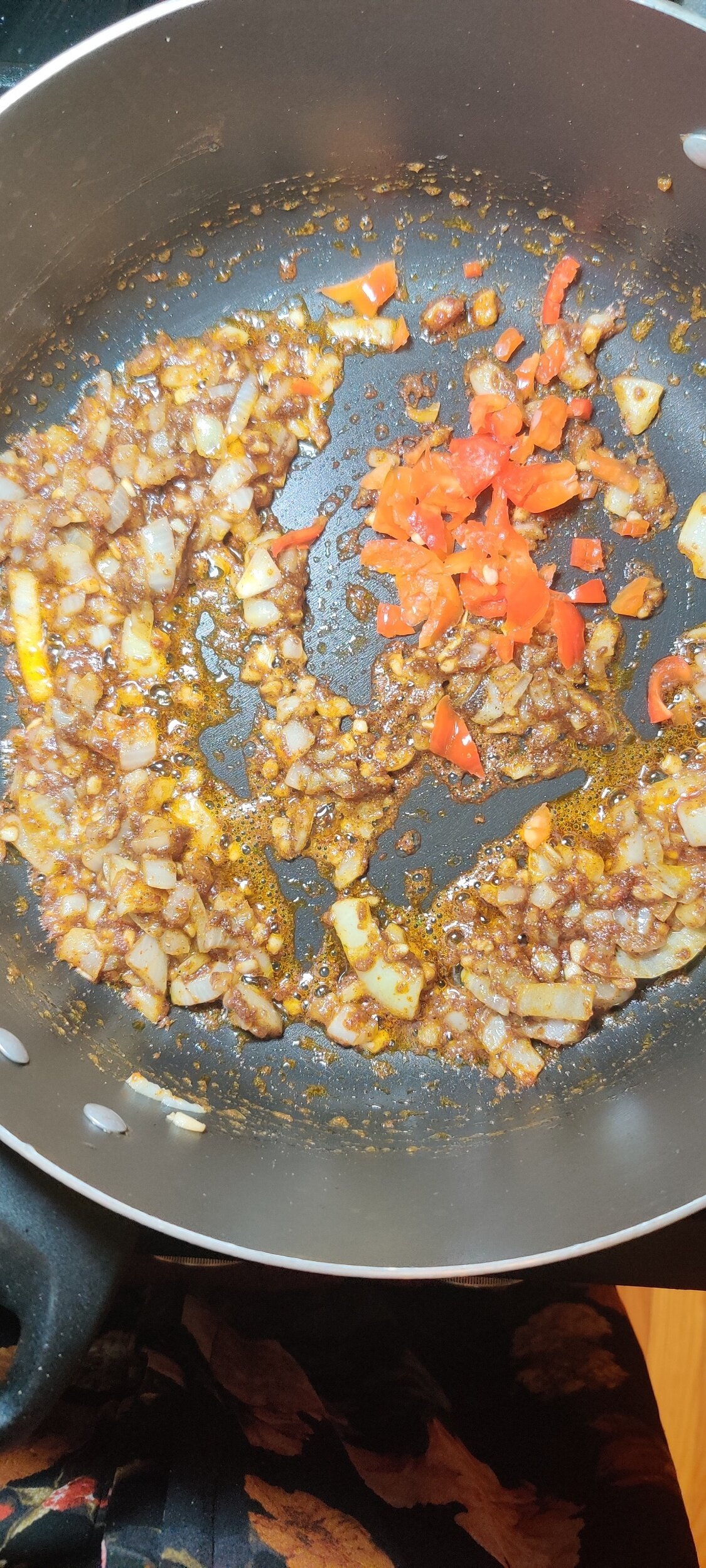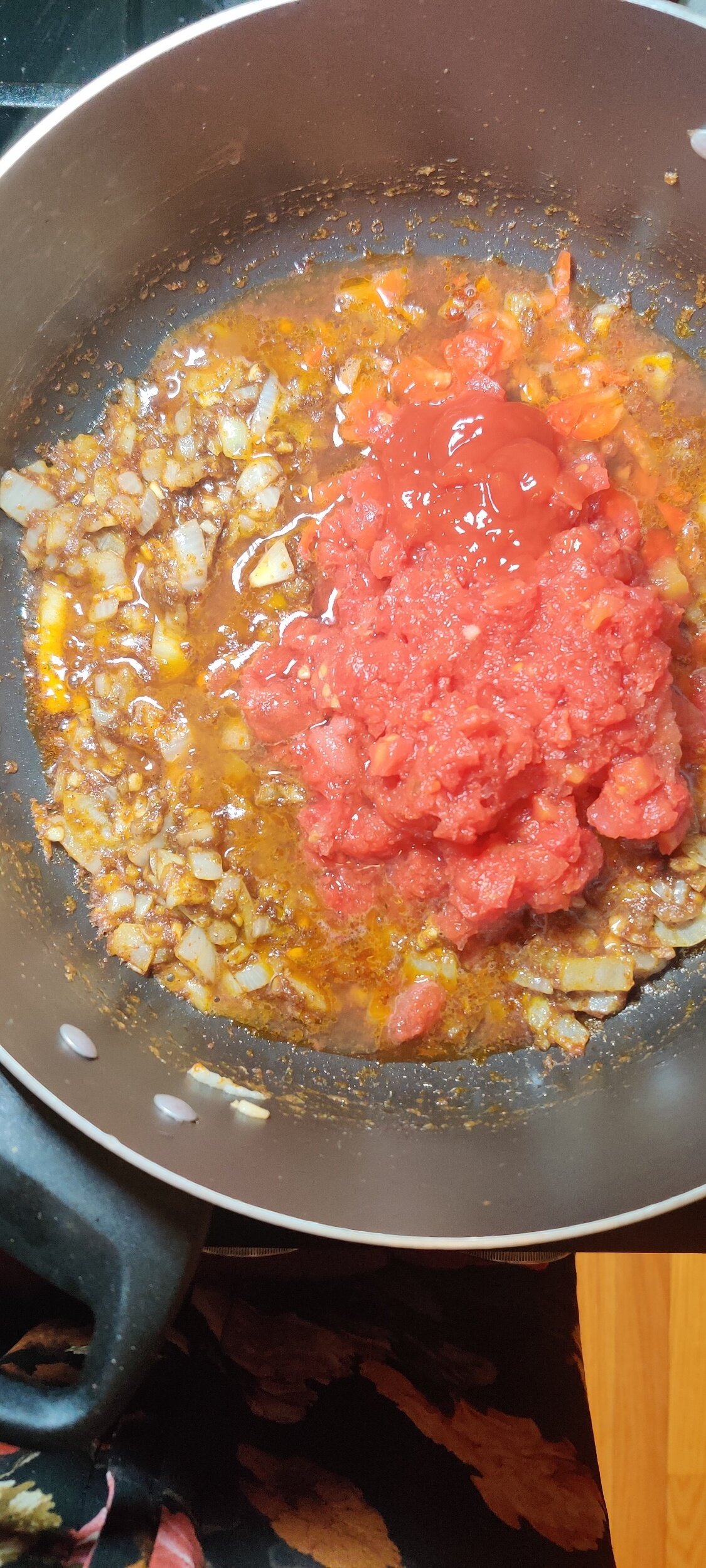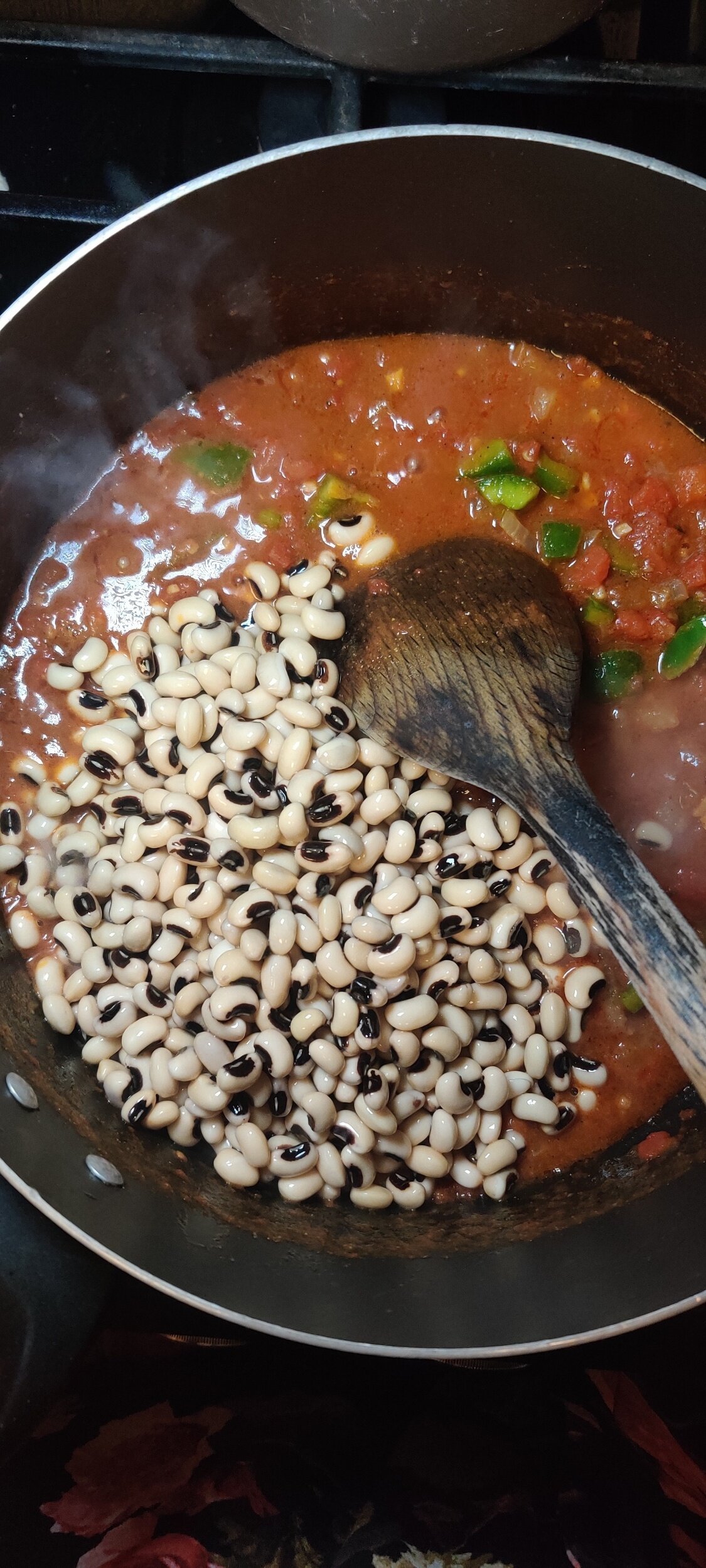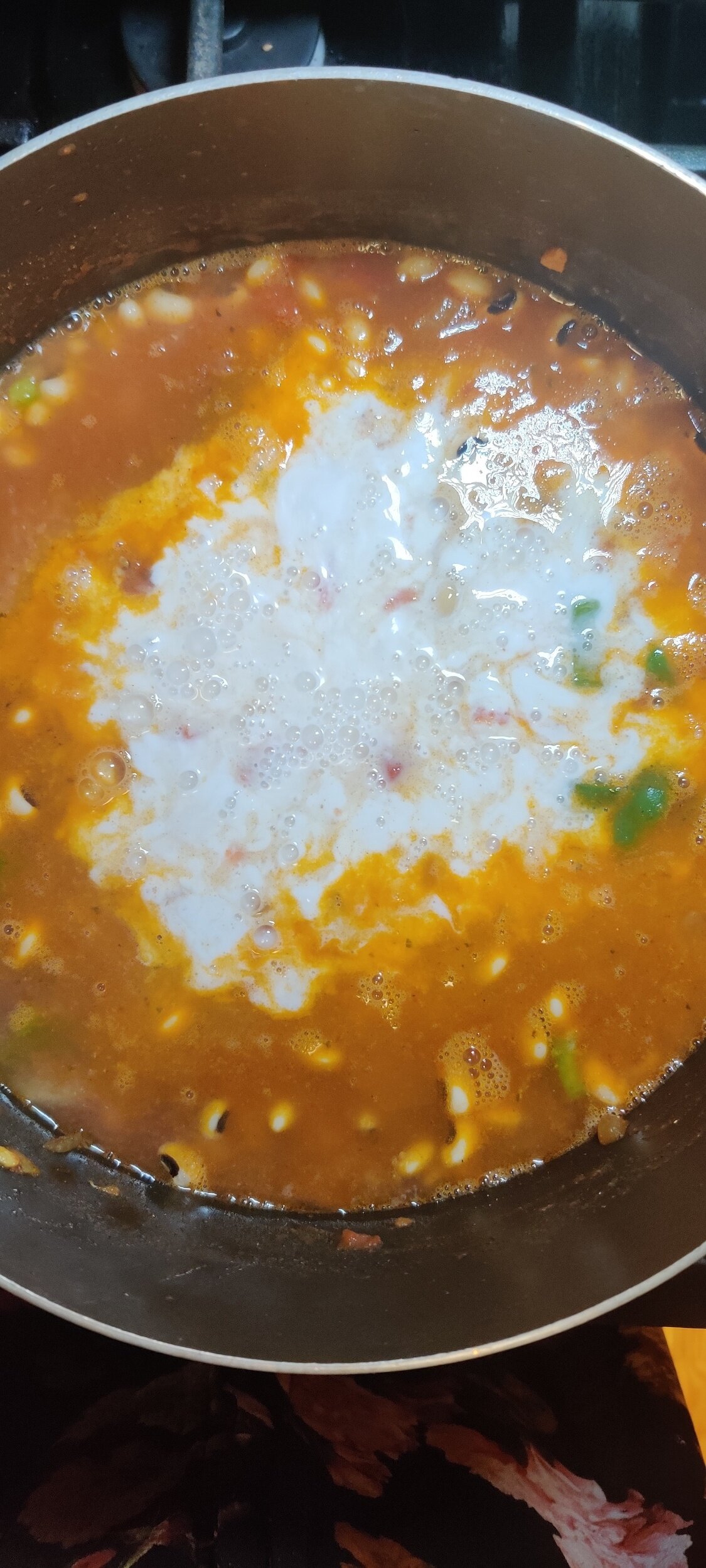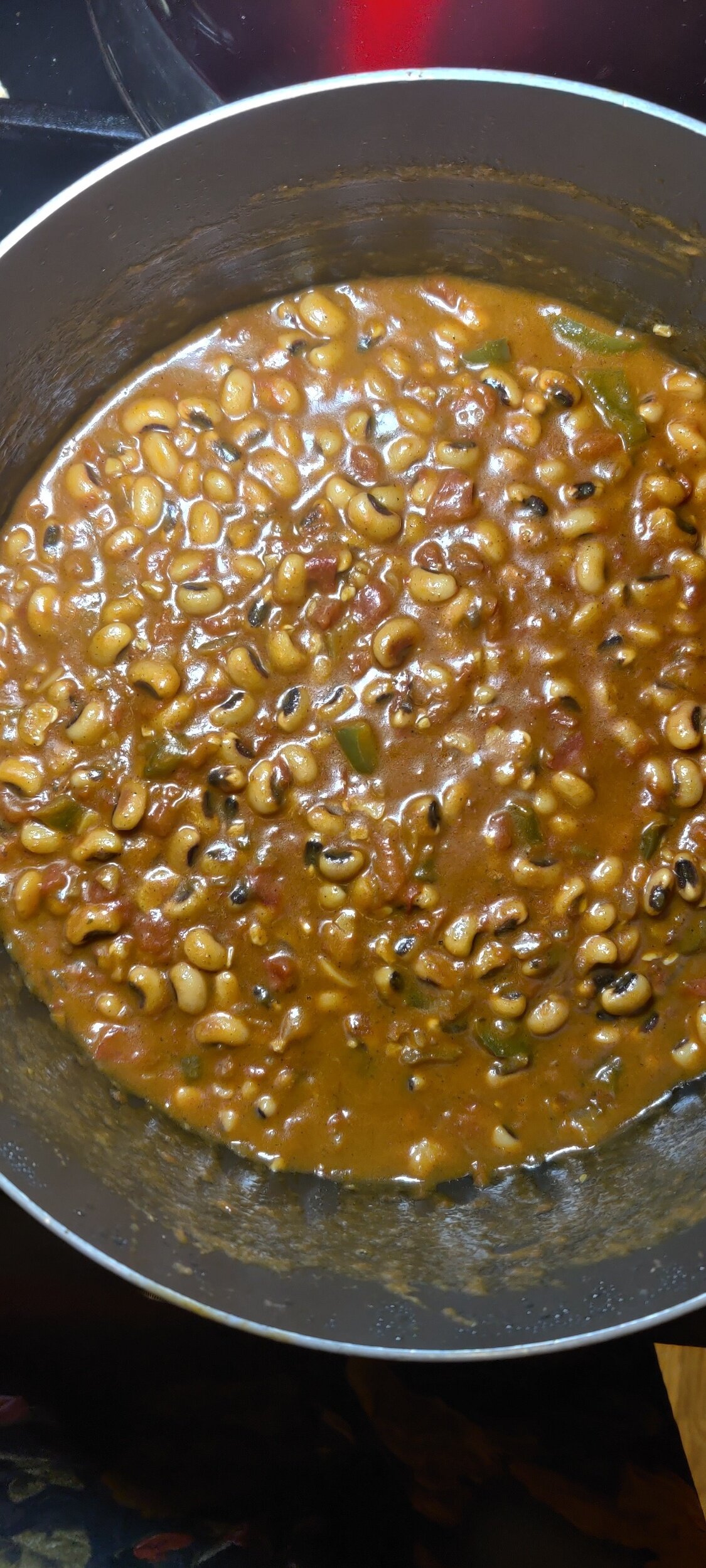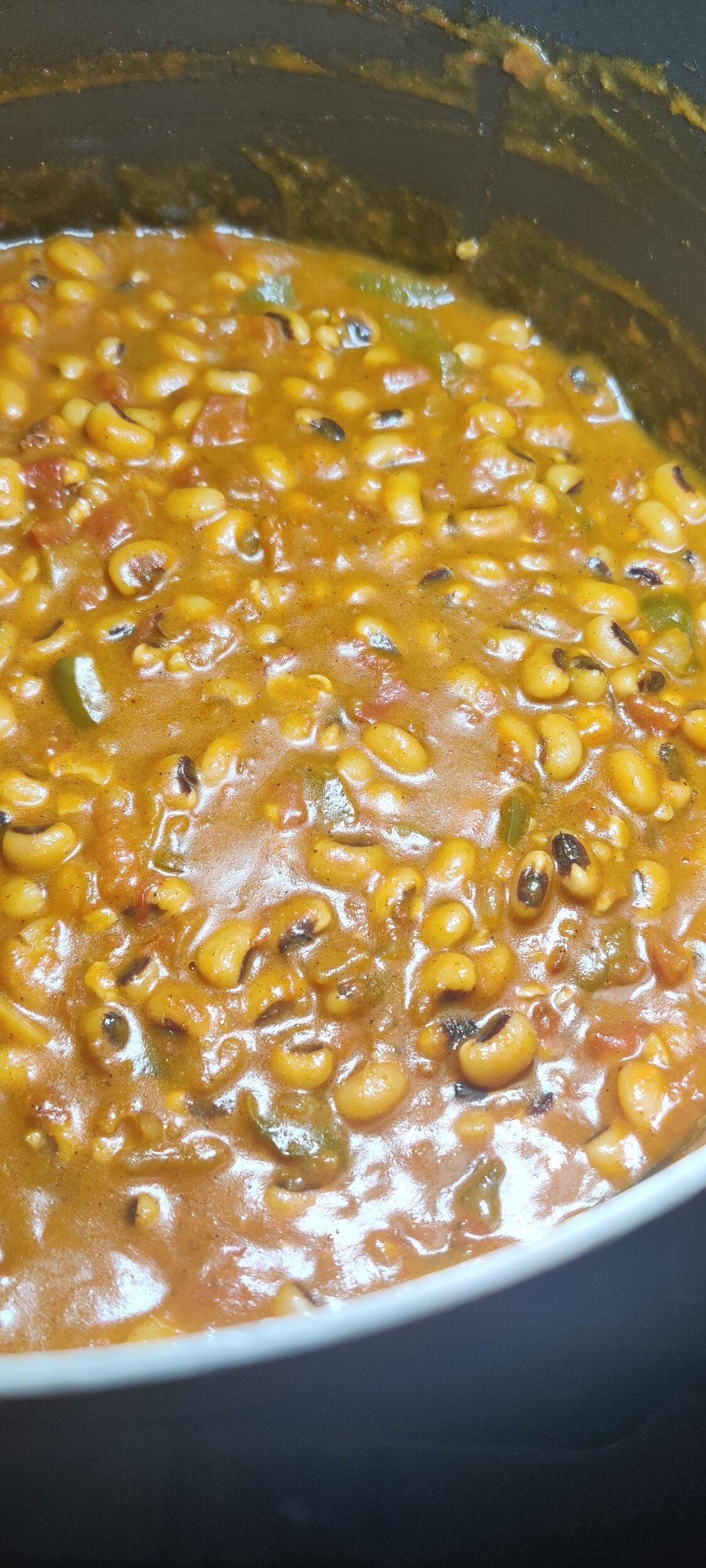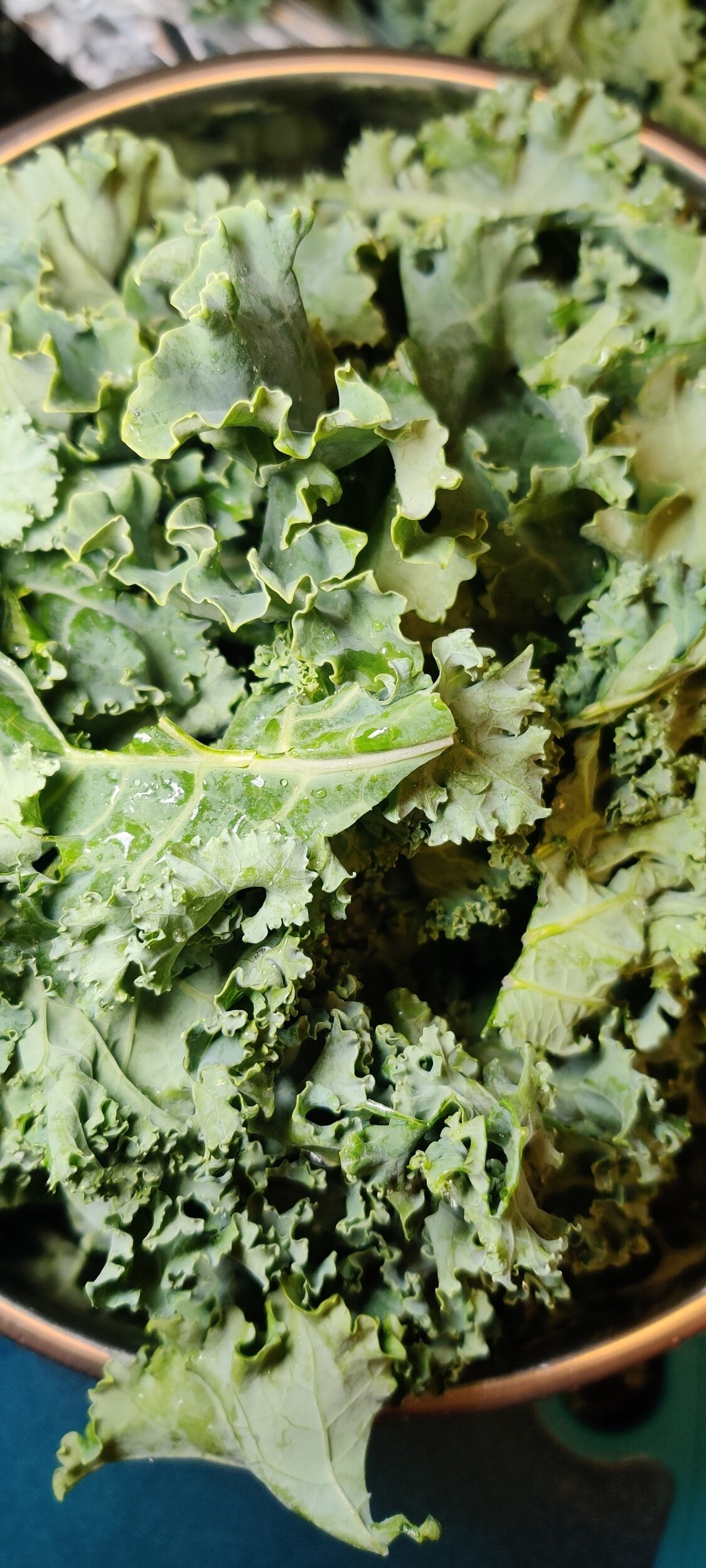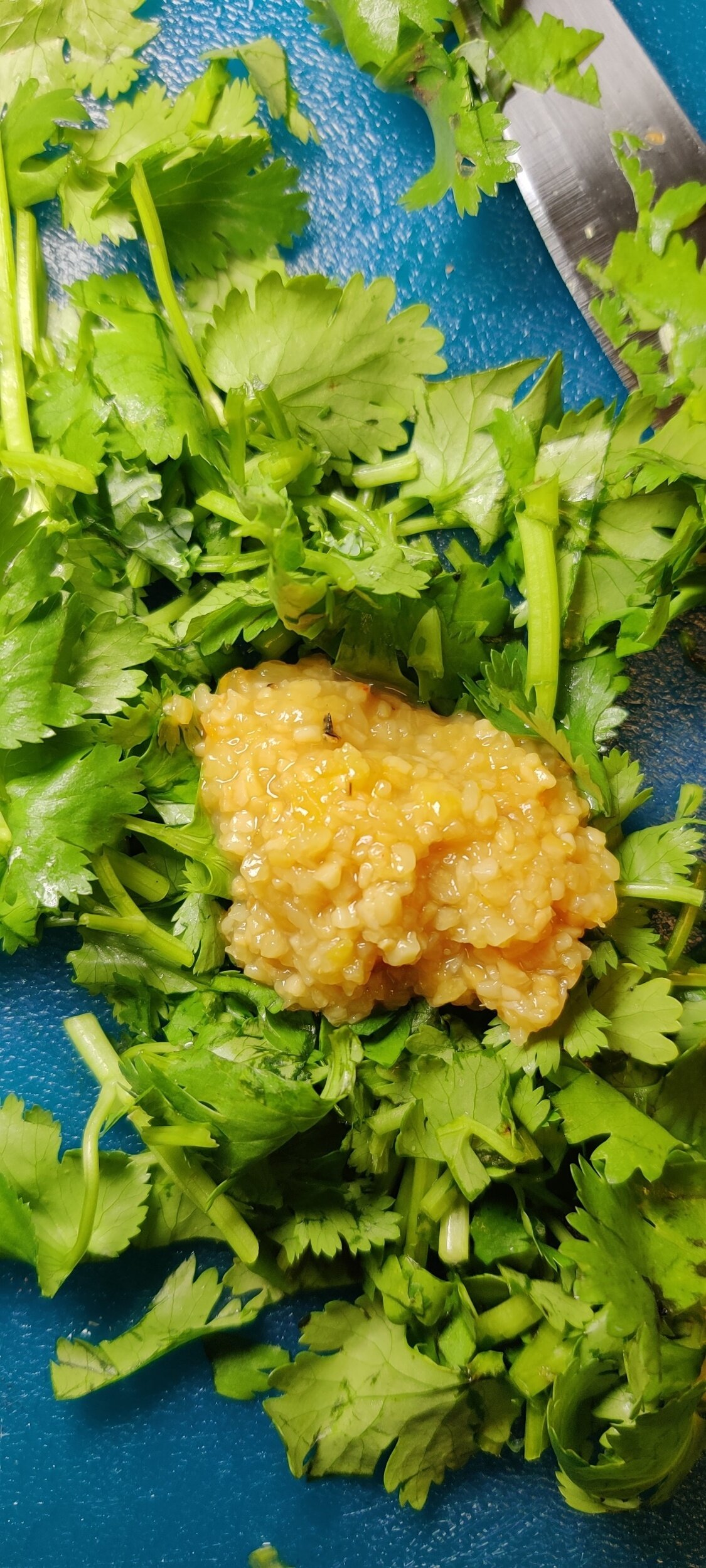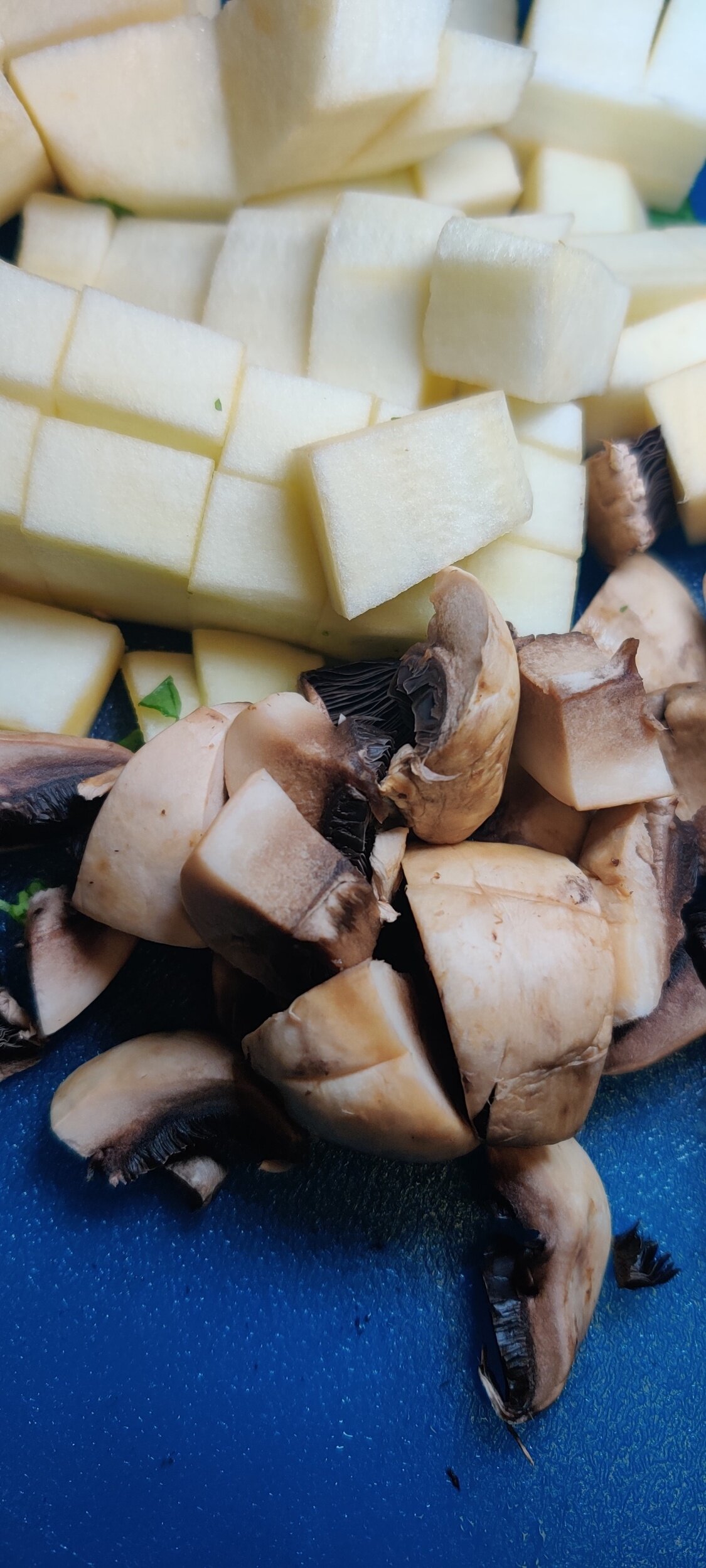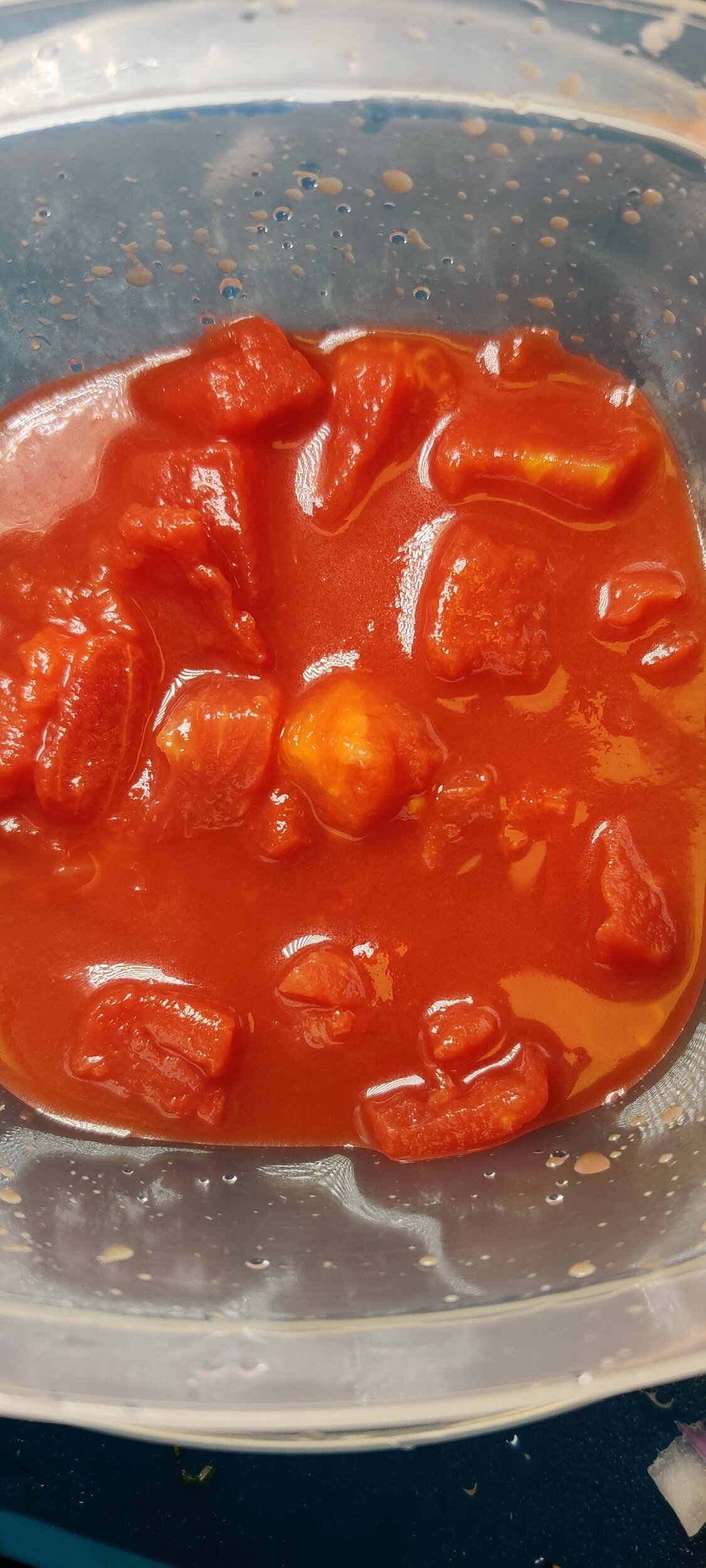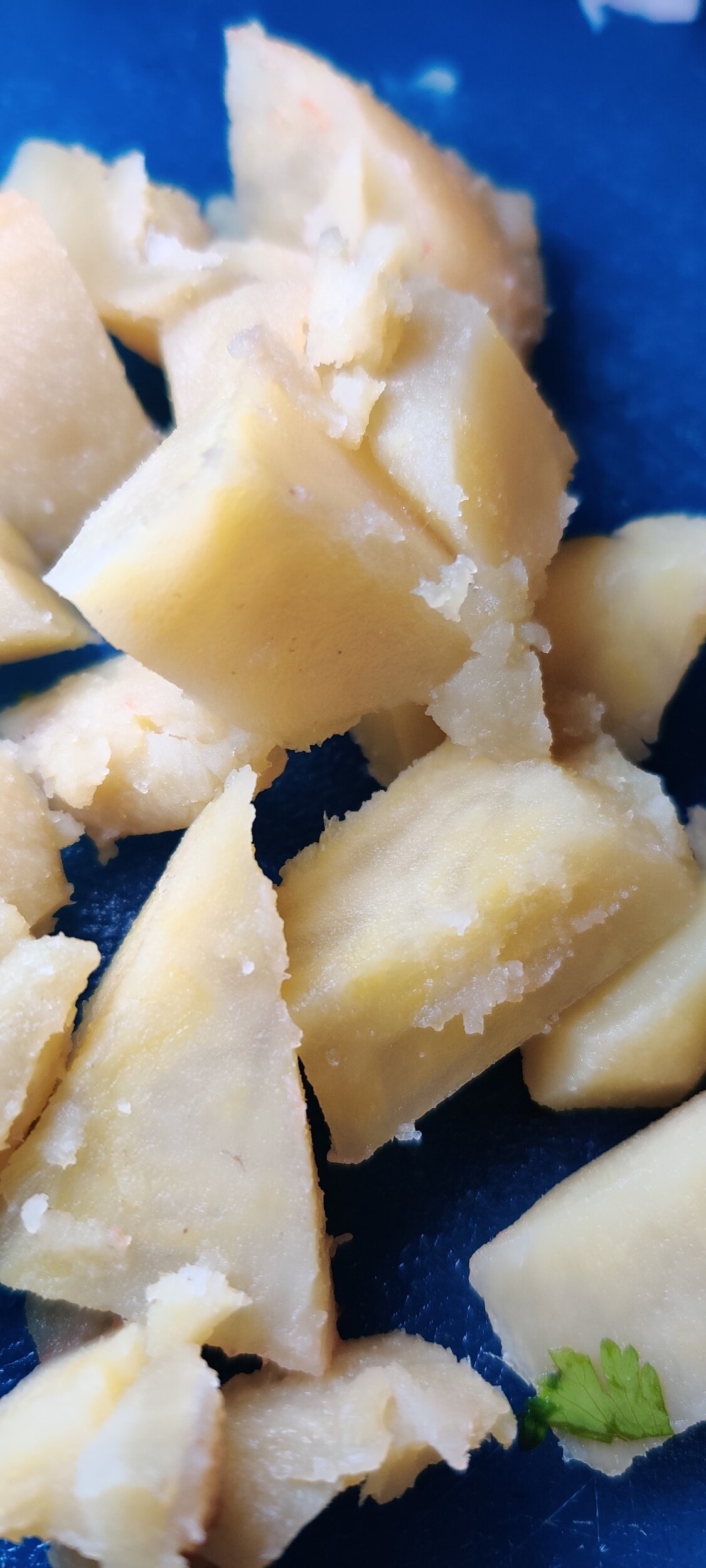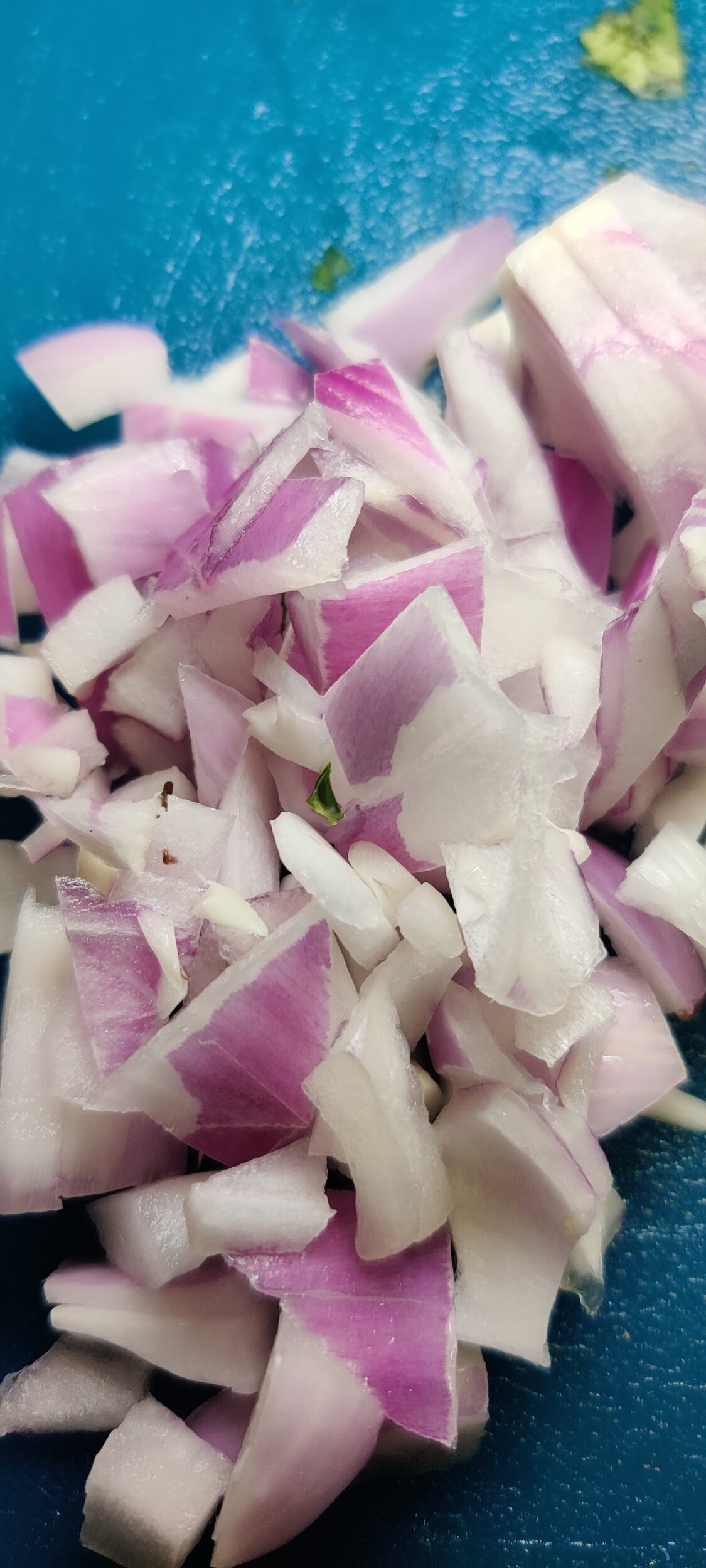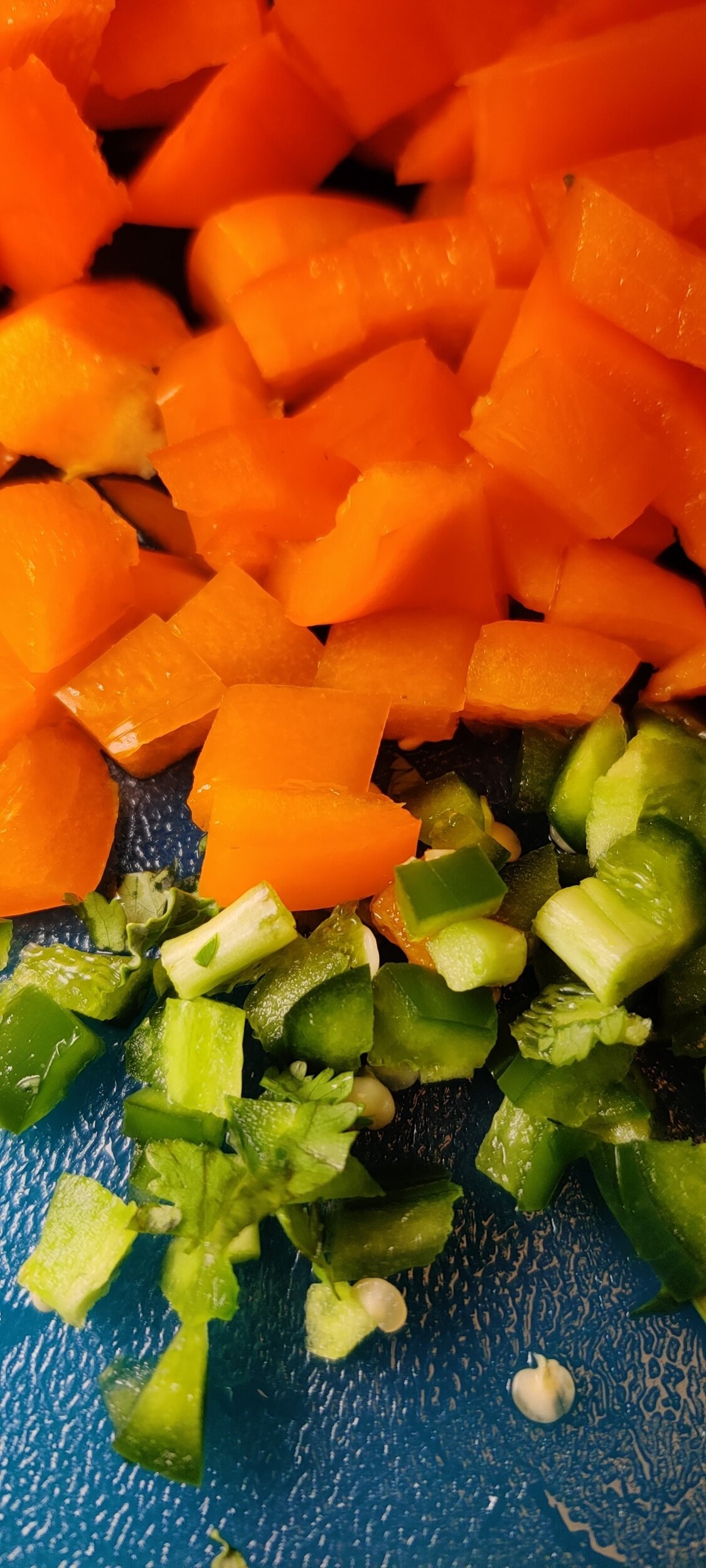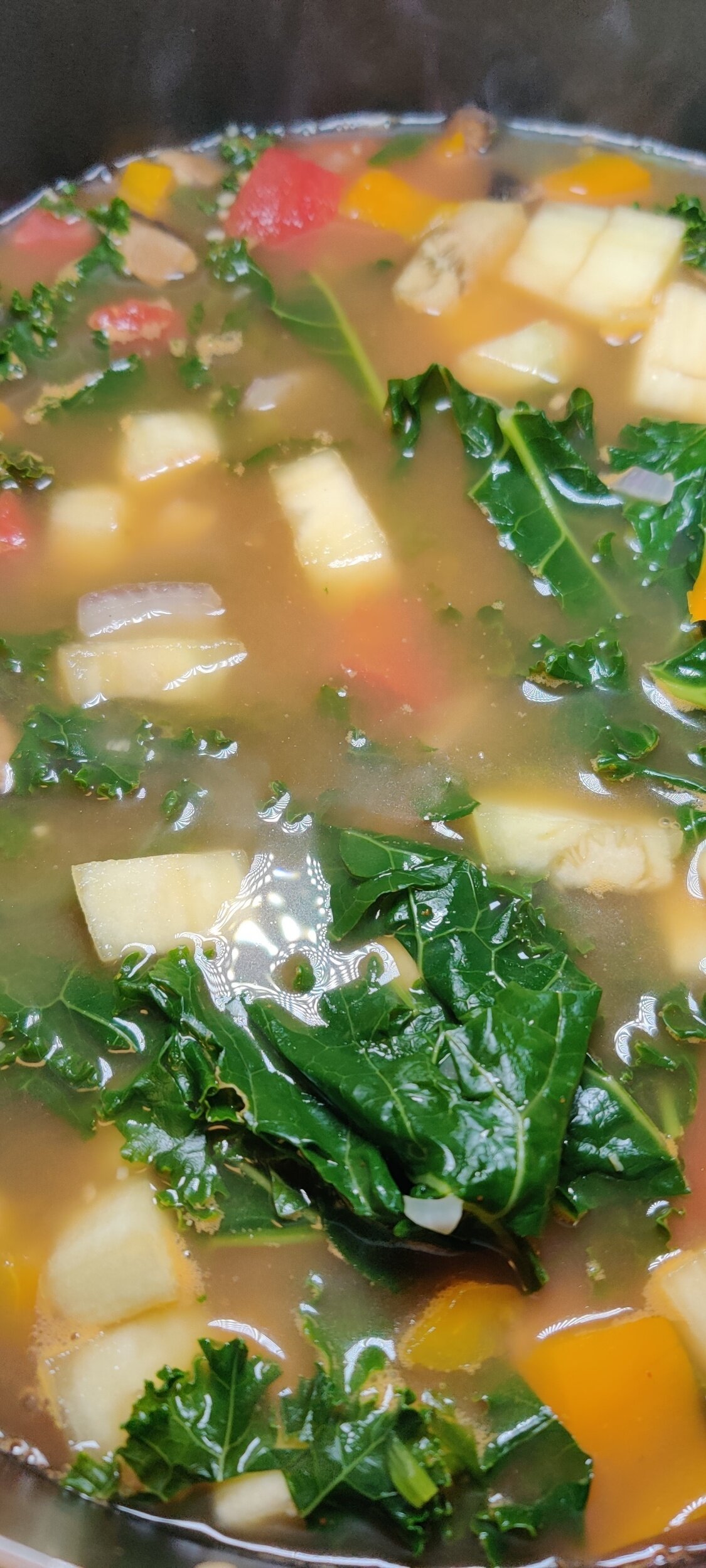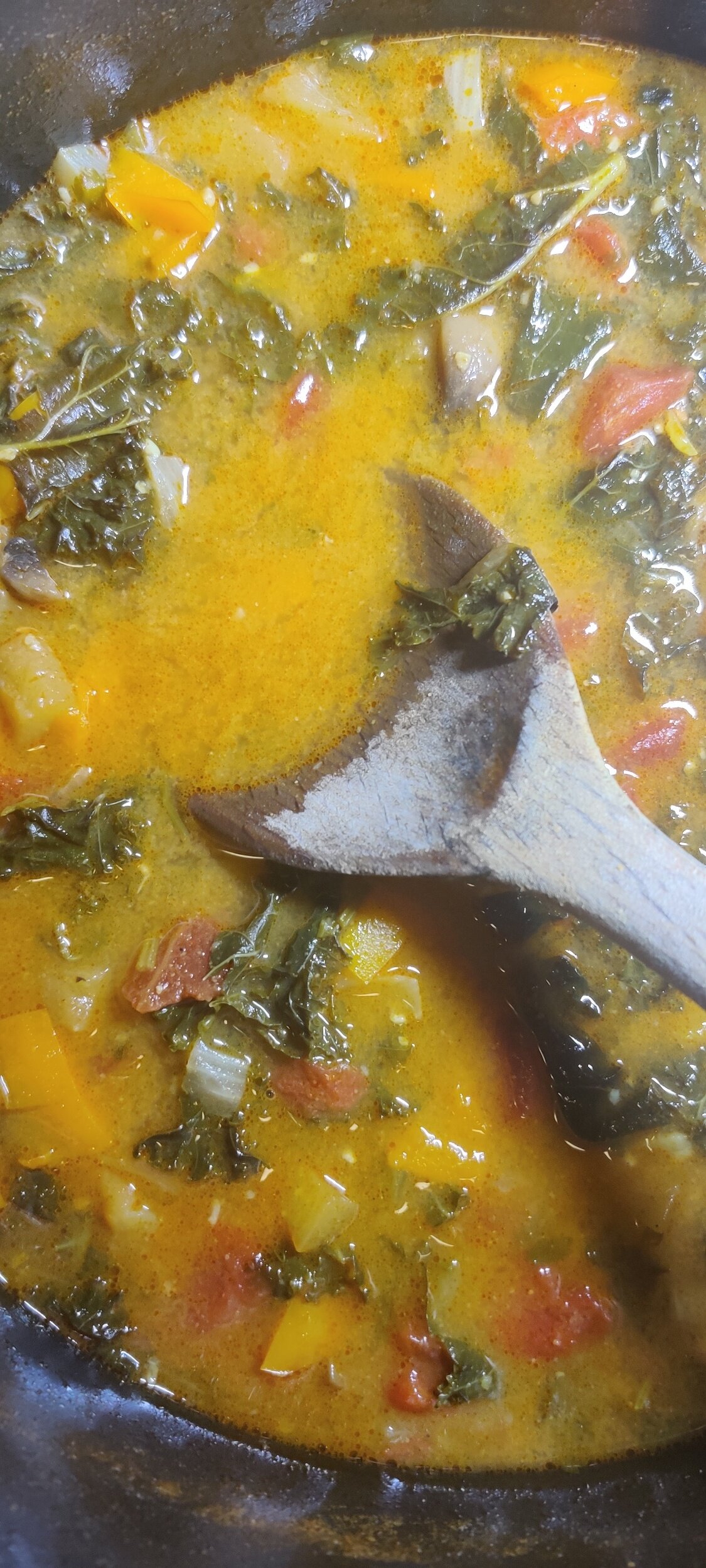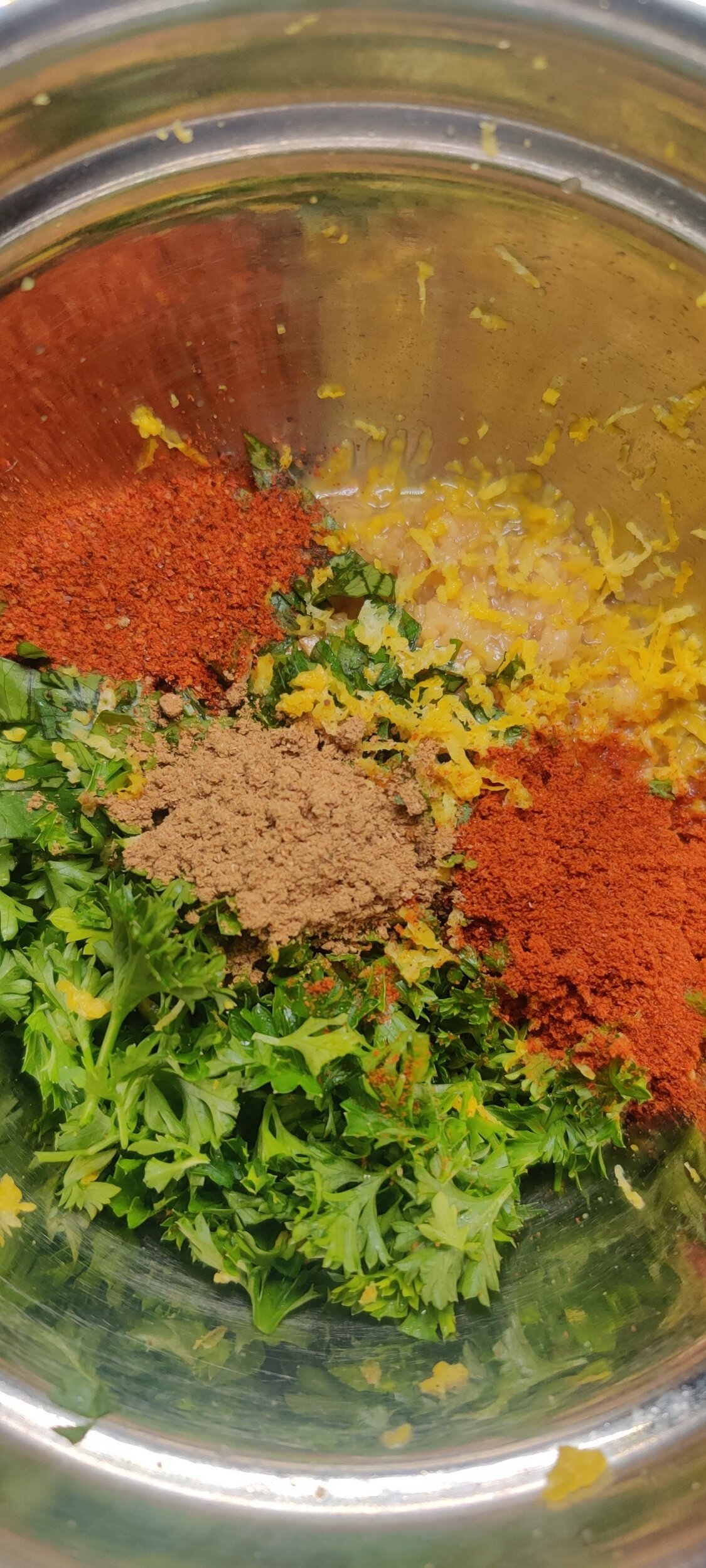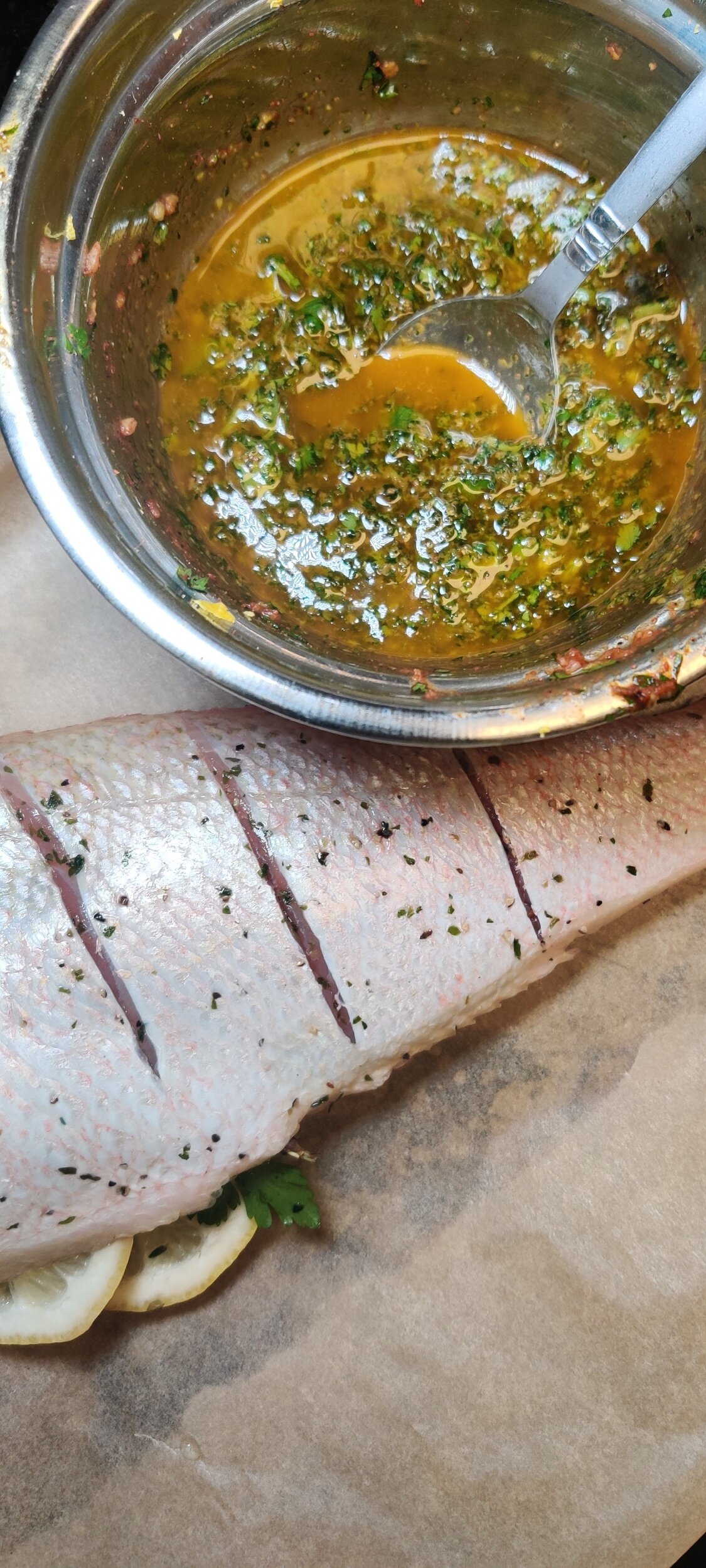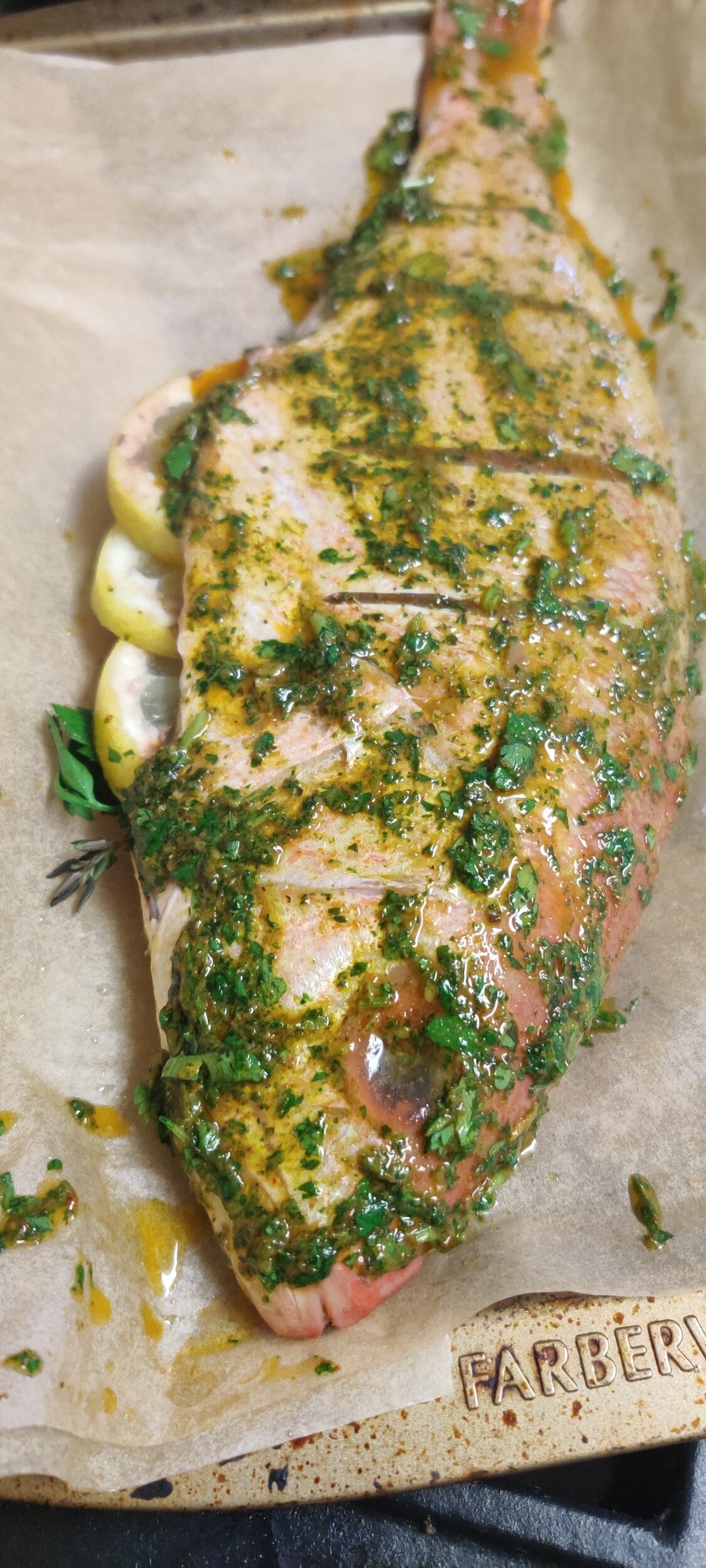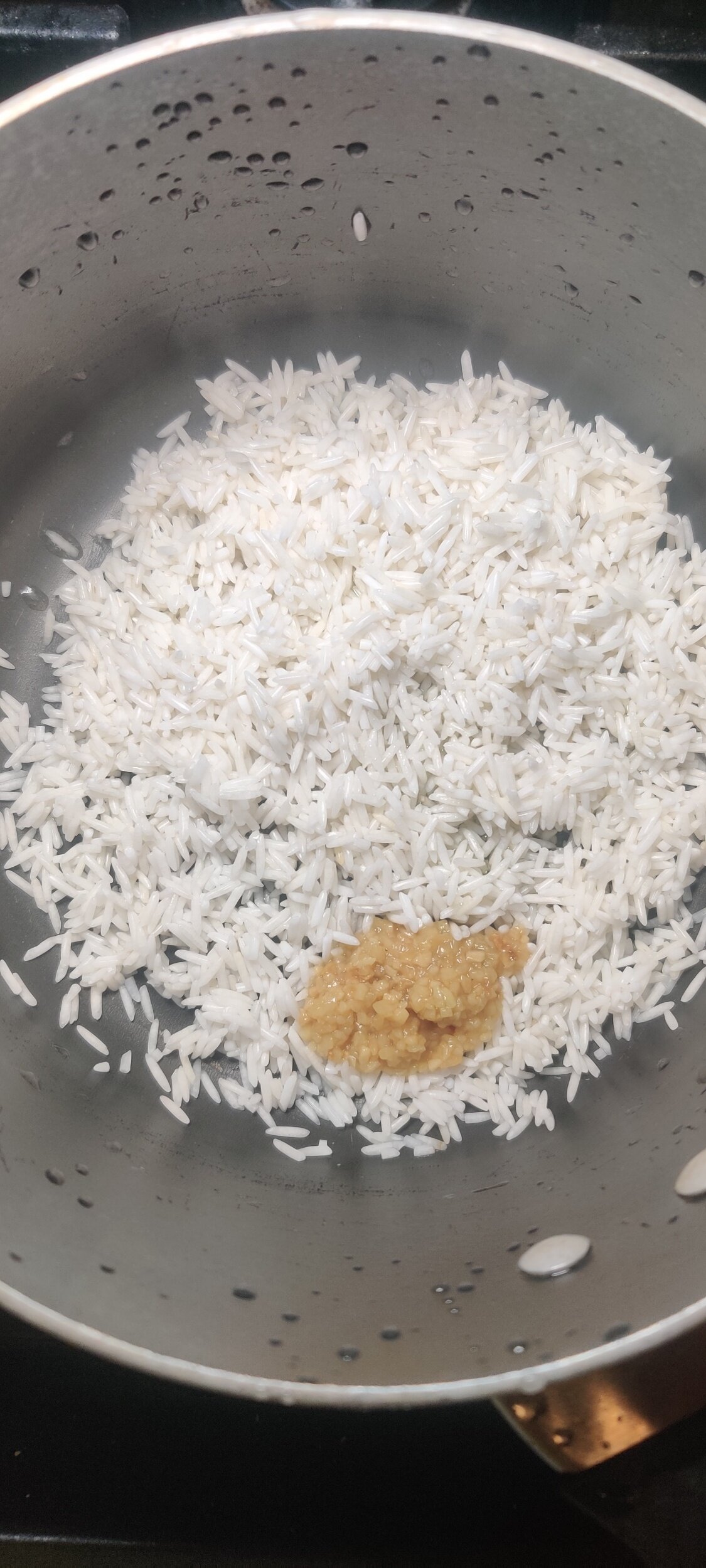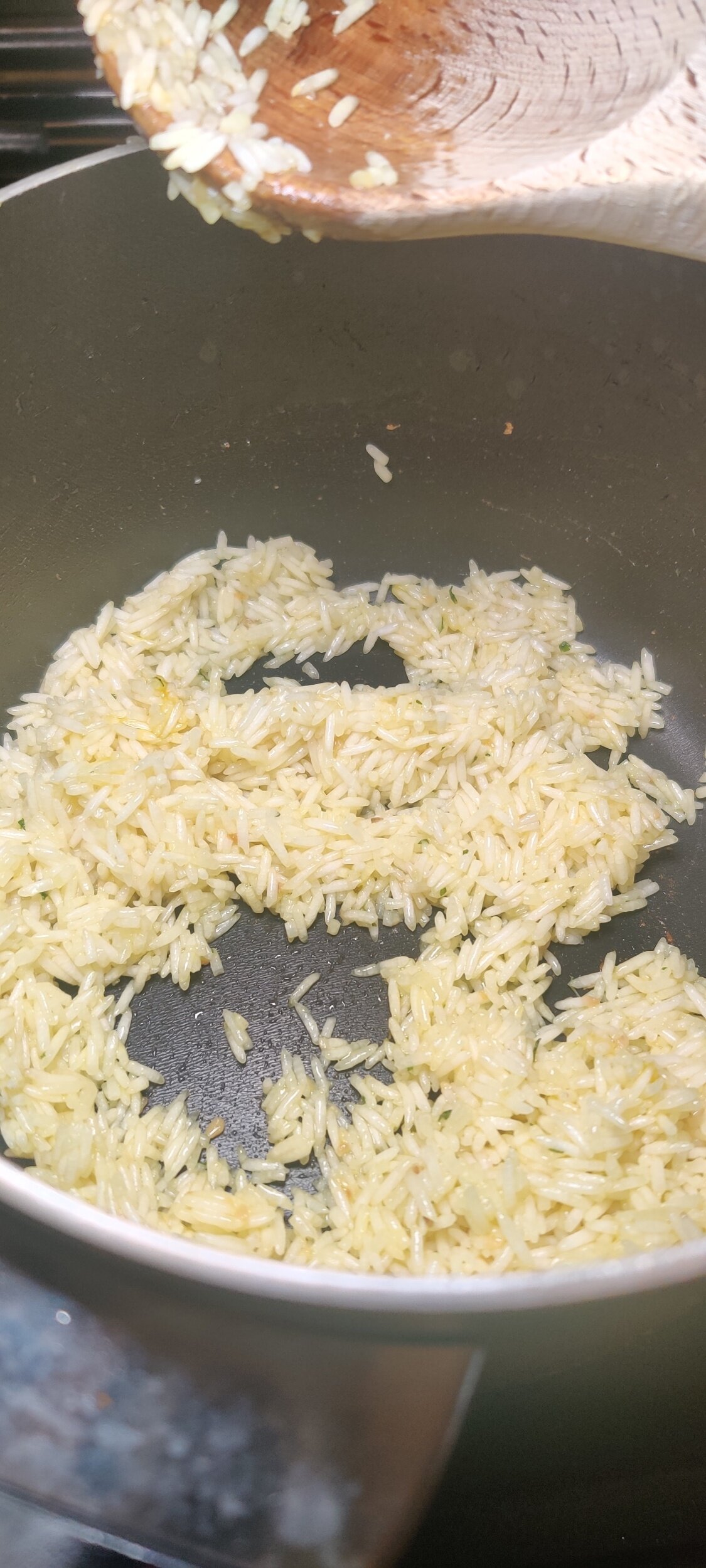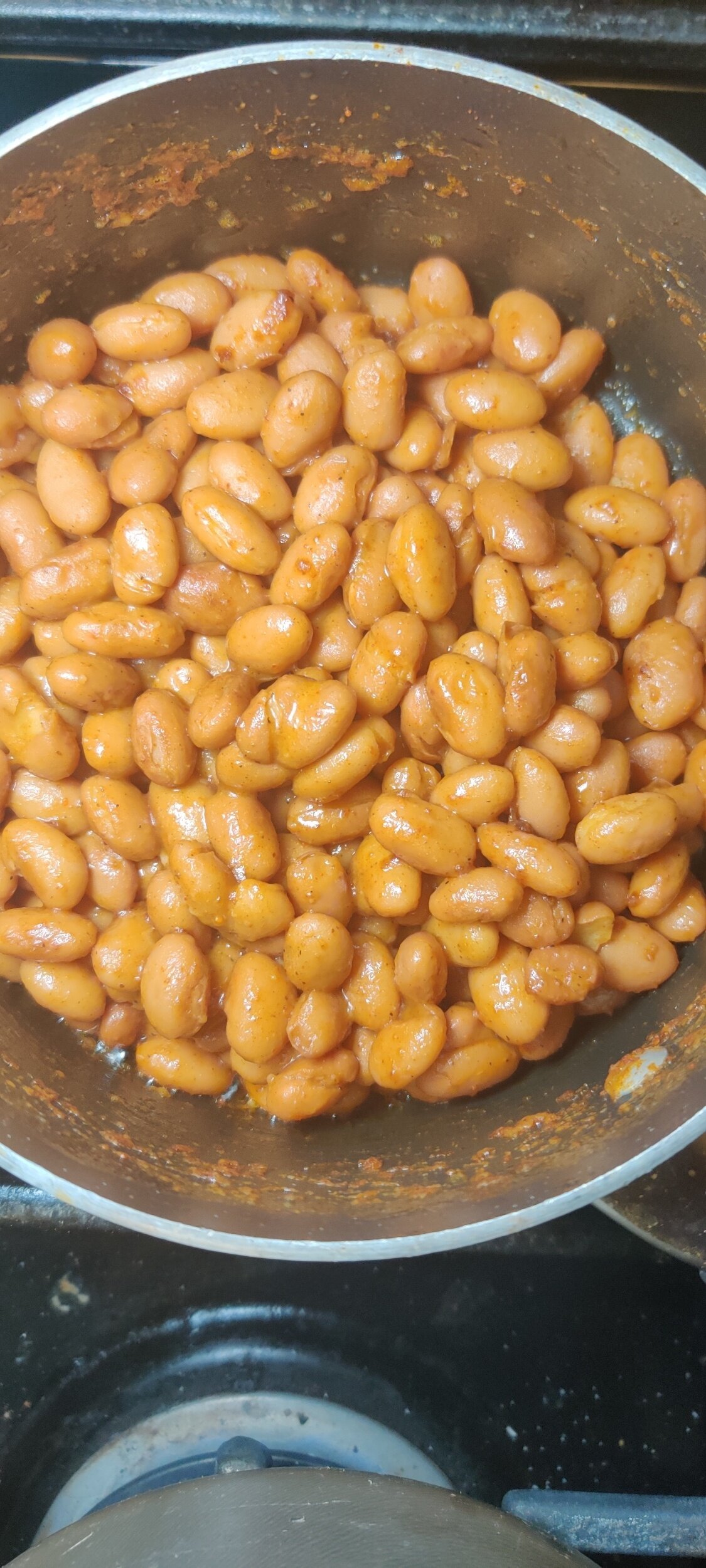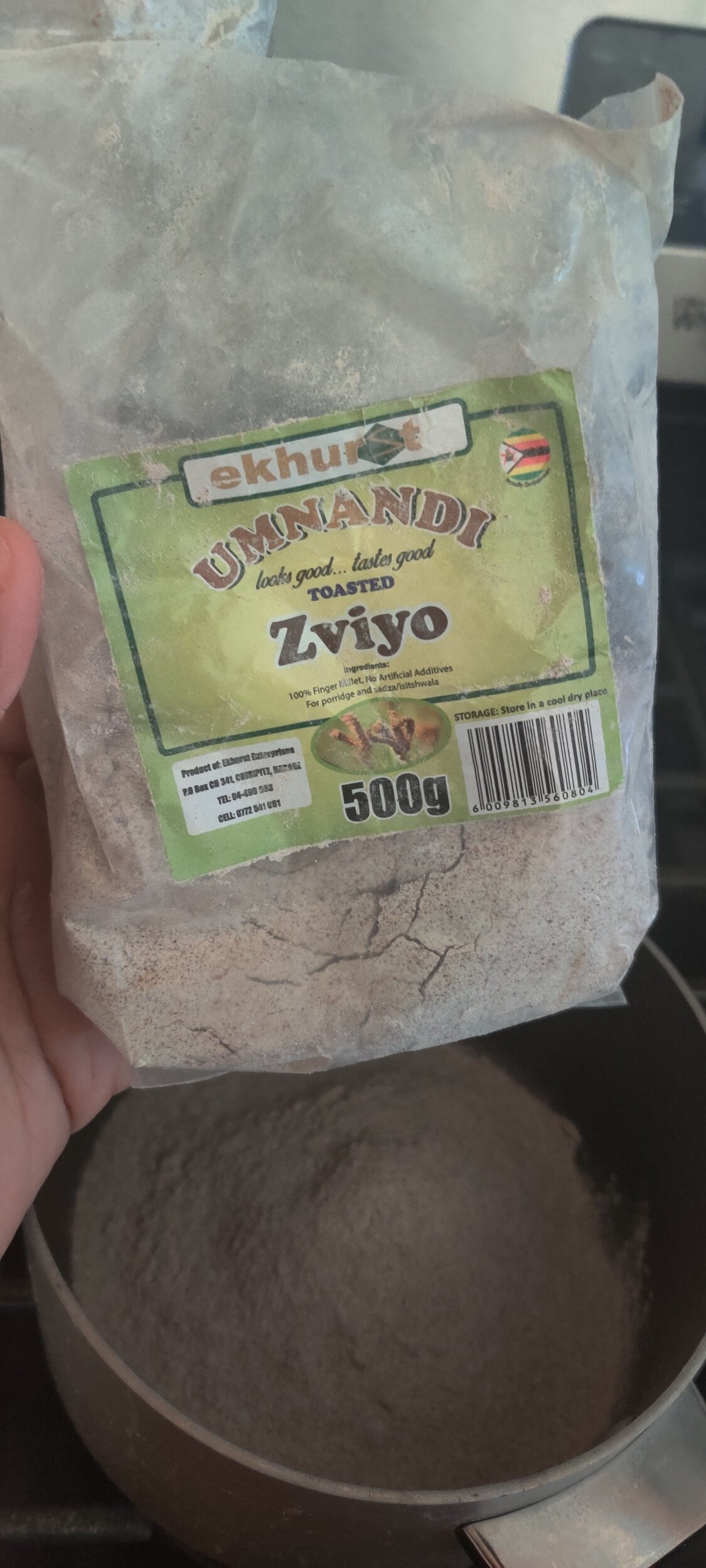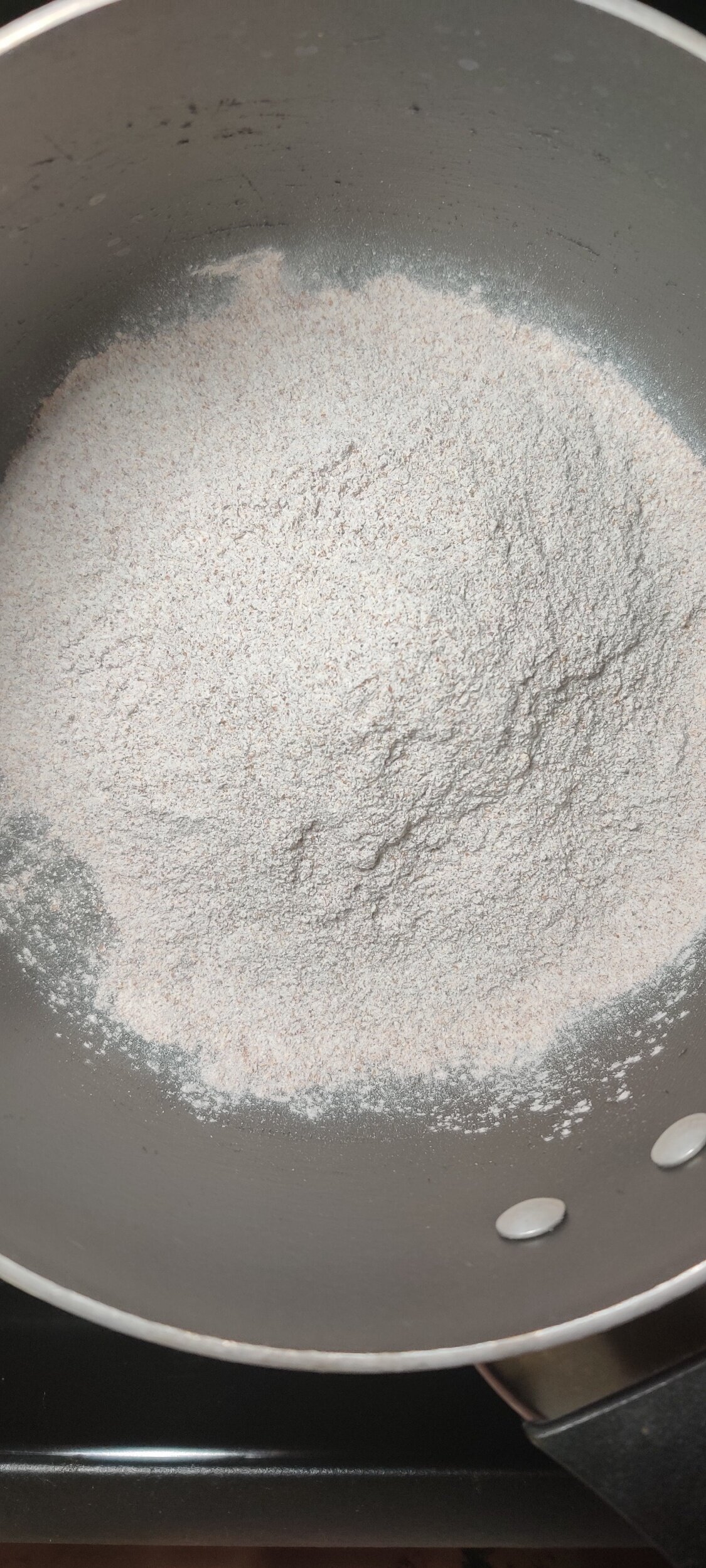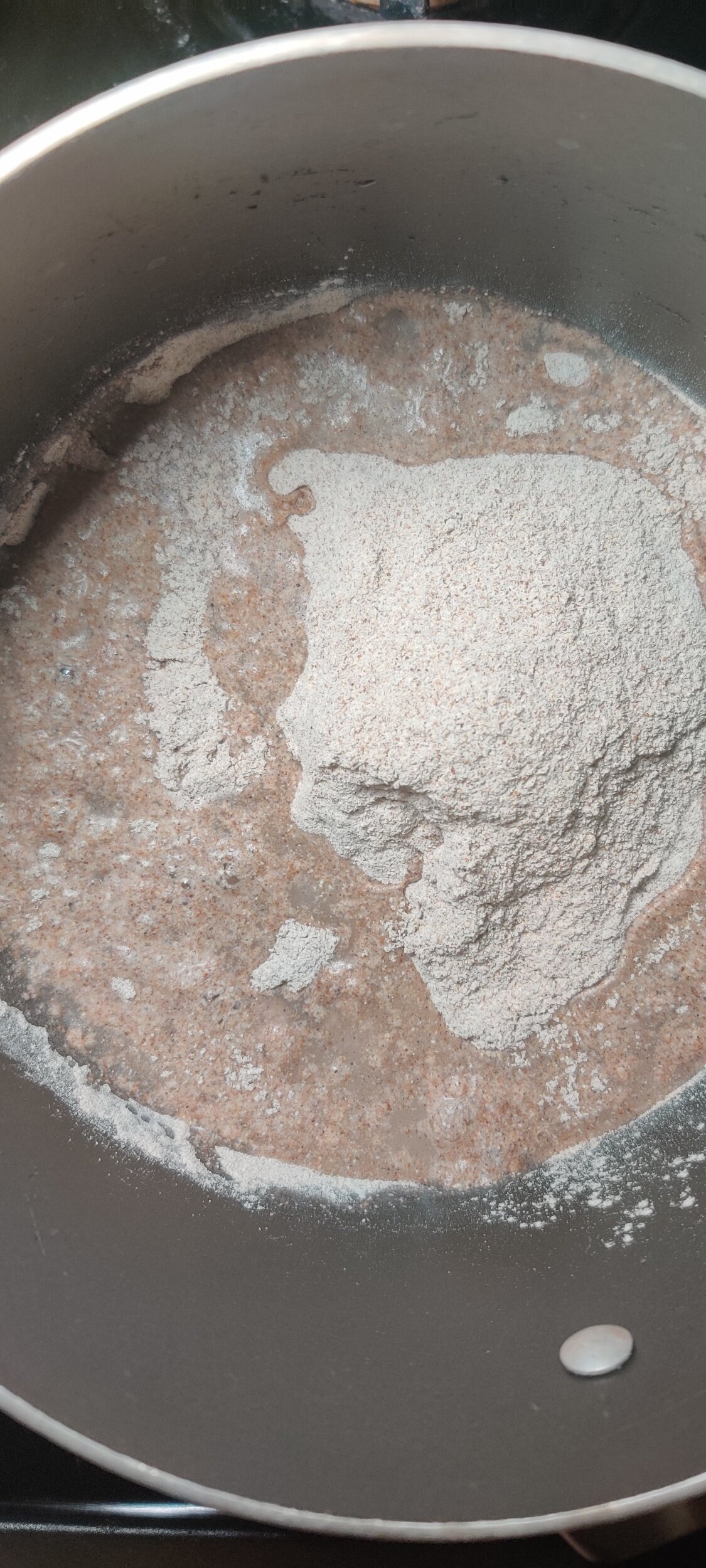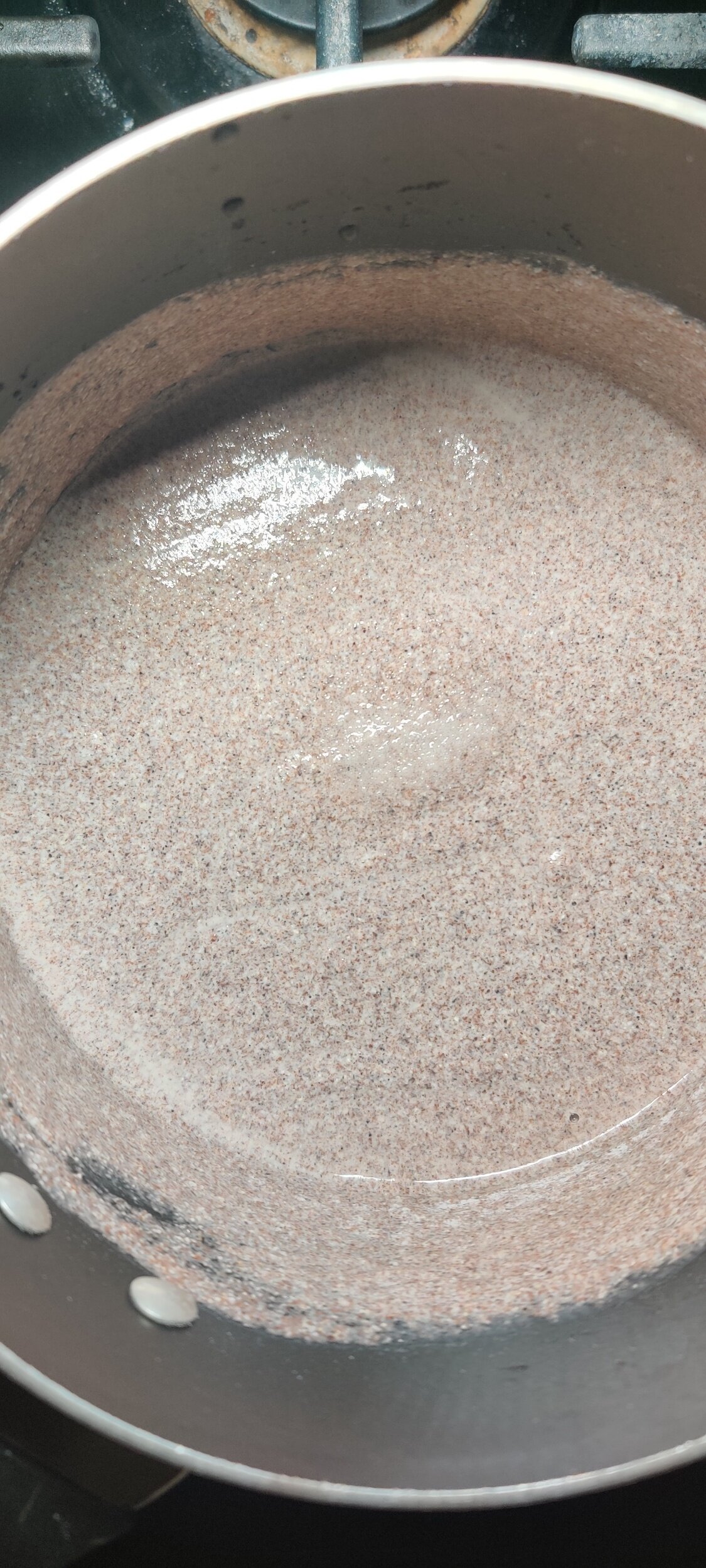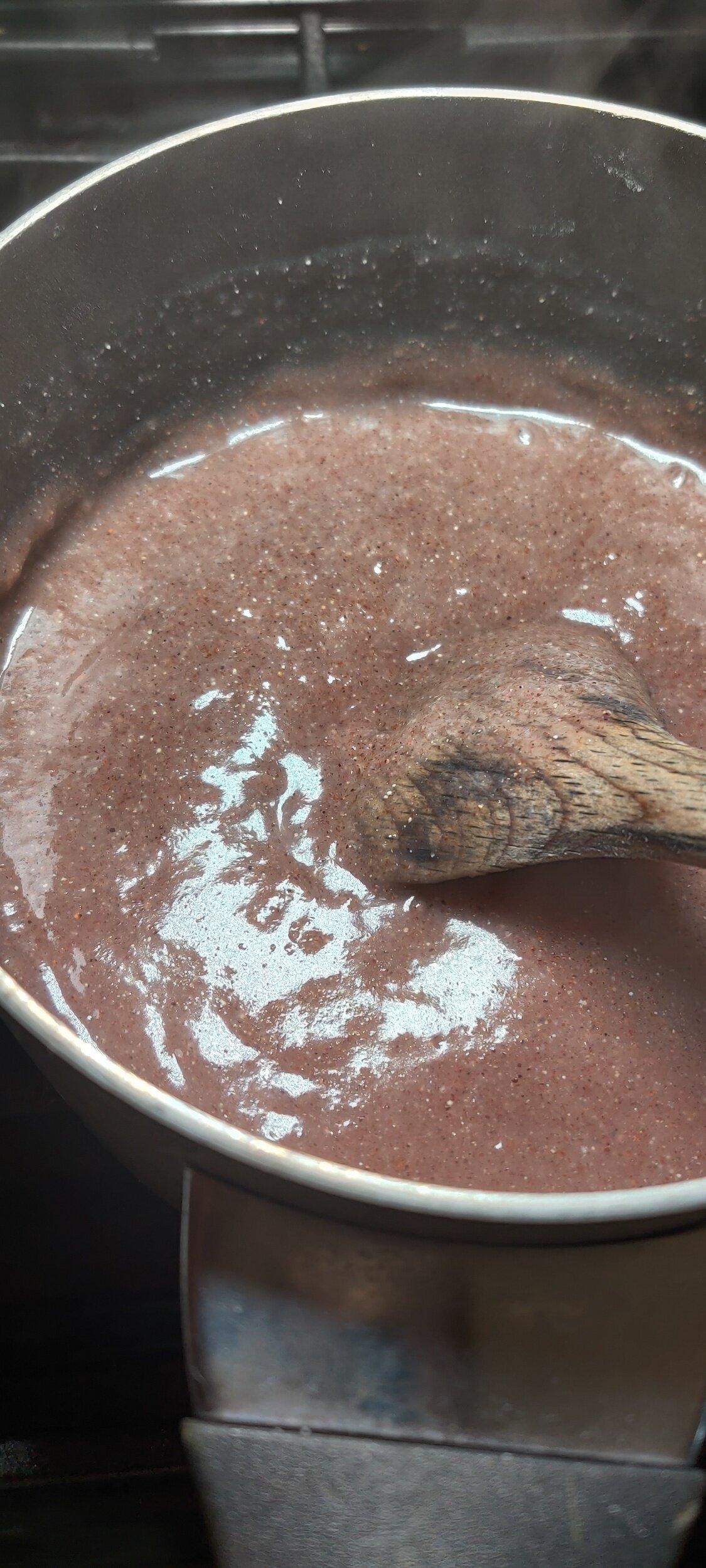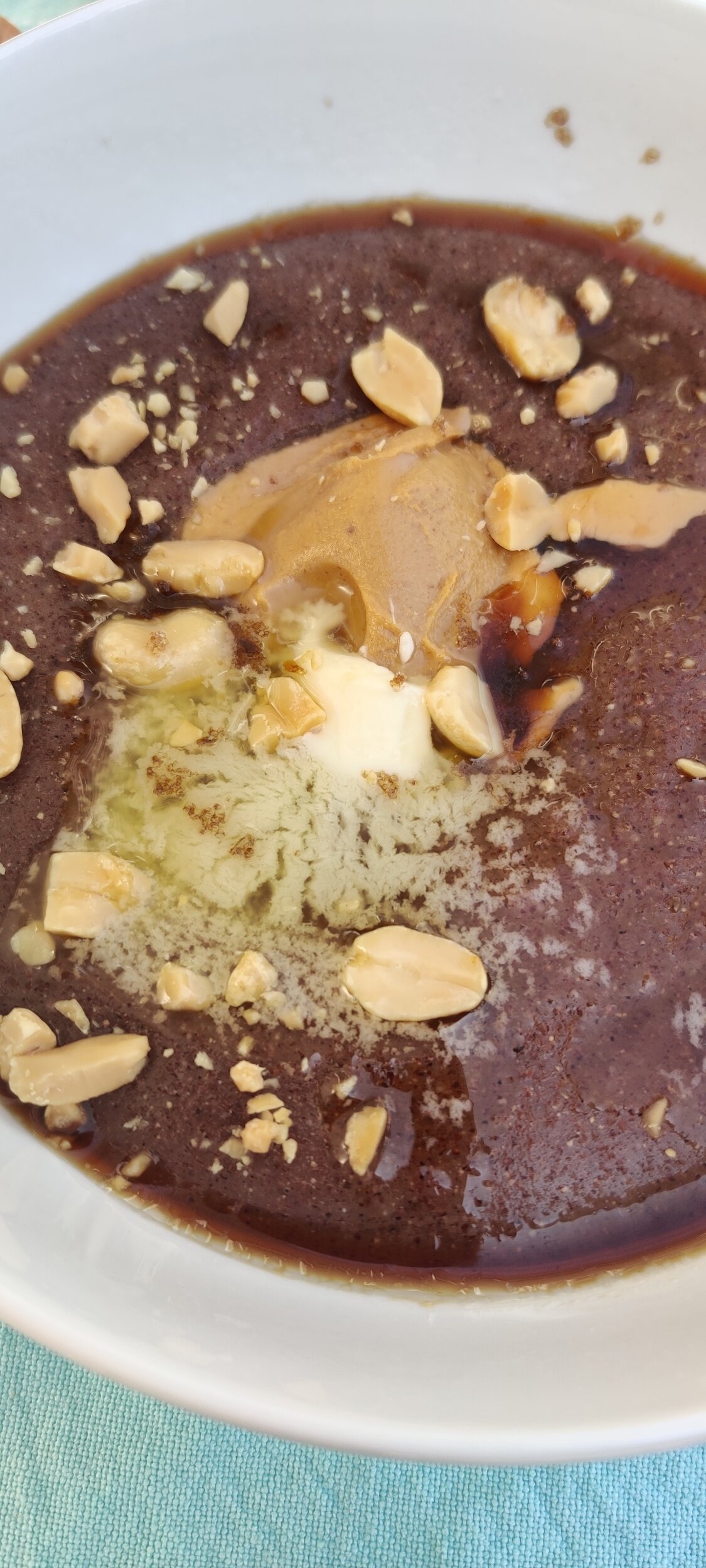Peri-Peri Chicken Livers with Onion Gravy
A Love Letter to Chicken Livers
Chicken livers were one of the first foods that made me feel connected to both comfort and culture. My earliest memory of them goes back to childhood, when my mother would cook livers and giblets from a whole chicken. She’d serve them at breakfast alongside eggs, toast, baked beans, and a rich onion gravy. I loved them. They were hearty, soulful, and full of flavor.
Years later, I was pleasantly surprised to spot chicken livers on the menu at Nando’s, the Southern African–Portuguese fusion chain. Their peri-peri livers transported me right back to my mom’s kitchen table.
There was even a period in my life when I had anemia, and liver became a medical necessity. At first, I ate it just for the iron. But soon I realized: chicken liver wasn’t just good for me, it was truly delicious.
Why Eat Liver?
I’ll never understand why people call liver “gross.” Yes, it’s organ meat, but when cooked right, it’s tender, savory, and deeply satisfying.
It’s also one of the most nutrient-dense foods you can eat, packed with:
Iron – especially heme iron, which the body absorbs easily
Vitamin B12 – crucial for energy and red blood cell formation
Vitamin A – supports vision and immune health
Selenium – helps maintain thyroid function
Folate – essential for cell growth and repair
High-quality protein
Think of it as nature’s multivitamin, only far more flavorful.
Chicken Livers in Southern Africa
In Southern Africa, chicken livers aren’t just an afterthought, they’re a star. They’re often cooked with onions, tomatoes, garlic, chili, and bold spices to make a rich, saucy dish. At home, they’re served with pap (maize porridge) or sadza, while restaurants often offer them with bread as a starter. This culinary tradition influenced chains like Nando’s, which helped spread peri-peri chicken livers around the world.
Why This Recipe Works
Flour dredge for texture – Lightly coating the livers in flour helps them brown evenly and naturally thickens the gravy.
Blooming the spices – Cooking peri-peri and coriander with onions unlocks deeper flavor.
Onions cooked two ways – Caramelized but still crisp, they add both sweetness and bite.
Quick sear, gentle simmer – Locks in flavor while keeping the livers tender.
Creamy finish – A splash of cream (or milk + powdered milk) balances richness and rounds out the sauce.
Resting time – Allowing the dish to sit off the heat helps the flavors settle.

Peri-Peri Chicken Livers with Onion Gravy
Rich, spicy, and comforting, these Peri-Peri Style Chicken Livers in Onion Gravy bring bold Southern African and Portuguese-inspired flavors to your table.
Ingredients
- 510 g (about 1.2 lb) chicken livers, cleaned and patted dry
- ½ medium red onion
- ½ medium yellow onion
- 2–3 garlic cloves, minced
- 2 teaspoons Portuguese or peri-peri chicken spice (I used Robertsons)
- ½ teaspoon garlic powder
- ½ teaspoon onion powder
- ½ teaspoon chilli flakes
- ½ teaspoon black pepper
- ½ teaspoon Italian seasoning
- ½ teaspoon ground coriander
- 1 teaspoon Royco Usavi Mix (or another mild, low-sodium all-purpose seasoning with some thickening)
- ¼ cup + 2 tablespoons flour, seasoned with 1/4 teaspoon of salt, black pepper, and garlic powder each
- ⅔ cup chicken stock
- 4 tablespoons cooking oil
- 3 tablespoons butter
- Salt and black pepper, to taste
- 3 teaspoons powdered milk + ½ cup water (or substitute with cream)
- 1 tablespoon tomato paste
- 1 lemon (use half to clean the livers and the other half to finish once cooked)
- Fresh parsley, for garnish
Instructions
- After soaking the chicken livers briefly in water with a bit of lemon juice, pat them dry with paper towels. Trim away any connective tissue or excess fat.
- Slice the onions into thin wedges and mince the garlic.
- Combine all your dry seasonings (except the all-purpose seasoning) and set aside.
- In a shallow bowl, season ¼ cup of flour with salt, black pepper, and garlic powder. Lightly coat the livers in the seasoned flour and shake off any excess.
- Heat 2 tablespoons of oil and 1 tablespoon of butter in a large, deep pan over medium-low heat.
- Add the red and yellow onions along with the garlic. Cook until golden and lightly caramelized but still slightly crisp.
- Add 1 tablespoon of oil and 1 tablespoon of butter, then stir in the combined spices, letting them bloom for 1–2 minutes.
- Remove the onion mixture from the pan and set aside.
- Add the remaining oil and butter to the pan. Sear the livers for 3–4 minutes per side until browned but not fully cooked through.
- Return the onions to the pan.
- Add the chicken stock, all-purpose seasoning, and tomato paste. Stir to combine and deglaze the pan.
- Simmer gently for 5–7 minutes, or until the livers reach an internal temperature of 160°F (71°C). Avoid overcooking.
- Stir in the powdered-milk-and-water mixture (or cream) and cook for 1–2 more minutes until the sauce thickens slightly.
- Remove from the heat and let the dish rest for 5 minutes.
- Squeeze the juice from the remaining half lemon over the livers and garnish with chopped parsley.
- Serve hot with fresh bread, pap/sadza, or mashed potatoes.
Nutrition Facts
Calories
370Fat (grams)
23.5 gCarbs (grams)
11 gFiber (grams)
1.5 gProtein (grams)
29 gI am not a certified nutritionist and any nutritional information on dontmissmyplate.com should only be used as a general guideline.
Stewed Pork Hocks with Sweet Potato (Mazondo)
If delicacies could walk… or rather, trot. Few cuts of meat are as humble yet deeply flavorful as pork hocks. Known for their tough skin, bone, and rich connective tissue, pork hocks have long been transformed by cultures that understand the value of slow cooking. In the American South, ham hocks brought deep, smoky flavor to pots of collard greens and beans, a survival food turned soulful cuisine. In Zimbabwe, they take on a new identity as mazondo, pig’s feet or ankles, revered as a delicacy. Often served in bars, homesteads, and special gatherings, mazondo is slow-cooked with onions, chilies, tomatoes, and spices until it’s meltingly tender.
In this recipe, I brought that tradition into the stew pot, giving the hocks a good sear to lock in flavor, then letting them braise low and slow with bold aromatics, rich seasoning, and an unexpected but powerful addition: sweet potato. While in Zimbabwe sweet potatoes (mbambaira) are typically enjoyed boiled or roasted as a standalone snack or side, they have an untapped potential when added to stews. Here, the sweet potato doesn’t just add subtle, earthy sweetness — it also brings nutrition and natural starch that gently thickens the broth as it cooks down, tying everything together in a rich, velvety texture.
Before cooking, I soak the hocks in red wine vinegar. This isn’t just for cleaning and tenderizing, but also to cut through the richness and add a subtle tang that balances the stew. It's a simple step, but it makes all the difference when working with fatty, collagen-rich cuts.
Prep and Cooking Tips for Mazondo
1. Soaking = Better Flavor and Cleaner Broth
Soaking pork hocks in vinegar and water helps clean the meat, neutralize strong odors, and tenderize it slightly. Rinse well after soaking to avoid excess acidity in the stew.
2. Sear for Maximum Flavor
Don’t skip the browning step, it adds deep, caramelized flavor that builds the base of your stew. Let the hocks sear undisturbed for a few minutes per side to get a good crust.
3. Low and Slow is Key
This stew rewards patience. Keep the heat low and let the hocks simmer gently for 2.5 to 3 hours. Rushing will result in chewy meat and thin broth.
4. Sweet Potato Choices Matter
Use a firm, orange-fleshed sweet potato or yam that holds up to long cooking. Softer varieties may break down too much, though that can also be desirable for thickening.
5. Customize the Heat
Adjust the chili to your preference. For mild stew, remove seeds from the chili or use a milder pepper. For more heat, add fresh chili near the end of cooking or include crushed chili flakes.
6. Make it Ahead
Like most stews, this tastes even better the next day. The flavors deepen and the texture improves after resting. Store in the fridge overnight and reheat gently.
7. Serving Suggestions
Traditionally served with sadza in Zimbabwe, but it's also excellent with rice, mashed potatoes, or crusty bread to soak up the broth. Try pairing it with sautéed greens for a full meal.
8. Skim the Fat (or Don’t)
Pork hocks release a good amount of fat. You can skim some off the top during or after cooking, or stir it back in for maximum richness, up to you.
9. Broth Boost
If you have homemade broth, use it! It gives the stew more body and complexity than water and bouillon alone.
10. Leftover Ideas
Leftover stew can be shredded and used in tacos, wraps, or even spooned over pap/sadza for a quick second-day meal.
With each spoonful, you're tasting tradition, technique, and transformation. The vinegar, the hocks, the sweet potato, each element speaks to how simple ingredients, handled with care and patience, can deliver deeply rooted, unforgettable flavor.
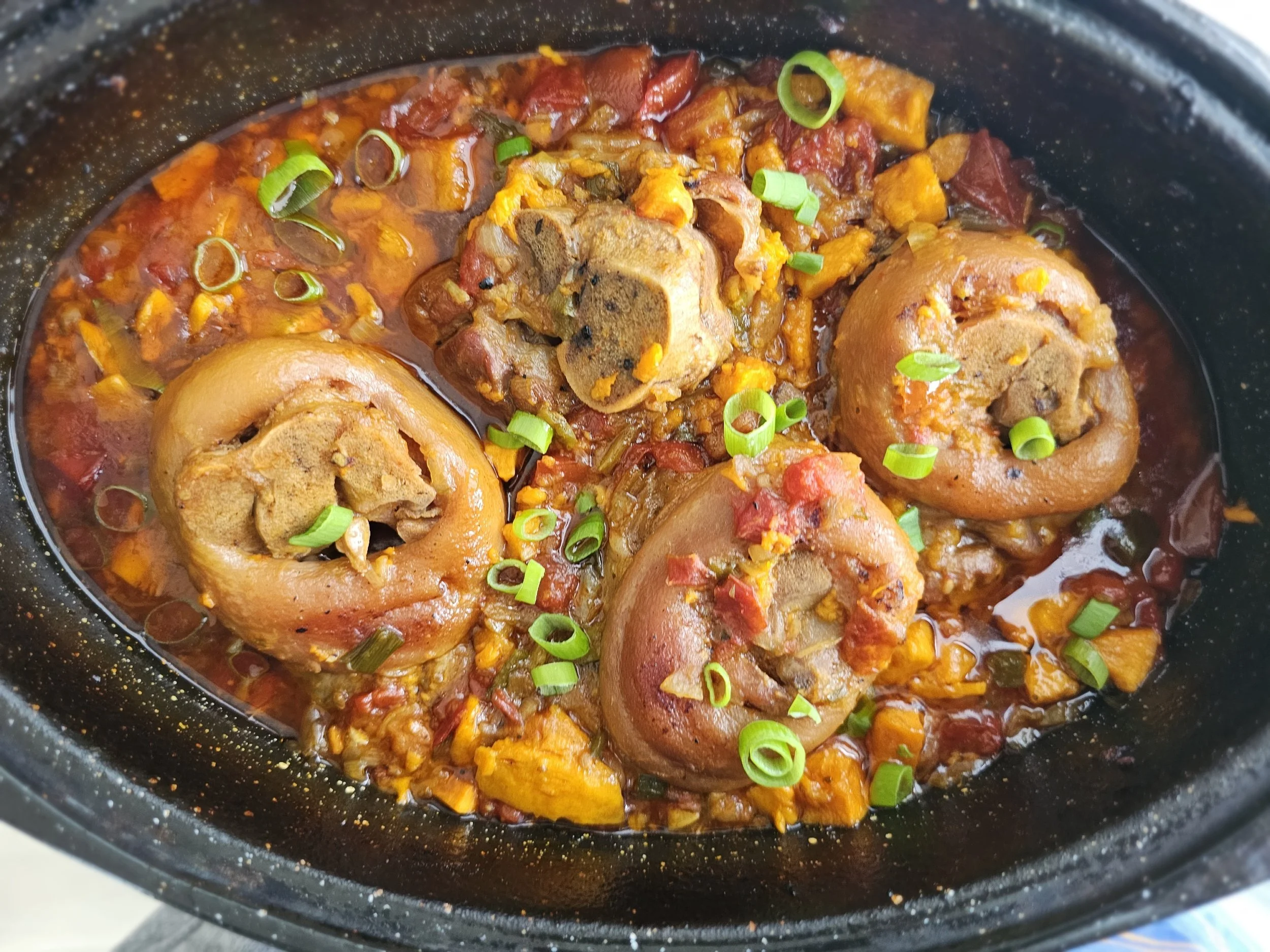
Stewed Pork Hocks with Sweet Potato (Mazondo)
Discover a rich, slow-cooked Pork Hock Stew (Mazondo) with sweet potato, inspired by Zimbabwean flavors and Southern soul food traditions. Tender pork hocks are soaked in vinegar, seared, and simmered with tomatoes, chili, and spices for a hearty, flavorful dish.
Ingredients
- 4 large pork hocks
- 1/3 cup red wine vinegar (for soaking)
- 1 tablespoon salt
- 1 tablespoon black pepper
- 1 large sweet potato or yam, peeled and cubed
- 1 large yellow onion, chopped
- 4 Roma tomatoes, chopped
- 1 chili pepper, finely chopped
- 2 large cloves garlic, minced
- 2 spring onions, sliced
- 2 bouillon cubes + 2 cups water (or homemade broth)
- 1/2 tablespoon Royco Usavi Mix (or your preferred all-purpose seasoning)
- 1/2 tablespoon Shishanyama spice (or BBQ meat rub)
- 2 tablespoons Worcestershire sauce
- 1 teaspoon cumin
- 1 teaspoon paprika
- 1 teaspoon oregano
- Cooking oil (coconut or olive oil)
- 2 tablespoons butter
Instructions
- Rinse the pork hocks under cold water. Place them in a large bowl and soak in red wine vinegar with enough water to cover. Let sit for 10 minutes, then drain and pat dry—very dry, so they brown nicely.
- Season the hocks with salt and pepper. In a large oven-proof pot roast dish or Dutch oven, heat a bit of oil over medium-high heat. Sear the hocks on all sides until golden and well browned. Remove and set aside.
- In the same pot, sauté the onion, garlic, chili, and spring onions until softened and fragrant. Add the Royco Usavi Mix, Shishanyama, and bouillon cubes. Cook for 1–2 minutes to bloom the spices, adding a bit more oil if needed. Stir in the tomatoes and Worcestershire sauce and cook for another 1–2 minutes.
- Add the cubed sweet potatoes, followed by the broth (or water), cumin, paprika, and oregano. Let everything simmer for 3–4 minutes to start developing the base of the stew.
- Transfer the pork hocks to a deep roasting pan or heavy pot. Pour the sweet potato and tomato mixture over the hocks, making sure they’re mostly submerged. The liquid will reduce and become the stew.
- Cover and simmer on low heat at 325°F for 2.5 to 3 hours, until the meat is fall-off-the-bone tender and the sweet potatoes are soft. When checking occasionally during cooking, avoid over-mixing to prevent the sweet potatoes from breaking down into a soup-like consistency.
- If there's more liquid than you'd prefer with about 30 minutes remaining, increase the temperature to 350°F.
- Finish with chopped fresh spring onions. Adjust seasoning with extra salt, pepper, or chili flakes if you like more heat. Serve hot with sadza, rice, or thick bread, and sautéed kale (muriwo) on the side.
I am not a certified nutritionist and any nutritional information on dontmissmyplate.com should only be used as a general guideline.
Oven-Braised African Oxtail Stew
Cooking Oven-Braised Oxtail Stew Recipe African-Style
Oxtail is a beloved delicacy across many African cuisines, known for its rich flavor, tender texture, and deep, comforting stews. Slow-cooked to perfection, oxtail transforms into a melt-in-your-mouth dish infused with aromatic spices, herbs, and hearty ingredients. From the peppery, tomato-based oxtail stew of West Africa to the deeply savory, slow-braised variations of South Africa, this dish is a true celebration of bold flavors and traditional cooking techniques.
Whether served with rice, dumplings, fufu, Sadza, or pap, African oxtail dishes bring warmth and nostalgia to every bite. Its gelatinous richness makes for an irresistibly silky sauce, perfect for soaking up with your favorite side. If you’re looking for a meal that embodies comfort and tradition, African oxtail is a must-try!
Coming from Zimbabwe, I regarded oxtail as a special treat, typically reserved for special occasions. However, from time to time, we would get it as a surprise on a random winter weeknight for dinner. Honestly, though, this dish can be enjoyed all year round.
My mother kept it simple, using a combination of yellow onions, green onions, tomatoes, chili peppers, salt, and pepper—and the result was perfection. The dish was perfectly balanced: not too greasy, not dry, spicy yet slightly sweet, and incredibly satisfying, especially when served with sadza (Zimbabwean cornmeal) and muriwo (sautéed kale).
Living in the United States exposed me to various oxtail preparations I had never encountered before, from Vietnamese oxtail pho (Phở Đuôi Bò), a traditional broth-based soup, to Caribbean-style oxtail with browning sauce and white beans.
This recipe is relatively simple but can be elevated by using high-quality ingredients, such as locally sourced meat from the butcher. It also benefits from leaning into the bold spices commonly used in African cuisine—masala curry powder, cardamom, nutmeg, and cumin—all of which enhance the depth of flavor in oxtail stews.
Does rendered fat make stew taste better?
Also known as liquid gold, oxtail preparation is a matter of personal preference and may be influenced by health goals or the dish you plan to pair it with. If you're committed to reducing animal fats, feel free to trim away! However, keep in mind that some fat contributes to the rich flavor, signature color, texture, and moisture that make oxtail so special.
You can also leave the fat intact while cooking, then simply skim off the rendered fat that rises to the top once it's done. In general, oxtail is a fattier cut of meat compared to others, but that’s part of what makes it so delicious!
Some points to consider:
In addition to adding flavor, richness, and moisture to the dish, fat acts as a flavor carrier, helping to coat the ingredients and intensify their taste. Essentially, it enhances the overall mouthfeel and depth of the stew. Key benefits include:
Flavor Enhancement: Rendered fat releases flavorful compounds that infuse the stew with a deeper, richer taste.
Moisture Retention: Fat helps keep the meat and vegetables moist during cooking, preventing them from drying out.
Browning Potential: Cooking meat in rendered fat creates a delicious caramelized crust, adding another layer of flavor.
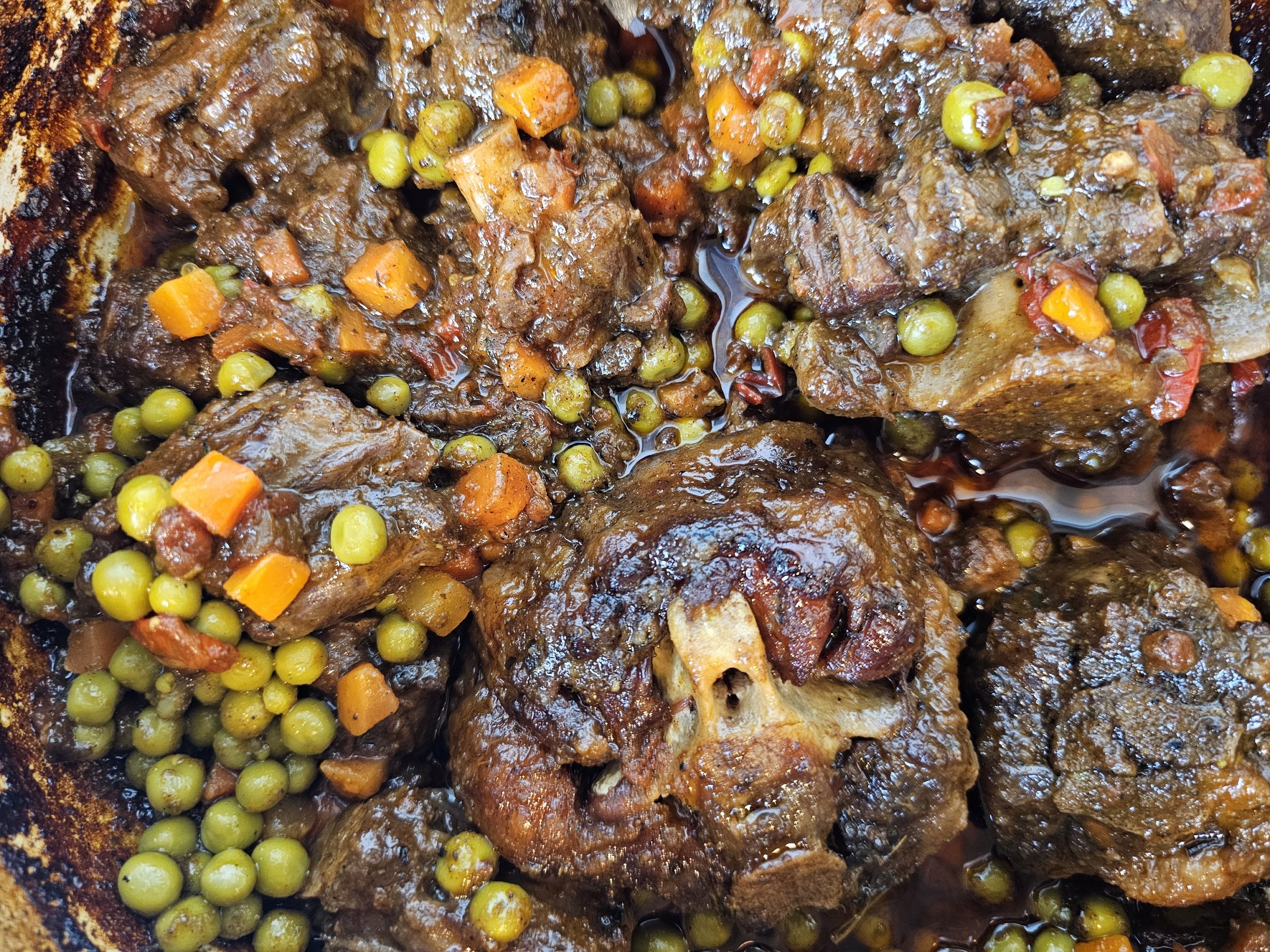
Oven-Braised African Oxtail Stew
Ingredients
- 3 tablespoons olive oil
- 1.5 lbs oxtail
- 1 tablespoon seasoned salt
- 1 tablespoon black pepper
- 1 tablesppon dark brown sugar
- 1 cup mirepoix (carrots, onion and celery)
- 1/3 cup green onions/scallions (optional)
- 1/2 cup red bell peppers
- 1/2 cup diced tomatoes (frozen or fresh)
- 3 garlic cloves
- 1 tablespoon Masala curry powder
- 1 tablespoon Royco Usavi Mix or all-purpose seasoning
- 1 tablespoon flour or cornstarch (optional)
- 1 tablespoon onion powder
- 1 teaspoon cayenne pepper
- 1 teaspoon smoked paprika
- 1 tablespoon oregano
- 1 teaspoon cumin
- 1 tablespoon garlic powder
- 4 beef bouillon cubes
- 1/4 cup red cooking wine
- 4 cups water
- 1/2 lime juice
- 1/2 teaspoon ground ginger
- 1/4 teaspoon cardamon
- 1/4 teaspoon cloves
- 1/4 teaspoon nutmeg
- 2 tablespoons Worcestershire sauce
- 2 tablespoons tomato paste
- 1 thyme spring
- 1 habanero pepper
- 3 bay leaves
- 2 cups carrots and peas, cooked
Instructions
- Preheat the oven** to 350°F (175°C).
- Prepare the oxtail: Wash the oxtail in cold water, vinegar, and lime juice, then pat dry. Depending on your preference and the leanness of the cuts, trim any excess fat or leave the bones as they are.
- Brown the oxtail. In a Dutch oven, heat some oil over medium to medium-low heat. Add the oxtail pieces, then season with sugar, salt, and pepper, mixing to coat evenly. Sear until browned on all sides, ensuring even color. Remove the oxtail from the pot, keeping the oil in the pan.
- Sauté the vegetables. Add the mirepoix (onions, carrots, and celery) and cook for 1–2 minutes. Add the peppers and cook for another 1–2 minutes.
- Stir in the tomatoes (if using frozen, cook down for 2–3 minutes). Add the garlic and cook for another minute.
- Reduce the heat to low to prevent burning. Stir in curry powder, Royco Usavi mix, onion powder, cayenne pepper, smoked paprika, oregano, cumin, and garlic powder. Mix gently to incorporate and bloom the spices.
- Add the bouillon cubes, followed by cooking wine to deglaze the pot. Stir well, crushing the bouillon cubes as they dissolve.
- Return the oxtail to the pot: Stir to coat the meat in the aromatics and seasonings.
- Pour in water and stir, then add lime juice.
- Stir in ginger, cardamom, cloves, nutmeg, and Worcestershire sauce.
- Add tomato paste, thyme, bay leaves, and habanero. Mix thoroughly, ensuring the tomato paste is well incorporated.
- Cover and place the pot in the oven for 2 ½ hours. Halfway through cooking, reduce the oven temperature to 325°F (163°C) and give the stew a stir.
- Remove from the oven and stir in peas and carrots. Let the stew rest for 10 minutes before serving.
I am not a certified nutritionist and any nutritional information on dontmissmyplate.com should only be used as a general guideline.
Huku ne Dovi (Zimbabwean Peanut Chicken Stew)
How to Make Chicken Stew at Home
Zimbabwean Peanut Chicken Stew, also known as huku ne dovi, is a rich and hearty dish that brings together tender chicken, creamy peanut butter, fresh vegetables, hot chilies, and aromatic spices. The result is a perfectly balanced blend of savory and nutty flavors. Whether served over rice, sadza (Zimbabwe’s staple maize porridge), or with warm bread, this traditional dish is a true comfort food favorite.
It might seem like an unusual combination, but across several African cultures, this pairing is wholeheartedly embraced as a bold, comforting meal. In my household, we didn’t have it often, but when we did, it was a glorious treat—especially during the colder months.
A Note on Chilies and Peanut Butter
The key to this dish lies in balancing the heat of the chilies with the creamy sweetness of the peanut butter. You’ll want just enough of both to create a harmonious dance of flavors on your taste buds. That interplay is where the magic of this stew truly shines.
Chicken Texture: Crispy or Tender?
When it comes to the texture of the chicken, there are two camps:
Tender and falling off the bone – Juicy chicken pieces that soak up the stew’s flavors.
Crispy and intact – For those who prefer firmer, browned pieces of chicken.
If you belong to the second group, hold off on adding the chicken back to the pot after browning, or roast the pieces separately and add them just before serving. This way, the chicken stays crispy and retains its texture.
Adjusting the Sauce Consistency
The thickness of the sauce can also be tailored to suit your preference:
Thinner Sauce: Ideal for serving over rice—just shy of soup-like, but light enough to soak into the grains.
Thicker Sauce: Perfect for pairing with sadza or bread, as it clings better to each bite. For a thicker consistency, follow the optional instructions to reduce and thicken the sauce once the flavors have melded together.
Need Some Extra Tips for Your Chicken Stew?
1. Choose the Right Cut of Chicken. Bone-in, skin-on chicken pieces (like thighs, drumsticks, or a whole chicken cut into parts) add rich flavor to the stew. Boneless cuts are also fine but may cook faster and lack the depth of flavor bones provide.
2. Brown the Chicken First. Sear the chicken pieces in hot oil until golden brown before adding them to the stew. This step locks in flavor and adds a delicious depth to the dish.
3. Build Flavor with Aromatics. Use a base of onions, garlic, and fresh or dried herbs like thyme, rosemary, or bay leaves. These aromatics infuse the stew with a rich, savory aroma.
4. Don’t Rush the Cooking Process. A good stew takes time. Simmering the chicken slowly allows the flavors to meld and the meat to become tender. Resist the urge to boil, as this can make the meat tough..
5. Season in Layers. Season the chicken, the broth, and the vegetables as you go. This ensures the flavors are well-balanced throughout the dish. Adjust salt and spices as needed during cooking.
6. Use a Flavorful Liquid. Chicken broth, stock, or even a combination of broth and water enhances the stew's richness. You can also add a splash of wine, coconut milk, or tomato puree for added depth, depending on the recipe.
8. Thicken the Stew to Your Liking. For a thicker consistency, use flour or cornstarch as a thickener. You can also mash a few of the potatoes or add a slurry (a mixture of flour or cornstarch with water).
9. Taste and Adjust Seasoning. Before serving, taste the stew and adjust seasoning with salt, pepper, or a squeeze of lemon juice for brightness.
10. Garnish for Extra Flavor. Add fresh herbs like parsley, cilantro, or dill just before serving for a pop of freshness. You can also top the stew with a dollop of sour cream or a drizzle of olive oil for added richness.
11. Let It Rest. Allow the stew to sit for a few minutes off the heat before serving. This helps the flavors settle and intensify.
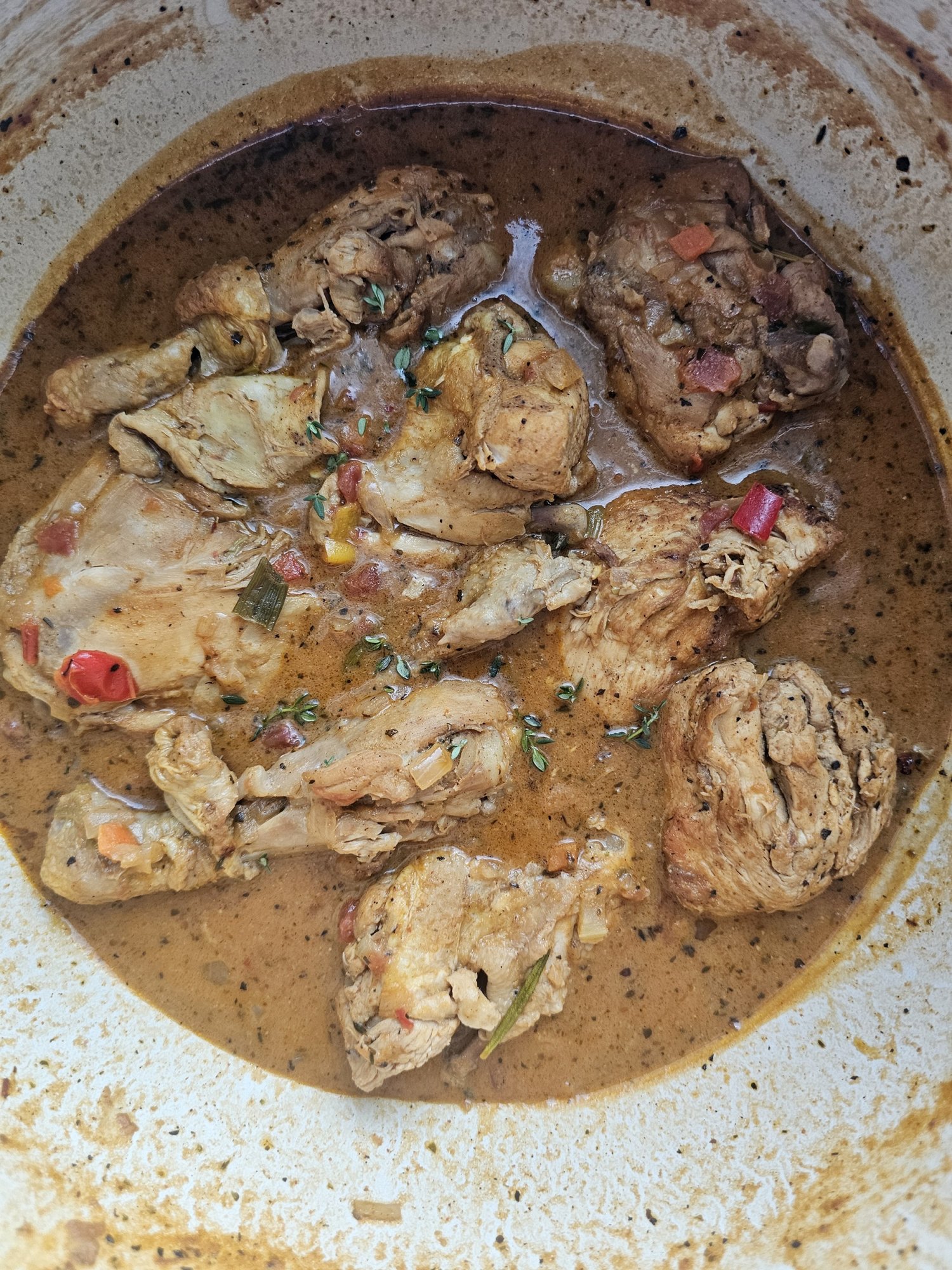
Huku ne Dovi (Spicy Zimbabwean Peanut Chicken Stew)
Zimbabwean Peanut Chicken Stew, or *huku ne dovi*, is a flavorful and comforting dish that combines tender chicken, smooth peanut butter, vibrant vegetables, spicy chilies, and fragrant spices.
Ingredients
- 1/4 cup olive oil
- 1 whole chicken, cleaned and cut into pieces
- 2 tablespoons chicken spice (I used Hind’s)
- 2 green onions
- 1 large hot chilli pepper
- 1/2 large yellow onion
- 1/2 cup mirepoix (chopped onion, carrots and celery)
- 1-2 tablespoons butter
- 1 tablespoon garlic powder
- 1 teaspoon black pepper
- 1 tablespoon paprika
- 1 tablespoon Royco Usavi Mix
- 3 chicken bouillon cubes
- 1/3 cup red wine
- 1 cup diced tomatoes
- 3 sweet bell peppers
- 1/3 cup peanut butter
- 2 tablespoons tomato paste
- 1 teaspoon ginger
- 1 teaspoon cumin
- 1 teaspoon coriander
- 1 teaspoon herb blend (I used basil and thyme)
- 3 cups water
- 3 bay leaves
- 2-3 tablespoons cornstarch or flour (optional)
Instructions
- Season the chicken with all-purpose chicken spice, then brown it in a Dutch oven or non-stick pan over medium to medium-high heat. Once browned, remove the chicken and set it aside.
- In the same pot, add the remaining oil and butter. Stir in the mirepoix, onions, bouillon cubes, garlic powder, black pepper, paprika, and Royco Usavi Mix. Sauté for 2-3 minutes until caramelized. Deglaze the pot with the wine, scraping up any browned bits to incorporate all the flavors.
- Next, add the tomatoes, peppers, chili peppers, cumin, ginger, and coriander. Cook for 1-2 minutes to allow the spices to bloom and the vegetables to soften.
- Return the chicken to the pot and pour in the water. Add more water if you prefer a thinner stew or soup-like consistency. Ensure as much of the chicken as possible is submerged to help it cook evenly. Simmer on low heat for 15-20 minutes.
- In a small bowl, mix the peanut butter with some of the hot stew liquid to thin it out. Stir in the tomato paste, then add the mixture to the pot, ensuring it is evenly distributed.
- Add the bay leaves and continue simmering for another 15-20 minutes.
- Optional: After 5-10 minutes, if you don’t want the chicken to fall off the bone, you can remove it and let the stew continue cooking separately to allow the flavors to come together.
- To thicken the sauce: Remove the chicken, then mix 2 tablespoons of cornstarch or flour with hot liquid from the pot to create a smooth slurry. Stir the slurry back into the pot, mixing well to activate the thickening. Continue cooking until the desired consistency is achieved.
- Season to taste, return the chicken to the pot, and serve hot with yellow rice or your preferred starch.
Nutrition Facts
Calories
438Fat (grams)
20.3 gSat. Fat (grams)
4.8 gCarbs (grams)
62.1 gFiber (grams)
18.5 gProtein (grams)
15.6 gI am not a certified nutritionist and any nutritional information on dontmissmyplate.com should only be used as a general guideline.
Sadza Nenyama (Beef and Kale Stew)
Zimbabwean Sadza with Kale and Beef Stew: A Hearty African Comfort Food
If you're looking to explore authentic African cuisine, Zimbabwean sadza with kale and beef stew is a must-try dish that embodies comfort, tradition, and rich flavors. Sadza, a staple in Zimbabwean households, is a smooth, thick cornmeal porridge similar to fufu or pap, often served alongside flavorful stews. This hearty meal is deeply rooted in Zimbabwean culture and represents the essence of home-cooked comfort food.
In this recipe, tender beef chunks are slow-cooked in a savory, aromatic tomato-based stew, perfectly balanced with nutrient-packed kale. That said, bone-in cuts are more common for this dish, and, in my opinion, provide a more flavorful, rich broth to tie the entire meal together. The combination of rich, meaty flavors and wholesome greens pairs beautifully with sadza, creating a satisfying meal that warms the soul. Whether you have Zimbabwean roots or are simply looking to try something new, this dish is a delicious way to experience the heart of Southern African cuisine.
If there was any meal I got sick of eating as a kid, it was this. As an adult far from home, I found myself with a new-found appreciation, and wanted to share the steps to materialize the meal. While I’ve personally cut down on meat, this classic dish still brings comfort, warmth, and a taste of home, especially on cold or rainy days.
For more recipes inspired by traditional Zimbabwean, cuisine, browse the website or check out Oxtail and Butternut Stew, Fried Sadza with Chilli Creamed Corn, Sadza with Butter Bean Kale Relish, Sadza and Creamed Spinach with Sardines, Huku ne Dovi (Zimbabwean Peanut Chicken Stew), and Black-Eyed Peas with Coconut and Tomato.

Sadza Nenyama (Beef and Kale Stew)
Ingredients
- 1 pound chuck beef or cut ideal for stew
- 1/2 large bunch kale, chopped
- 1 tablespoon butter
- 2 tablespoons vegetable oil
- 1 teaspoon salt
- 1 tablespoon black pepper
- 3 tablespoons Royco Usavi Mix (optional but highly recommended - you can also use a blend of 1 teaspoon cumin, 1 teaspoon coriander, 1/2 teaspoon turmeric, 1/4 teaspoon paprika, 1/4 teaspoon cornstarch, and 1/2 teaspoon fenugreek powder)
- 1 yellow onion, diced
- 3-4 Roma tomatoes, diced
- 1 tablespoon fresh garlic
- 1 tablespoon chili flakes
- 3 beef or vegetable bouillon cubes
- 3 cups water
- 1 1/2 - 2 cups cornmeal/mealie meal (I used yellow cornmeal)
- 1 teaspoon salt
- 3 cups boiling water
- 3/4 cup cold water
- 1 teaspoon garlic powder
Instructions
- Prepare your stew. In a large pot, add the butter and vegetable oil. Sauté the onion and garlic until the onion becomes translucent and the garlic fragrant, about 3-4 minutes. Add the salt, pepper, and spice blend, cook for another 2-3 minutes.
- Add the beef chunks and chilli flakes, brown the meat by cooking for about 5-7 minutes. Add the diced tomato and bouillon cubes, mix to incorporate.
- Add the chopped kale, followed by water (or liquid broth if you're using that). Reduce the heat and simmer for 30 minutes with the lid on top, stirring occasionally and seasoning to taste. You want your beef tender and cooked through, but not tough - so don't overcook.
- While the stew is cooking, make you sadza. Boil the water.
- In a medium-sized pot, stir 1/2 cup of the cornmeal with the cold water to make a paste (not too thick, not too thin).
- Season, then while stirring, add the boiling water - careful not to splash yourself! The heat should be on medium as your stir. After about 4-5 minutes, the cornmeal will begin to bubble. You can close the pot with the lid, and allow it to cook for about 15-20 minutes. Don't burn the bottom of your pot - you may need to reduce the heat to medium-low depending on your stove!
- Bring down the heat to low, and add the remaining cornmeal a 1/2 cup at a time, folding it in to make a soft dough - the softer you want the sadza the less cornmeal, for a thicker consistency use more . Place the lid back on the pot, leaving a slight opening, allowing the sadza to rest over the heat for about five minutes.
- Remove from heat and shape with a wooden spoon. Serve hot with the stew.
Notes
- For vegetarian alternative, use butternut or pumpkin cubes instead of beef.
- Sadza tastes better eaten hot, so try to serve immediately, storing until the next day hardens it. Consume the stew within 3-4 days when refrigerated, otherwise, freeze.
I am not a certified nutritionist and any nutritional information on dontmissmyplate.com should only be used as a general guideline.
Tried this recipe? I’d really love to know how it turned out for you. Leave a quick review or comment below — your feedback helps others (and makes my day!).
Braised Oxtail with Sweet Potato Mash and Green Bean Casserole
Oxtail is a delicacy and beloved dish in my eyes. That's because growing up my mother made the most delectable, slow-cooked braised oxtail you'll ever taste. A lot of people associate oxtail stew with the Caribbean, however, it's enjoyed in parts of Africa as well and, Zimbabwe is no exception. It should be reserved for special occasions as the meat around the bones is high in fat content, but you won’t regret it!
The oxtail bones can be marinated, or not, then lightly fried to brown the meat before adding it to a pressure cooker or roasting pot with vegetables and broth for a few hours i.e. braising. The result? A juicy, succulent, flavourful fall-off-the-bone short rib like dish in a very rich stew you can even eat separately with some fresh bread.
Why now? The holidays call for hearty, comforting dishes, and this oxtail main is the epitome and will not disappoint the table. It's also a great alternative to roast turkey for those who want to venture out!
What sides to pair it with? That can remain classic, I used green beans and sweet potato. I add some garlic to the mashed potatoes for some extra flavour and made caramelized onions for the green bean casserole.
I stewed in cream of mushroom soup but didn't want to use the out-of-a-box fried onions to top the beans as per the traditional recipe. It seems a fresh onion is a better option!
What about the texture? That's where some bread crumbs can come in, but it's up to you!
Ingredients
Oxtail:
4-8 oxtail bones
1/4 cup scallions, chopped
3 tablespoons fresh garlic, minced
1/2 yellow onion, diced
1 jalapeno, diced
1/2 large shallot, diced
2 large heirloom tomatoes
2 tablespoons tomato paste
Fresh thyme sprigs
4 tablespoons Royco Usavi mix (optional)
3 beef bouillon cubes
3 cups warm water
3 tablespoons steak seasoning or equal mix salt and coarsely ground pepper
1/4 cup soy sauce
1/4 cup cooking wine
1/4 cup olive oil
3 tablespoons vegetable oil
Mashed sweet potato:
2 large sweet potatoes
2 tablespoons garlic, minced
1/2 teaspoon salt
1 teaspoon coarsely ground black pepper
2 tablespoons garlic powder
2 tablespoons butter
1/4 cup milk or cream
Green bean casserole:
1 small bag French green beans
2 tablespoons garlic powder
1 can cream of mushroom soup
1/2 teaspoon salt
1 teaspoon black pepper
1 teaspoon brown sugar
1/3 cup milk
1/4 cup bread crumbs
2 tablespoons Habanero cheese, grated
1/4 of a large yellow onion
2 tablespoons butter
Instructions:
Prepare the oxtail. Cut off as much of the extra, visible fat that you can. Marinate the bones in the soy sauce, cooking wine, steak seasoning, fresh thyme, 2 tablespoons Royco seasoning, 1 tablespoon garlic, and olive oil. Cover with cling wrap and set in the fridge for about 3 hours.
In a large saucepan or skillet, heat the vegetable oil on medium-high. Brown the oxtail for 5 minutes, then add the scallions and 2 tablespoon garlic. Saute for another 3 minutes.
Transfer the oxtail to a roasting pot. Toss the diced jalapeno, onion, and shallot in the same saucepan with 1 tablespoon of Royco. Spoon over the oxtail.
Add the tomato paste, grate one tomato in and dice the other, over the oxtail.
In a small bowl, crush and dissolve the bouillon cubes in warm water, then pour into the pot. Add extra steak seasoning and 1 tablespoon of Royco, then mix well.
Remove any large thyme stems. Place in a 350F oven with the lid on for 4 hours, or until the broth has thickened and the meat easily comes off the bone.
Prepare the mashed potatoes. Boil the sweet potatoes until softened, about 15 minutes. Remove the skin and transfer to a bowl. Mash with a potato masher, then add the butter, salt and pepper, garlic powder, fresh garlic, and milk/cream. Mix until well incorporated, season to taste.
When the oxtail has about an hour left, blanch the green beans. Boil a pot of water (enough to cover the beans) then add the beans and cook until the outside is a bit softened, about 3-5 minutes. You want them to have a bit of crunch. Quickly dunk in cold water to stop the cooking, drain and set aside.
Chop the onion lengthwise, the add to a nonstick pan with the butter. Season with the salt and pepper, sweat them out for about 3-4 minutes.
Deglaze the pan with the soy sauce and add brown sugar. Reduce the heat and stir until the onions begin to caramelize, set aside.
In a small baking dish, add the drained beans, mushroom cream soup, salt, pepper, garlic powder, and milk.
Sprinkle the bread crumbs and grated cheese on top. Bake at 350F for about 25-30 minutes. Remove from heat and top with the caramelized onions.
Serve the oxtail hot atop the mashed potatoes with the green bean casserole on the side.
Tip: The oxtail will taste better in the two days after as the flavours will meld together and intensify, consider making it the day before serving!
Sadza and Creamed Spinach with Sardines
Autumn weather brings the need for comfort food, and I look no further than combos from home.Sardines were something eaten frequently in my household growing up. We often had pressed sardine sandwiches for lunch at school. Kapenta, the Tanganyika sardine or the more common Shona name matemba, are freshwater fish commonly eaten in southern Africa. Zimbabweans both in and outside fishing towns alike stew them and serve along with sadza (cornmeal) and greens, or as fried, crispy finger food.
I had the craving and whipped up something I thought would be as close as possible to the real thing. Even though I didn't use kapenta, the smoked sardines played a decent substitute.
Creamy spinach is a nice detour to handle your greens and doesn't have to be super fatty or bland either. I used milk instead of cream, and the flour helped thicken up everything just fine.
I would also recommend against throwing out the sauce the fillets come in. The liquid is richly flavoured, like perfectly seasoned broth. Just add the tomato, soy sauce and chilli flakes for additional depth of flavour.
In general, I wouldn't shy away from tinned fish! Though I have personally cut down on meat, I always say fish will be the last thing to go, and tinned fish is convenient. You can add it to soups, stews, sandwiches, salads, and other dishes; and as the weather gets colder and your grocery runs less, you'll appreciate the occasional tin.
Ingredients
2 cups spinach, roughly chopped
1/2 red onion, diced
2 tablespoons butter
1/2 teaspoon salt
1 tablespoon black pepper
2-4 large smoked sardine fillets (I used Bar Harbor, which is MSC certified/sustainably caught)
1 teaspoon chili flakes
1/3 cup milk
1 teaspoon soy sauce
2 teaspoons flour
1 teaspoon fenugreek powder
1/4 cup tomato, diced
Sadza:
1 1/3 cups white corn/maize meal
3/4 cup cold water
2 1/2 cups boiling water
Pinch of salt
Instructions
In a saucepan, melt the butter and saute the onion for about 3 minutes. Add the salt, pepper, and fenugreek and cook for another 2-3 minutes until the onion starts to brown and soften.
Stir in 1 teaspoon flour then whisk in the milk, make sure the flour dissolves. Add 1/2 teaspoon chilli flakes and simmer for about 1-2 minutes. Add the spinach and simmer the spinach for 5 minutes. Stir frequently until the leaves have wilted and are incorporated with the onion, set aside.
Prepare your sadza. In a pot, make a paste using the cold water and a 1/3 cup of maize meal, add the salt.
Place the pot over high heat and add 1/2 cup of boiling water. With a wooden spoon, stir quickly and get rid of any lumps. You want a smooth porridge to form. If you need to, use a whisk!
Add the rest of the hot water, still stirring to ensure you still have a smooth porridge. At this point, it will start to bubble. Reduce to medium heat and place a lid on top. Careful not to get burnt. Let the sadza cook for about 10 minutes.
Once cooked, fold in the rest of the corn/maize meal. You’ll want to use a twisting motion with your wooden spoon to make sure all the dry mix is incorporated. This is the final step to make it a thick, dough-like consistency. You can add more corn/maize meal depending on the texture you want.
Put the lid back on and sit on low heat to allow the sadza to rest for about 5 minutes. You might hear it 'breathing' or puffing at this point.
Drain the sardine fillets and keep the sauce. In a small saucepan, heat it and add 1 teaspoon flour, 1 teaspoon soy sauce, 1/2 teaspoon chilli flakes, and the tomato. Simmer until a gravy forms.
When ready to serve the sadza, dip your wooden spoon in some cold water to prevent too much sticking. Mould into a round shape and serve immediately with the creamed spinach, sardines, and gravy.
Tip: to smoothen your sadza use cling wrap as you shape it
Pawpaw Sorbet
This recipe is the sixth of six plates I would serve if asked to make a 6-course meal or string of small plates/tapas based on Zimbabwean cuisine. I used ingredients that are commonly eaten or are considered a cornerstone of our cooking, but with a modern twist. The first was sweet potato soup, the second tomato bruschetta with guava balsamic glaze, the third fried sadza with chili creamed corn, the fourth Portobello steak with acorn squash and greens and the fifth mango, avocado and cucumber salad.
One of the most refreshing fruits there are. More so than watermelon or even pineapple. Pawpaws - or papaya - depending on how accurate you want to be or where you grew up - have a subtle sweetness that can be manipulated into delicious desserts. They are also known for their beneficial properties to the skin, but I simply knew them as a tropical fruit that happened to grow in our garden for a time.
One of the most refreshing fruits there are. More so than watermelon or even pineapple. Pawpaws - or papaya - depending on how accurate you want to be or where you grew up - have a subtle sweetness that can be manipulated into delicious desserts. They are also known for their beneficial properties to the skin, but I simply knew them as a tropical fruit that happened to grow in our garden for a time. This sorbet is light and a perfect finish to a series of savoury plates, especially for those who do not want to indulge in something overly decadent.
The simplicity speaks to the approach I find to dominate the Zimbabwean kitchen, which is the simplest preparation possible, bordering on blandness. However, if done right and with fresh ingredients, can help you to appreciate and focus on the taste of the main ingredient - in this case, the pawpaw.
Both natural sweeteners enhance the sugar in the fruit, but I used both since they lower on the intensity scale. The berry flavour adds another dimension other than the pawpaw to give the sorbet a bit of an edge.
Ingredients
1 pawpaw/papaya
2 tablespoons honey
1/4 cup berry syrup
1 teaspoon lemon juice
4 tablespoons water
Instructions
Slice the pawpaw in half, then remove the seeds and fibers. Keep one or both of the skins for serving purposes.
Roughly chop the pawpaw, place the pieces in a zip lock bag, then freeze
In a food processor or blender, blend the pawpaw pieces, adding the water a little at a time. As the sorbet smoothens, add the honey, lemon juice, and berry maple syrup. You can adjust the quantities to get the level of sweetness and texture you desire.
Scoop the mixture into a loaf tin, and freeze for at least 4 hours or overnight. Serve immediately.
Portobello Steak with Acorn Squash and Greens
This recipe is the fourth of six plates I would serve if asked to make a 6-course meal or string of small plates/tapas based on Zimbabwean cuisine. I used ingredients that are commonly eaten or are considered a cornerstone of our cooking, but with a modern twist. The first was sweet potato soup, the second tomato bruschetta with guava balsamic glaze, and the third fried sadza with chilli creamed corn.
I tackled three vegetables this time which are of great importance in the Zimbabwean diet both in the countryside and the urban areas.
The star of this dish is the Portobello mushroom (if you must have meat, you can replace this with ribeye or sirloin steak). The mushroom cap is not only a great alternative to a piece of steak due to the umami, but in Zimbabwe, mushrooms are commonly eaten. One of the most popular forms in particular is nhedzi, consumed in the form of rich broth soup. Mushrooms are readily available and not everyone can afford meat, another reason that makes mushrooms an ideal meat replacement.
I also used acorn squash, but in Zimbabwe, the pumpkin would have been the first choice. The vegetable is consumed year-round boiled, mixed with peanut butter, in stews, and spread on bread, but not so much roasted. There is something about well-spiced pumpkin/squash that can be appreciated as a side (or main) on a plate. I will note that the pumpkin is used in its entirety, including the leaves. In fact, dried pumpkin leaves are considered a favored delicacy (muboora).
Finally kale, like sadza, is a cornerstone of Zimbabwean cuisine. Many variations are grown in people's backyards, stewed, cooked with peanut butter or fried crispy.
This dish can serve 1-2 people, so you can double up the quantities if necessary. I would recommend not keeping the Portobello steaks longer than 2 days for optimum taste! There is a variety of flavors and textures that make this a healthy, filing, dinner or lunch.
Ingredients
Portobello steak:
1 large Portobello mushroom cap
1 tablespoon steak 'n chops seasoning
1 teaspoon garlic powder
1/2 teaspoon salt
1 tablespoon black pepper
1 tablespoon pesto
1 tablespoon soy sauce
2 tablespoons butter
2 tablespoons olive oil
1 thyme sprig
2 tablespoons minced garlic
Acorn squash :
1 small acorn squash (or pumpkin)
1 tablespoon cinnamon
1 tablespoon honey
1/2 teaspoon nutmeg
1/2 teaspoon salt
1 tablespoon black pepper
1 tablespoon smoked paprika
1 teaspoon cumin
1 tablespoon olive oil
Green beans:
1 small bunch green beans
2 tablespoons olive oil
1 teaspoon garlic powder
1 tablespoon black pepper
1/2 teaspoon salt
Kale:
2 cups kale
1 teaspoon fenugreek powder
1/2 teaspoon chili flakes
1 tablespoon Royco Usavi mix (optional)
1/2 teaspoon cumin
1 tablespoon coriander
Instructions
Scrub any mud or debris from the Portobello steak. Rub the mushroom with olive oil, garlic powder, salt, pepper, steak ‘n chops seasoning, and soy sauce.
Heat a pan on medium-high heat with the olive oil, then place the mushroom head to sear one side - leave it still for about 3-4 minutes. Add the thyme spring, butter and minced garlic, flip over, then cook the other side while basting with the melted butter sauce. Do this for another 2-3 minutes then remove from heat and set aside.
In a small bowl toss the green beans in salt, pepper, garlic powder, and olive oil then set aside.
To prepare the acorn squash, split in half and remove the seeds and fibers. Season with cinnamon, nutmeg, salt, pepper, cumin, and paprika then drizzle with olive oil and honey. Make some incisions with a knife to help the flavors seep in.
Place the Portobello steak, green beans and acorn squash onto a lined baking tray, and bake at 400F. After 25 minutes, remove the mushroom and the green beans from the tray - you'll want to flip the mushroom and turn over the beans at least once before that. Bake the squash for an additional 15 minutes, or until it has softened. Once done, spoon the sauce in the middle over each acorn half and reserve any other juices for serving.
In a small pan while the other vegetables are baking, sauté the kale. Add olive oil and toss the leaves with the garlic powder, chili flakes, salt, pepper, coriander, and Royco Usavi mix. Cook for 5 minutes or until the kale begins to wilt slightly but still maintains a crispy texture.
Serve the Portobello steak with pesto and any juices from the mushroom, along with the green beans, acorn squash, and kale.
Fried Sadza with Chilli Creamed Corn
This recipe is the third of six plates I would serve if asked to make a 6-course meal or string of small plates/tapas based on Zimbabwean cuisine. I used ingredients that are commonly eaten or are considered a cornerstone of our cooking, but with a modern twist. The first was sweet potato soup and the second was tomato bruschetta with guava balsamic glaze.
Sadza. A quintessential part of Zimbabwean cuisine. It's merely ground cornmeal cooked into a dough-like consistency, so a lot can be done with it. We don't typically fry it, similar to the way hushpuppies are made. I like to compare it to naan in India and injera in Ethiopia. Sazda is mainly used as a starch to serve with stewed and grilled meats and vegetables, or as a tool to eat with using hands, no cutlery necessary!
I seasoned and cooked the sadza, coat them with breadcrumbs then fried the balls in peanut oil.
These can be delicious as they are, but you'll want a sauce or gravy to serve the fried sadza with. Fast-food chain KFC adapted this into their menu to cater to the Zimbabwean market, which I found interesting when I first learned of it, but you can do it in your own home!
I made a spicy, creamed corn sauce to dip the fried sadza balls into, making for a delightful appetizer. If you're big on texture, add some corn kernels.
Ingredients
1 1/2 cups white mealie/cornmeal
1 tablespoon garlic powder
2 teaspoons salt
2 tablespoons black pepper
2 teaspoons fenugreek powder
1 1/2 tablespoons coriander
1 can creamed corn
1 tablespoon cumin
2 tablespoons tomato sauce
1 tablespoon paprika
1 teaspoon cayenne pepper
1/2 poblano pepper, diced
2 tablespoons Royco Usavi mix (optional)
1 tablespoon minced garlic
1/4 cup finely minced onion
2 cups peanut oil (more if you need it)
1/3 + 1/4 cup cold water
1 1/2 cups boiling water
1 egg, beaten
1/3 cup breadcrumbs
Instructions
Make your sauce. You can reheat it when it comes time to serve with the sadza balls. In a small frying pan, sauté the creamed corn and diced poblano pepper with the minced garlic, tomato sauce, onion, 1 tablespoon black pepper, 1 teaspoon fenugreek, 1 teaspoon salt, 1 tablespoon coriander, cumin, paprika, cayenne, and Royco Usavi on medium-low heat for about 5 minutes. Add 1/4 cup water and simmer for another 5 minutes, set aside. You can adjust the water depending on how thick you want your dipping sauce.
Mix about 1/4 of the cornmeal with the garlic powder, 1 teaspoon salt, 1 tablespoon black pepper, 1 teaspoon fenugreek and 1/3 cup cold water (or enough) to form a paste. Pour the boiling water into a little bit at a time while stirring with a wooden (or whisking) to prevent lumps over medium heat. Take care not to splash yourself! A thick porridge should begin to form.
Over medium-low heat, once the porridge begins to bubble cover with a lid and simmer for about 15 minutes.
Fold in the rest of the cornmeal flour a little bit at a time with a figure 8 motion to thicken the sadza, and ensure not to leave any dry cornmeal in the pot. You can add more or less cornmeal by a slight margin, but you’ll want the sadza to be thick enough to roll into balls later.
Cover with lid again and allow for it to breathe for about 10 minutes - you may hear a puffing sound. Remove from heat and set aside.
Transfer the sadza to a large bowl to further cool until you can manage it with your hands, but don't allow it to get stone cold!
Heat the peanut oil on medium-low heat in preparation to fry.
Roll the sadza into balls, then systematically dip into egg and then the breadcrumbs.
Fry the sadza balls 3-4 at a time depending on the size of your pot, rotating to evenly fry on each side until they are golden brown.
Remove and place on paper towels to drain any excess oil.
Serve the fried sadza balls hot immediately with the sauce, makes about 9-12 balls.
Sweet Potato Soup
This is one of six plates I would serve if asked to make a 6-course meal or string of small plates/tapas based on Zimbabwean cuisine. I used ingredients that are commonly eaten or are considered a cornerstone of our cooking, but with a modern twist.
The sweet potato. I've used it many times in several recipes on this website. It's one of the most widely-eaten starchy tubers in Zimbabwe so I had to use it.
There is nothing better than a thick, rich, flavourful soup and it’s not hard to achieve at all. No need to go to a restaurant for it! It’s all about the right combination of spices, rich broth, and a solid base.
If I had more time and patience, I may have made my own homemade broth for it! Homemade is usually best.
Since sweet potatoes are starchy, they lend themselves well to soups and help thicken everything up. In this case, so does the tomato paste. It’s used in French cooking technique known as pincage which you add to mirepoix (a combination of celery, onion and carrots) which makes for a great soup base because of the flavour it adds.
I also add the tomato paste because tomatoes are almost always present in the typical Zimbabwean kitchen and all over the markets year-round. They are also the base for most stews whether vegetarian or meat-based, it’s rare to find any Zimbabwean stew that has no tomato present. I also think it adds a flavour dimension that makes soup have more depth of flavor.
Ingredients
1 large sweet potato
1 cup mirepoix (2 parts diced onion, 1 part celery, 1 part carrot)
2-3 bay leaves
1 tablespoon hot Madras curry powder
1 teaspoon fenugreek powder
1 teaspoon cinnamon
1 teaspoon cumin
1 teaspoon coriander
1 tablespoon black pepper
1 teaspoon salt
1 teaspoon smoked paprika
2 tablespoons hot mango chutney
1 tablespoon fresh sage, chopped
1 (6-oz) can tomato paste
2 bouillon cubes
3-4 cups water
1 tablespoon butter
2 tablespoons olive oil
1 tablespoon minced garlic
Instructions
Peel and dice the sweet potato. In a large pot, heat the butter and oil with the garlic until fragrant, about 2 minutes.
Add all the spices and the sage, cook for another 2-3 minutes.
Mix in the mirepoix and chutney until evenly coated and cook until the vegetables begin to soften.
Add in the tomato paste and stir frequently to form a pincage - cook for another 2-3 minutes until it begins to brown.
Pour in the water and reduce the heat to simmer. Add the bay leaves and cover with a lid for about 30 minutes or until the sweet potato softens. You'll want to regularly check your soup and stir occasionally. The soup will be thick and flagrant, add a little bit more water if necessary.
Set aside and cool the soup down. Once cooled, take out a few whole sweet potato cubes. Pour the soup into a blender or use a hand blender to puree the soup until smooth or your desired texture.
Garnish with croutons, fresh sage, and sweet potato cubes you set aside. Serves 3-4.
Black-Eyed Peas with Coconut and Tomato
I'm a huge fan of beans, and they are great if you are looking to cut down or eliminate your meat intake. They are filling, nutritious, and high in protein to name a few benefits.
Black-eyed peas - also known as cowpeas - are hearty and delicious. This bean is eaten extensively across West Africa where it's said to have originated and is an important staple in the Caribbean and the American South - where they are considered a lucky charm by some during New Years.
You can do a lot with black-eyed peas as they are quite versatile, check out my black-eyed pea and pinto bean meatloaf recipe for example.
I served this stew with finger millet in the form of sadza, a thick porridge native to Zimbabwe using an ancient grain much healthier than its white corn counterpart. You can find a recipe for it, here.
The spices muddled in the coconut milk and tomato makes for a rich stew that can be paired with a variety of vegetables or grilled meats or served as a main dish. You won't regret it!
Ingredients
3 cups dry black-eyed peas (soaked for 24 hours and drained)
1 tablespoon salt
2 tablespoons black pepper
1 tablespoon cumin
1 tablespoon coriander
1 tablespoon ginger
1 can coconut milk
3 beef bouillons
6 cups water
1 teaspoon fenugreek
1 teaspoon paprika
1 tablespoon garlic
1/2 yellow onion, chopped
1 small green pepper, finely chopped
1 cup tomatoes, diced
2 tablespoons tomato sauce/ketchup
2 tablespoons butter
2 tablespoons olive oil
2 tablespoons curry powder
Instructions
In a large pot, saute the onion and garlic in olive oil and butter for 3 minutes until the onion starts to soften.
Add the spices, bouillon cubes, salt and black pepper, cook for another 2 minutes.
Mix in the diced tomatoes and tomato sauce/ketchup, cook for about 5 minutes.
Stir in the green pepper and black-eyed peas, then pour in the water and coconut milk. Season to taste with additional salt and pepper if necessary.
Reduce the temperature and simmer for 35-40 minutes. Check the stew periodically and stir until the black-eyed peas soften and are cooked through. Add more water if needed.
While the beans are cooking, prepare your sadza or whatever starch you want to serve the stew with. All you'll need for that is water and corn/maize/millet meal.
Serve both hot, enough for 4-5.
East African Mashed Kale Stew (Sukuma Wiki) with Chapati
This dish is inspired by one of East Africa’s most beloved comfort foods: Sukuma Wiki, a flavorful sautéed kale or collard green dish often served with chapati or ugali. Common across countries like Kenya, Uganda, and Tanzania, Sukuma Wiki is a simple, affordable way to stretch meals, the name literally means “stretch the week” in Swahili.
I’ve taken that foundation and turned it into a heartier, stew-like version by adding peanut butter, yam, mushrooms, and eggplant for extra richness. This version leans into bold spices and a creamy texture, making it filling enough to enjoy as a main dish.
While this stew draws heavily from Sukuma Wiki, I was also inspired by other traditions across the continent. In Zimbabwe, pumpkin leaves (muboora) are cooked with peanut butter to create a deeply savory side or main. They’re often overlooked, but when cooked right, they're just as good as kale or collard greens. Since I’m currently in the United States, I’ve used kale (muriwo) as a substitute, it’s readily available and holds up beautifully in stews.
In Rwanda, a dish called isombe uses ground cassava leaves stewed in a similar way, often served with plantains and, of course, chapati, my favorite flatbread of all time.
I’ve paired this stew with East African chapati, which is soft, flaky, and layered. It’s made differently from Indian chapati, using a coiled rolling technique that creates those signature flaky layers. You can find my chapati recipe [here] if you’d like to make it from scratch.
This dish is warm, deeply nourishing, and full of flavor. It’s a beautiful mix of traditions and ingredients that come together to celebrate African cooking in a way that’s comforting and easy to recreate at home.
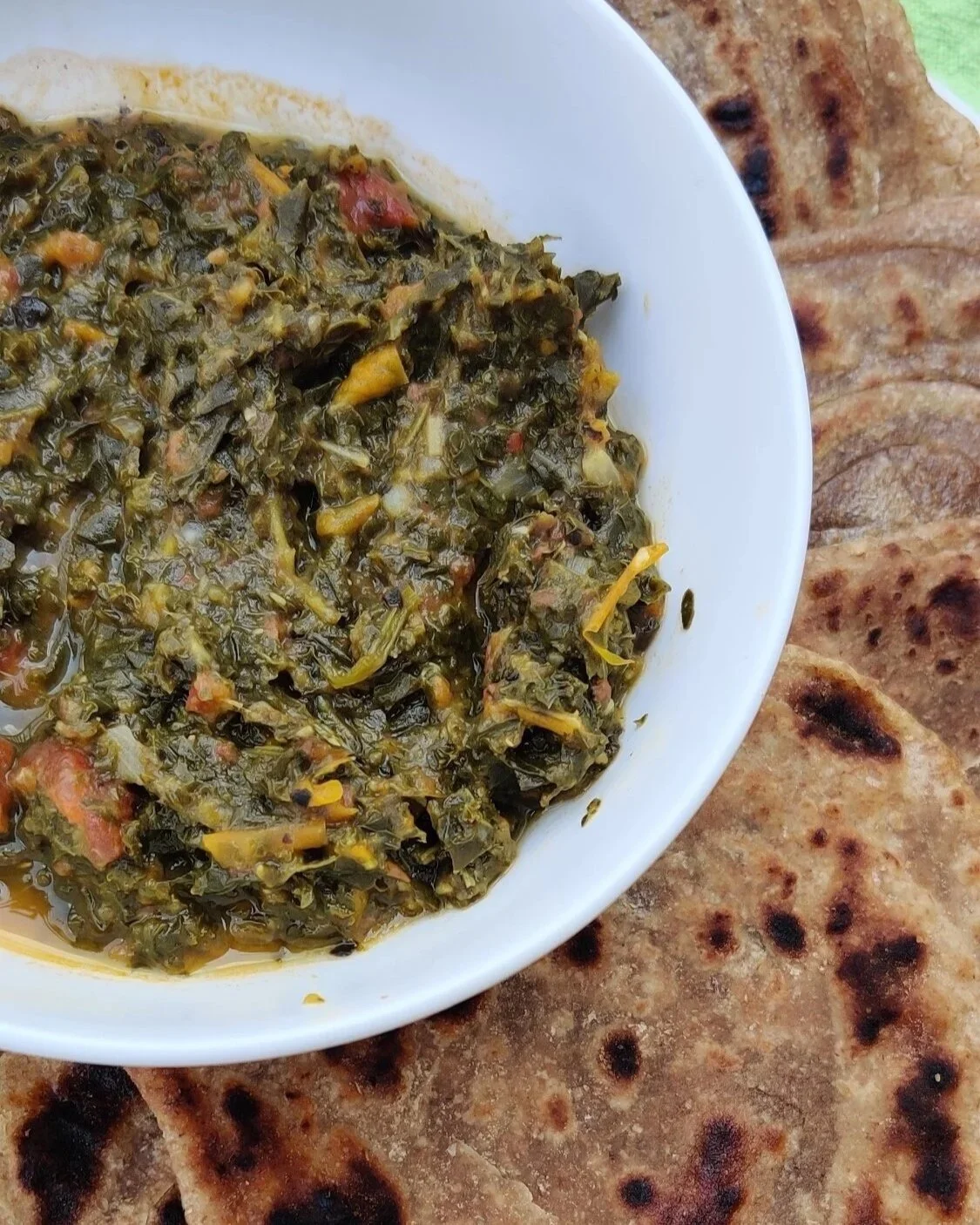
East African Mashed Kale Stew (Sukuma Wiki) with Chapati
A hearty, comforting East African-inspired kale stew packed with vegetables, spices, and richness from peanut butter. Serve with chapati for a complete meal.
Ingredients
- 1 pound kale, chopped
- 2 tablespoons garlic, minced
- ¼ cup fresh parsley, chopped
- ½ large eggplant, chopped
- ½ cup mushrooms, chopped
- 1 large tomato or 1 (14-ounce) can diced tomatoes
- ½ white-fleshed yam or sweet potato, chopped
- ½ large onion, chopped
- ½ large bell pepper, chopped
- ½ jalapeño, chopped
- 6 cups beef broth
- 2 vegetable bouillon cubes
- 1 tablespoon salt
- 2 tablespoons black pepper
- 1 tablespoon chili flakes
- ½ cup peanut butter
- 2 cups water
- 2 tablespoons vegetable oil
- 1 teaspoon fenugreek
- 1 teaspoon cumin
- 1 teaspoon coriander
- 1 teaspoon paprika
- 1 teaspoon sugar
- 1 teaspoon fennel
- ¼ cup chopped parsley (for garnish or added at the end)
Instructions
- Heat the vegetable oil in a large pot over medium heat. Add the chopped kale and cook until wilted and the edges begin to crisp slightly.
- Stir in the garlic and parsley. Cook for 2 minutes, until fragrant.
- Add the onion, eggplant, mushrooms, and all the spices (fenugreek, cumin, coriander, paprika, sugar, fennel, salt, pepper, and chili flakes). Sauté for another 2 minutes.
- Add the bell pepper and jalapeño, and cook for 1 more minute.
- Stir in the tomato, yam (or sweet potato), bouillon cubes, water, and beef broth.
- Reduce the heat to low, cover, and let the stew simmer for about 35 minutes. Stir occasionally and add more water if the stew becomes too thick.
- Once the vegetables are soft and the flavors are well developed, stir in the peanut butter and simmer for 5 more minutes. Taste and adjust seasoning as needed.
- Serve hot, ideally with freshly made chapati or another flatbread.
Notes
Tips:
- The richer your broth, the more flavorful the stew will be. Homemade stock or beef bone broth adds incredible depth.
- While traditionally made with beef broth, this stew can easily be made vegetarian or vegan by using a well-seasoned vegetable broth.
- You can also blend part of the stew for a smoother texture or leave it chunky, depending on your preference.
I am not a certified nutritionist and any nutritional information on dontmissmyplate.com should only be used as a general guideline.
Chermoula Red Snapper with Peanut Butter Rice
This dish is a combination of a lot of different influences. Meals like this that make me appreciate the exposure I've had to food from my background, visiting restaurants, reading, and exploring in the kitchen.
Let’s start with the peanut butter rice!
This is a favoured way of preparing rice in Zimbabwe. It’s an easy, affordable way to add protein to the rice when there is no meat, but even when there is adds an interesting dimension to rice. If you haven’t tried peanut butter rice, I encourage it of course!
The second most important thing, the fish and the marinade!
Chermoula is a herb marinade used to season fish and vegetables in Morocco, Tunisia, Libya, and other parts of North Africa. It adds a rich taste to even the mildest fish. Once you make it you will be using it forever.
As for the red snapper, once clean, stuff it with simple herbs and add some lemon slices for favour on the inside. You can also get it from the butcher prepared for you, but that doesn’t mean you can’t add seasoning!
Ingredients
Chermoula and fish:
1 red snapper, cleaned
1/2 cup parsley, chopped
1/4 cup cilantro, chopped
1 teaspoon cumin
1/2 teaspoon black pepper
Pinch of salt
1 teaspoon paprika
1/2 cup olive oil
1 tablespoon lemon zest
4 teaspoons garlic, minced
1 teaspoon chili powder
4 lemon slices
1 thyme sprig
1 parsley spring
Peanut butter rice:
1 cup white rice
1/3 cup peanut butter
1/2 teaspoon black pepper
1/4 teaspoon salt
1/4 hot cup water
1 3/4 cups water
1 vegetable sachet or bouillon
1 tablespoon olive oil
1 teaspoon garlic, minced
Beans:
1 teaspoon paprika
1 teaspoon chili powder
1 can pinto beans (sugar beans if you can get them, that was my first choice!)
1 teaspoon black pepper
1/2 teaspoon salt
1/2 cup water
1/2 vegetable bouillon, crushed
1 tablespoon Scotch bonnet pepper sauce
Instructions
Prepare the chermoula. In a blender or food processor, add the parsley, cilantro, lemon zest, paprika, cumin, and chilli powder. Mix on low while adding the olive oil to create a paste, so don’t blend until it turns into a liquid! If you accidentally do, add some more parsley to thicken.
For the red snapper, if it isn’t already, stuff the fish with the herb sprigs and lemon slices. Baste the fish on both sides with the chermoula and chill what remains for later. Bake the fish at 450F on each side for 10-15 minutes. When done, the fish should flake easily using a fork. You can also check the internal temperature and go by what’s recommended. Set aside to rest.
While the fish bakes, prepare your rice. Cook the rice with garlic and olive oil before adding the broth sachet. Follow up with 1 3/4 cups water (or whatever rice quantity you want according to the package) and simmer with a lid until the water has evaporated - you want your rice on the drier side because the peanut butter will be added.
Mix the hot water with the peanut butter to make a smooth paste and mix it into the rice. Steam with the lid on for 5 minutes, then remove from heat.
For the beans, sauté them in the oil, bouillon, and spices for about 3 minutes, then simmer in water for about 5-7 minutes. Since canned beans are cooked this should not take long otherwise the beans will break down into mush.
Use the chermoula to baste the cooked snapper and serve with the hot beans and peanut butter rice, feeds 2!
Sadza with Butter Bean Kale Relish
Ah yes, I love a meal that tastes like home. Home being Zimbabwe in this case. There's nothing like a plate of hot relish (stewed vegetables) and sadza (thick corn/maize meal porridge). This is considered one of the cornerstones of our cuisine and feeds millions of people across the country. It's kind of like how pasta is to the Italians dare I say!
Perhaps I'm biased, but it's some of the best-tasting comfort food, and not smothered in fat either. I made it vegan although some Zimbabweans would request some grilled or in-bone meat. You can do without it.
The one thing I'd insist you include if possible is the Usavi mix. It's a spice brand you'll find in most households but is essentially just a blend of cornstarch, salt, sugar, turmeric, coriander, garlic, fennel, methee/fenugreek, cumin, and paprika. Some people like to add curry powder to their relish, but I find that changes the flavour profile into something completely different. This is all about simple deliciousness!
Ingredients
1 can butter/Lima beans (keep the sauce)
1 tablespoon garlic, minced
1 tablespoon olive oil
1/2 onion, chopped
1/4 tomato, chopped
2 tablespoons Usavi mix
1/2 teaspoon salt
1 tablespoon chili flakes
1 teaspoon black pepper
1/4 cup water
1 tablespoon butter
2 tablespoons vegetable
3 cups chopped kale
Sadza:
1 cup white corn/maize meal
3/4 cup cold water
2 1/2 - 4 cups boiling water (depending on how thick you want your sadza)
1/2 teaspoonsalt
Instructions
Heat the olive oil and butter, saute the garlic and onions for about 3 minutes to sweat them out.
Add the Usavi mix, salt, and pepper, cook for another 2 minutes to bring out the flavours.
Add the chopped kale and cook until wilted down, then add the tomato and vegetable oil and fry for 2 minutes.
Add the beans along with the sauce from the can, chilli flakes, and water. Reduce heat and simmer for about 10 minutes, stirring occasionally. Set aside.
Prepare your sadza. In a pot, make a paste using the cold water and a 1/2 cup of maize meal, add the salt. When you add the cold water, do it gradually to keep control of the consistency of the paste, you don’t want clumps and it should all come together.
Place the pot over medium-high heat and add 1/2 cup of boiling water. With a wooden spoon, stir quickly and get rid of any lumps. You want a smooth porridge to form. If you need to, use a whisk!
Add the rest of the hot water a 1/2 cup at a time, still stirring or whisking to ensure you still develop a smooth porridge. At this point, it will start to bubble or kwata. Reduce to medium-low heat and place a lid on top. Careful not to get burnt. Let the sadza cook for about 10 minutes.
Once cooked, fold in the rest of the corn/maize meal. You’ll want to use a twisting or figure-8 motion with your wooden spoon to make sure all the dry mix is coated and you incorporate air. This is the final step to make it a thick, dough-like consistency. You can add more corn/maize meal depending on the texture and consistency you want.
Put the lid back on and sit on low heat to allow the sadza to rest for about 5 minutes. You might hear it 'breathing' or puffing at this point.
When ready to serve, dip your wooden spoon in some cold water to prevent too much sticking. Mould your sadza into a round shape and serve with your relish, enough for 2 people.
Tip: to smoothen your sadza use cling wrap as you shape it.
Also, eat with your (washed) hands! It tastes better.
Finger Millet Peanut Butter Porridge
Most people enjoy porridge as oatmeal, but it's also quite popular in cornmeal form with an array of toppings. I grew up eating it pretty plain, save for butter, sugar, honey or peanut butter. I used to love it in the morning before school, especially during the winter. Porridge is a very popular breakfast option for most Zimbabweans. It's cheap and can keep you full for hours. Peanuts also feature prominently in African cuisine, so you won't find a shortage of meals that include them. Luckily, peanut butter is amazing! Ground millet is a healthier option with tons of calcium and tastes better than ground cornmeal porridge in my opinion. So try this recipe out, it's comforting and delicious!
Ingredients
1 cup finger millet, ground and toasted
2 1/2 cups hot water
1 cup cold water
1/2 teaspoon salt
1 teaspoon butter
1 tablespoon peanut butter
1 teaspoon honey
1 teaspoon sugar
1 teaspoon peanuts (to garnish)
Instructions
Combine the millet and cold water to make a paste.
Add the boiled water and stir with a wooden spoon or whisk to remove the lumps.
Reduce the temperature and simmer covered for 10-15 minutes.
Serve hot with sugar, honey, butter, and peanut butter.
Zimbabwean Pepper Steak Meat Pies
Meat pies come in all shapes and sizes, but one of my favourites is the handheld pepper steak pie.
These pies are often paired with a bottle of Fanta or Coca Cola, an on-the-go snack enjoyed by many Zimbabweans and Southern Africans in general. They are heart-warming, full of flavour, with the perfect kick from the ground peppercorns. This was my attempt to recreate something I grew up eating and will always love, hope you will enjoy them too.
If you use this recipe, please tag me on Facebook or Instagram @dontmissmyplate_dc, I would love to see your remakes!


